.

CHINESE POTTERY AND PORCELAIN
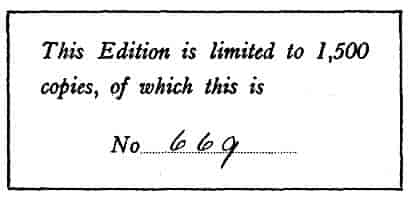
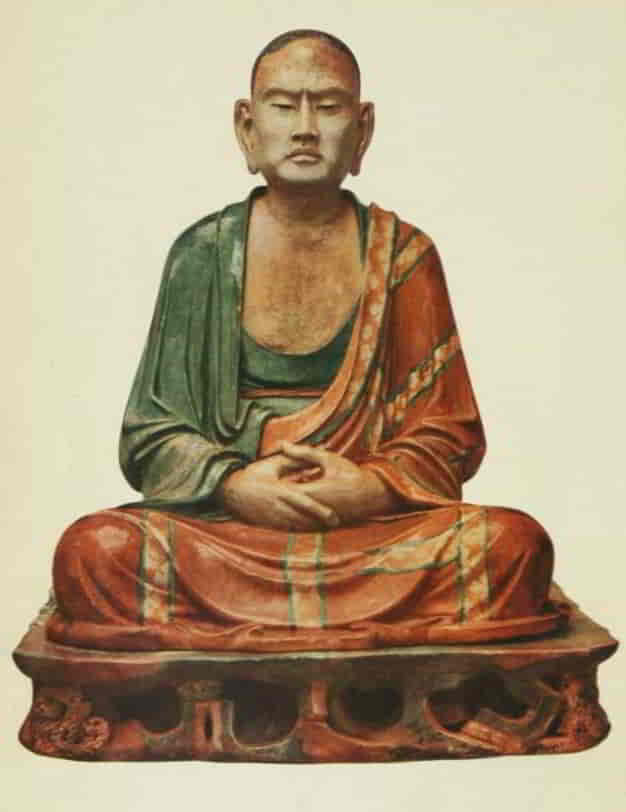
Statue of a Lohan or Buddhist Apostle, T'ang dynasty
(618–906 A.D.)
Height with stand 50 inches. British Museum.
CHINESE POTTERY
AND PORCELAIN
AN ACCOUNT OF THE POTTER'S ART IN CHINA
FROM PRIMITIVE TIMES TO THE PRESENT DAY
BY
R.L. HOBSON, B.A.
Assistant in the Department of British and Mediæval Antiquities and
Ethnography, British Museum. Author of the "Catalogue of the
Collection of English Pottery in the Department of British
and Mediæval Antiquities of the British Museum";
"Porcelain: Oriental, Continental, and British";
"Worcester Porcelain"; etc.; and Joint Author
of "Marks on Pottery"
Forty Plates in Colour and Ninety–six in Black and White
VOL. I
Pottery and Early Wares
CASSELL AND COMPANY, LTD
London, New York, Toronto and Melbourne
1915
CONTENTS
| CHAPTER | PAGE |
| INTRODUCTION | xv |
| BIBLIOGRAPHY | xxvii |
| 1. THE PRIMITIVE PERIODS | 1 |
2. THE HAN  DYNASTY, 206 B.C. TO 220 A.D. DYNASTY, 206 B.C. TO 220 A.D. |
5 |
3. THE TANG  DYNASTY, 618–906 A.D. DYNASTY, 618–906 A.D. |
23 |
4. THE SUNG  DYNASTY, 960–1279 A.D. DYNASTY, 960–1279 A.D. |
43 |
| 5. JU, KUAN, AND KO WARES | 52 |
6. LUNG–CH´ÜAN YAO  |
76 |
7. TING YAO  |
89 |
8. TZ´Ŭ CHOU  WARE WARE |
101 |
| 9. CHÜN WARES AND SOME OTHERS | 109 |
| 10. MIRABILIA | 136 |
| 11. PORCELAIN AND ITS BEGINNINGS | 140 |
| 12. CHING–TÊ CHÊN | 152 |
13. THE YÜAN  DYNASTY, 1280–1367 A.D. DYNASTY, 1280–1367 A.D. |
159 |
14. KUANGTUNG  WARES WARES |
166 |
15. YI–HSING  WARE WARE |
174 |
| 16. MISCELLANEOUS POTTERIES | 184 |
| 17. MARKS ON CHINESE POTTERY AND PORCELAIN | 207 |
LIST OF PLATES
| STATUE OF LOHAN OR BUDDHIST APOSTLE, T´ANG DYNASTY (618–906 A.D.). | |
| British Museum (Colour) | Frontispiece |
| PLATE | FACING PAGE |
| 1. CHOU POTTERY | 4 |
| Fig. 1.—Tripod Food Vessel. Eumorfopoulos Collection. | |
| Fig. 2.—Jar with deeply cut lozenge pattern. Eumorfopoulos Collection. | |
| 2. HAN POTTERY | 8 |
| Fig. 1.—Vase, green glazed. Boston Museum. | |
| Fig. 2.—Vase with black surface and incised designs. Eumorfopoulos Collection. | |
| Fig. 3.—Vase with designs in red, white and black pigments. British Museum. | |
| Fig. 4.—"Granary Urn," green glazed. Peters Collection. | |
| 3. HAN POTTERY | 12 |
| Fig. 1.—"Hill Jar" with brown glaze. Eumorfopoulos Collection. | |
| Fig. 2.—Box, green glazed. Eumorfopoulos Collection. | |
| Fig. 3.—"Lotus Censer," green glazed. Rothenstein Collection. | |
| 4. MODEL OF A "FOWLING TOWER" | 12 |
| Han pottery with iridescent green glaze. Freer Collection. | |
| 5. T´ANG SEPULCHRAL FIGURES | 26 |
| Fig. 1.—A Lokapala or Guardian of one of the Quarters, unglazed. Benson Collection. | |
| Fig. 2.—A Horse, with coloured glazes. Benson Collection. | |
| Fig. 3.—An Actor, unglazed. Benson Collection. | |
| 6. T´ANG SEPULCHRAL FIGURES, UNGLAZED | 26 |
| Figs. 1, 2 and 4.—Female Musicians. Eumorfopoulos Collection. | |
| Fig. 3.—Attendant with dish of food. Eumorfopoulos Collection. | |
| 7. T´ANG SEPULCHRAL POTTERY | 26 |
| Fig. 1.—Figure of a Lady in elaborate costume, unglazed. Eumorfopoulos Collection. | |
| Fig. 2.—Vase, white pottery with traces of blue mottling. Breuer Collection. | |
| Fig. 3.—Sphinx–like Monster, green and yellow glazes. Eumorfopoulos Collection. | |
| 8. THREE EXAMPLES OF T´ANG WARE WITH COLOURED GLAZES: | |
| IN THE Eumorfopoulos Collection (Colour) | 30[viii] |
| Fig. 1.—Tripod Incense Vase with ribbed sides; white pottery with deep blue glaze, | |
| outside encrusted with iridescence. | |
| Fig. 2.—Amphora of light coloured pottery with splashed glaze. | |
| Fig. 3.—Ewer of hard white porcellanous ware with deep purple glaze. | |
| 9. T´ANG POTTERY | 32 |
| Fig. 1.—Ewer of Sassanian form with splashed glazes; panels of relief ornament. | |
| Alexander Collection. | |
| Fig. 2.—Vase with mottled glaze, green and orange. Eumorfopoulos Collection. | |
| Fig. 3.—Ewer with dragon spout and handle; wave and cloud reliefs; brownish yellow glaze | |
| streaked with green. Eumorfopoulos Collection. | |
| 10. T´ANG POTTERY | 32 |
| Fig. 1.—Dish with mirror pattern incised and coloured blue, green, etc.; inner border of ju–i | |
| cloud scrolls on a mottled yellow ground, outer border of mottled green; pale green glaze | |
| underneath and three tusk–shaped feet. Eumorfopoulos Collection. | |
| Fig. 2.—Ewer with serpent handle and trilobed mouth; applied rosette | |
| ornaments and mottled glaze, green, yellow and white. Eumorfopoulos Collection. | |
| 11. T´ANG WARES | 32 |
| Fig. 1.—Cup with bands of impressed circles, brownish yellow glaze outside, green within. | |
| Seligmann Collection. | |
| Fig. 2.—Cup of hard white ware with greenish white glaze. Eumorfopoulos Collection. | |
| Fig. 3.—Melon–shaped Vase, greyish stoneware with white slip and smooth ivory glaze. | |
| Breuer Collection. | |
| Fig. 4.—Cup of porcellanous stoneware, white slip and crackled creamy white glaze, | |
| spur marks inside. Breuer Collection. | |
| 12. T´ANG POTTERY WITH GREEN GLAZE | 40 |
| Fig. 1.—Bottle with impressed key–fret. Eumorfopoulos Collection. | |
| Fig. 2.—Ewer with incised foliage scrolls. Alexander Collection. | |
| Fig. 3.—Vase with foliage scrolls, painted in black under the glaze, incised border on the shoulder. | |
| Eumorfopoulos Collection. | |
| 13. T´ANG POTTERY | 40 |
| Fig. 1.—Pilgrim Bottle with lily palmette and raised rosettes, green glaze. KOECHLIN COLLECTION. | |
| Fig. 2.—Pilgrim Bottle (neck wanting), Hellenistic figures of piping boy and dancing girl in relief | |
| among floral scrolls, brownish green glaze. Eumorfopoulos Collection. | |
| 14. T´ANG WARES | 40 |
| Fig. 1.—Incense Vase, lotus–shaped, with lion on the cover, hexagonal stand with moulded ornament; | |
| green, yellow and brown glazes. Rothenstein Collection. | |
| Fig. 2.—Sepulchral Amphora, hard white ware with greenish white glaze, | |
| serpent handles. Schneider Collection. | |
| Fig. 3.—Ewer with large foliage and lotus border in carved relief, green glaze. Koechlin Collection. | |
| Fig. 4.—Sepulchral Vase, grey stoneware with opaque greenish grey glaze. Incised scrolls on the body, | |
| applied reliefs of dragons, figures, etc., on neck and shoulder. (?) T´ang. Benson Collection. | |
| 15. SUNG WARES | 48[ix] |
| Fig. 1.—Peach–shaped Water Vessel, dark–coloured biscuit, smooth greenish grey glaze. (?) | |
| Ju or Kuan ware. Eumorfopoulos Collection. | |
| Figs. 2 and 3.—Shallow Cup with flanged handle, and covered box, opalescent grey glaze. | |
| Kuan or Chün wares. Rothenstein Collection. | |
| 16. SUNG WARES (Colour) | 58 |
| Fig. 1.—Bowl with six–lobed sides; thin porcellanous ware, burnt brown at the foot–rim, | |
| with bluish green celadon glaze irregularly crackled. Alexander Collection. | |
| Fig. 2.—Tripod Incense Burner. White porcelain burnt pale red under the feet. (?) | |
| Lung–ch´üan celadon ware. Eumorfopoulos Collection. | |
| 17. TWO EXAMPLES OF SUNG WARES OF THE CHÜN OR KUAN FACTORIES (Colour) | 64 |
| Fig. 1.—Bowl with lavender glaze, lightly crackled. O. Raphael Collection. | |
| Fig. 2.—Vase with smooth lavender grey glaze suffused with purple. Eumorfopoulos Collection. | |
| 18. SUNG DYNASTY | 66 |
| Fig. 1.—Bowl with engraved peony design under a brownish green celadon glaze. | |
| Northern Chinese. Eumorfopoulos Collection. | |
| Fig. 2.—Vase moulded in form of a lotus flower, dark grey stoneware, burnt reddish brown, | |
| milky grey glaze, closely crackled. Freer Collection. | |
| 19. VASE OF CLOSE–GRAINED, DARK, REDDISH BROWN STONEWARE, WITH THICK, SMOOTH GLAZE, | |
| BOLDLY CRACKLED. Ko ware of the Sung dynasty. Eumorfopoulos Collection (Colour) | 70 |
| 20. DEEP BOWL OF REDDISH BROWN STONEWARE, WITH THICK, BOLDLY CRACKLED GLAZE. | |
| Ko ware of the Sung dynasty. Eumorfopoulos Collection (Colour) | 74 |
| 21. THREE EXAMPLES OF LUNG–CH´ÜAN CELADON PORCELAIN | 80 |
| Fig. 1.—Plate of spotted celadon. (?) Sung dynasty. Eumorfopoulos Collection. | |
| Fig. 2.—Octagonal Vase with crackled glaze and biscuit panels moulded with figures | |
| of the Eight Immortals in clouds. (?) Fourteenth century. Eumorfopoulos Collection. | |
| Fig. 3.—Dish with engraved lotus scrolls and two fishes in biscuit. Sung dynasty. | |
| Gotha Museum. | |
| 22. VASE OF LUNG–CH´ÜAN PORCELAIN | 88 |
| With grey green celadon glaze of faint bluish tone, peony scroll in low relief. | |
| Probably Sung dynasty. Peters Collection. | |
| 23. IVORY–WHITE TING WARE, WITH CARVED ORNAMENT. Sung dynasty | 96 |
| Fig. 1.—Bowl with lotus design. Eumorfopoulos Collection. | |
| Fig. 2.—Dish with ducks and water plants. Alexander Collection. | |
| 24. SUNG AND YÜAN PORCELAIN | 96[x] |
| Fig. 1.—Ewer, translucent porcelain, with smooth ivory white glaze. Sung or Yüan dynasty. | |
| Alexander Collection. | |
| Fig. 2.—Vase of ivory white Ting ware with carved lotus design. Sung dynasty. | |
| Eumorfopoulos Collection. | |
| 25. TING WARE WITH MOULDED DESIGNS. Sung dynasty | 96 |
| Fig. 1.—Plate with boys in peony scrolls, ivory white glaze. Peters Collection. | |
| Fig. 2.—Bowl with flying phœnixes in lily scrolls, crackled creamy glaze; t´u ting ware. | |
| Koechlin Collection. | |
| 26. T´U–TING WARE, SUNG DYNASTY, WITH CREAMY CRACKLED GLAZE | 96 |
| Fig. 1.—Brush washer in form of a boy in a boat. Rothenstein Collection. | |
| Fig. 2.—Figure of an elephant. Eumorfopoulos Collection. | |
| 27. VASE OF BRONZE FORM, WITH ROW OF STUDS AND MOULDED BELT OF | |
| k´uei DRAGON AND KEY–FRET PATTERNS | 96 |
| "Ostrich egg" glaze. (?) Kiangnan ware, of Ting type; Sung dynasty. Peters Collection. | |
| 28. VASE OF BRONZE FORM, WITH BANDS OF RAISED KEY PATTERN | 96 |
| Thick creamy glaze, closely crackled and shading off into brown with faint tinges of purple. (?) | |
| Kiangnan Ting ware. Fourteenth century. Koechlin Collection. | |
| 29. VASE OF PORCELLANOUS STONEWARE | 104 |
| With creamy white glaze and designs painted in black. Tz´ŭ Chou ware, Sung dynasty | |
| (960–1279 A.D.). In the Louvre. | |
| 30. FOUR JARS OF PAINTED TZ´Ŭ CHOU WARE | 104 |
| Fig. 1.—Dated 11th year of Chêng T´ing (1446 A.D.) Eumorfopoulos Collection. | |
| Fig. 2.—Painted in red and green enamels. (?) Sung dynasty. Alexander Collection. | |
| Fig. 3.—Lower half black, the upper painted on white ground. Sung dynasty. Benson Collection. | |
| Fig. 4.—With phœnix design, etched details. Sung dynasty. Rothenstein Collection. | |
| 31. TZ´Ŭ CHOU WARE | 104 |
| Fig. 1.—Tripod Incense Vase in Persian style with lotus design in pale aubergine, in | |
| a turquoise ground. Sixteenth century. Eumorfopoulos Collection. | |
| Fig. 2.—Pillow with creamy white glaze and design of a tethered bear in black. Sung dynasty. | |
| Eumorfopoulos Collection. | |
| 32. TZ´Ŭ CHOU WARE | 104 |
| Fig. 1.—Figure of a Lohan with a deer, creamy white glaze coloured with black slip and | |
| painted withgreen and red enamels. Said to be Sung dynasty. Eumorfopoulos Collection. | |
| Fig. 2.—Vase with graffiato peony scrolls under a green glaze. Sung dynasty. | |
| Eumorfopoulos Collection. | |
| 33. TZ´Ŭ CHOU WARE | 104[xi] |
| Fig. 1.—Vase with panel of figures representing music, painted in black under a blue glaze. | |
| Yüan dynasty. Eumorfopoulos Collection. | |
| Fig. 2.—Vase with incised designs in a dark brown glaze, a sage looking at a skeleton. | |
| Yüan dynasty. Peters Collection. | |
| Fig. 3.—Vase with painting in black and band of marbled slips. Sung dynasty. | |
| Eumorfopoulos Collection. | |
| 34. TZ´Ŭ CHOU WARE | 104 |
| Fig. 1.—Bottle of white porcellanous ware with black glaze and floral design in lustrous brown. | |
| Sung dynasty or earlier. (?) Tz´ŭ Chou ware. Eumorfopoulos Collection. | |
| Fig. 2.—Bottle with bands of key pattern and lily scrolls cut away from a black glaze. | |
| Sung dynasty. Eumorfopoulos Collection. | |
| Fig. 3.—Bottle with graffiato design in white slip on a mouse–coloured ground, | |
| yellowish glaze. Sung dynasty. Eumorfopoulos Collection. | |
| 35. FLOWER POT OF CHÜN CHOU WARE OF THE SUNG DYNASTY (Colour) | 112 |
| Grey porcellanous body: olive brown glaze under the base and the numeral shih (ten) incised. | |
| Eumorfopoulos Collection. | |
| 36. CHÜN WARE (Colour) | 116 |
| Fig. 1.—Flower pot of six–foil form. Chün Chou ware of the Sung dynasty. | |
| The base is glazed with olive brown and incised with the numeral san (three). | |
| Alexander Collection. | |
| Fig. 2.—Bowl of Chün type, with close–grained porcellanous body of yellowish colour. | |
| Sung dynasty. Eumorfopoulos Collection. | |
| 37. CHÜN CHOU WARE WITH PORCELLANOUS BODY (tz´ŭ t´ai). Sung dynasty | 118 |
| Fig. 1.—Flower Pot, with lavender grey glaze. Numeral mark ssŭ (four). | |
| Eumorfopoulos Collection. | |
| Fig. 2.—Bulb Bowl, of quatrefoil form, pale olive glaze clouded with opaque grey. | |
| Numeral mark i (one). Freer Collection. | |
| 38. CHÜN WARE (Colour) | 122 |
| Fig. 1.—Bowl of eight–foil shape, with lobed sides, of Chün type. Sung dynasty. | |
| Alexander Collection. | |
| Fig. 2.—Pomegranate shaped Water Pot of "Soft Chün" ware. Probably Sung dynasty. | |
| Alexander Collection. | |
| 39. TWO EXAMPLES OF "SOFT CHÜN" WARE (Colour) | 126 |
| Fig. 1.—Vase of buff ware, burnt red at the foot rim, with thick, almost crystalline glaze. | |
| Found in a tomb near Nanking and given in 1896 to the FitzWilliam Museum, Cambridge. | |
| Probably Sung dynasty. | |
| Fig. 2.—Vase of yellowish ware with thick opalescent glaze. Yüan dynasty. | |
| Alexander Collection. | |
| 40. CHÜN CHOU WARE | 128 |
| Fig. 1.—Bulb Bowl, porcellanous ware with lavender grey glaze passing into mottled | |
| red outside. Numeral mark i (one). Sung dynasty. Eumorfopoulos Collection. | |
| Fig. 2.—Vase of dense reddish ware, opalescent glaze of pale misty lavender with | |
| passages of olive and three symmetrical splashes of purple with green centres. | |
| Sung or Yüan dynasty. Peters Collection. | |
| 41. CHÜN CHOU WARE | 128[xii] |
| Fig. 1.—Dish with peach spray in relief. Variegated lavender grey glaze with purplish | |
| brown spots and amethyst patches, frosted in places with dull green. Sung dynasty. | |
| Freer Collection. | |
| Fig. 2.—Vase and Stand, smooth lavender grey glaze. Sung or Yüan dynasty. | |
| Alexander Collection. | |
| 42. TWO Temmoku BOWLS, DARK–BODIED CHIEN YAO OF THE SUNG DYNASTY | 130 |
| Fig. 1.—Tea Bowl (p´ieh), purplish black glaze flecked with silvery drops. | |
| Freer Collection. | |
| Fig. 2.—Tea Bowl with purplish black glaze shot with golden brown. British Museum. | |
| 43. THREE EXAMPLES OF "HONAN temmoku," PROBABLY T´ANG DYNASTY | 132 |
| Fig. 1.—Bowl with purplish black glaze, stencilled leaf in golden brown. | |
| Havemeyer Collection. | |
| Fig. 2.—Ewer with black glaze. Alexander Collection. | |
| Fig. 3.—Covered Bowl, black mottled with lustrous brown. Cologne Museum. | |
| 44. EARLY TRANSLUCENT PORCELAIN, PROBABLY T´ANG DYNASTY | 150 |
| Fig. 1.—Cinquefoil Cup with ivory glaze clouded with pinkish buff stains. Breuer Collection. | |
| Fig. 2.—Vase of white, soft–looking ware, very thin and translucent, with pearly white, | |
| crackled glaze powdered with brown specks. Peters Collection. | |
| 45. T´ANG AND SUNG WARES | 150 |
| Fig. 1.—Square Vase with engraved lotus scrolls and formal borders. T´u–ting ware, | |
| Sung dynasty. Peters Collection. | |
| Fig. 2.—Ewer with phœnix head, slightly translucent porcelain with light greenish | |
| grey glaze with tinges of blue in the thicker parts; carved designs. Probably T´ang | |
| dynasty. Eumorfopoulos Collection. | |
| 46. TING WARE AND YÜAN PORCELAIN | 162 |
| Fig. 1.—Bottle with carved reliefs of archaic dragons and ling chin funguses. | |
| Fên ting ware, said to be Sung dynasty. Eumorfopoulos Collection. | |
| Fig. 2.—Bowl with moulded floral designs in low relief, unglazed rim. | |
| Translucent porcelain, probably Yüan dynasty. Eumorfopoulos Collection. | |
| 47. VASE OF BUFF STONEWARE (Colour) | 170 |
| With scroll of rosette–like flowers in relief: thick flocculent glaze of mottled blue with | |
| passages of dull green and a substratum of brown. Kuantung ware, seventeenth century. | |
| Benson Collection. | |
| 48. KUANGTUNG WARE | 172 |
| Fig. 1.—Dish in form of a lotus leaf, mottled blue and brown glaze. About 1600. | |
| British Museum. | |
| Fig. 2.—Vase with lotus scroll in relief, opaque, closely crackled glaze of pale lavender | |
| grey warmin into purple. (?) Fourteenth century. Peters Collection. | |
| Fig. 3.—Figure of Pu–tai Ho–shang, red biscuit, the draperies glazed celadon green. | |
| Eighteenth century. British Museum. | |
| 49. COVERED JAR OF BUFF STONEWARE | 172[xiii] |
| With cloudy green glaze and touches of dark blue, yellow, brown and white; archaic dragons, | |
| bats and storks in low relief; border of sea waves. Probably Kuangtung ware, | |
| seventeenth century. Eumorfopoulos Collection. | |
| 50. YI–HSING STONEWARE, SOMETIMES CALLED Buccaro | 176 |
| Figs. 1 to 4.—Teapots in the Dresden Collection, late seventeenth century. | |
| (1) Buff with dark patches. | |
| (2) Red ware with pierced outer casing. | |
| (3) Black with gilt vine sprays. | |
| (4) Red ware moulded with lion design. | |
| Fig. 5.—Peach–shaped Water Vessel, red ware. Dresden Collection. | |
| Fig. 6.—Red Teapot, moulded design of trees, etc. Inscription containing the name of | |
| Ch´ien Lung.Hippisley Collection. | |
| 51. TWO VASES WITH GLAZE IMITATING THAT OF THE CHÜN CHOU WARE (Colour) | 180 |
| Fig. 1.—Vase of Fat–shan (Kuangtung) Chün ware. Late Ming. Eumorfopoulos Collection. | |
| Fig. 2.—Bottle–shaped Vase, the base suggesting a lotus flower and the mouth a lotus seed–pod, | |
| with a ring of movable seeds on the rim. Thick and almost crystalline glaze of lavender blue | |
| colour with a patch of crimson. Yi–hsing Chün ware of the seventeenth century. | |
| Eumorfopoulos Collection. | |
| 52. WINE JAR WITH COVER AND STAND (Colour) | 186 |
| Fine stoneware with ornament in relief glazed green and yellow in a deep violet blue ground. | |
| Four–clawed dragons ascending and descending among cloud scrolls in pursuit of flaming | |
| pearls; band of sea waves below and formal borders including a ju–i pattern on | |
| the shoulder. Cover with foliate edges and jewel pattern, surmounted by a seated figure of | |
| Shou Lao, God of Longevity. About 1500 A.D. Grandidier Collection, Louvre. | |
| 53. VASE WITH CHRYSANTHEMUM HANDLES (Colour) | 192 |
| Buff stoneware with chrysanthemum design outlined in low relief and coloured with turquoise, | |
| green and pale yellow glazes in dark purple ground. About 1500 A.D. Eumorfopoulos Collection. | |
| 54. VASE WITH LOTUS HANDLES (Colour) | 196 |
| Buff stoneware with lotus design modelled in low relief and coloured with aubergine, | |
| green and pale yellow glazes in a deep turquoise ground. About 1500 A.D. | |
| Grandidier Collection, Louvre. | |
| 55. MING POTTERY WITH DULL san ts´ai GLAZES | 200 |
| Fig. 1.—Wine Jar with pierced outer casing, horsemen and attendants, rocky background. | |
| Fifteenth century. Eumorfopoulos Collection. | |
| Fig. 2.—Tripod Incense Vase, dragons and peony designs and a panel of horsemen. | |
| Dated 1529 A.D. Messel Collection. | |
| 56. MISCELLANEOUS POTTERY | 200 |
| Fig. 1.—Jar with dull green glaze and formal lotus scroll in relief touched with yellow | |
| and brown glazes. About 1600. Goff Collection. | |
| Fig. 2.—Beaker of bronze form, soft whitish body and dull green glaze. (?) Seventeenth | |
| century. Eumorfopoulos Collection. | |
| Fig. 3.—Vase of light buff ware with dull black dressing, vine reliefs. Mark, Nan hsiang t´ang. | |
| Eighteenth century. Eumorfopoulos Collection. | |
| 57. SEATED FIGURE OF KUAN YÜ, THE WAR–GOD OF CHINA, A DEIFIED WARRIOR (Colour) | 204[xiv] |
| Reddish buff pottery with blue, yellow and turquoise glazes, and a colourless glaze on the | |
| white parts. Sixteenth century. Eumorfopoulos Collection. | |
| 58. MISCELLANEOUS POTTERY | 206 |
| Fig. 1.—Jar with lotus design in green, yellow and turquoise glazes in an aubergine ground. | |
| About 1600. Hippisley Collection. | |
| Fig. 2.—Vase of double fish form, buff ware with turquoise, yellow and aubergine glazes. (?) | |
| Seventeenth century. British Museum. | |
| Fig. 3.—Roof–tile with figure of Bodhidharma, deep green and creamy white glazes. | |
| Sixteenth century. Benson Collection. | |
| Fig. 4.—Bottle with archaic dragon (ch´ih lung) on neck, variegated glaze of lavender, | |
| blue and green clouded with purple and brown. (?) Eighteenth century. Yi–hsing ware. | |
| Peters Collection. |
INTRODUCTION
WHEN we consider the great extent of the Chinese Empire and its teeming population—both of them larger than those of Europe—and the fact that a race with a natural gift for the potter's craft and a deep appreciation of its productions has lived and laboured there for twenty centuries (to look no farther back than the Han dynasty), it seems almost presumptuous to attempt a history of so vast and varied an industry within the compass of two volumes. Anything approaching finality in such a subject is out of the question, and, indeed, imagination staggers at the thought of a complete record of every pottery started in China in the past and present.
As far as pottery is concerned, we must be content with the identification of a few prominent types and with very broad classifications, whether they be chronological or topographical. Indeed, the potteries named in the Chinese records are only a few of those which must have existed; and though we may occasionally rejoice to find in our collections a series like the red stonewares of Yi–hsing, which can be definitely located, a very large proportion of our pottery must be labelled uncertain or unknown. How many experts here or on the Continent could identify the pottery made in South Germany or Hungary a hundred years ago? What chance, then, is there of recognising any but the most celebrated wares of China?
In dealing with porcelain as distinct from pottery, we have a simpler proposition. The bulk of what we see in Europe is not older than the Ming dynasty and was made at one of two large centres, viz. Ching–tê Chên in Kiangsi, and Tê–hua in Fukien. Topographical arrangement, then, is an easy matter, and there[xvi] is a considerable amount of information available to guide us in chronological considerations.
The antiquity of Chinese porcelain, its variety and beauty, and the wonderful skill of the Chinese craftsmen, accumulated from the traditions of centuries, have made the study of the potter's art in China peculiarly absorbing and attractive. There is scope for every taste in its inexhaustible variety. Compared with it in age, European porcelain is but a thing of yesterday, a mere two centuries old, and based from the first on Chinese models. Even the so–called European style of decoration which developed at Meissen and Sèvres, though quite Western in general effect, will be found on analysis to be composed of Chinese elements. It would be useless to compare the artistic merits of the Eastern and Western wares.
It is so much a matter of personal taste. For my own part, I consider that the decorative genius of the Chinese and their natural colour sense, added to their long training, have placed them so far above their European followers that comparison is irrelevant. Even the commoner sorts of old Chinese porcelain, made for the export trade, have undeniable decorative qualities, while the specimens in pure Chinese taste, and particularly the Court wares, are unsurpassed in quality and finish.
The merits and beauty of porcelain have always been recognised by the Chinese, who ranked it from the earliest days among their precious materials. Chinese poets make frequent reference to its dainty qualities, its jade–like appearance, its musical ring, its lightness and refinement. The green cups of Yüeh Chou ware in the T´ang dynasty were likened to moulded lotus leaves; and the white Ta–yi bowls surpassed hoar–frost and snow. Many stanzas were inspired by the porcelain bowls used at the tea and wine symposia, where cultivated guests capped each other's verses. In a pavilion at Yün–mên, in the vicinity of Ching–tê Chên, is a tablet inscribed, "The white porcelain is quietly passed all through the night, the fragrant vapour (of the tea) fills the peaceful pavilion," an echo of a symposium held there by some distinguished persons in the year 1101 A. D., and no doubt alluding to wares of local make.[xvii] Elsewhere[1] we read of a drinking–bout in which the wine bowls of white Ting Chou porcelain inspired a verse–capping competition. "Ting Chou porcelain bowls in colour white throughout the Empire," wrote one. Another followed, "Compared with them, glass is a light and fickle mistress, amber a dull and stupid female slave." The third proceeded: "The vessel's body is firm and crisp; the texture of its skin is yet more sleek and pleasing."
The author of the P´ing hua p´u, a late Ming work on flower vases, exhorts us: "Prize the porcelain and disdain gold and silver. Esteem pure elegance."
In their admiration of antiques the Chinese yield to none, and nowhere have private collections been more jealously guarded and more difficult of access. Even in the sixteenth century relatively large sums were paid for Sung porcelains, and £30 was not too much for a "chicken wine cup" barely a hundred years old. The ownership of a choice antique—say, of the Sung dynasty—made the possessor a man of mark; perhaps even a marked man if the local ruler chanced to be of a grasping nature.
A story is told on p. 75 of this volume of a Ko ware incense burner (afterwards sold for 200 ounces of gold), which brought a man to imprisonment and torture in the early Ming period; and, if the newspaper account was correct, there was an incident in the recent revolution which should touch the collector's heart. A prominent general, who, like so many Chinese grandees, was an ardent collector, was expecting a choice piece of porcelain from Shanghai. In due course the box arrived and was taken to the general's sanctum. He proceeded to open it, no doubt with all the eagerness and suppressed excitement which collectors feel in such tense moments, only to be blown to pieces by a bomb! His enemies had known too well the weak point in his defence.
Collecting is a less dangerous sport in England; but if it were not so, the ardent collector would be in no way deterred. Warnings are wasted on him, and he would follow his quarry, even though the path were strewn with fragments of his indiscreet fellows. Still less is he discouraged by difficulties of another kind, as illustrated[xviii] 'by the story[2] of T´ang's white Sung tripod, which was so closely imitated that its owner, one of the most celebrated collectors of the sixteenth century, could not distinguish the copy from the original. An eighteenth century Chinese writer points the moral of the story: "When connoisseurs point with admiration to a vessel, calling it Ting ware, or, again, Kuan ware, how can we know that it is not a 'false tripod' which deceives them?" The force of this question will be appreciated by collectors of Sung wares, especially of the white Ting porcelains and the green celadons; for there is nothing more difficult to classify correctly than these long–lived types. There are, however, authentic Sung examples within reach, and we can train our eyes with these, so that nothing but the very best imitations will deceive us; and, after all, if we succeed in obtaining a really first–rate Ming copy of a Sung type we shall be fortunate, for if we ever discover the truth—which is an unlikely contingency—we may console ourselves with thoughts of the enthusiast who eventually bought T´ang's false tripod for £300 and "went home perfectly happy."
In spite of all that has been written in the past on Oriental ceramics, the study is still young, and it will be long before the last word is said on the subject. Still our knowledge is constantly increasing, and remarkable strides have been made in recent years. The first serious work on Chinese porcelain was Julien's translation of the Ching–tê Chên t´ao lu, published in 1856. The work of a scholar who was not an expert, it was inevitably marred by misunderstanding of the material, and subsequent writers who followed blindly were led into innumerable confusions. The Franks Catalogue, issued in 1876, was one of the first attempts to classify Oriental wares on some intelligible system; but it was felt that not enough was known at that time to justify a chronological classification of the collection, and the somewhat unscientific method of grouping by colours and processes of decoration was adopted as a convenient expedient. At the end of last century Dr. S.W. Bushell revolutionised the study of Chinese porcelain by his Oriental Ceramic Art, a book, unfortunately, difficult to obtain, and by editing Cosmo Monkhouse's[xix] excellent History and Description of Chinese Porcelain. These were followed by the South Kensington Museum Handbook and by the translation and reproduction of the sixteenth century Album of Hsiang Yüan–p´ien, and later by the more important translation of the T´ao shuo.
It would be impossible to over–estimate the importance of Bushell's pioneer work; and I hasten to make the fullest acknowledgment of the free use I have made of his writings, the more so because I have not hesitated to criticise freely his translations where necessary. The Chinese language is notoriously obscure and ambiguous, and differences of opinion on difficult passages are inevitable. In fact, I would say that it is unwise to build up theories on any translation whatsoever without verifying the critical passages in the original. For this reason I found it necessary to work laboriously through the available Chinese ceramic literature, a task which would have been quite impossible with my brief acquaintance with the language had it not been for the invaluable aid of Dr. Lionel Giles, who helped me over the difficult ground. I have, moreover, taken the precaution of giving the Chinese text in all critical passages, so that the reader may satisfy himself as to their true meaning.
While Dr. Bushell's contributions have greatly simplified the study of the later Chinese porcelains, little or no account was taken in the older books of the pottery and early wares. The materials necessary for the study of these were wanting in Europe. Stray examples of the coarser types and export wares had found their way into our collections, but not in sufficient numbers or importance to arouse any general interest, and the condition of the Western market for the early types was not such as to tempt the native collector to part with his rare and valued specimens. In the last few years the position has completely changed. The opening up of China and the increased opportunities which Europeans enjoy, not only for studying the monuments of ancient Chinese art, but for acquiring examples of the early masterpieces in painting, sculpture, bronze, jade, and ceramic wares, have given the Western student a truer insight into the greatness of the earlier phases of Chinese art, and have awakened a new and widespread enthusiasm for them.[xx] An immense quantity of objects, interesting both artistically and archæologically, has been discovered in the tombs which railway construction has incidentally opened; and although this rich material has been gathered haphazard and under the least favourable conditions for accurate classification, a great deal has been learnt, and it is not too much to say that the study of early Chinese art has been completely revolutionised. Numerous collections have been formed, and the resulting competition has created a market into which even the treasured specimens of the Chinese collectors are being lured. Political circumstances have been another factor of the situation, and the Western collector has profited by the unhappy conditions which have prevailed in China since the revolution in 1912.
The result of all this, ceramically speaking, is that we are now familiar with the pottery of the Han dynasty; the ceramic art of the T´ang period has been unfolded in wholly unexpected splendour; the Sung problems no longer consist in reconciling ambiguous Chinese phrases, but in the classification of actual specimens; the Ming porcelain is seen in clearer perspective, and our already considerable information on the wares of the last dynasty has been revised and supplemented by further studies. So much progress, in fact, has been made, that it was high time to take stock of the present position, and to set out the material which has been collected, not, of course, with any thoughts of finality, but to serve as a basis for a further forward move. That is the purpose of the present volumes, in which I have attempted merely to lay before the reader the existing material for studying Chinese ceramics as I have found it, adding my own conclusions and comments, which he may or may not accept.
The most striking additions to our knowledge in recent years, have without doubt been those which concern the T´ang pottery. What was previously a blank is now filled with a rich series covering the whole gamut of ceramic wares, from a soft plaster–like material through faïence and stoneware up to true porcelain. The T´ang potters had little to learn in technical matters. They used the soft lead glazes, coloured green, blue, amber, and purplish brown[xxi] by the same metallic oxides as formed the basis of the cognate glazes on Ming pottery. They used high–fired feldspathic glazes, white, brownish green, chocolate brown, purplish black, and tea–dust green, sometimes with frothy splashes of grey or bluish grey, as on the Sung wares. Sometimes these glazes were superposed as on the Japanese tea jars, which avowedly owed their technique to Chinese models. It is evident that streaked and mottled effects appealed specially to the taste of the time, and marbling both of the glaze and of the body was practised. Carving designs in low relief, or incising them with a pointed instrument and filling in the spaces with coloured glazes, stamping small patterns on the body, and applying reliefs which had been previously pressed out in moulds, were methods employed for surface decoration. Painted designs in unfired pigments appear on some of the tomb wares, and it is now practically certain that painting in black under a green glaze was used by the T´ang potters. Moreover, the existence of porcelain proper in the T´ang period is definitely established.
One of the most remarkable features of T´ang pottery is the strong Hellenistic flavour apparent in the shapes of the vessels and in certain details of the ornament, particularly in the former. Other foreign influences observable in T´ang art are Persian, Sassanian, Scytho–Siberian, and Indian, and one would say that Chinese art at this period was in a peculiarly receptive state. As compared with the conventional style of later ages which we have come to regard as characteristically Chinese, the T´ang art is quite distinctive, and almost foreign in many of its aspects.
The revelation of T´ang ceramics has provided many surprises, and doubtless there are more in store for us. There are certainly many gaps to fill and many apparent anomalies to explain. We are still in the dark with regard to the potter's art of the four hundred years which separate the Han and T´ang dynasties. The Buddhist sculptures of this time reveal a high level of artistic development, and we may assume that the minor arts, and pottery among them, were not neglected. When some light is shed from excavation or otherwise upon this obscure interval, no doubt we[xxii] shall see that we have fixed our boundaries too rigidly, and that the Han types must be carried forward and the T´ang types carried back to bridge the gap. Meanwhile, we can only make the best of the facts which have been revealed at present, keeping our classification as elastic as possible. Probably the soft lead glazes belong to the earlier part of the T´ang period and extend back to the Sui and Wei, linking up with the green glaze of the Han pottery, while the high–fired glazes tended to supersede these in the latter part of the dynasty.
The high–fired feldspathic glazes seem to have held the field entirely in the Sung dynasty, and the lead glazes, as far as our observation goes, do not reappear until the Ming dynasty.
The Sung is the age of high–fired glazes, splendid in their lavish richness and in the subtle and often unforeseen tints which emerge from their opalescent depths. It is also an age of bold, free potting, robust and virile forms, an age of pottery in its purest manifestation. Painted ornament was used at certain factories in black and coloured clays, and, it would seem, even in red and green enamels; but painted ornament was less esteemed than the true ceramic decoration obtained by carving, incising, and moulding—processes which the potters worked with the clay alone.
If we could rest content with a comprehensive classification of the Sung wares, as we have had perforce to do in the case of the T´ang, one of the chief difficulties in this part of our task would be avoided. But the Chinese have given us a number of important headings, under which it has become obligatory to try and group our specimens. Some of these types have been clearly identified, but there are others which still remain vague and ill–defined; and there are many specimens, especially among the coarser kinds of ware, which cannot be referred to any of the main groups. But the true collector will not find the difficulties connected with the Sung wares in any way discouraging. He will revel in them, taking pleasure in the fact that he has new ground to break, many riddles to solve, and a subject to master which is worthy of his steel.
Apparently a coarse form of painting in blue was employed[xxiii] at one factory at least in the Sung period,[3] and we may now consider it practically certain that the first essays in painting both under and over the glaze go back several centuries earlier than was previously supposed. Blue and white and polychrome porcelain chiefly occupied the energies of the Imperial potters at Ching–tê Chên in the Ming dynasty, and the classic periods for these types fall in the fifteenth century. The vogue of the Sung glazes scarcely survived the brief intermediate dynasty of the Yüan, and we are told by a Chinese writer[4] that "on the advent of the Ming dynasty the pi sê[5] began to disappear." Pictorial ornament and painted brocade patterns were in favour on the Ming wares; and it will be observed that as compared with those of the later porcelains the Ming designs are painted with more freedom and individuality. In the Ch´ing dynasty the appetite of the Ching–tê Chên potters was omnivorous and their skill was supreme. They are not only noted for certain specialities, such as the K´ang Hsi blue and white and famille verte, the sang de bœuf and peach–bloom reds, and for the development of the famille rose palette, but for the revival of all the celebrated types of the classic periods of the Sung and Ming; and when they had exhausted the possibilities of these they turned to other materials and copied with magical exactitude the ornaments in metal, carved stone, lacquer, wood, shell, glass—in a word, every artistic substance, whether natural or artificial.
The mastery of such a large and complex subject as Oriental ceramics requires not a little study of history and technique, in books and in collections. The theory and practice should be taken simultaneously, for neither can be of much use without the other. The possession of a few specimens which can be freely handled and closely studied is an immense advantage. They need not be costly pieces. In fact, broken fragments will give as much of the all–important information on paste and glaze as complete specimens.[xxiv] Those who have not the good fortune to possess the latter, will find ample opportunity for study in the public museums with which most of the large cities of the world are provided. The traveller will be directed to these by his "Baedeker," and I shall only mention a few of the most important museums with which I have personal acquaintance, and to which I gratefully express my thanks for invaluable assistance.
London.—The Victoria and Albert Museum possesses the famous Salting Collection, in which the Ch´ing dynasty porcelains are seen at their best: besides the collection formed by the Museum itself and many smaller bequests, gifts, and loans, in which all periods are represented. The Franks Collection in the British Museum is one of the best collections for the student because of its catholic and representative nature.
Birmingham and Edinburgh have important collections in their art galleries, and most of the large towns have some Chinese wares in their museums.
Paris.—The Grandidier Collection in the Louvre is one of the largest in the world. The Cernuschi Museum contains many interesting examples, especially of the early celadons, and the Musée Guimet and the Sèvres Museum have important collections.
Berlin.—The Kunstgewerbe Museum has a small collection containing some important specimens. The Hohenzollern Museum and the Palace of Charlottenburg have historic collections formed chiefly at the end of the seventeenth century.
Dresden.—The famous and historic collection, formed principally by Augustus the Strong, is exhibited in the Johanneum, and is especially important for the study of the K´ang Hsi porcelains. The Stübel Collection in the Kunstgewerbe Museum, too, is of interest.
Gotha.—The Herzögliches Museum contains an important series of the Sung and Yüan wares formed by Professor Hirth.
Cologne.—An important and peculiarly well–arranged museum of Far–Eastern art, formed by the late Dr. Adolf Fischer and his wife, is attached to the Kunstgewerbe Museum.
New York.—The Metropolitan Museum is particularly rich in[xxv] Ming and Ch´ing porcelains. It is fortunate in having the splendid Pierpont Morgan Collection and the Avery Collection, and when the Altmann Collection is duly installed in its galleries it will be unrivalled in the wares of the last dynasty. The Natural History Museum has a good series of Han pottery.
Chicago.—The Field Museum of Natural History has probably the largest collection of Han pottery and T´ang figurines in the world. It has also an interesting series of later Chinese pottery, including specimens from certain modern factories which are important for comparative study. These collections were formed by Dr. Laufer in China. There is also a small collection of the later porcelains in the Art Institute.
Boston.—The Museum of Fine Arts has a considerable collection of Chinese porcelain, in which the earlier periods are specially well represented. The American collections, both public and private, are especially strong in monochrome porcelains, and in this department they are much in advance of the European.
To acknowledge individually all the kind attentions I have received from those in charge of the various museums would make a long story. They will perhaps forgive me if I thank them collectively. The private collectors to whom I must express my gratitude are scarcely less numerous. They have given me every facility for the study of their collections, and in many cases, as will be seen in tile list of plates, they have freely assisted with the illustrations. I am specially indebted to Mr. Eumorfopoulos, Mr. Alexander, Mr. R. H. Benson, Mr. S. T. Peters, and Mr. C. L. Freer, who have done so much for the study of the early wares in England and America. Without the unstinted help of these enthusiastic collectors it would have been impossible to produce the first volume of this book. What I owe to Mr. Eumorfopoulos can be partly guessed from the list of plates. His collection is an education in itself, and he has allowed me to draw freely on it and on his own wide experience. Of the many other collectors who have similarly assisted in various parts of the work, I have to thank Sir Hercules Read, Mr. S. E. Kennedy, Dr. A. E. Cumberbatch, Mr. C. L. Rothenstein, Dr. Breuer, Dr. C. Seligmann, M. R.[xxvi] Koechlin, Mr. O. Raphael, Mr. A. E. Hippisley, Hon. Evan Charteris, Lady Wantage, Mr. Burdett–Coutts, the late Dr. A. Fischer, Mr. L. C. Messel, Mr. W. Burton, Col. Goff, Mrs. Halsey, Mrs. Havemeyer, Rev. G. A. Schneider, and Mrs. Coltart. A portion of the proofs has been read by Mr. W. Burton. Mr. L. C. Hopkins has given me frequent help with Chinese texts, and especially in the reading of seal characters; and my colleague, Dr. Lionel Giles, in addition to invaluable assistance with the translations, has consented to look through the proofs of these volumes with a special view to errors in the Chinese characters. Finally, I have to thank my chief, Sir Hercules Read, not only for all possible facilities in the British Museum, but for his sympathetic guidance in the study of a subject of which he has long been a master.
R. L. HOBSON.
BIBLIOGRAPHY
ANDERSON, W., Catalogue of the Japanese and Chinese Paintings in the British Museum. 1886.
BINYON, L., "Painting in the Far East."
BRETSCHNEIDER, E., "Mediæval Researches from Eastern Asiatic Sources," Truebner's Oriental Series. 1878.
BRINKLEY, CAPT. F., "China, its History, Arts and Literature," vol. ix. London, 1904.
BURTON, W., "Porcelain: A Sketch of its Nature, Art and Manufacture." London, 1906.
BURTON, W., AND HOBSON, "Marks on Pottery and Porcelain." London, 1912.
BUSHELL, S. W., "Chinese Porcelain, Sixteenth–Century coloured illustrations with Chinese MS. text," by Hsiang Yüan–p´ien, translated by S.W. Bushell. Oxford, 1908. Sub–title "Porcelain of Different Dynasties."
BUSHELL, S. W., "Chinese Porcelain before the Present Dynasty," being a translation of the last, with notes. Peking, 1886.
BUSHELL, S. W., "Description of Chinese Pottery and Porcelain," being a translation of the T´ao shuo. Oxford, 1910.
BUSHELL, S. W., "Oriental Ceramic Art, Collection of W.T. Walters." New York, 1899.
BUSHELL, S. W., Catalogue of the Pierpont Morgan Collection. New York.
BUSHELL, S. W., "Chinese Art," 2 vols., "Victoria and Albert Museum Handbook." 1906.
CHAVANNES, EDOUARD, "La Sculpture sur pierre en Chine au temps des deux dynasties Han." Paris, 1893.
CHAVANNES, EDOUARD, "Mission Archéologique dans la Chine Septentrionale." Paris, 1909.
The Chiang hsi t´ung chih
. The topographical history of the province of Kiangsi, revised edition in 180 books, published in 1882.
The Ch´in ting ku chin t´u shu chi ch´êng
. The encyclopædia of the K´ang Hsi period, Section XXXII. Handicrafts (k´ao kung). Part 8 entitled T´ao kung pu hui k´ao, and Part 248 entitled Tz´ŭ ch´i pu hui k´ao.
Chin shih so
"Researches in Metal and Stone," by the Brothers Fêng. 1821.
The Ch´ing pi ts´ang
"A Storehouse of Artistic Rarities," by Chang Ying–wên, published by his son in 1595.
The Ching–tê Chên t´ao lu
, "The Ceramic Records of Ching–tê Chên," in ten parts, by Lan P´u, published in 1815. Books VIII. and IX. are a corpus of references to pottery and porcelain from Chinese literature.
The Ching tê yao
, "Porcelain of Ching–tê Chên," a volume of MS. written about 1850.
The Cho kêng lu
, "Notes jotted down in the intervals of ploughing," a miscellany on works of art in thirty books, by T´ao Tsung–i, published in 1368. The section on pottery is practically a transcript of a note in the Yüan chai pi hêng, by Yeh Chih, a thirteenth–century writer.
D'ENTRECOLLES, PÈRE, "Two Letters written from Ching–tê Chên in 1712 and 1722," published in Lettres édifiantes et curieuses, and subsequently reprinted in Bushell's "Translation of the T´ao shuo" (q.v.), and translated in Burton's "Porcelain" (q.v.).
DE GROOT, J. J. M., "Les Fêtes Annuellement Célébrées à Émoi," "Annales du Musée Guimet," Vols. XI. and XII. Paris, 1886.
DE GROOT, J. J. M., "The Religious System of China." Leyden, 1894.
DILLON, E., "Porcelain" (The Connoisseur's Library).
DUKES, E. J., "Everyday Life in China, or Scenes in Fuhkien." London, 1885.
FOUCHER, A., "Étude sur l'iconographie bouddhique de l'Inde." Paris, 1900.
FRANKS, A. W., Catalogue of a Collection of Oriental Porcelain and Pottery. London, 1879.
GILES, H. A., A Glossary of Reference on Subjects connected with the Far East. Shanghai, 1900.
GRANDIDIER, E., "La Céramique Chinoise." Paris, 1894.
GRÜNWEDEL, A., "Mythologie des Buddhismus in Tibet und der Mongolei." Leipzig, 1900.
GULLAND, W. G., "Chinese Porcelain." London, 1902.
HIRTH, F., "China and the Roman Orient." Leipzig, 1885.
HIRTH, F., "Ancient Porcelain," a Study in Chinese Mediæval Industry and Trade. Leipzig, 1888.
HIRTH, F., AND W. W. ROCKHILL, "Chau Ju–kua, his Work on the Chinese and Arab Trade in the twelfth and thirteenth centuries, entitled Chu–fan–chi." St. Petersburg, 1912.
HOBSON, R. L., "Porcelain, Oriental, Continental and British," second edition. London, 1912.
HOBSON, R. L., "The New Chaffers." London, 1913.
HOBSON, R. L., AND BURTON, "Marks on Pottery and Porcelain," second edition. London, 1912.
HSIANG YÜAN–P´IEN. See BUSHELL.
JACQUEMART, A., AND E. LE BLANT, "Histoire de la Porcelaine." Paris, 1862.
JULIEN, STANISLAS, "Histoire et Fabrication de la Porcelaine Chinoise." Paris, 1856. Being a translation of the greater part of the Ching–tê Chên t´ao lu, with various notes and additions.
The Ko ku yao lun
, "Essential Discussion of the Criteria of Antiquities," by Tsao Ch´ao, published in 1387 in thirteen books; revised and enlarged edition in 1459.
LAUFER, BERTHOLD, "Chinese Pottery of the Han Dynasty," Leyden, 1909.
LAUFER, BERTHOLD, "Jade, a Study in Chinese Archæology and Religion," Field Museum of Natural History, Anthropological Series, Vol. X. Chicago, 1912.
The Li t´a k´an k´ao ku ou pien
, by Chang Chin–chien. 1877.
MAYERS, W. F., "The Chinese Reader's Manual." Shanghai, 1874.
MEYER, A. B., "Alterthümer aus dem Ostindischen Archipel."
MONKHOUSE, COSMO, "A History and Description of Chinese Porcelain, with notes by S.W. Bushell." London, 1901.
PLAYFAIR, G. M. H., "The Cities and Towns of China." Hong–Kong, 1910.
The Po wu yao lan
, "A General Survey of Art Objects," by Ku Ying–t´ai, published in the T´ien Ch´i period (1621–27).
RICHARD, L., "Comprehensive Geography of the Chinese Empire." Shanghai, 1908.
SARRE, F., AND B. SHULZ, "Denkmäler Persischer Baukunst." Berlin, 1901–10.
STEIN, M. A., "Ruins of Desert Cathay." London, 1912.
STEIN, M. A., "Sand–buried Ruins of Khotan." London, 1903.
Shin sho sei, etc., "Japan, Antiquarian Gallery." 1891.
T´ao lu. See Ching–tê Chên t´ao lu.
T´ao shuo
, "A Discussion of Pottery," by Chu Yen, in six parts, published in 1774. See BUSHELL.
Toyei Shuko, An Illustrated Catalogue of the Ancient Imperial Treasury called Shoso–in, compiled by the Imperial Household. Tokyo, 1909.
T´u Shu. See Chin ting ku chin t´u shu chi ch´êng.
WARNER, LANGDON, AND SHIBA–JUNROKURO, "Japanese Temples and their Treasures." Tokyo, 1910.
WILLIAMS, S. WELLS, The Chinese Commercial Guide. Hongkong, 1863.
YULE, SIR H., "The Book of Ser Marco Polo." London, 1903.
ZIMMERMANN, E., "Chinesisches Porzellan." Leipzig, 1913.
CATALOGUES AND ARTICLES IN PERIODICAL PUBLICATIONS
BAHR, A. W., "Old Chinese Porcelain and Works of Art in China." London, 1911.
BELL, HAMILTON, "'Imperial' Sung Pottery," Art in America, July, 1913.
BÖRSCHMANN, E., "On a Vase found at Chi–ning Chou," Zeitschrift für Ethnologie, Jahrg. 43, 1911.
BRETSCHNEIDER, E., Botanicon Sinicum, Journal of the North–China Branch of the Royal Asiatic Society. New Series, Vol. XVI., Part 1, 1881.
BRINKLEY, F., Catalogue of the Exhibitions at the Boston Museum of Arts, 1884.
Burlington Magazine, The, passim.
BUSHELL, S. W., "Chinese Porcelain before the Present Dynasty," Journal of the Peking Oriental Society, 1886.
Catalogue of a Collection of Early Chinese Pottery and Porcelain, Burlington Fine Arts Club, 1910.
CLENNELL, W. J., "Journey in the Interior of Kiangsi," Consular Report. H.M. Stationery Office.
COLE, FAY–COOPER, "Chinese Pottery in the Philippines, with postscript by Berthold Laufer," Field Museum of Natural History, Publication 162. Chicago, 1912.
EITEL, E. J., "China Review," Vol. X., p. 308, "Notes on Chinese Porcelain."
GROENEVELDT, W. P., Notes on the Malay Archipelago, Verhandelingen van het Bataviaasch Genootschap van Kunsten en Wetenschappen, Deel. xxxix.
HIPPISLEY, A. E., Catalogue of the Hippisley Collection of Chinese Porcelains, Smithsonian Institute. Second Edition. Washington, 1900.
HOBSON, R. L., Catalogue of a Collection of Early Chinese Pottery and Porcelain, Burlington Fine Arts Club. 1910.
HOBSON, R. L., Catalogue of Chinese, Corean and Japanese Potteries. New York Japan Society, 1914.
HOBSON, R. L., Burlington Magazine, Wares of the Sung and Yüan Dynasties, in six articles, April, May, June, August, and November, 1909, and January, 1910.
HOBSON, R. L., "On Some Old Chinese Pottery," Burlington Magazine. August, 1911.
HOBSON, R. L., AND O. BRACKETT, Catalogue of the Porcelain and Works of Art in the Collection of the Lady Wantage.
KERSHAW, F. S., Note in Inscribed Han Pottery, Burlington Magazine, December, 1913.
LAFFAN, W., Catalogue of the Pierpont Morgan Collection in the Metropolitan Museum, New York.
MARTIN, DR., Note on a Sassanian Ewer, Burlington Magazine, September, 1912.
MEYER, A. B., "On the Celadon Question," Oesterreichische Monatsschrift, January, 1885, etc.
MORGAN, J. P., Catalogue of the Morgan Collection of Chinese Porcelains, by S.W. Bushell and W.M. Laffan. New York, 1907.
PARIS, Exposition universelle de 1878, Catalogue spécial de la Collection Chinoise.
PERZYNSKI, F., "Towards a Grouping of Chinese Porcelain," Burlington Magazine, October and December, 1910, etc.
PERZYNSKI, F., "Jagd auf Götter," in the Neue Rundschau, October, 1913.
PERZYNSKI, F., on T´ang Forgeries, Ostasiatischer Zeitschrift, January, 1914.
READ, C. H., in Man, 1901, No. 15, "On a T´ang Vase and Two Mirrors from a Tomb in Shensi."
REINAUD, M., "Relation des Voyages faits par les Arabes et les Persans dans l'Inde et à la Chine dans la IX⚭ siècle de l'ére chrétienne." Paris, 1845.
SOLON, L., "The Noble Buccaros," North Staffordshire Literary and Philosophic Society, October 23rd, 1896.
TORRANCE, REV. TH., "Burial Customs in Szechuan," Journal of the N. China Branch of the Royal Asiatic Society, Vol. XLI., 1910, p. 58.
VORETZSCH, E. A., Hamburgisches Museum für Kunst und Gewerbe, Führer durch eine Ausstellung Chinesischer Kunst, 1913.
WILLIAMS, MRS. R. S., Introductory Note to the Catalogue of a Loan Exhibition of Chinese, Corean, and Japanese Potteries held by the Japan Society of New York, 1914.
ZIMMERMANN, E., "Wann ist das Chinesische Porzellan erfunden und wer war sein Erfinder?" Orientalisches Archiv. Sonderabdruck.
CHINESE POTTERY AND PORCELAIN
CHAPTER I
THE PRIMITIVE PERIODS
POTTERY, as one of the first necessities of mankind, is among the earliest of human inventions. In a rude form it is found with the implements of the late Stone Age, before there is any evidence of the use of metals, and all attempts to reconstruct the first stages of its discovery are based on conjecture alone.
We have no knowledge of a Stone Age in China, but it may be safely assumed that pottery there, as elsewhere, goes back far into prehistoric times. Its invention is ascribed to the mythical Shên–nung, the Triptolemus of China, who is supposed to have initiated the people in the cultivation of the soil and other necessary arts of life. Huang Ti, the semi–legendary yellow emperor, in whose reign the cyclical system of chronology began (2697 B. C.), is said to have appointed "a superintendent of pottery, K´un–wu, who made pottery," and it was a commonplace in the oldest Chinese literature[6] that the great and good emperor Yü Ti Shun (2317–2208 B. C.) "highly esteemed pottery." Indeed, the Han historian Ssŭ–ma Ch´ien (163–85 B. C.) assures us that Shun himself, before ascending the throne, "fashioned pottery at Ho–pin," and, needless to say, the vessels made at Ho–pin were "without flaw."
According to the description given in the T´ao shuo, the evolution of the potter's art in China took the usual course. The first articles made were cooking vessels; then, "coming to the time of Yü (i.e. Yü Ti Shun), the different kinds of wine vessels are distinguished by name, and the sacrificial vessels are gradually becoming complete."[7]
I should add that the author of the T´ao shuo, after accepting the earlier references to the art, inconsistently concludes: "I humbly suggest that the origin of pottery should strictly be placed in the reign of Yü Ti Shun, and its completion in the Chou dynasty" (1122–256 B. C.).
Unfortunately, none of the writers can throw any light on the first use of the potter's wheel in China. It is true that, like several other nations, the Chinese claim for themselves the invention of that essential implement, but there is no real evidence to illuminate the question, and even if the wheel was independently discovered in China, the priority of invention undoubtedly rests with the Near Eastern nations. Palpable evidence of its use can be seen on Minoan pottery found in Crete and dating about 3000 B. C., and on Egyptian pottery of the twelfth dynasty (about 2200 B. C.); while it is practically certain that it was used in the making of the Egyptian pottery of the fourth dynasty (about 3200 B. C.).
So far, the Chinese have nothing tangible to oppose to these facts earlier than the Chou writings, in which workers with the wheel (t´ao jên) are distinguished from workers with moulds (fang jên), the former making cauldrons, basins, colanders, boilers, and vessels (yü), and the latter moulding the sacrificial vessels named kuei and tou. We learn that at this time the Chinese potters also used the compasses and the polishing wheel or lathe. With this outfit they were able, according to the T´ao shuo, to effect the "completion" of pottery.
Whatever the truth of this pious statement may be, reflecting as it does the true Chinese veneration of antiquity, it is certain, at any rate, that the potter was not without honour at this time: for we read in the Tso Chuan[8] that "O–fu of Yü was the best potter at the beginning of the Chou dynasty. Wu Wang relied on his skill for the vessels which he used. He wedded him to a descendant of his imperial ancestors, and appointed him feudal prince of Ch´ên."
Examples of these early potteries have been unearthed from ancient burials from time to time, and the T´ao shuo describes numerous types from literary sources. But neither the originals, as far as we know them, nor the verbal descriptions of them, have anything but an antiquarian interest.
The art of the Chou dynasty, as expressed in bronze and jade, is fairly well known from illustrated Chinese and Western works. It reflects a priestly culture in its hieratic forms and symbolical ornament. It is majestic and stern, severely disdainful of sentiment and sensuous appeal. Of the pottery we know little, but that little shows us a purely utilitarian ware of simple form, unglazed and almost devoid of ornament.
On Plate 1 are two types which may perhaps be regarded as favourable examples of Chou pottery. A tripod vessel, almost exactly similar to Fig. 1, was published by Berthold Laufer,[9] who shows by analogy with bronzes of the period good reasons for its Chou attribution, which he states is confirmed by Chinese antiquarians. His example was of hard "gray clay, which on the surface has assumed a black colour," and it had the surface ornamented with a hatched pattern similar to that of our illustration. It has been assumed that this hatched pattern is a sure sign of Chou origin, and I have no doubt that it was a common decoration at the time. But its use continued after the Chou period, and it is found on pottery from a Han tomb in Szechuan, which is now in the British Museum. It is, in fact, practically the same as the "mat marking" on the Japanese and Corean pottery taken from the dolmens which were built over a long period extending from the second century B. C. to the eighth century A. D.
The taste of the time is reflected in a sentence which occurs in the Kuan–tzŭ, a work of the fifth century B. C.: "Ornamentation detracts from the merit of pottery."[10] The words used for ornamentation are wên ts´ai  (lit. pattern, bright colours), and they seem to imply a knowledge of some means of colouring the ware. As there is no evidence of the use of glaze before the Han period, and enamelling in the ordinary ceramic sense is out of the question, we may perhaps assume that some of the pottery of the Chou period was painted with unfired pigments, a method certainly in use in the Han dynasty. There is a vase in the British Museum of unglazed ware with painted designs in black, red and white pigments, which has been regarded as of Han period, but may possibly be earlier (Plate 2, Fig. 3).
(lit. pattern, bright colours), and they seem to imply a knowledge of some means of colouring the ware. As there is no evidence of the use of glaze before the Han period, and enamelling in the ordinary ceramic sense is out of the question, we may perhaps assume that some of the pottery of the Chou period was painted with unfired pigments, a method certainly in use in the Han dynasty. There is a vase in the British Museum of unglazed ware with painted designs in black, red and white pigments, which has been regarded as of Han period, but may possibly be earlier (Plate 2, Fig. 3).
In addition to the Chou tripod, Laufer[11] illustrates five specimens[4] of pre–Han pottery, excavated by Mr. Frank H. Chalfant "on the soil of the ancient city of Lin–tzŭ in Ch´ing–chou Fu, Shantung," a district which was noted for its pottery as late as the Ming period.[12] This find included two pitchers, a deep, round bowl, a tazza or round dish on a high stem, and a brick stamped with the character Ch´i, all unglazed and of grey earthenware. From this last piece, and from the fact that Lin–tzŭ, until it was destroyed in 221 B. C., was the capital of the feudal kingdom of Ch´i, Laufer concluded that these wares belonged to a period before the Han dynasty (206 B. C. to 220 A. D.).
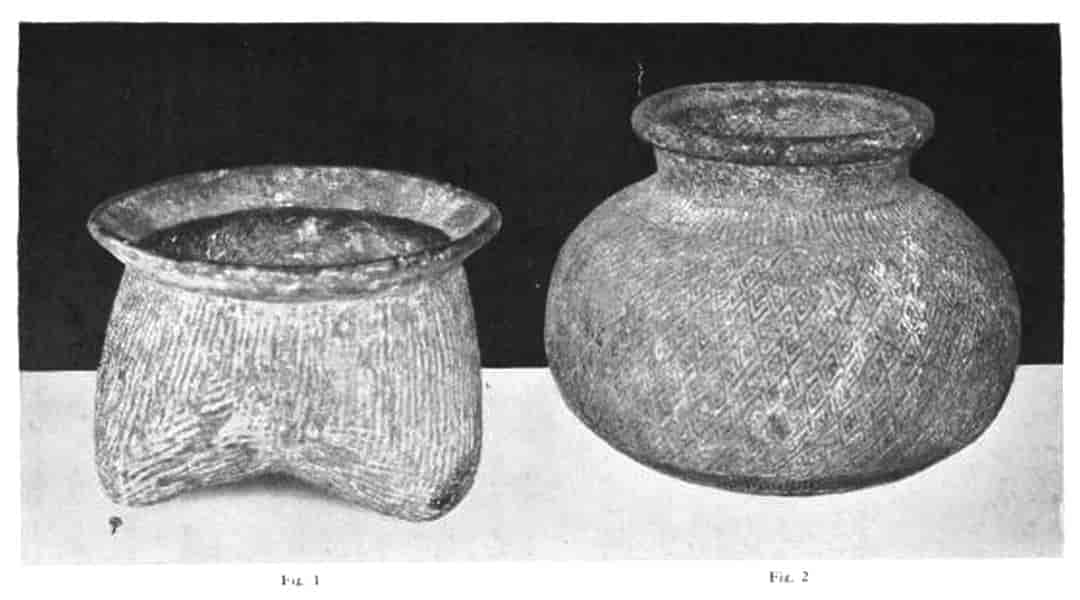
Plate 1.—Chou Pottery.
Fig. 1.—Tripod Food Vessel. Height 6 18 inches.
Fig. 2.—Jar with deeply cut lozenge pattern. Height 6 34 inches.
Eumorfopoulos Collection.
CHAPTER II
THE HAN  DYNASTY, 206 B. C. TO 220 A. D.
DYNASTY, 206 B. C. TO 220 A. D.
TWO centuries of internecine strife between the great feudal princes culminated in the destruction of the Chou dynasty and the consolidation of the Chinese states under the powerful Ch´in emperor Chêng. If this ambitious tyrant is famous in history for beating back the Hiung–nu Turks, the wild nomads of the north who had threatened to overrun the Chou states, and for building the Great Wall of China as a rampart against these dreaded invaders, he is far more infamous for the disastrous attempt to burn all existing books and records, by which, in his overweening pride, he hoped to wipe out past history and make good to posterity his arrogant title of Shih Huang Ti or First Emperor. His reign, however, was short, and his dynasty ended in 206 B. C. when his grandson gave himself up to Liu Pang, of the house of Han, and was assassinated within a few days of his surrender.
The Han dynasty, which began in 206 B. C. and continued till 220 A. D., united the states of China in a great and prosperous empire with widely extended boundaries. During this period the Chinese, who had already come into commercial contact with the kingdoms of Western Asia, sent expeditions, some peaceful and others warlike, to Turkestan, Fergana, Bactria, Sogdiana, and Parthia. They even contemplated an embassy to Rome, but the envoys who reached the Persian Gulf turned back in fear of the long sea journey round Arabia, the length and danger of which seem to have been vividly impressed upon them by persons interested, it is thought, in preventing their farther progress.[13] A considerable trade, chiefly in silks, had been opened up between China and the Roman provinces, and the Parthians who acted as middlemen had no desire to bring the two principals into direct communication.
Needless to say, China was not uninfluenced by this contact[6] with the West. The merchants brought back Syrian glass, the celebrated envoy Chang Ch´ien in the second century B. C. introduced the culture of the vine from Fergana and the pomegranate from Parthia, and some years later an armed expedition to Fergana returned with horses of the famous Nisæan breed. But from the artistic standpoint the most important event was the official introduction of Buddhism in 67 A. D. at the desire of the Emperor Ming Ti and the arrival of two Indian monks with the sacred books and images of Buddha at Lo–yang. The Buddhist art of India, which had met and mingled with the Greek on the north–west frontiers since Alexander's conquests, now obtained a foothold in China and began to exert an influence which spread like a wave over the empire and rolled on to Japan. But this influence had hardly time to develop before the end of the Han period, and in the meanwhile we must return to the conditions which existed in China at the beginning of the dynasty.
The hieratic culture of the Chou, and the traditions of Chou art with its rigid symbolism and formalised designs, had been broken in the long struggles which terminated the dynasty and banned by the iconoclastic aspirations of the tyrant Chêng, and though partially revived by Han enthusiasts, they were essentially modified by the new spirit of the age. Berthold Laufer,[14] in discussing the jade ornaments of the Chou and Han periods, speaks of the "impersonal and ethnical character of the art of that age"—viz. the Chou. "It was," he continues, "general and communistic; it applied to everybody in the community in the same form; it did not spring up from an individual thought, but presented an ethnical element, a national type. Sentiments move on manifold lines, and pendulate between numerous degrees of variations. When sentiment demanded its right and conquered its place in the art of the Han, the natural consequence was that at the same time when the individual keynote was sounded in the art motives, also variations of motives sprang into existence in proportion to the variations of sentiments. This implies the two new great factors which characterise the spirit of the Han time—individualism and variability—in poetry, in art, in culture, and life in general. The personal spirit in taste gradually awakens; it was now possible for everyone to choose a girdle ornament according to his liking. For the[7] first time we hear of names of artists under the Han—six painters under the Western Han, and nine under the Eastern Han; also of workers in bronze and other craftsmen.[15] The typical, traditional objects of antiquity now received a tinge of personality, or even gave way to new forms; these dissolved into numerous variations, to express correspondingly numerous shades of sentiment and to answer the demands of customers of various minds."
Religion has always exerted a powerful influence on art, especially among primitive peoples, and the religions of China at the beginning of the Han dynasty were headed by two great schools of thought—Confucianism and Taoism. These had absorbed and, to a great extent, already superseded the elements of primitive nature worship, which never entirely disappear. Confucianism, however, being rather a philosophy than a religion, and discouraging belief in the mystic and supernatural, had comparatively little influence on art. Taoism, on the other hand, with its worship of Longevity and its constant questing for the secrets of Immortality, supplied a host of legends and myths, spirits and demons, sages and fairies which provided endless motives for poetry, painting and the decorative arts. The Han emperor Wu Ti was a Taoist adept, and the story of the visit which he received from Hsi Wang Mu, the Queen Mother of the West, and of the expeditions which he sent to find Mount P´êng Lai, one of the sea–girt hills of the Immortals, have furnished numerous themes for artists and craftsmen.
It is not yet easy for people in this country to study the monuments of Han art, but facilities are increasing, and a good impression of one phase at least may be obtained from reproductions of the stone carvings in Shantung, executed about the middle of the Han dynasty, which have been published from rubbings by Professor E. Chavannes.[16] On these monuments historical and mythological subjects are portrayed in a curious mixture of imagination and realism.
But these general considerations are leading us rather far afield, and it remains to see how much or how little of them is reflected in the pottery of the time.
As far as our present knowledge of the subject permits us to[8] see, there is nothing in the pre–Han pottery to attract the collector. It will only interest him remotely and for antiquarian reasons, and he will prefer to look at it in museum cases rather than allow it to cumber his own cabinets. With the Han pottery it is otherwise. The antiquarian interest, which is by no means to be underestimated, is now supplemented by æsthetic attractions caught from the general artistic impetus which stirred the arts of this period of national greatness. Not that we must expect to find all the refinements of Han art mirrored in the pottery of the time. Chinese ceramic art was not yet capable of adequately expressing the refinements of the painter, jade carver, and bronze worker. But even with the somewhat coarse material at his disposal the Han potter was able to show his appreciation of majestic forms and appropriate ornament, and to translate, when called upon, even the commonplace objects of daily use into shapes pleasant to the eye. In a word, the ornamental possibilities of pottery were now realised, and the elements of an exquisite art may be said to have made their appearance. From a technical point of view, the most significant advance was made in the use of glaze. Though supported by negative evidence only, the theory that the Chinese first made use of glaze in the Han period is exceedingly plausible.[17] In the scanty references to earlier wares in ancient texts no mention of glaze appears, and, indeed, the severe simplicity of the older pottery is so emphatically urged that such an embellishment as glaze would seem to have been almost undesirable. The idea of glazing earthenware, if not evolved before, would now be naturally suggested to the Chinese by the pottery of the Western peoples with whom they first made contact about the beginning of the Han dynasty. Glazes had been used from high antiquity in Egypt, they are found in the Persian bricks at Susa and on the Parthian coffins, and they must have been commonplace on the pottery of Western Asia two hundred years before our era.
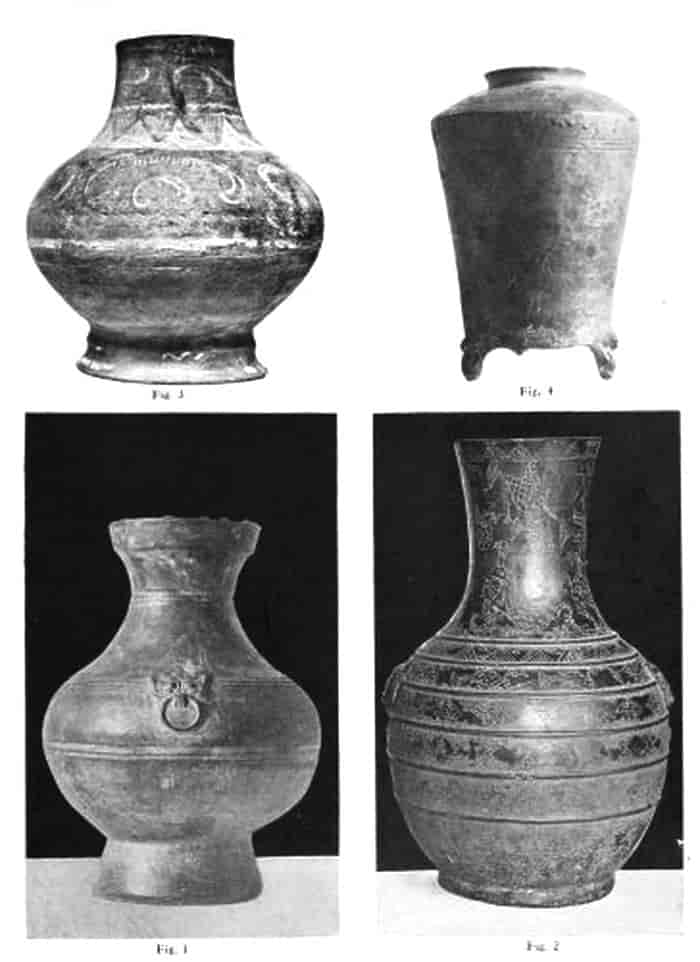
Plate 2.—Han Pottery.
Fig. 1.—Vase, green glazed. Height 14 inches. Boston Museum.
Fig. 2.—Vase with black surface and incised designs. Height 16 inches. Eumorfopoulos Collection.
Fig. 3.—Vase with designs in red, white and black pigments. Height 11 12 inches. British Museum.
Fig. 4.—"Granary urn," green glazed. Height 12 inches. Peters Collection.
It is possible, of course, that evidence may yet be forthcoming to carry back the use of glaze in China beyond the limits at present prescribed, but all we can state with certainty to–day is that the oldest known objects on which it appears are those which for full and sufficient reasons can be assigned to the Han period. To explain all these reasons would necessitate a long excursion into archæology which would be out of place here. Many of them can be found in Berthold Laufer's[18] excellent work on the subject, and others will in due course be set out in the catalogue of the British Museum collections. But it would be unfair to ask the reader to take these conclusions entirely on trust, and some idea of the evidence is certainly his due.
There are a few specimens of Han pottery inscribed with dates, such as the vase (Plate 2, Fig. 1) from the Dana Collection, which is now in the Boston Museum; but in almost every case the inscriptions have proved to be posthumous and must be regarded at best as recording the pious opinion of a subsequent owner. It will be safer, then, to leave inscriptions out of consideration and to rely on the close analogies which exist between the pottery and the bronze vessels of the Han period and between the decorative designs on the pottery and the Han stone sculptures, and, where possible, on the circumstances in which the vessels have been found. Unfortunately, the bulk of the Han pottery which has reached Europe in recent years has passed through traders' hands, and no records have been kept of its discovery. But there are exceptional cases in which we have first–hand evidence of Han tombs explored by Europeans, and in two instances their contents have been brought direct to the British Museum. Both these hauls are from the rock–tombs in[10] Szechuan, the one made by the ill–fated Lieutenant Brooke, who was murdered by the Lolos, the other by the Rev. Thomas Torrance, to whom I shall refer again. The evidence of both finds is mutually corroborative; it is supported by Han coins found in the tombs, by inscriptions carved on their doorways, and by the rare passages of decoration on the objects themselves, which correspond closely to designs on stone carvings published by Chavannes. In this way a whole chain of unassailable evidence has been welded together until, in spite of the remoteness of the period, we are able to speak with greater confidence about the Han pottery than about the productions of far more recent times.
The Han pottery is usually of red or slaty grey colour, varying in hardness from a soft earthenware to something approaching stoneware, and in texture from that of a brick to the fineness of delft. These variations are due to the nature of the clay in different localities and to the degree of heat in which the ware was fired. No chronological significance can be attached to the variations of colour, and to place the grey ware earlier than the red is both, unscientific and patently incorrect. Most of the Szechuan ware is grey and comparatively soft, while of the specimens sent from Northern China the majority seem to be of the red clay. Some of the ware from both parts is unglazed, and in certain cases it has been washed over with a white clay and even painted with unfired pigment, chiefly red and black. The bulk of it, however, is glazed, the typical Han glaze being a translucent greenish yellow, which, over the red body, produces a colour varying from leaf green to olive brown, according to the thickness of the glaze and the extent to which the colour of the underlying body appears through it. Age and burial have wonderfully affected this green glaze, and in many cases the surface is encrusted in the process of decay with iridescent layers of beautiful gold and silver lustre. In other cases the decay has gone too far, and the glaze has scaled and flaked off. Another feature which it shares with many of the later glazes is a minute and almost imperceptible crackle. This feature is almost universal on the softer Chinese pottery glazes, and has nothing to do[19] with the deliberate and pronounced crackle of later Chinese porcelain, being purely accidental in its formation.
The colour of the glaze shows considerable variations, being sometimes brownish yellow, sometimes deep brown, and occasionally mottled like that of our mediæval pottery. A passage in the T´ao shuo[20] seems to imply the existence of a black glaze as well, but it is a solitary literary reference, and it is not perfectly clear whether a black earthenware or a black glaze is meant. It was thought at one time that the fine white ware with pale straw–coloured or greenish glaze, of which much of the T´ang mortuary pottery is made, was in use as early as the Han period, but I am now convinced that this is a later development, and cannot be included in the ware of the Han dynasty.
Among the technical peculiarities of Han pottery, the marks—usually three in number—of small, oblong rectangular kiln supports will often be noticed under the base or on the mouth of the wares. These so–called "spur–marks" were made by the supports or rests on which the ware was placed when in the kiln. In many cases, too, large drops of glaze have formed on the mouth of the piece, proving that the vessel was fired in an inverted position, which directed the down flow of the glaze as it melted towards the mouth. This is by no means universal. Indeed, the glaze drops on other pieces are found on the base even when the "spur–marks" appear on the mouth. The explanation of these apparently contradictory phenomena is that to economise space one piece was sometimes placed on top of another in the kiln.
The ornamentation of Han pottery was accomplished in several ways: by pressing the ware in moulds with incuse designs, which produced a low relief on the surface of the pottery; by the use of stamps or dies[21]; and more especially by applying strips of ornament which had been separately formed in moulds. All these ornaments were covered by the glaze when glaze was used. Laufer has made an exhaustive study of Han decoration in his book, and it will be sufficient here to give a few typical examples.
On Plate 2, Fig. 1 is a green–glazed vase of typical Han form with two handles representing rings attached to tiger masks which are borrowed, like the general form of the piece, from a contemporary bronze. This vase, formerly in the Dana Collection and now in the[12] Fine Arts Museum at Boston, has a posthumous date[22] incised on the neck corresponding to the year 133 B. C.
Fig. 2 is a rare specimen with reddish body and polished black surface in which are incised designs of birds, dragons and fish, and bands of vandykes, lozenges and pointed quatrefoil ornaments. It has the usual mask handles, and stands 16 inches high.
On Plate 3, Fig. 1, is a "hill jar" with brown glaze, standing on three feet which are moulded with bear forms. On the side is a frieze in strong relief with hunting scenes of animals, such as the tiger, boar, monkey, deer, hydra and demon figures, spaced out by conventional waves. This kind of frieze is frequently found ornamenting the shoulders of vases such as Fig. 1 of Plate 2, and the animals are usually represented in vigorous movement, often with fore and hind legs outstretched in a "flying gallop." The cover is moulded to suggest mountains rising from sea waves (the sea–girt isles of the Taoist Immortals), peopled with animals.
Fig. 2 is a green–glazed box or covered bowl of elegant form, the cover moulded in low relief with a quatrefoil design surrounded by a frieze of animals.
Fig. 3 is an incense burner of rare form derived from a bronze. It is a variation of the more usual "hill censer" (po shan lu) which has the same body with a cover in the form of hills as on Fig. 1. In this case the cover suggests a lotus flower in bud, and is surmounted by a duck. The whole is coated with an iridescent green glaze.
A few choice specimens of green–glazed Han pottery in the S.T. Peters Collection includes a well–modelled duck, a handsome vase with mask handles and hexagonal base, and a good example of the "granary urn." The last is a grain jar which derives its form from a granary tower. In some instances the tiled roof of the tower is represented by tile–mouldings on the shoulder; but in this instance the form is entirely conventionalised into a cylindrical vase supported by three bear–shaped feet. The bear, an emblem of strength, is commonly employed in this capacity in Han art. Another ornamental form borrowed from a homely object is the model of a well–head, of cylindrical shape, with arched superstructure, in the centre of which a pulley–wheel is represented. The well bucket is usually added, resting on the edge of the well.
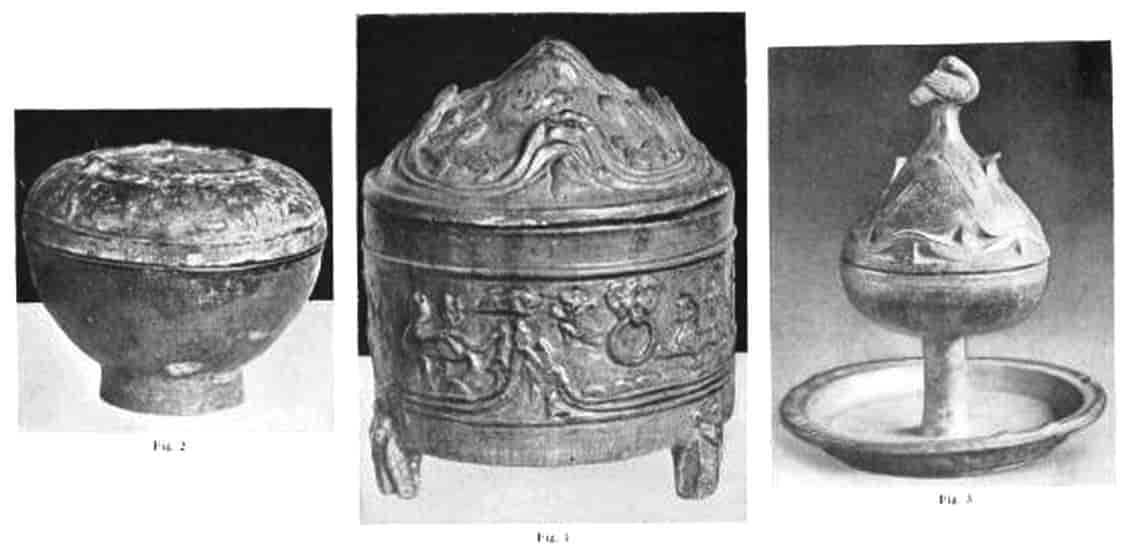
Plate 3.—Han Pottery.
Fig. 1.—"Hill Jar" with brown glaze. Height 9 12 inches inches. Eumorfopoulos Collection.
Fig. 2.—Box, green glazed. Height 5 12 inches inches. Eumorfopoulos Collection.
Fig. 3.—"Lotus Censer" green glazed. Height 10 12 inches inches. Rothenstein Collection.
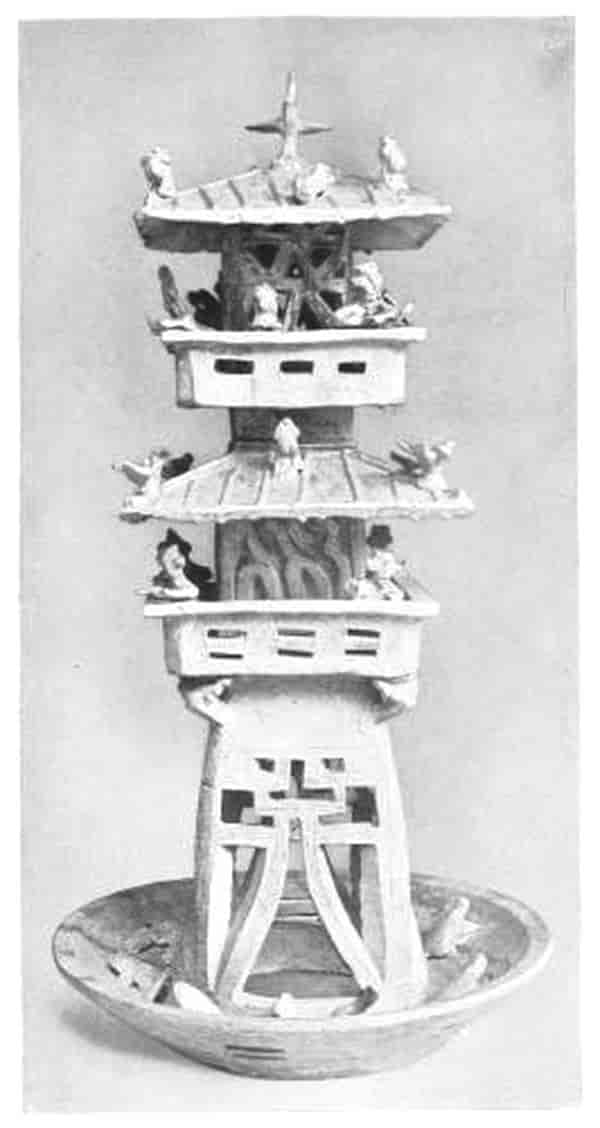
Plate 4.—Model of a "Fowling Tower."
Han pottery with iridescent green glaze. Height 30 inches.
Freer Collection.
Plate 4 illustrates a remarkable structure which seems to represent a fowling tower. Models of houses and shrines have been found frequently in Han tombs, showing most of the elements which are combined in this complex ornament. The structure of wooden beams and galleries and the roofs with their tubular tile–ridges, the formal ox–heads supporting the angles of the lower gallery, the ornamentation of combed lines, are all features which occur in architectural tomb ornaments of the Han period. Here we have apparently a sporting tower, with persons engaged in shooting with crossbows at the pigeons which tamely perch on the roof. The dead birds have fallen into the saucer–like stand below. This rare and curious specimen is made of green–glazed pottery, and measures about 30 inches in height.
As already indicated, our knowledge of Han pottery is mainly derived from the articles disinterred from the tombs of the period, and this will explain the curious fact that Han pottery was almost unknown until quite recent times, and that information on the subject in Chinese ceramic literature is of the most meagre and least satisfying description. The ancestor–worshipping Chinese have always been averse to the systematic exploration of graves. Whatever their practice may have been when the opportunity occurred of rifling a grave unobserved, this at any rate has been the avowed principle. The result is that though China must be honeycombed with graves and tombs, they have not been overtly disturbed in any numbers until recent years, when extensive railway cuttings have opened up the ground. To the progress of railway engineering the sudden appearance of considerable quantities of mortuary pottery is chiefly due.
On the other hand, one of our most interesting finds was made away from the railway in Szechuan. Here, in the neighbourhood of Ch´êng–tu and along the banks of the Min, the soft sandstone hills which line the river had in ancient times been extensively tunnelled with elaborate chambers protected by small entrance doors. Whether these were ever used as dwellings is uncertain, but they certainly became eventually the tenements of the dead. The deposits of ages have covered over the entrances to these tombs, but from time to time torrential rain or some other cause exposed their approaches to the country folk, who invariably pillaged them for coins and smashed and scattered their less marketable contents. The Rev. Thomas Torrance, when stationed at Ch´êng–tu, had the[14] opportunity of exploring some of these caverns, and even succeeded in discovering some unrifled tombs, part of the contents of which he brought over and presented to the British Museum. The funeral furniture of these tombs varied according to the wealth and status of the owner. In the poor man's tomb were unprotected skeletons, small images in a niche, an iron cooking pot, and a few coins. In the rich man's were terra cotta coffins, encased in ornamented slabs, images apparently of the members of his household, a quantity of crockery, and a perfect menagerie of domestic animals and birds. To quote Mr. Torrance's own words:[23] "Standing with your reflector in the midst of a large cave, it seems verily an imitation Noah's Ark."
The practice of burying with the dead the objects which surrounded him in life has never entirely ceased in any country. Among primitive peoples it has taken the revolting form of immolating, or even burying alive, the household of a dead chieftain. Instances of this practice in China occur as late as the third century b.c., and voluntary acts of sacrifice at the tomb are recorded much later in China as in India. When humaner counsels prevailed figures of wood, straw and clay were substituted, straw images being suggested for the purpose by Confucius himself. In the Han dynasty the tomb of the well–to–do was furnished with models of his house, his shrine, his farmyard, threshing floor, rice–pounder, his cattle, sheep, dogs, and poultry, besides his retainers and certain half–human creatures which may have been his guardian spirits; it was provided with vases for wine and grain, models of the stove and kitchen range with cooking pots and implements—the last merely indicated in low relief on the kitchen range—besides the more stately sacrificial vessels for wine and incense.[24] All these were modelled in pottery, and must have fostered a flourishing potter's trade, and given a tremendous impetus to the growth of modelling and design. The underlying idea of all this was, no doubt, to provide the spirit of the dead with the means of pursuing the habits of his lifetime, and the modern practice of supplying his needs by means of paper models which are transmitted to the[15] spirit world through the medium of fire serves the same purpose in a more economical fashion. But a fuller note on the grave furniture of the Han and T´ang periods will be given in the next chapter.
Little or nothing is at present known of the potteries in which the Han wares were made, but we may fairly assume that the manufacture was very general and that local potteries supplied local demands. An incidental reference in the T´ao lu gives us one solitary name, Nan Shan, where the potteries of the Emperor Wu Ti (140–85 B. C.) were situated;[25] and there is a mention of potteries in Kiangsi in the place which was afterwards the site of the celebrated porcelain centre, Ching–tê Chên.
The interval between the Han and T´ang periods, from 221 to 618 A. D., is marked by a rapid succession of short–lived dynasties, an age of conflict and division, in which China was again split up into warring states. The conditions were not favourable to the steady development of the ceramic industry, and little is known of the pottery of this period. From the few references in Chinese literature, however, we infer that new kinds of pottery appeared from time to time, and it is certain that the evolution which culminated in porcelain made sensible advances. This latter fact is proved by the scientific analysis of some vases obtained by Dr. Laufer near Hsi–an Fu in Shensi. There is a similar vase in the British Museum with ovoid body strongly marked with wheel–ridges, short neck and wide cup–shaped mouth, and loop handles on the shoulders. The ware is in appearance a reddish stoneware, and the glaze which covers the upper part is translucent greenish brown with signs of crackle. Dr. Laufer's vases are in the Field Museum at Chicago, where the body and glaze have been analysed by Mr. Nicholls, the results showing that the body is composed of a kaolin–like material (probably a kind of decomposed pegmatite) and is, in fact, an incipient porcelain, lacking a sufficient grinding of the material. The glaze is composed of the same material softened with powdered limestone and coloured with iron oxide. An iron cooking stove found with these vases has an inscription indicating by its style a date in the Han dynasty or shortly after it; and the nature of the pottery, in spite of its coarse grain and dark colour, which is probably due in part to the presence of iron in the clay, seems to show that the manufacture of porcelain was not far distant.
Meanwhile, there is little doubt that the Han traditions were kept alive, and the discovery of green glazed ware of Han type in the ruins of Bazaklik, in Turfan,[26] a site which from other indications appears to belong to the T´ang civilisation, shows that this type, at any rate, was long–lived. Two vases from a grave on the Black Rock Hill in Fu Chou, and now in the British Museum, which are proved to belong to a period anterior to the seventh century, seem to combine Han and T´ang characteristics. They are of dark grey stoneware with a mottled greenish brown glaze, ending considerably above the base in a wavy line, which is a common feature of T´ang wares.
It is highly probable that some of the tomb pottery discussed in the next chapter belongs to the later part of this intermediate period. Indeed among the pottery figures of this class there are specimens with slender, graceful bodies and elaborate details of costume (see Plate 7) which closely resemble the stone statues of the Northern Wei and the Sui dynasties; but with our present imperfect information on the tomb finds, it will be more convenient to treat these nearly related figures as one group.
Turning to Chinese literature, in default of other and more tangible evidence, we read in the T´ao shuo[27] of pottery dishes and wine vessels in the Wei dynasty (220–264 A. D.), and in the T´ao lu of pottery made at Kuan Chung, in the district of Hsi–an Fu, and at Lo–yang for Imperial use. The poet P´an Yo, of the Chin dynasty (265–419 A. D.), speaks of "cups of green ware." The actual words used are p´iao tz´ŭ,[28] of which the former is elsewhere used to describe "the bright tint of distant, well–wooded mountains," and as a synonym for lü (green), though, like the common colour word ch´ing, it is capable of meaning both blue and green. The ceramic glaze which most closely corresponds to the description p´iao is the bluish green celadon best known from Corean wares, but we have not yet sufficient grounds for assuming the existence of this particular type at such an early date.
Another poet[29] of the same period bids his countrymen, when [17]selecting cups for tea–drinking, to choose the ware of Eastern Ou, a place in the Yüeh territory, and apparently in the neighbourhood of, if not identical with, the Yüeh Chou, which was celebrated for its wares in the T´ang dynasty. The period of the "Northern and Southern Dynasties" provides but two references, to a kind of wine vessel known as "crane cups" but otherwise unexplained, and to chün–ch´ih of fine and coarse ware,[30] which appear to have been Buddhist water vases for ceremonial washing, or Kundikâ, which the Chinese have transcribed in the form Chün–ch´ih–ka.
Buddhism was making great strides in China at this time. It was proclaimed the state religion of the Toba Tartars or Northern Wei, who ruled the north from 386 to 549 A. D., and Buddhist thought and the canons of Buddhist art were now firmly imposed upon the Chinese. The rock sculptures of this period visited and photographed by Chavannes show unmistakable traces of the Græco–Buddhist art of Gandhara; and in one remarkable instance among the figures which were sculptured round the entrance of a Buddhist grotto were deities with a thyrsus like that of Dionysus and a trident like Poseidon's.
In the annals of the brief Sui dynasty (581–617 A. D.), we find that a man named Ho Ch´ou succeeded in exactly imitating a glassy material called liu li by means of green ware. The exact meaning of this interesting passage is discussed elsewhere (p. 144), but it is difficult to imagine any but a porcellanous ware which could satisfy the conditions implied. Under the circumstance it is not surprising if theorists see in this green ware (lü tz´ŭ) something in the nature of the later celadon porcelain.
NOTE ON THE EARLY CHINESE TOMB WARES
With reference to the figures of men and animals and the other objects which were placed in the ancient tombs of China, much information will be found in Dr. J.J.M. de Groot's Religious System of China. The fundamental idea underlying these burial practices seems to have been that the soul of the dead was the actual tenant of the grave; but it is not clear in every case whether the sepulchral furniture was provided in expectation of a bodily resurrection, or in the belief that it would minister to the wants of the[18] dead in his spiritual existence. Both ideas appear to have obtained in early times, though it is certain that the second alone explains the more modern custom of burning either the objects themselves or paper counterfeits of them at the tomb, and thus transmitting them through the medium of fire direct to the spirit world.
The older custom of burying with the dead all that was necessary for the continuation of the pursuits of his lifetime, dates back to the farthest limits of history, so that we read without surprise that in the Chou dynasty (1122–255 B. C.) there were placed in the tomb "three earthen pots with pickled meat, preserved meat, and sliced food; two earthen jars with must and spirits,"[31] besides "clothes, mirrors, weapons, jade and food pots." It became customary to hold a preliminary exhibition of the funeral articles at the dead man's house before removing them to the tomb, and this, as we may well imagine in a country of ancestor–worshippers, led to ostentation and extravagance which legislators of various periods vainly endeavoured to curtail.
The magnificent burials of the Chin and early Han emperors, the vast mausolea built by forced labour and stocked with costly furniture and treasure, chariots and live animals, and even human victims, must have been an intolerable burden to the community. There is no lack of instances of the immolation, voluntary or otherwise, of relatives and retainers at the tombs of great personages in ancient China, though the practice never seems to have been general, and was strongly reprobated by Confucius (551–479 B. C.). The sage even went so far as to condemn the substitution of wooden puppets, "for was there not a danger of their leading to the use of living victims?"[32] Images of straw were all that he would permit.
When humaner influences prevailed, the ladies of the harem, and the military guards, instead of following their Imperial master to the spirit world, were condemned to reside within the precincts of the mausoleum; and doubtless the clay figures of women and warriors placed in the graves of more enlightened times were intended to relieve their human prototypes of this irksome duty. The earliest recorded allusion[33] to clay substitutes appears to be the words of Kuang Wu (in the first century A. D.), that "anciently,[19] at every burial of an emperor or king, human images of stoneware (t´ao jên), implements of earthenware (wa ch´i), wooden cars, and straw horses were used."
De Groot[34] quotes a long list of objects supplied for an Imperial burial of the Later Han (25–220 A. D.), including "eight hampers of various grains and pease; three earthen pots of three pints, holding respectively pickled meat, preserved meat, and sliced food; two earthen liquor jars of three pints, filled with must and spirits; ... one candlestick of earthenware; ... eight goblets, tureens, pots, square baskets, wine jars; one wash–basin with a ewer; bells, ... musical instruments, ... arms; nine carriages, and thirty–six straw images of men and horses; two cooking stoves, two kettles, one rice strainer, and twelve caldrons of five pints, all of earthenware; ... ten rice dishes of earthenware, two wine pots of earthenware holding five pints." The use of earthenware substitutes for the actual belongings of the dead was due in part to the spirit of economy preached by certain rulers at this time, and in part to the feeling that graves containing valueless objects would be safe from the desecration of the robber.
In addition to the general precepts of economy, we learn that definite regulations were issued prescribing the number and even the nature of the articles to be used by the various ranks of the nobility and by the proletariat. Thus in 682 A. D. Kao Tsung rebuked the competitive extravagance of the people in burial equipments, which even the ravages of famine had failed to diminish; and in the K´ai Yüan period an Imperial decree[35] of the year 741 A. D. reduced the number of implements allowed to the various ranks in burial, officers of the first, second, and third classes of nobility being allowed seventy, forty, and twenty implements in place of ninety, seventy, and forty respectively; while for the common people fifteen only were permitted. Moreover, all such implements were to be of plain earthenware (ssŭ wa), wood, gold, silver, copper, and tin being forbidden.
It is clear that at an early date wood was regarded as preferable to pottery as a material for sepulchral furniture, for the Yin–yang tsa tsu,[36] written in the eighth century, states that "houses and sheds, cars and horses, male and female slaves, horned cattle, and so forth, are made of wood." Indeed, the decree of 741 notwithstanding, wood seems to have become the standard material[20] for grave implements from this time onward. Thus, Chu Hsi of the Sung dynasty taught in his Ritual of Family Life "the custom of burying the dead with a good many wooden servants, followers, and female attendants, all holding in their hands articles for use and food"; and the contents of the Ming graves included "a furnace–kettle and a furnace, both of wood, saucer with stand, pot, or vase, an earthen wine–pot, a spittoon, a water basin, an incense burner, two candlesticks, an incense box, a tea–cup, a tea–saucer, two chopsticks, two spoons, etc., two wooden bowls, twelve wooden platters, various articles of furniture, including bed, screen, chest, and couch, all of wood; sixteen musicians, twenty–four armed lifeguards, six bearers, ten female attendants; the spirits known as the Azure Dragon, the White Tiger, the Red Bird, and the Black Warrior; the two Spirits of the Doorway and ten warriors—all made of wood and one foot high." These were among the implements permitted in the tombs of grandees; the regulations of 1372 allowed only one kind of implement in the tombs of the common folk.
From the foregoing passages it may be inferred that wood superseded pottery to a very great extent in the funeral furniture of the Sung and Ming periods, and consequently that the tombs in which a full pottery equipment has been found are most probably not later than the first half of the T´ang dynasty. Needless to say, the wooden paraphernalia rapidly perished under the ground, and while the pottery implements have preserved their original form and appearance, the wooden objects have mostly disintegrated.
An amusing fragment of folklore, translated by de Groot[37] from the Kuang i chi, "a work probably written in the tenth century," will form a fitting conclusion to this note, revealing as it does the thought of the Chinese of this period with regard to the burial customs which we have discussed:—
"During one of the last generations there lived a man, who used to travel the country as an itinerant trader in the environs of the place where his family was settled. Having been accompanied on one of his excursions for several days by a certain man, the latter unexpectedly said, 'I am a ghost. Every day and every night I am obliged to fight and quarrel with the objects buried in my tomb for the use of my manes, because they oppose my will.[21] I hope you will not refuse to speak a few words for me, to help me out of this calamitous state of disorder. What will you do in this case?' 'If a good result be attainable,' replied the trader, 'I dare undertake anything.' About twilight they came to a large tomb, located on the left side of the road. Pointing to it, the ghost said: 'This is my grave. Stand in front of it and exclaim, "By Imperial Order, behead thy gold and silver subjects, and all will be over." Hereupon the ghost entered the grave. The pedlar shouted out the order, and during some moments he heard a noise like that produced by an executioner's sword. After a while the ghost came forth from the tomb, his hands filled with several decapitated men and horses of gold and silver. 'Accept these things,' he said; 'they will sufficiently ensure your felicity for the whole of your life; take them as a reward for what you have done for me.' When our pedlar reached the Western metropolis he was denounced to the prefect of the district by a detective from Ch´ang–ngan city, who held that such antique objects could only have been obtained from a grave broken open. The man gave the prefect a veracious account of what had happened, and this magistrate reported the matter to the higher authorities, who sent it on to the Throne. Some persons were dispatched to the grave with the pedlar. They opened the grave, and found therein hundreds of gold and silver images of men and horses with their heads severed from their bodies."
In the present day[38] at important sacrifices to ancestors (and presumably at the funeral itself), it is customary to burn counterfeits of all kinds of furniture and objects which might be useful in the spirit–world. In general these counterfeits take the form of small square sheets of cheap paper adorned with pictures, stamped with a rudely carved wooden die, and representing houses, chairs, implements for cooking, writing and the toilette, carts and horses, sedan chairs, attendants and servants, slaves (male and female), cattle, etc. It is not clear when this custom first came into being, but it evidently replaced an earlier practice of burning real furniture, clothing, etc., at the tomb; and de Groot implies, at any rate, that the two practices existed side by side in the eleventh century. "Bonfires of genuine articles," he says,[39] "and valuables continued for a long time to hold a place side by side with bonfires of counterfeits. We read e.g. that at the demise of the Emperor[22] Shêng Tsung of the Liao dynasty (1030 A. D.) the departure of the cortège of death from the palace was marked by a sacrifice, at which they took clothes, bows and arrows, saddles, bridles, pictures of horses, of camels, lifeguards, and similar things, which were all committed to the flames." Marco Polo,[40] in describing the city of Kinsai, relates that the inhabitants burnt their dead, and "threw into the flames many pieces of cotton paper upon which were painted representations of male and female servants, horses, camels, silk wrought with gold, as well as gold and silver money."
CHAPTER III
THE T´ANG  DYNASTY, 618–906 A. D.
DYNASTY, 618–906 A. D.
THE Chinese Empire, reunited by the Sui emperors, reached the zenith of its power under the world–famed dynasty of the T´ang (618-906 A. D.). A Chinese general penetrated into Central India and took the capital, Magadha, in 648. Chinese junks sailed into the Persian Gulf, and the northern boundaries of the empire extended into Turkestan, where traces of a flourishing civilisation have been discovered in the sand–buried cities in the regions of Turfan and Khotan, recently explored by Sir Aurel Stein and by a German expedition under Professor Grünwedel. In return, we read of Arab settlers in Yunnan and in Canton and the coast towns, and the last of the Sassanids appealed to China for help. A host of foreign influences must have penetrated the Middle Kingdom at this time, including those of the Indian, Persian, and Byzantine arts. Proof of this, if proof were needed, is seen in the wonderful treasures preserved in the Shoso–in at Nara in Japan, a temple museum stocked in the eighth century chiefly with the personal belongings of the Emperor Shomu, most of which had been sent over from China. Indeed, the Nara treasure is, in many respects, the most comprehensive exhibition of T´ang craftsmanship which exists to-day.
The long period of prosperity enjoyed by China under the T´ang is famed in history as the golden age of literature and art. The age which produced the poet Li Po, the painter Wu Tao–tzŭ, and the poet–painter Wang Wei, whose "poems were pictures and his pictures poems," was indeed an age of giants. It is certain that the potter's art shared in no small measure the progress of the period, though at this distance of time we can hardly expect that many monuments of this fragile art should have survived. Indeed, it has been the custom of writers in the past to dismiss the T´ang pottery in a few words, or to disregard it entirely as an unknown[24] quantity Here, however, we have again been well served by the ancient burial customs of the Chinese, which still held good for part, at least, of the T´ang period.
The T´ang mortuary wares are similar in intention to those of the Han, but bespeak a much maturer art. The modelling of the tomb figures, which have been aptly compared with the Tanagra statuettes of ancient Greece, displays greater skill, spirit, and delicacy, and the materials used are more refined and varied. The body of the ware, which is usually fine as pipeclay, varies in hardness from soft earthenware, easily scratchable with a knife, to a hard porcellanous stoneware, and in colour from light grey and pale rosy buff to white, like plaster–of–Paris. The usual covering is a thin, finely crackled glaze of pale straw colour or light transparent green, and sometimes the surface has a wash of white clay between the body and the glaze. Some of the figures, however, are more richly coated in amber brown and leaf green glazes with occasional splashes of blue, while on others are found traces of unfired red and black pigments.
But as the mortuary pottery[41] comprises the largest and most important group of T´ang wares at present identified, we cannot do better than consider it first and as a separate class, setting forth at once the reasons for assigning it to this particular period. As will be seen in the note to the previous chapter (p. 17), earthenware appears to have been to a great extent superseded by wood as the fashionable material for sepulchral furniture towards the end of the T´ang period. This in itself is strong primâ facie evidence that the tombs furnished throughout with pottery are not later than the T´ang dynasty. Another argument of an ethnographical nature is supplied by the figures of ladies with feet of normal size. The fashion of cramping the feet, though it may have begun before the T´ang period, was certainly not universal until the end of this long dynasty.[42]
But there are other cogent reasons which will appeal more directly to the student of ceramics. Among the few specimens of pottery in the Nara Collection,[43] there are several bowls and a dish, accorded in the official catalogue the meagre description "China ware," which have a peculiar glaze of creamy yellow with large, green mottling, and there is besides a drum–shaped vase, "green with yellowish patches." This type of glaze is found on many of the tomb wares, some of which have amber brown and violet blue splashes in addition. From these data it is possible to identify a series of T´ang glazes, including creamy white, straw yellow, faint green, leaf green, amber and violet blue, all soft and more or less transparent with minutely crackled texture and closely analogous to the coloured lead glazes used on our own "Whieldon" pottery of Staffordshire in the eighteenth century. Three years ago a Parisian dealer was offering for sale the contents of an important tomb. For once in a way, the chief articles of the find had been kept together; at least so it was positively asserted, and there was nothing improbable in the circumstance. They included two splendidly modelled figures and a saddled horse in the typical T´ang ware, with bold washes of green and brown glazes, and with them was a stone slab engraved with an inscription. I was able to examine a photograph and a rubbing of this stone, in which excellent judges could find no sign of spurious work. The inscription was long and difficult to translate, but the main facts were clear. It commemorated a princely personage of the name of Wên, whose style was Shou–ch´êng, a man of Lo–yang in Honan, who died at Ho–yang Hsien on the 16th day of the first month of the second year of Yung Shun, viz. 683 A. D.
Among the T´ang figurines the horse is conspicuous not only in its comparative frequency, but for the spirit and character with which it is portrayed. The men of T´ang were clearly great horse lovers. Their pictorial artists excelled in painting the noble beast, and the "Hundred Colts" by the celebrated painter Han Kan is a classic of horse painting. Among the precious fragments of T´ang pictures on silk which Sir Aurel Stein brought back from his first expedition in the Taklamakan Desert there were several with scenes in which horsemen figured. I have compared these with the tomb figures and found them to tally with wonderful exactitude,[26] not only in pose and style and in the characteristic rendering of the head and neck, but also in the details of the harness, the saddle with high arched front and shelving back support, the square stirrups, bridle and bit and tassel–like pendant under the mouth.
A complete set of grave goods from a tomb opened by the Lao–tung railway near Lao Yang in the Honan Fu have been acquired by the British Museum through a railway engineer on the spot. They may be taken as a typical and, I believe, quite reliable, example of the grave furniture of a T'ang personage of importance. They include six covered jars of graceful oval form, made of hard white ware and coated with thin glaze of pale yellowish or faint green tint, which ends in the characteristic T'ang fashion in a wavy line several inches above the base. They measure about thirteen inches in height. These are presumed to have held the six kinds of grain. Next comes a graceful vase, probably for wine, with ovoid body, tall, slender neck, with two horizontal bands, a cup–shaped mouth, and two high, elegantly carved handles with serpent heads which bite on to the rim (Plate 14, Fig. 2). The only other vessels were a circular tray, on which stood a small, squat vase, with trilobe sides, small mouth, and three rudimentary feet, surrounded by seven shallow cups. Like the wine vase and covered jars, these have flat bases, in most cases carefully smoothed and lightly bevelled at the edge.[44] The retinue consisted of a charming figure of a lady on a horse, eight other ladies (probably of the harem) with high, peaked head–dress, low–necked dresses with high waists, and a shawl over the shoulders and falling down from the arms like two long sleeves; natural feet are indicated in every case. With these were two figures of priestly appearance, with long cloaks and hoods, three other men in distinctive costumes, eleven retainers in civil costume with peaked head–gear, long coats with lappets open at the neck, waist belts, and high boots, their right hands held across the breast and their left at the side. One of these figures is remarkable for his foreign features, with exaggerated and pointed nose, suggesting a Western Asiatic origin. There are, besides, four men, apparently in armour, and two tall figures who seem to wear cap helmets with camail falling down the neck and breast armour, recalling in many ways our own mediæval men–at–arms. The supernatural element is represented by two strange, squatting quadrupeds with legs like a bull, human heads with large ears and a single horn which are called by the Chinese t'u kuai or "earth–spirits." Finally, in addition to man and super–man, the animal world was represented by two saddled horses, two dromedaries, two pigs, two sheep, a beautifully modelled dog, and a goose. What more could a man desire in the underworld? All these figures are of the usual white plaster–like body, with the pale, straw–coloured or greenish glazes which long burial has dissolved into iridescence where it has not actually caused it to flake away. Some of them stand on flat, plain bases; others on their own feet and robes. The latter kind are all hollow beneath, and the quadrupeds have a large cavity under the belly, a feature common to the T'ang and Han animals, and one which I have noticed on bronzes of the same periods. Needless to add, these figures were made in moulds, the seams of which are still visible.[45]
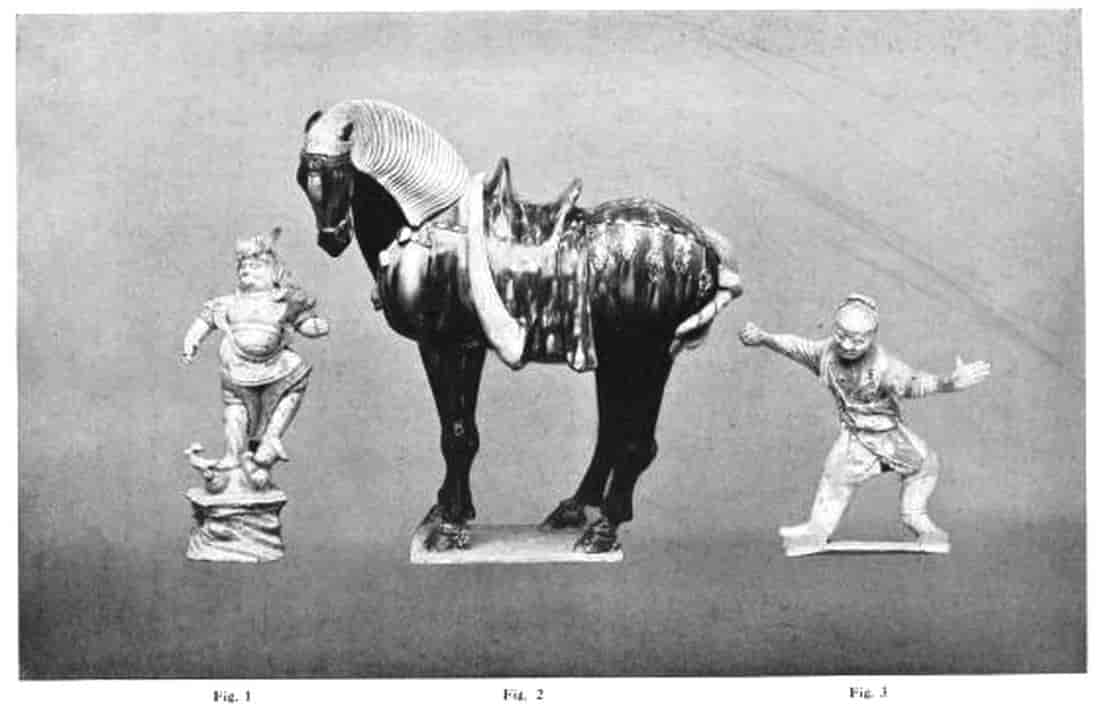
Plate 5.—T'ang Sepulchral Figures. In the Benson Collection.
Fig. 1.—A Lokapala or Guardian of one of the Quarters, unglazed.
Fig. 2.—A Horse, with coloured glazes. Height 27 inches.
Fig. 3.—An Actor, unglazed.
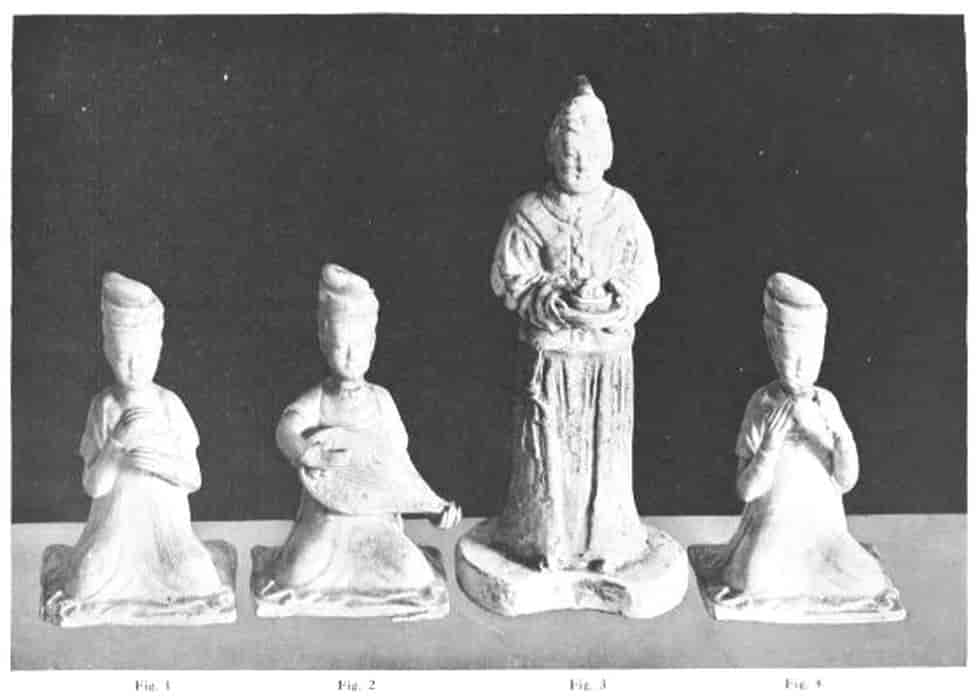
Plate 6.—T'ang Sepulchral Figures, unglazed.
Figs. 1, 2 and 4.—Female Musicians.
Fig. 3.—Attendant with dish of food. Height 9 12 inches.
Eumorfopoulos Collection.
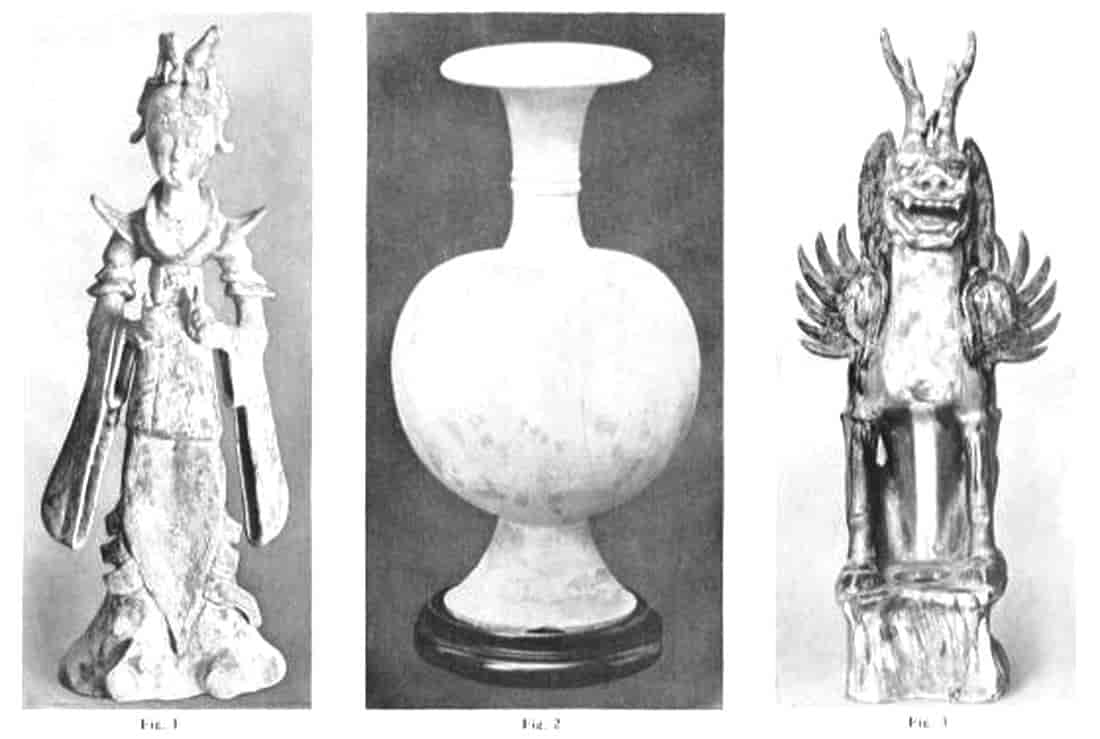
Plate 7.—T'ang Sepulchral Pottery.
Fig. 1.—Figure of a Lady in elaborate costume, unglazed. Height 14 12. Eumorfopoulos Collection.
Fig. 2.—Vase, white pottery with traces of blue mottling: the glaze has perished. Height 8 12 inches. Breuer Collection.
Fig. 3.—Sphinx–like Monster, green and yellow glazes. Height 25 inches. Eumorfopoulos Collection.
A few examples of the tomb figures are illustrated in the adjoining plates. The tall, slender figure on Plate 7, Fig. 1, seems to represent a lady of distinction. The elaborate head–dress and costume, the necklace and pendant and the belt are all carefully modelled; and the Elizabethan appearance of the collar is curious and interesting. The ware is soft and white like pipeclay, though still caked with the reddish loess clay from which it was exhumed. The style of this figure with its slender proportions is analogous to that of the graceful stone sculptures of the Northern Wei period. The genial monster in white clay and splashed green and yellow glazes illustrated on Plate 7 is one of the many sphinx–like creatures found in the tombs over which they were supposed to exercise a beneficial influence. Sometimes they have human heads on the bull body, and they are then described as t'u kuai or earth–spirits. In the present example we have a form which strongly resembles certain Persian or Sassanian monsters in bronze; and it is highly probable that the idea of this creature came from a western Asiatic source.
Plate 5 shows a fine example of a horse in coloured glazes, a fierce figure in warrior's guise, who is, no doubt, one of the Lokapalas[28] or Guardians of the Four Quarters in the Buddhist theogony, and a figure of an actor. The amusements, as well as the serious occupations of the dead, were provided for in the furniture of the tombs. A whole troop of mimes in quaint costumes and dramatic poses is shown in the Field Museum at Chicago, and Plate 6 illustrates three seated figures of musicians as well as a standing figure holding a dish of fruit.
A study of the salient features of these and other authenticated specimens leads naturally to the identification of fresh types, and so the series grows. For instance, the type of wine vase with serpent handles is found in glazes of various colours, till of the mottled T'ang kind, and with slight additions, such as the palmette–like ornaments in applied relief on a large example in the British Museum. These ornaments in their turn appear on bowls and incense vases often of globular form, like the well–known Buddhist begging bowl, but fitted with three legs. Splashed, streaked and mottled glazes further declare these to be T'ang, and the varying colour and hardness of their body material give us a deeper insight into the T'ang ware. All of these show the marks of the wheel, and many are neatly finished with simple wheel–made lines and ridges; stamped ornaments in applied relief are their commonest form of decoration.
A fine specimen in the British Museum will serve to illustrate this type of bowl. It has a hard, white body, of typical globular form, with slightly constricted mouth, three legs with strongly modelled lion masks on the upper part, and between them pads of applied relief with lion mask ornaments. The glaze is not of the mottled kind, but is rather streaked; it is deep, cucumber green and minutely crackled, and has run down into drops under the bowl. This fluidity is also the cause of the streakiness of the colour, which was evidently a characteristic feature of the T'ang pottery, for it appears unmistakably indicated in a T'ang painting figured by Sir Aurel Stein.[46] This painting, a silk banner of the T'ang period, was found in a walled–up library at Tun–huang, and depicts a standing Buddhist figure carrying a begging bowl with boldly streaked exterior.
PLATE 8.
Three examples of T'ang ware with coloured glazes: in the Eumorfopoulos Collection.
Fig. 1.—Tripod Incense Vase with ribbed sides; white pottery with deep blue glaze outside encrusted with iridescence. Height 4 58 inches.
Fig. 2.—Amphora of light coloured pottery with splashed glaze. Mark incised Ma Chên–shih tsao ("made by Ma Chên–shih"). Height 8 14 inches.
Fig. 3.—Ewer of hard white porcellanous ware with deep purple glaze. Height 4 34 inches.
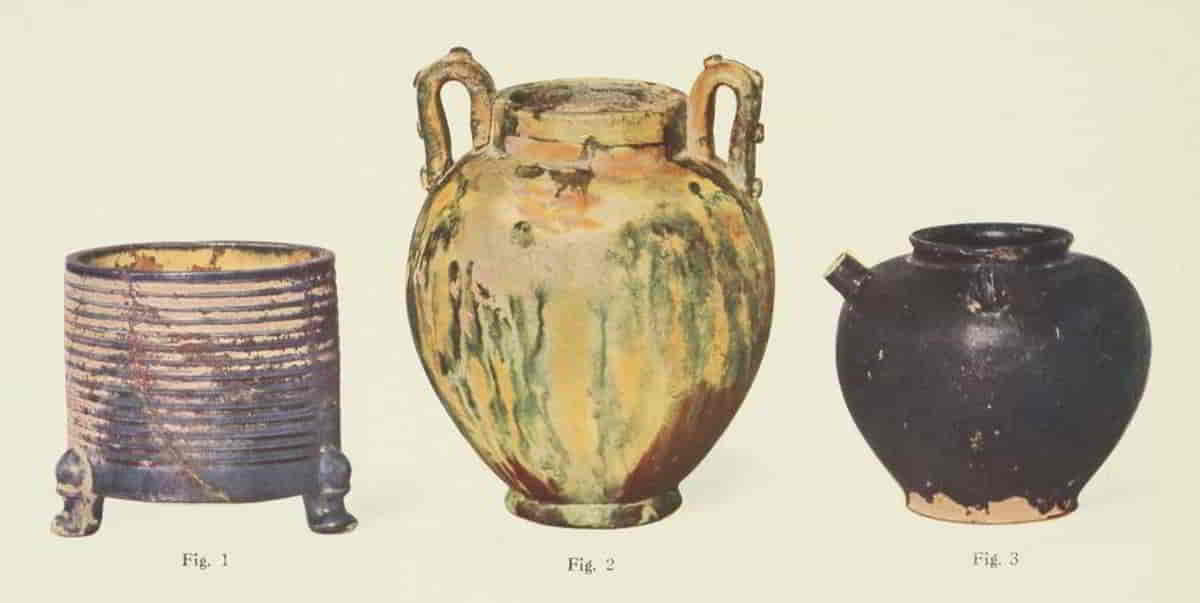
In addition to the mottled glazes—which, by the way, are the forerunners of the so–called "tiger–skin" porcelains of the seventeenth and eighteenth centuries—and the single colours already mentioned, instances have been identified on the principles already indicated of wares with a full yellow glaze and a streaky, brownish yellow. An interesting piece (Plate 8) in the Eumorfopoulos Collection is covered with a deep violet blue glaze on a fine white body. Others, again, have a dark chocolate brown glaze on a reddish buff body, and a rare ewer in the British Museum is distinguished by a deep olive brown glaze flecked with tea green, which seems to anticipate by a thousand years the "tea dust" glazes of the Ch'ien Lung period.[47]
Another variety of T'ang glaze, of which I have seen one example, was an olive brown with large splashes of a light colour, a greyish white, but with surface so frosted over by decay that its original intention remained in doubt. One might say that this was the father of the Japanese Takatori glazes with deep brown under–colour and large patches of frothy white. We may mention here three remarkable specimens found in a grave with a T'ang mirror and described in Man in 1901,[48] which are in the British Museum. One is an oblate ovoid vase, with small neck and mouth, of hard, light buff body, coated with a dull greenish black glaze with minute specks of lighter colour. The others are tea bowls of hard buff ware with dull brick–red glaze, not far removed in colour from the Samian ware of Roman times. No exact Chinese parallel has yet been found to these three pieces, though something approaching them is seen in certain bowls in the Eumorfopoulos collection which have a reddish brown glaze breaking into black, being apparently of the type associated with the name of Chien yao,[49] and which are known in Japan as kaki temmoku. This early kind of temmoku, which was probably made in Honan, has a hard whitish body, and the glaze is sometimes flecked with tea green as well as with golden brown. In some cases, too, a floral design or a leaf has been impressed or stencilled on the black glaze and appears in the brown or green colour (Plate 43, Fig. 1). It is said that a somewhat similar brown temmoku ware was made in Corea as well.
The survival of the leaf green glaze of Han type has already been noted. It occurs in Plates 12 and 13.
A pale bluish green glaze, somewhat akin to a later variety of celadon, appears on a few small bowls and jars which have the characteristic T'ang finish: I have seen several figures of lions with a crackled light greenish brown glaze; and a considerable class of bowls and melon–shaped vases have been found in Shansi with a hard buff stoneware body, coated with white slip under a transparent and almost colourless glaze, the combination producing a solid white or ivory colour (Plate 11, Fig. 3). These bowls have been considered by some Chinese authorities to be a production of the Ta Yi[50] kilns in Szechuan, but as there were factories in Shansi,[51] where wares of this type are reputed to have been made in T'ang times, it seems more probable that they are of local make. It should be added that the brown, tea dust, black, celadon and white glazes are high–fired and essentially different from the soft, crackled lead glazes previously described.
Apart from modelling in the round, an art in which we have seen that the T'ang potters excelled, the decorative ornament of the pottery hitherto discussed has been confined to applied reliefs. The processes of carving and engraving come early in the evolution of the potter's art in China, and we should expect to find in the T'ang wares some indications of the skill in these methods for which the Sung potters were so celebrated. Plate 12, Fig. 2, illustrates the use of engraved ornament under a green glaze, and the piece is remarkable not only for its elegant design, but for the beautiful lines of its simple form. A few years ago I saw for the first time one or two stands and boxes with patterns intricate as brocade work, floral scrolls, and geometrical designs, engraved with a point, and the spaces filled in with coloured glazes. They were reputed to be of T'ang date, and though no further evidence existed to prove that objects of such advanced technique and mature design really belonged to this remote period the proposition did not seem an impossible one. The textiles, inlaid woodwork, and painted lacquer in the Nara collections have just such designs which at first sight fill one with amazement at their modern feeling. A piece of brocade of undoubted T'ang origin, figured by Sir Aurel Stein,[52] with floral scrolls worked in silk, looks like a piece of late Persian embroidery. And is not the art of the T´ang painters essentially modern in the directness of its appeal?
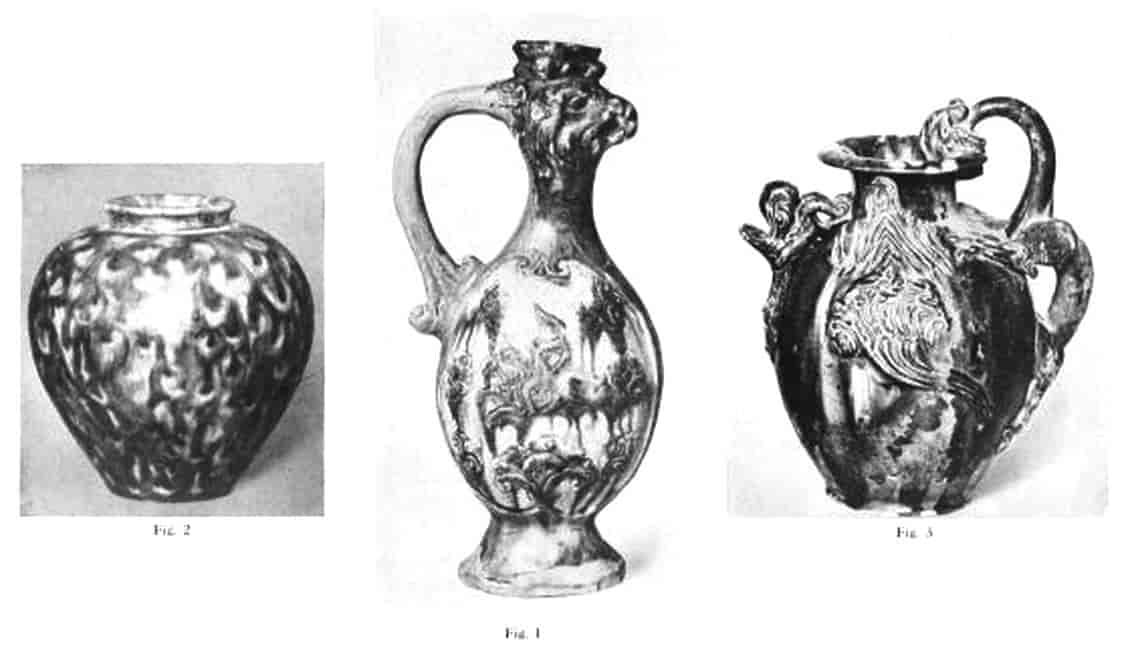
Plate 9.—T'ang Pottery.
Fig. 1.—Ewer of Sassanian form with splashed glazes; panels of relief ornament, in one a mounted archer. Height 13 inches. Alexander Collection. Fig. 2.—Vase with mottled glaze, green and orange. Height 3 58 inches. Eumorfopoulos Collection. Fig. 3.—Ewer with dragon spout and handle; wave and cloud reliefs; brownish yellow glaze streaked with green. Height 11 58 inches. Eumorfopoulos Collection.
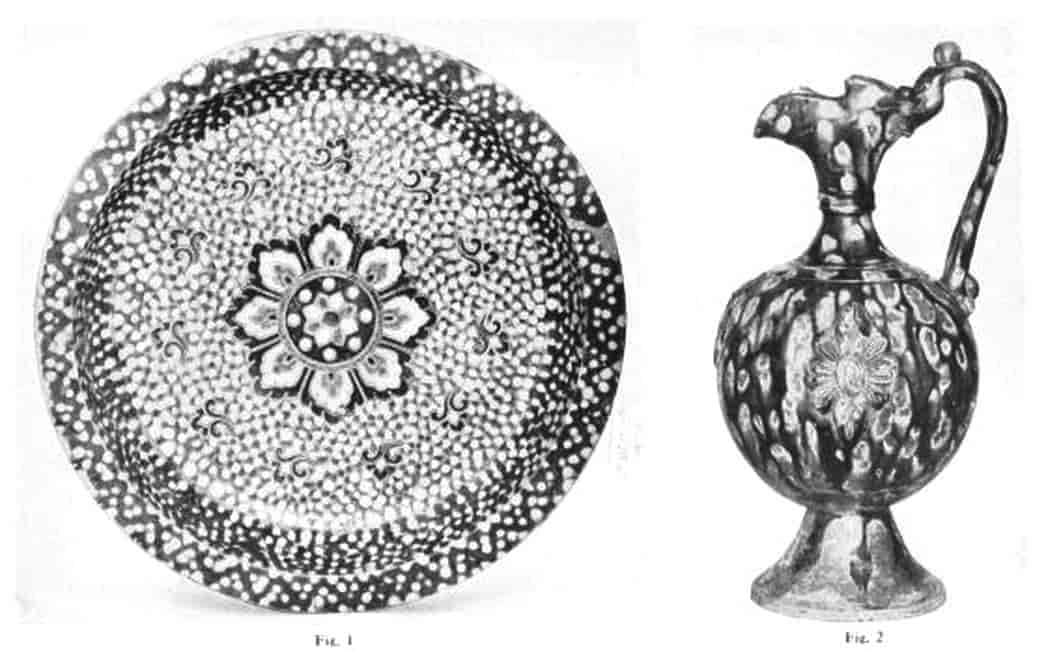
Plate 10.—T'ang Pottery. Eumorfopoulos Collection.
Fig. 1.—Dish with mirror pattern incised and coloured blue, green, etc.; inner border of ju–i cloud scrolls on a mottled yellow ground, outer border of mottled green; pale green glaze underneath and three tusk–shaped feet. Diameter 15 inches. Fig. 2.—Ewer with serpent handle and trilobed mouth; applied rosette ornaments and mottled glaze, green, yellow and white. Height 10 58 inches.
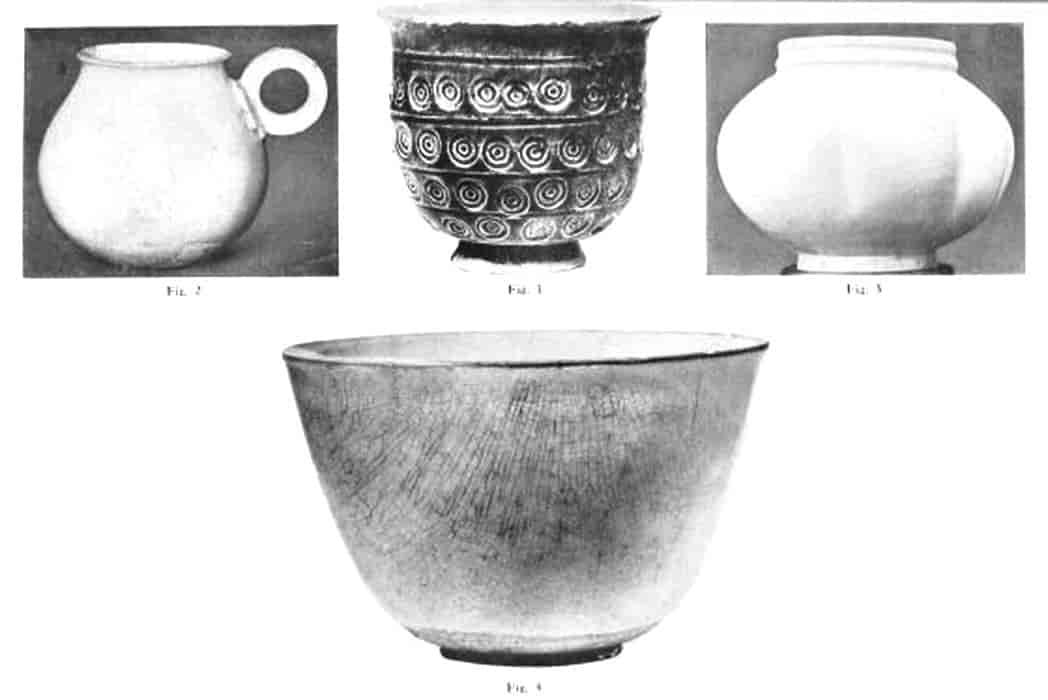
Plate 11.—T´ang Wares.
Fig. 1.—Cup with bands of impressed circles, brownish yellow glaze outside, green within. Height 2 58 inches. Seligmann Collection. Fig. 2.—Cup of hard white ware with greenish white glaze. Height 2 38 inches. Eumorfopoulos Collection. Fig. 3.—Melon–shaped Vase, greyish stoneware with white slip and smooth ivory glaze. Height 4 inches. Breuer Collection. Fig. 4.—Cup of porcellanous stoneware, white slip and crackled creamy white glaze, spur marks inside. Height 3 14 inches. Breuer Collection.
The truth is, our knowledge of T´ang pottery has only just begun, and now that the ware is esteemed in Europe at its proper worth, the choicer specimens which have been treasured in China are finding their way westward. Every fresh arrival tells us something new and surprising, and it only wanted such a piece as Fig. 1, Plate 10, to establish the identity of the specimens whose T´ang origin we had before only ventured to conjecture. Here we have a form of dish which is found among the tomb wares of the T´ang period, made of the typical T´ang white–body and finished in characteristic fashion and decorated with engraved designs of the most advanced type, filled in with coloured glazes, in addition to bands of mottling in green and white, and yellow and white. There are, besides, other specimens of similar make but with simpler, though scarcely less interesting, design of a mirror–shaped panel formed of radiating lotus leaves engraved in the centre with a stork in white and green, all in a deep violet blue ground. The coloured glazes used in the T´ang polychrome pottery are light and translucent lead glazes of the kind which reappears on the Ming and Ch´ing pottery and porcelain, and, as on the later wares, they are covered with minute accidental crackle. In their splashed and mottled varieties they have, as already noted, a resemblance to the glazes of the eighteenth–century Whieldon ware of Staffordshire, and it is interesting to note that the T´ang potters also used another form of decoration which was much fancied in Staffordshire about a thousand years later. This is the marbling of the ware, not merely by mottling the glaze as in Fig. 2 of Plate 9, or by marbling the surface, but by blending dark and light clays in the body as in the "solid agate" ware of Staffordshire. It only remains to prove that painting with a brush was practised by the T´ang potters, and though one is loath to accept such a revolutionary idea without positive proof, there is very good reason to think that such pieces[53] as Fig. 3, Plate 12, belong to the T´ang period. They have a white pottery body, painted in bold floral scroll[34] designs in black under a beautiful green glaze. We are getting used to surprises in connection with T´ang pottery, and probably in a year's time painted T´ang wares, which are now only accepted with reserve, will be an established fact which passes without comment.
Stamped patterns are not uncommon, and we often find small rings or concentric circles, singly, as in Fig. 1 of Plate 11, or stamped in clusters of five or seven, forming rosettes[54]; or, again, impressed key fret, as in Fig. 1 of Plate 12, which has a deep leaf green glaze.
The influence of the Western Asiatic civilisations has been already mentioned in casual hints, but it appears in concrete form in the peculiar shape of the ewer on Plate 9. The bird–headed vessel is found in Persian pottery of an early date, one example of which may be seen in the British Museum. Another remarkable instance of this form was illustrated and discussed by Dr. Martin in the Burlington Magazine, September, 1912.[55] It had, in addition, applied relief ornaments of a kind which we have already noticed, and Dr. Martin expressed his opinion that both the form and the ornaments are nearly related to Sassanian metal work. The fact that the last Sassanid king sought help from China[56] points to intercourse between the two realms, and in any case the northern trade route through Turkestan into Western Asia gave ample opportunity for the traffic in Persian and Sassanian wares. But more remarkable still is the classical spirit displayed in the piping boy and dancing girl[57] on a wonderful flask in the Eumorfopoulos Collection (Plate 18, Fig. 2). The Græeco–Buddhist influence on early Chinese sculpture has already been remarked, and several classical designs are commonly pointed out on the T´ang metal mirrors; but here we have in pottery a figure which might have been taken from a Herculaneum fresco, surrounded by scroll–work worthy of the finest T´ang mirror. The body of the ware[35] is whitish pottery, and the beautifully moulded surface is covered with a brownish green glaze, which, like that of Fig. 1, Plate 12, is clearly a survival of the Han glaze. Other instances might be quoted of Græco–Roman influences reflected in T´ang wares. There are obvious traces of the "egg and tongue" and "honeysuckle" patterns in border designs, and the shapes of vases and ewers often betray a feeling which is more Greek than Chinese.
Reverting to the engraved T´ang ornament, there is a little oblong box in the Kunstgewerbe Museum at Berlin with incised rosettes of prunus blossom form, glazed white and yellow in a green ground and finished almost with the neatness of Ch´ien Lung porcelain, but of undoubtedly T´ang origin. The same prunus design occurs on a typical T´ang bowl, in the Eumorfopoulos Collection, stencilled white in a green ground. I have postponed reference to these pieces because of the bearing of the latter on the decoration of the wonderful figure illustrated in the frontispiece, which will make a fitting climax to our series of T´ang specimens.
This figure, with its stand, measures 50 inches in height, and represents one of sixteen Lohan or Arhats, the Buddhist apostles. Its provenance has been kept discreetly concealed,[58] but we may[36] infer that it was taken from a temple or mausoleum, and we know that there were others with it, two of which were exhibited at the Musée Cernuschi, in Paris, in June, 1913. This one, however, has the advantage over the others of being complete with its pottery stand. The ware is white and comparatively hard; the colourless glaze on the fleshy parts has acquired a brown stain from the dripping of the cave moisture, and developed a minute crackle, both of which features are observable on some of the glazed vases from T'ang tombs; the pupils of the eyes are black. The draperies, of which the flowing folds are worthy of the finest classic sculpture, are glazed with mottled green, the upper robe with brownish yellow, both of T'ang type, and the latter is patched (in true Buddhist fashion) with green–edged bands with white designs resembling divided prunus blossoms in a yellow ground, in style recalling the decoration of the bowl previously mentioned. The technique, then, is that of the T'ang wares, but instead of being made in a mould like the grave statuettes, this monumental figure is modelled in the round by an artist worthy to rank with the masters of sculpture and painting who made the T'ang period famous.
When one looks at the powerful modelling of the head, the strong features composed in deep contemplation, and the restful pose of the seated form, one realises that here, at last, we have the great art which inspired the early Buddhist sculptors of Japan. It is no conventional deity which sits before us. The features are so human as to suggest an actual portrait, but for the supernatural enlargement of the ears in Buddhist fashion. The contracted brows bespeak deep concentration; the eyes, dreamy yet awake, look through and past us into the infinite; the nostrils are dilated in deep breathing; the lips compressed in firm yet compassionate lines. It is the embodiment of the Buddhist idea of abstraction and aloofness; yet it lives in every line, the personification of mental energy in repose. But so rare are examples of this style, that, unless we turn to painted pictures or frescoes such as have been brought back by the recent expeditions in Turfan, we must look in the temples of Japan, not, indeed, for similar Chinese work, but for the Japanese masterpieces in bronze, wood and lacquer, of the same period, which avowedly followed the Chinese art. The Yuima in the Hokkeji nunnery, ascribed to the middle of the eighth century; the portrait figure of the priest Ryoben (✝ 773) in the Todaiji monastery, and the portrait figure of Chisho Daishi (✝ 891) in the[37] Onjoji monastery,[59] are all conceived in the same grand style, and bespeak a kindred art.
But high as this figure ranks as sculpture, it is far more remarkable as pottery. To fire such a mass of material without subsidence or cracking would tax the capabilities of the best equipped modern pottery, while the skill displayed in the modelling is probably unequalled in any known example of ceramic sculpture. The contemporary grave figures hold a high place in ceramic modelling, but this statue is as far above the best of them as Dwight's stoneware bust of Prince Rupert towers above the Staffordshire figurines. Dwight's masterpiece has long been an object of wonder and admiration in the ceramic ante–room in the British Museum, and, with the help of the National Art Collections Fund and of several munificent individuals, the British Museum has been able to acquire this wonderful Chinese figure, which is now exhibited in the King Edward VII. galleries.
It is too early yet to attempt seriously the classification of the T´ang wares under their respective factories. Before this is possible the meagre allusions in Chinese literature must be supplemented by far fuller information. At present our knowledge of the T´ang factories is chiefly drawn from casual references in Chinese poetry and in the Chinese Classic on Tea, the Ch´a Ching, written by Lu Yü in the middle of the eighth century. From this we gather that the Yüeh Chou[60] kilns enjoyed a high reputation. An early allusion to this factory in reference to the "bowls of Eastern Ou" in the Chin dynasty has already been recorded.[61] The author of the Tea Classic tells us that among tea–drinkers the Yüeh bowls were considered the best, though there were some who ranked those of Hsing Chou[62] above them. Lu Yü, however, thought the judgment of the latter connoisseurs was wrong, because the Hsing Chou bowls resembled silver while the Yüeh bowls were like jade, because the Hsing bowls were like snow, the Yüeh like ice, and because the Hsing ware, being white, made the tea appear red, while the Yüeh ware, being green (ch´ing), imparted a green (lü) tint to the tea. The T´ang poet, Lu Kuei–mêng, further tells us that the Yüeh bowls "despoiled the thousand peaks of their blue green[63][38] colour." Yüeh Chou is the modern Shao–hsing Fu in the province of Chêkiang. It was celebrated in the tenth century for a special ware made exclusively for the princes of Wu and Yüeh, of the Ch´ien family, who reigned at Hung Chou from 907 to 976. This was the pi sê or "secret colour" ware which was made at Yüeh Chou until the Southern Sung period (1127–1279), when the manufacture was removed to Yü–yao.[64] The pi sê[65] ware has caused endless mystification among writers on Chinese porcelain. The name—which means literally "secret colour"—has been taken by some to imply that the colour was produced by a secret process (the most natural but not the generally accepted meaning), and by others that it was a forbidden colour, i.e. only permitted to be used by the princely patrons of the house of Ch´ien.[66] The author of the Ching–tê Chen t´ao lu[67] states that "it resembled the Yüeh ware in form, but surpassed it in purity and brilliance." This is, however, only the opinion of a nineteenth–century writer who does not claim to have seen a specimen of either. A tenth–century writer[68] makes use of the vague expression, "the secret colour preserves the note of the green (ch´ing) ware (tz´ŭ)," which apparently means that the secret–colour glaze did not rob the ware of the musical quality of usual ch´ing ware, implying a difference of some kind between the pi sê and the ch´ing glaze.
Literary references of this kind are open to so many inferences that their value is slight without some tangible specimen to help us to realise their import. This difficulty is greatly increased in dealing with Chinese descriptions because of the ambiguity of Chinese colour words, which is discussed elsewhere. But in the case of Yüeh Chou ware, or at any rate of one kind of it, we have[39] an important clue in another Chinese work. Hsü Ching, who accompanied the Chinese Ambassador to Corea in 1125, in a description of the Corean wares, makes the remark that "the rest of them have a general likeness to the old pi sê ware of Yüeh Chou and the new Ju Chou ware."[69] Fortunately, we can speak with considerable confidence of the Corean wares of this time, many examples of which have been taken from the tombs of the period. The British Museum has a fair number of examples, quite enough to show the typical Corean glaze, a soft grey green celadon of decidedly bluish tint, a thick smooth glaze often of great delicacy and beauty of tone.
In view of this the colour of the Yüeh bowls, the blue–green of the hills, is easily visualised. But China boasts so many makes of celadon[70] that he would be a bold man who would single out any one piece and say this is Yüeh ware. Among the numerous specimens of celadon which have reached Europe from various sources it is far from improbable that some were baked in the Yüeh kilns, but at present, alas, we are impotent to identify them.
The author of the Ching–tê Chên t´ao lu[71] places the Hsing Chou factory at the modern Hsing–t´ai Hsien, a dependency of Shun–tê Fu, in Chihli. Little else is recorded about the white Hsing ware beyond a general statement in the annals of the T´ang dynasty[72] that the "white ware (tz´ŭ) cups of Nei Ch´iu were used by rich and poor throughout the empire." Nei Ch´iu, it should be explained, is identified as a township in the Hsing Chou. We may add that the ware of both Yüeh Chou and Hsing Chou was used for "musical cups" by Kuo Tao–yüan.[73] One of the criteria which the Chinese recognise in distinguishing ordinary pottery from the finer wares of a porcellanous nature is the note emitted by the ware when smartly tapped with the finger, and we may fairly infer that any bowls which were suitable for use as musical chimes would be of a sonorous, hard fired material if not actually porcelain.
The Ch´a Ching enumerates five other T´ang factories which supplied tea bowls, all of them inferior in reputation to the Yüeh Chou kilns. Ting Chou  in the Hsi–an Fu,[74] in Shensi; Wu Chou
in the Hsi–an Fu,[74] in Shensi; Wu Chou  in the Chin–hua Fu, in Chêkiang; Yo Chou
in the Chin–hua Fu, in Chêkiang; Yo Chou  in Hunan; Shou Chou
in Hunan; Shou Chou  in Kiangnan; and Hung Chou
in Kiangnan; and Hung Chou  , the modern Nan–ch´ang Fu, in Kiangsi, the district in which is Ching–tê Chên, afterwards the ceramic metropolis of China. Of these wares we have only the meagre information that the Yo Chou ware was of green (ch´ing) colour; the Shou Chou ware, yellow; and that the Hung Chou ware was a brownish colour,[75] and made the tea appear black. The Hung Chou factory is also named in the Ko ku yao lun,[76] which tells us that "vessels made at Hung Chou in Kiangsi are yellowish black in colour." A sixth factory, apparently of some reputation though not mentioned in the Ch´a Ching, is named in a poem by Tu Fu, president of the Board of Works,[77] in the T´ang dynasty, who says: "The ware (tz´ŭ) baked at Ta–yi is light but strong. It gives out, when struck, a sound like the plaintive note of the Chin–ch´êng jade. The white bowls of your Excellency surpass the frost and snow. In pity hasten to send one to the pavilion of my studies." Ta–yi was in the department of Ch´iung Chou, in Szechuan.
, the modern Nan–ch´ang Fu, in Kiangsi, the district in which is Ching–tê Chên, afterwards the ceramic metropolis of China. Of these wares we have only the meagre information that the Yo Chou ware was of green (ch´ing) colour; the Shou Chou ware, yellow; and that the Hung Chou ware was a brownish colour,[75] and made the tea appear black. The Hung Chou factory is also named in the Ko ku yao lun,[76] which tells us that "vessels made at Hung Chou in Kiangsi are yellowish black in colour." A sixth factory, apparently of some reputation though not mentioned in the Ch´a Ching, is named in a poem by Tu Fu, president of the Board of Works,[77] in the T´ang dynasty, who says: "The ware (tz´ŭ) baked at Ta–yi is light but strong. It gives out, when struck, a sound like the plaintive note of the Chin–ch´êng jade. The white bowls of your Excellency surpass the frost and snow. In pity hasten to send one to the pavilion of my studies." Ta–yi was in the department of Ch´iung Chou, in Szechuan.
The five brief dynasties which fill the interval between the T´ang and Sung periods are only known to ceramic history for two wares, the identity of which remains a matter of conjecture. The first is the pi sê ware of Yüeh Chou, which has already been discussed; and the second is the celebrated but intangible Ch´ai ware. Chinese writers wax poetical over the Ch´ai ware. "Men of old," says a late Ming writer,[78] "described Ch´ai ware as blue like the sky, brilliant like a mirror, thin like paper, and resonant like a musical stone." An earlier and less hyperbolical description of it given in the Ko ku yao lun[79] states that it was made at Chêng Chou, in Honan, and named ch´ai by Shin Tsung (of the Posterior Chou dynasty, who reigned for five years from 954 to 959); that its colour was sky blue; that it was "rich, refined, and unctuous," and had fine crackle–lines; that in many cases there was coarse yellow clay on the foot of the wares; and that it was rarely seen in the writer's time. Elsewhere[80] we read that, according to tradition, Shih Tsung, on being asked what kind of ware he would require for palace use, commanded that its colour for the future should be "the blue of the sky after rain as seen in the rifts of the clouds."[81] As early as the sixteenth century the Ch´ai ware had virtually ceased to exist, and a writer[82] of that time tells us "Ch´ai ware is no longer to be found. I once saw a fragment of a broken piece mounted in a girdle–buckle. Its colour was brilliant, and answered to the usual description of the ware, but the ware itself was thick." A century afterwards the ware was nothing more than a tradition, and later it developed a legendary character. Fragments of it were said to dazzle the eyes, and when worn on armour to turn aside missiles in battle.[83]
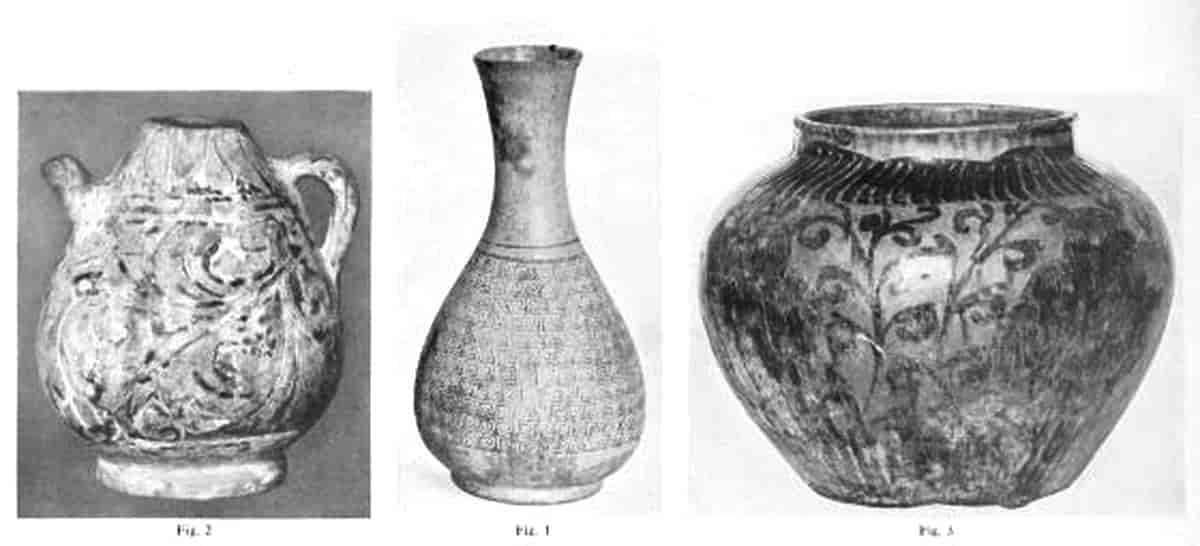
Plate 12.—T´ang Pottery with green glaze.
Fig. 1.—Bottle with impressed key–fret. Height 7 12 inches. Eumorfopoulos Collection. Fig. 2.—Ewer with incised foliage scrolls. Height 4 14 inches. Alexander Collection. Fig. 3.—Vase with foliage scrolls, painted in black under the glaze, incised border on the shoulder. Height 4 14 inches. Eumorfopoulos Collection.
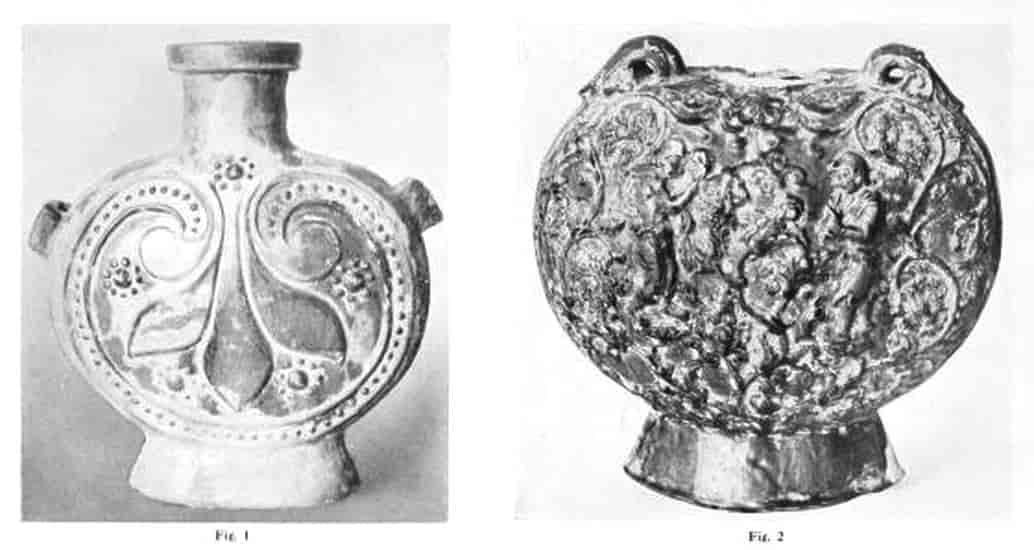
Plate 13.—T´ang Pottery.
Fig. 1.—Pilgrim Bottle with lily palmette and raised rosettes, green glaze. Height 7 12 inches. Koechlin Collection. Fig. 2.—Pilgrim Bottle (neck wanting), Hellenistic figures of piping boy and dancing girl in relief among floral scrolls, brownish green glaze. Height 8 12 inches. Eumorfopoulos Collection.
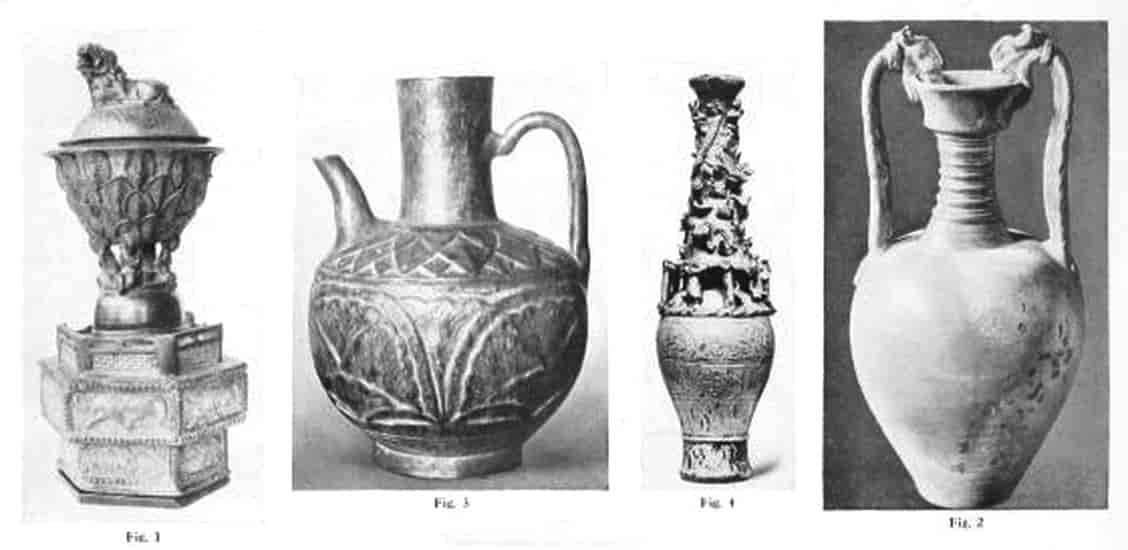
Plate 14.—T´ang Wares.
Fig. 1.—Incense Vase, lotus–shaped, with lion on the cover, hexagonal stand with moulded ornament; green, yellow and brown glazes. Height 19 34 inches. Rothenstein Collection. Fig. 2.—Sepulchral Amphora, hard white ware with greenish white glaze, serpent handles. Height 19 14 inches. Schneider Collection. Fig. 3.—Ewer with large foliage and lotus border in carved relief, green glaze. Height 6 12 inches. Koechlin Collection. Fig. 4.—Sepulchral Vase, grey stoneware with opaque greenish grey glaze. Incised scrolls on the body, applied reliefs of dragons, figures, etc., on neck and shoulder. (?) T´ang. Height 20 inches. Benson Collection.
Chinese writers have been troubled by the apparent inconsistency of the descriptions, "thin as paper" and "having coarse yellow clay on the foot." The latter may, however, merely refer to patches of coarse clay or sand which had served to support the ware in the kiln, and which had partially adhered to the base, a thing not uncommon in the earlier manufactures. The expression has, however, led some later writers[84] to identify the Ch´ai ware with a fairly well–known type of comparatively soft buff pottery, coated with a luscious turquoise or pale lavender blue glaze, which[42] we shall have occasion to discuss later.[85] Needless to say, there is no probability of this type being the real Ch´ai. Its comparative commonness alone puts the supposition out of court, but the suggestion serves to show that some Chinese thinkers, at any rate, see the Ch´ai colour in just such glazes as the pale lavender blue of Plate 88, Fig. 2, which undoubtedly satisfies in many respects the description "blue of the sky after rain."
On the other hand, the celebrated Ju Chou ware of the Sung dynasty, which aspired to equal the Ch´ai in colour, was evidently of the grey green celadon type, with perhaps a tinge of blue like the early Corean wares.[86] We have, then, two theories on the nature of the Ch´ai glaze: (1) that it was an opalescent, turquoise glaze, such as is seen on the Chün type of wares; and (2) that it belonged to the smooth grey green celadon class, with the bluish tint strongly developed. There may be other theories[87] besides, but it matters little, as no authentic specimen is known to exist. In fact, the discussion under the circumstances would have but little interest were it not for its bearing on some of the Sung wares, which will be discussed in the next chapter.
CHAPTER IV
THE SUNG  DYNASTY, 960–1279 A. D.
DYNASTY, 960–1279 A. D.
WITH the Sung dynasty firmly established in 960 A. D., the Chinese Empire entered upon a long period of prosperity rendered glorious by the cultivation of the arts of peace. It is true that the boundaries of the Empire were contracted and the Tartar tribes on the north–west had made good their independence and remained a constant menace to the frontiers of China. In 1127 the dam was broken and the desert warriors, no longer to be kept in check by diplomacy or force, burst upon Northern China and drove the peace–loving Sung from their capital, the modern K´ai–fêng Fu in Honan. The Emperor Kao Tsung and his Court fled across the Yangtze to their new capital at Hang Chou, where the dynasty continued under the name of the Southern Sung until 1279. The description given by Marco Polo of Hang Chou, which he considered, even in 1280, to be "beyond dispute the finest and the noblest city in the world," presents a wonderful picture of the refinement and luxury of the Sung civilisation. The great city had its network of canals and its twelve thousand stone bridges, its flourishing guilds of craftsmen, its merchant princes who lived "nicely and delicately as kings," its three hundred public baths of hot water, its ten principal markets, its great lake lined with houseboats and barges, and its streets thronged with carriages. The citizens themselves were peaceful and orderly, neither wearing arms nor keeping them in their homes, and their cordiality to foreigners was hardly less than the good will and friendliness which marked their relations to one another.
The conditions which produced such a community as this were ideal for the development of literature and art, and the Sung dynasty has been described as a prolonged Augustan age for poets, painters, and art workers of every persuasion. It was, moreover, an age of[44] connoisseurs and collectors. Treatises were written on artistic subjects, encyclopædias were published, and illustrated catalogues issued by the order of the Emperor and his followers. Among the best known of these last publications are the Hsüan Ho po ku t´u lu, "Illustrated discussion of the antiquities in the palace of Hsüan Ho," and the Ku yü t´u p´u, "Illustrated description of ancient jade." It is true that modern criticism has seriously impugned the archæological value of both these classic works. It is said that ingenious conjectures and reconstructions, based on the reading of earlier literature, too often take the place of practical archæology and first–hand knowledge of the art of the Shang and Chou dynasties. Sung archæology, in fact, appears to have been in much the same theoretical condition as the Homeric criticism in Europe before the days of Schliemann. But for us these works must always have great interest, if only for the records they preserve of T´ang and Sung ideas. An excellent, if extreme, instance of the inherent weakness of Sung archæology is given by Laufer.[88] In describing certain objects of the Chou dynasty early writers had been in the habit of speaking of "grain pattern" and "rush pattern," assuming a knowledge in their readers which subsequent ages did not possess. In the Sung period the current ideas with regard to these patterns were expressed by the illustrator of the Sung edition of the Li Chi by ornamenting jade discs, in the one case with ears of wheat and in the other with a clump of rushes. Modern archæologists have identified the patterns in question on objects found in Chou burials, the grain pattern being symbolically rendered by a number of small raised discs, representing either grains of corn or heaps of grain, and the rush pattern by a kind of matting diaper, geometrically drawn. This instance serves to illustrate the salient differences between the Chou and Sung art, the two extremes; the Chou art is symbolical and geometrical, the Sung impressionist and naturalistic. The Sung poets and painters[89] communed with Nature in the wilds and threw into their verse or on to their silks vivid impressions and ideal conceptions of the natural phenomena. The Chinese art of after years owes many of its noblest inspirations to Sung masters, but nowhere are these ideas developed with the same freshness and power as in the Sung originals.
The Sung dynasty was an age of achievement for the potter. [45] The ceramic art now took rank beside that of the bronze worker and jade carver, and it received a great impetus from regular Imperial patronage. The Ting Chou and Ju Chou factories in the north worked under Imperial mandate. In the south the pottery centre in the Ch´ang–nan district received a new name from the nien hao of the Emperor Ching Tê (1004–1007), and developed into the world–famed Ching–tê Chên. In the succeeding century the Imperial factories at Hang Chou were celebrated for the Kuan yao or royal ware; and numerous kilns were opened in the eighteen provinces, successfully following the lead of the Imperial potteries.
Subsequent ages have never ceased to venerate the Sung as the classic period of Chinese ceramic art, and in the eighteenth century the Emperor Yung Cheng sent down selected Sung specimens from the palace collection to be imitated by the Imperial potters at Ching–tê Chên. The same sentiment pervades Chinese ceramic literature. It harks back perpetually to the Sung wares as the ideal, collectors rave about them, and eulogy of the Ju, Kuan, Ko, Ting, and Lung–ch´üan wares has been almost an obsession with later Chinese writers.
Until recent years the European student has been almost entirely dependent for his knowledge of the subject on these literary appreciations or on relatively modern reproductions of the wares. Latterly, however, the interest aroused among Western collectors in the earlier wares and their consequently enhanced value have lured many authentic specimens from China, and our information on the Sung potteries has considerably expanded. But the difficulties of classification are still only in part surmounted. Many important problems remain unsolved, and for the understanding of several celebrated groups we are still at the mercy of Chinese textbooks and encyclopædias. Obscurity of phrase, ambiguity of colour words, quotations from early authorities passed on from writer to writer with diminishing accuracy, are among the many stumbling–blocks which the student of these books must surmount at every turn. Many of the treatises occur in small encyclopædias and miscellanies on works of art, which are each merely a corpus of quotations from similar works of the past. Moreover, an accurate first–hand knowledge of the wares themselves does not seem to have been held essential for the Chinese compiler. It is true that the same might be said of many of our own art–manuals, and with less excuse, for the Chinese can at any rate plead the veneration[46] for the writers of the past in an ancestor–worshipping people, whereas our own shortcomings in this matter are due mainly to commercial reasons. But if the Chinese manuals are often misleading and obscure, they are at least brief—too brief, in many cases, and assuming a power to read between the lines which no European student can be expected to possess. The result is that where we have no actual specimens to help us, there is unlimited scope for conflicting theories on the meaning of the original text. However, as our collections grow and guiding specimens arrive, more of the Chinese descriptions are explained, and working back from the known to the unknown we are able to penetrate farther into the obscurities of the subject.
To take a single instance. The well–known celadon ware, with strongly built greyish white body, and beautiful smooth, translucent sea–green glaze, has been identified beyond all doubt with the Lung–ch´üan ware of Chinese books. When we read of the green porcelain (ch´ing tz´ŭ) bowls with fishes in relief inside or on the bottom, our thoughts at once turn with confidence to such specimens as Fig. 3, Plate 21, and we realise that for once we are certain of the meaning of the elusive colour word ch´ing. In the same way other phrases here and there can be run to earth; and when we meet the same descriptive words in other contexts, the key to their meaning is already in our hands. In this way no little profit can even now be got from the study of Chinese works, and it tends to increase steadily, though, of course, one living example is more instructive than a host of descriptions.
The Sung wares are true children of the potter's craft, made as they are by the simplest processes, and in the main decorated only by genuine potter methods. The adventitious aid of the painter's brush was, it is true, invoked in a few cases, but even then the pigments used were almost entirely of an earthy nature, and it is very doubtful if painting in enamels had yet been thought of. Two years ago enamel–painting on Sung porcelain would have been denied in the most uncompromising terms. But the claims of certain specimens of the Tz´ŭ Chou type, with brick–red and leaf–green enamel on the glaze, to belong to the Sung period have been so persistently urged that they cannot be entirely ignored. At present I am unconvinced of their Sung origin; but our knowledge of T´ang wares has developed with such surprising rapidity that we must be prepared for similar surprises in connection with the[47] Sung. Meanwhile it would be well to suspend judgment on this interesting point.
The bulk of the Sung wares, at any rate, and among these the best of them, were either wholly undecorated—that is, wholly dependent on form and glaze, or else ornamented by such methods as moulding, stamping, application of clay reliefs, carving, or etching with a fine point. All these processes were applied while the clay was still unfixed, and the glaze was afterwards added and the ware finished once and for all in a single firing. It follows, then, that the glaze must be capable of standing the fierce heat required to bake the body, and as the Sung bodies are mostly of a high–fired porcellanous nature, the glazes used on them were limited to the refractory kinds composed largely of petuntse or porcelain stone. It follows also that any impurity, any particle of iron, for instance, in the clay would make its presence felt in the glaze and influence the colour of the latter, locally at any rate.
There is a striking contrast between the characteristic coloured glazes of the Sung and the T'ang periods. The latter are, as a rule, comparatively soft lead glazes, resembling in their colour, texture, and their minute crazing the latter glazes on Ming pottery. The former are thick and hard, and the crackle where it exists is positive and well defined.
Mr. W. Burton[90] makes some interesting comments on these high–fired glazes: "There are certain technical points of great interest to be drawn from a study of the Sung productions. In the first place, they prove that the Chinese, from a very early period, had learnt to fire their pottery at a much higher temperature than the contemporary potters of the West were using.... A third point of even greater interest, which seems to have escaped the notice of every previous writer, is that the method of firing used by the Chinese naturally produced glazes in which the oxide of iron and oxide of copper were present in the lowest state of oxidisation; and this is the explanation of the seeming paradox that the green glazes, known to us as celadon, and the copper–red glazes, were amongst the earliest productions of the Chinese porcelain–makers, while in Europe they have been among the latest secrets to be acquired."
The most important feature of the Sung wares lies in their glaze, which holds la qualité maîtresse de la céramique, as an enthusiastic[48] French writer has expressed it. Its richness, thickness, lustre, translucency, and its colour and crackle are the main criteria of the wares in the eyes of Chinese connoisseurs. Tzŭ jun (rich and unctuous), hsi ni (fine and glossy), jung (lustrous), t´ung jung (lustrous throughout or transparent) are among the phrases most constantly met in their appreciations. A word, too, is usually added on colour of the body material, which in many cases would appear to have been of a red or brown tint, iron–coloured or copper–coloured. Not that it is necessary to infer that in every instance the ware was red or brown throughout. It is a matter of observation that in many of the early wares the exposed places (usually confined to the edge of the foot rim or the unglazed base) have assumed a rusty red colour in the firing, while a flake broken from the glaze elsewhere reveals a white or greyish white porcelain body within. This will often explain the seeming inconsistency of the Chinese descriptions in which the word porcelain is applied to an apparently dark–coloured material. At the same time, it is well to remember that the Chinese words which we translate as porcelain were far more comprehensive than our own term.
Our speculations on the nature of the Ch´ai ware in a previous chapter brought us face to face with two main types of glaze, the thick opalescent glaze of pale lavender or turquoise tint, and the smooth translucent celadon glaze in which green is the dominant colour. These types are prominent on the Sung wares, and almost all the varieties of coloured Sung glazes—with such obvious exceptions as black and chocolate brown—have more or less affinity to these two. So that if we place the old turquoise[91] glaze at one end of the series and the green celadon at the other, the rest will find an intermediate place, with leanings, of course, towards one or other of the extremes. One of the puzzling features in the study of the Sung wares is the interrelation of the various makes, such as the Ju, Kuan, Ko, Lung–ch´üan, Tung ch´ing and Chün, which all appear to have had points of mutual resemblance, although the descriptions of individual specimens differ over a wide range. If, however, it can be assumed that the same fundamental principles of manufacture were observed in all these factories, and that the divergences in the wares arose from local conditions, such as variety of clays, different conditions of firing and slight[49] variations in the composition of the glaze, a formula is established which will cover most of our difficulties. I am assured by no less an authority on glazes than Mr. W. Burton[92] that this assumption is perfectly justifiable, and that one and the same glaze might emerge from the kiln as a celadon green, a grey green, dove grey, lavender grey, or lavender turquoise under slightly varying conditions of firing, and according to the presence or absence of an infinitesimal proportion of iron or copper oxide in the body or glaze. Even with their empirical methods the old Chinese potters must have soon discovered the conditions which favoured certain results, but in the meantime quite a number of apparently different wares would have emerged from the same factory, and yet, in spite of local peculiarities, a general relationship might be observed in productions of different districts. So that when one Chinese writer compares the Ju ware to the Ch´ai, another the Kuan to the Ju, another the Ko to the Kuan, and another the Lung–ch´üan to the Ko, it is not necessary to assume that these porcelains were all grass–green celadons because we happen to know that that colour was the prevailing tint of the Lung–ch´üan ware. The Ch´ai and the Lung–ch´üan may have been as far apart as lavender and celadon green, and the chain of relationship linked up by the Chinese writers still hold firm.
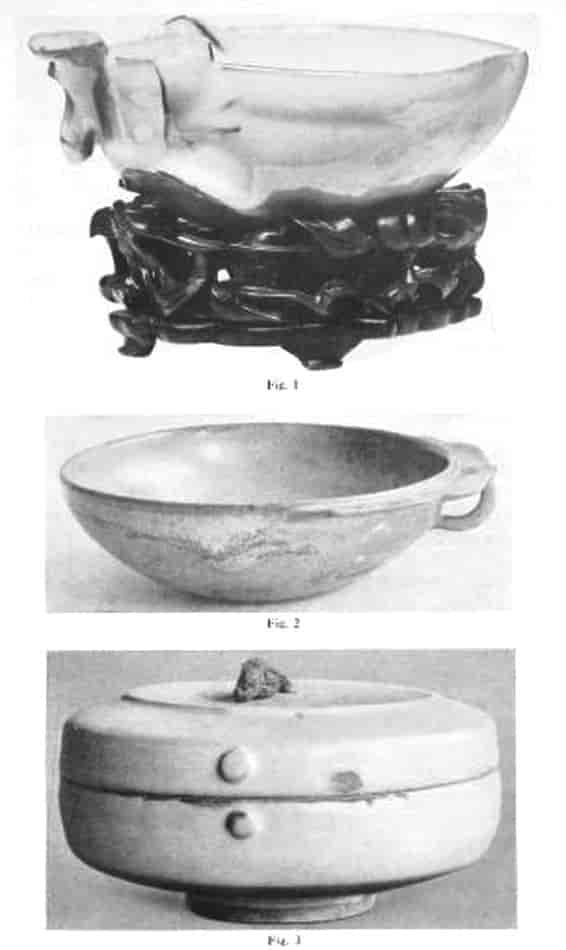
Plate 15.—Sung Wares.
Fig. 1.—Peach–shaped Water Vessel, dark–coloured biscuit, smooth greenish grey glaze. (?) Ju or Kuan ware. Length 5 14 inches. Eumorfopoulos Collection.
Figs. 2 and 3.—Shallow Cup with flanged handle, and covered box, opalescent grey glaze. Kuan or Chün wares. Length of cup 7 12 inches. Diameter of box 6 116 inches.
Rothenstein Collection.
No one but an experienced potter can speak with confidence of the methods by which the varying colour effects in the Sung glazes were obtained, but it is quite certain that the Sung potters were not ignorant of the value of such colouring agents as the oxides of iron, copper, cobalt, and perhaps even of antimony. Green, blue, yellow, and brown glazes, which owed their tint to these minerals, had appeared some centuries before on the T´ang wares. But to what extent the men of Sung made deliberate use of these oxides is another question. It is certain, for instance, that the green celadon owed its colour to the presence of iron oxide, but whether that was a natural element in the clay of certain districts, or whether it was introduced in the glaze by the admixture of ferruginous clay, is not always clear. Again, those bursts of contrasting colour, usually red, which enrich the opalescent grey and lavender glazes, are most readily explained by the local presence[50] of copper or iron oxide in an appreciable quantity. No doubt these effects were at first accidental, but it is certain that observation and experiment eventually taught the potters to produce them systematically. Otherwise, how explain the appearance of these colours in symmetrical splashes? The flambé glazes of the eighteenth century are known to have been produced by means of copper oxide, and it is not unreasonable to infer its presence in similar effects at an early date. But it is equally certain that many of the changing tints in the thick, uneven, bubbly glazes of the Sung and Yüan wares are due to opalescence alone. This has been proved to demonstration by Mr. Burton, who has produced from his kilns a porcelain glaze with passages of pale lavender, and even flushes of warm red, by using nothing but a thick, opalescent glaze entirely innocent of any colouring oxide.
Finally, a word of explanation is needed with regard to the frequent references to thinly potted specimens among the principal Sung wares. Almost all of the existing examples are of a thick and rather heavy type. Not that we would have them thinner, for much of their charm is due to the massive opulence of the thick opalescent glaze with its prismatic depths and changing hues. But the Chinese writers constantly refer to a thinner ware as well as the thick. Where are these thin and elegant pieces? The suggestion that, being more fragile, they have by now all perished has been coldly received as an obvious and easy answer to a difficult question. But it is reasonable enough, after all, when one remembers that upwards of a thousand years have passed since their manufacture. The alternative that they existed only in the poetical imagination of later Chinese writers is far less probable, though doubtless account must be taken of the exaggerations indulged in by men who were describing the ideal wares of a classic period. "Thin as paper," for instance, must have been a poetic licence as applied to the Ch´ai ware. I shall not cite the illustrations in the Album of Hsiang Yüan–p´ien[93] as proof of the fineness and trim regularity of the best Sung specimens. Whatever the value of this manuscript may originally have been, no reliance can be placed on the illustrations as reproduced in Porcelain of Different Dynasties.[94] The original was unfortunately destroyed by [51] fire in 1888, and what we have now is, at best, the reproduction of a copy, and probably that of a copy of a copy. It is quite possible that the thinner Sung wares are still represented in Chinese collections, rare though they must of necessity be. But I believe that even our own collections are capable of supplying proof that, making reasonable allowance for verbal exaggeration, the Sung potters did make wares which could fairly be described as thin. Many of the white Ting wares are thin enough to be translucent; no one questions the correctness of the description as applied to them. It only wants one specimen to prove the case for the celadon glazes, and that may be seen in the beautiful bowl in Mr. Alexander's loan collection at the Victoria and Albert Museum (Plate 16). As for the Ju and Kuan ware, it is useless to consider their case until we are quite satisfied that we have established their identity; and in the nature of things the opalescent glazes and those described as "thick as massed lard" by the Chinese can only have accompanied a relatively thin body. On the other hand, many of the Corean celadons are of unimpeachable thinness, and as they were contemporary with the Sung porcelains and were almost certainly copied from them, there seems no real ground to withhold belief entirely from the Chinese statements with regard to the thinness of certain coloured Sung wares.
CHAPTER V
JU, KUAN, AND KO WARES
Ju yao 
THOUGH no authenticated example of Ju ware is known in Europe, it is impossible to ignore a factory whose productions were unanimously acclaimed by Chinese writers as the cream of the Sung wares. Its place of origin, Ju Chou, in the province of Honan, lies in the very district which was celebrated in a previous reign for the Ch´ai pottery, and it is probable that the Ju factories continued the traditions of this mysterious ware. Nothing, however, is known of them until they received the Imperial command to supply a ch´ing (blue or green) porcelain to take the place of the white Ting Chou porcelain which had fallen into temporary disfavour on account of certain blemishes. This event, which took place towards the end of the Northern Sung period (960–1127 A. D.), implies that whatever had been their past history, the Ju Chou factories were at this period pre–eminent for the beauty of their ch´ing porcelain. It would appear from the Ch´ing po tsa chih,[95] which was written in 1193, that the Ju Chou potters were set to work in the "forbidden precincts of the Palace," and that selected pieces only were offered for Imperial use, the rejected specimens being offered for sale. Even at the end of the twelfth century we are assured that it was very difficult to obtain examples of the ware.
From the various accounts on which we have to depend for our conception of the ware, it is clear that the body was of a dark colour.[96] The glaze was thick and of a colour variously described as "approaching the blue of the sky after rain" (i.e. like the Ch´ai [53] ware), pale blue or green,[97] and "egg white"[98] which seems to imply a white ware with a faint greenish tinge. The author of the Ch'ing pi tsang,[99] a work of considerable repute published in 1595, gives a first–hand description of the ware: "Ju yao I have seen. Its colour is 'egg white' and its glaze is lustrous and thick like massed lard. In the glaze appear faint 'palm eye' markings like crabs' claws.[100] Specimens with sesamum designs (lit. flowers), finely and minutely engraved on the bottom, are genuine. As compared with Kuan yao in material and make, it is more rich and unctuous (tzŭ jun)." Two mysterious peculiarities have been attributed to the Ju ware, viz. that powdered cornaline was mixed with the glaze, and that a row of nail heads was sometimes found under the base. The first has been taken as merely an imaginative explanation of the lustre of the glaze, but it is certain that some kind of pulverised quartz–like stone was used in the composition of later glazes, such as the "ruby red" (see vol. ii., p. 123). The second, which has been seriously interpreted to mean that actual metal nails were found protruding from the glaze (a physical impossibility, as the metal would inevitably have melted in the kiln), is probably due to a misunderstanding of a difficult Chinese phrase, chêng ting,[101] which may mean "engraved with a point" or "cut nails." The former seems to satisfy the requirements of the case, though it would be possible to render the sentence, "having sesamum flowers on the bottom and fine small nails," referring to the little projections often found on the bottom of dishes which have been supported in the kiln on pointed rests or "spurs."
In the list of porcelains made at the Imperial potteries about the year 1730[102] we read of imitations of Ju ware from specimens sent down from the Imperial collections. These imitations had in one case an uncrackled glaze on a copper–coloured body, and in the other a glaze with crackle like fish roe; and we may fairly[54] infer that the originals had the same peculiarities. A reputed specimen[103] of modern Ju glaze[104] has a pale greyish green tint, with just a suspicion of blue, and would answer fairly well to the description tan ch´ing or fên ch´ing.
But probably our safest clue to the appearance of Ju ware is to be found in the important passage already mentioned,[105] in which a Sung writer describes the Corean wares as in general appearance like the old pi–sê ware of Yüeh Chou and the new Ju Chou ware. The typical Corean wares of this time are not uncommon, and their glaze—a soft grey green or greenish grey, with a more or less obvious tinge of blue—would satisfy the Chinese phrases, tan ch´ing and fên ch´ing, and in the bluer specimens might, by a stretch of poetic phrase, even be likened to the sky after rain. The "egg white," however, must have been a somewhat paler tint if the expression can be taken in any literal sense.
From the foregoing considerations we may conclude that the Ju porcelain was a beautiful ware of celadon type, varying in tint from a very pale green to a bluish green.
Though it is nowhere definitely stated how long the Ju Chou factories retained their supremacy, it is tolerably clear from Hsü Ching's reference in 1125, or very soon after, to the "modern porcelain of Ju Chou," that they came into prominence towards the end of the Northern Sung period, perhaps in the last half of the eleventh century; and as we have no further information about them, we may perhaps infer that they sank into obscurity when the Sung emperors were driven from the North of China by the invading Tartars in 1127. In any case, the Ju ware seems to have become as extinct as the Ch´ai by the end of the Ming dynasty. Hsiang Yüan–p´ien, late in the sixteenth century, states that "Ju yao vessels are disappearing. The very few which exist are almost all dishes, cups, and the like, and many of these are damaged and imperfect."[106] A few years later another writer[107] declares that the Ch´ai and Ju porcelains had ceased to exist.
It is not to be supposed that Ju Chou had the monopoly of the particular kind of ch´ing ware in which its factories excelled. A number of other and not distant potteries were engaged in a similar manufacture, though with less conspicuous success. We read,[108] for instance, that "it was made in the districts of T´ang, Têng, and Yao on the north of the (Yellow) River, though the productions of Ju Chou were the best."
It has been already remarked that we possess no authenticated example of Ju porcelain. Doubtless there are many pieces which are tentatively assigned to Ju Chou by hopeful owners. But it must be confessed that the few which have hitherto been published as such are singularly unfortunate choices. Dr. B. Laufer, for instance, in his excellent work on jade,[109] incidentally figures two vases for divining rods of a well–known form, of which he hazards the remark "that both have presumably been made in the kilns of Ju–chou."
Dr. Laufer does not claim to have made a particular study of Chinese ceramics apart from the Han pottery, but if these pieces are Ju yao, then Ju yao, so far from having been extinct for some centuries, is a comparatively common ware. Another instance is the "funeral vase," now in the Victoria and Albert Museum, published[110] by its former owner, Dr. Bushell, as a specimen of Ju ware, mainly, I suppose, on the strength of the description, "Kuan Yin vase of Ju Yao," engraved on the stand by the Chinese collector[111] through whose hands it had previously passed. This form of certificate is always open to doubt, and had it really been a specimen of undoubted Ju yao, it is most improbable that the Chinese would have allowed it at that time to pass into foreign hands.
But a glance at the piece itself is sufficient to dispel all illusions on that point. So far from excelling other Sung wares, this piece is decidedly inferior in every detail to the most ordinary Sung specimens. It has a coarse, sandy, greyish buff body and impure greyish green tinge, such as appears on some of the early funeral wares which make no pretence to finished workmanship. The ornament consists of applied reliefs perfunctorily moulded, and[56] though its archæological interest is considerable, and, like almost all Chinese wares, it possesses a certain charm, any attempt to place it on a high artistic plane can only end in a reductio ad absurdum.
Many other examples of this ware have since arrived in Europe, and they all belong to the same type. Some, however, appear to be later than the others, having reliefs of white porcelain instead of the usual pottery. They are always described as "funeral vases" by the Chinese, and it is exceedingly probable that the description is correct. The subjects of the reliefs are always of a hieratic kind, including such figures as the dragon of the East, the tiger of the West, the tortoise of the North, and the red bird of the South, the sun disc, and a ring of indistinguishable figures, perhaps Buddhist deities. There is no reason why such a type of sepulchral vase may not have been in use for many centuries, and if the porcelain reliefs in one specimen suggest a date no earlier than the Ming dynasty, the glaze in another has strong analogies to some of the rougher T´ang wares. The majority of these vases are of coarse, rough make; others are superior in finish and of comparatively attractive form. A good example, belonging to Mr. R.H. Benson, is shown on Plate 14. It is of dense grey stoneware, with opaque greenish grey glaze, with a balustrade supported by four figures on the shoulder, and a dragon and a figure on a tiger (perhaps representing the mythical Fêng Kan), besides some small figures with indistinct attributes on the neck. The height is 20 inches.
It is, of course, possible that some of these represent the coarser makes of the T´ang, Têng, and Yao districts (see p. 55), and that the attribution of the Bushell vase by Liu Yen–t´ing may refer to a lower quality of Ju yao which included these wares, or may be even the wares made at Ju Chou before or after its period of Imperial patronage.[112]
My own conception of the Ju yao is most nearly realised by the lovely but sadly damaged bowl in the Alexander Collection lately in the Loan Court at the Victoria and Albert Museum. Its peculiar form is difficult to reproduce by photographic means, but [58] Fig. 1 of Plate 16 gives a fair idea of it. The colour is precisely that of the most beautiful bluish green Corean bowls, but the usual Corean finish and the sand marks on the base are absent, and the glaze is broken by a large, irregular crackle. Surely this cannot be far removed from the "secret colour" of the Yüeh ware and the fên ch´ing of the Ju?
PLATE 16.
Sung Wares
Fig. 1.—Bowl with six–lobed sides; thin porcellanous ware, burnt brown at the foot–rim, with bluish green celadon glaze irregularly crackled. Alexander Collection. Diameter 9 12 inches.
Fig. 2.—Tripod Incense Burner. White porcelain, burnt pale red under the feet. P Lung–ch´üan celadon ware. This kind of celadon is known as kinuta. seiji in Japan, where it is highly prized. Eumorfopoulos Collection. Height 4 18 inches.
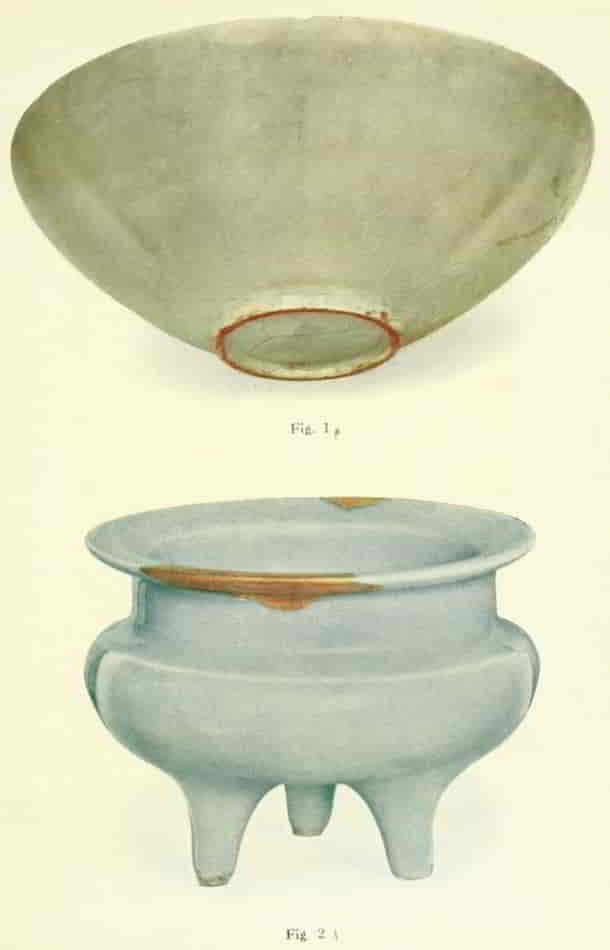
Another specimen of reputed Ju ware is an exquisite peach–shaped brush–washer or cup in the Eumorfopoulos Collection (Plate 15, Fig. 1). It has a dark–coloured body and a beautiful smooth glaze of pale greenish grey tint, and whatever its origin, it is certainly a refined and beautiful example of the potter's art.
Kuan yao 
This ware is only second in importance to the Ju yao, and its exact nature is scarcely less speculative. The name, which means "official" or "Imperial" ware, seems to have been first applied to the porcelains made for Imperial use at the Northern Sung capital, the modern K´ai–fêng Fu, in Honan. The factory was established at the command of the Emperor Hui Tsung in the Chêng Ho period (1111–1117), according to the earliest[113] or in the preceding Ta Kuan period (1107–1110), according to a later[114] account. Its career, however, was interrupted by the flight of the Sung Court south of the Yangtze in 1127, though it is probable that a number of the potters followed the Court. At any rate, the traditions of the original factory were continued at the new capital, Hang Chou, by an official named Shao Ch´êng–shang, who set up kilns in the Imperial precincts, in the department called Hsiu net ssŭ. Another writer locates this factory under the Phœnix Hill. Shortly afterwards a new pottery was started "below the suburban altar" at Hang Chou, which copied the forms of the older Kuan ware, but without equalling its quality. We have then no fewer than three different makes all included in the name of Kuan yao, all following one tradition but differing, as we shall see, in material and quality.
The first is the K´ai–fêng Fu variety. The earlier writers in[60] the Cho kêng lu and Ko ku yao lun make no attempt to differentiate[115] this porcelain from the later Kuan yao, but we find in a sixteenth–century collection of miscellanies, the Liu ch´ing jih cha, the following scrap of information: that "specimens (of the K´ai–fêng ware) with streaky colour, white on the upper part and thin as paper, were inferior to Ju ware"; and the more modern T´ao lu informs us that the K´ai–fêng Kuan ware was made of fine unctuous material with thin body, the colour of the glaze being ch´ing (blue or green) with a tinge of pale red (fên hung) and of varying depth of tone. It is further stated that in the Ta Kuan period moon white or clair de lune (yüeh pai), pale green or blue (fên ch´ing) and deep green (ta lü) glazes were esteemed, whereas in the Chêng Ho period only the ch´ing colour in varying depth of tone was used. Moreover, the glaze had "crab's claw crackle," and the vessels had a "red–brown mouth and iron foot." The latter phrase (explained below) is not consistent with the account in the Liu ch´ing jih cha, "white on the upper part," which certainly implies a light–coloured clay, but I confess that I have little confidence in the subtle distinctions of the T´ao lu in this passage. They are mere assertions, without any reasons given, and it is not difficult to find a source from which they may in part, at least, have been derived, and which in itself guarantees no such differentiation.[116] It is likely enough that the K´ai–fêng ware differed in body from the red ware of Hang Chou, but it is not likely to have differed very greatly in other respects, seeing that the southern variety continued the traditions of the northern, and that the earliest authorities do not trouble to distinguish the two wares at all.
Another critic,[117] discussing Kuan ware as a whole, makes its characteristics practically the same as those of the Ko ware, to which we shall come next, and states that "in regard to colour, in both cases the pale ch´ing (fên ch´ing) specimens are the best,[61] the 'pale white' (tan pai[118]) are second, while those with ash–coloured (hui sê) glaze are very inferior." From the same writer we gather that artificial staining of the crackle was employed on both Kuan and Ko wares, for he speaks of "ice–crackle with lines red as eel's blood" and "plum–blossom[119] crackle with ink–coloured lines," besides an inferior type of crackle with fine lines which did not suggest any particular pattern.
The Hang Chou Kuan ware, variously described as Kuan yao, Hsiu nei ssŭ yao, Nei yao, and Shao yao from the locality of the factory and the name of its manager, is described in both the Cho kêng lu and the Ko ku yao lun. In the former it was said to be a ch´ing ware, "finely levigated clay[120] is the rule, and it is of very exquisite make; the coloured glaze is translucent[121]; it is the delight of the age."[122] The latter,[123] which makes no mention of an earlier Kuan ware, gives the following description of the Nei yao: "The material is fine and unctuous, the colour ch´ing with a flush of pale red (tai fên hung) and of varying intensity. Specimens with crab's–claw crackle, brown mouth, and iron foot, and of good colour rank with Ju yao. There are, besides, specimens with a black body which are called wu ni yao. All the imitations which are made at Lung–ch´üan are without crackle."
Further information is given in the Po wu yao lan, viz. that the clay used at the factory below the Phœnix Hill at Hang Chou for making Kuan yao was of reddish brown (tzŭ) colour, and that this explains the phenomenon of the "brown mouth and iron foot"[124]; for "the brown mouth is due to the fact that the vessel's mouth[62] points upwards and the glaze flows downwards and is thinner at the mouth than on the rest of the body, so that the brown colour (of the clay) is disclosed at the mouth." The iron foot is, of course, the raw edge of the clay which appears at the foot rim. As this peculiarity is not noted in the Cho kêng lu, we are at liberty to infer that it was not a constant feature of the Kuan wares, and that some of them, as already hinted in the quotation from the Liu ch´ing jih cha, had a whitish body.
Of the third Kuan yao made "below the suburban altar" at a slightly later date, we know nothing except that it followed the style of the older wares, but with inferior results.
Though we do not pretend to attach much weight to the illustrations in Hsiang's Album, the descriptions in the accompanying text cannot be ignored. They include ten specimens of Kuan yao,[125] five of which are explained as fên ch´ing (pale blue or green). Of the rest one is "pale ch´ing clear and lustrous like a sapphire blue jewel,"[126] evidently with a decidedly blue tinge; another is "kingfisher, blue as the clear blue sky,"[127] recalling the Ch´ai "blue of the sky after rain "; another is "sky blue" (t´ien ch´ing); another "onion green" (ch´ing ts´ung), the colour of onion sprouts; and another is "egg green" (luan ch´ing), which recalls and perhaps explains the luan pai (egg white) of the Ju yao.
PLATE 17
Two examples of Sung wares of the Chün or Kuan factories.
Fig. 1.—Bowl with lavender glaze, lightly crackled. O. Raphael Collection. Height 4 12 inches.
Fig. 2.—Vase with smooth lavender grey glaze suffused with purple. Eumorfopoulos Collection. Height 3 34 inches.
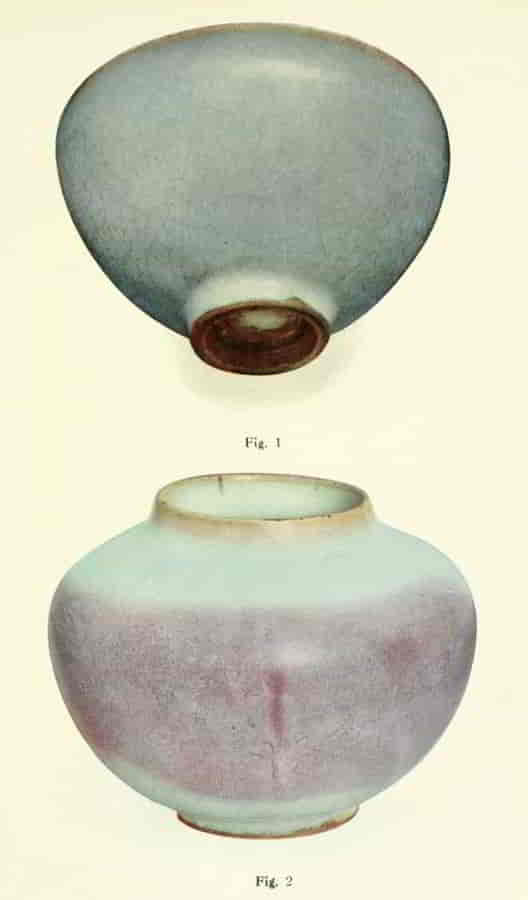
Among the various Sung and Yüan wares with more or less opalescent glazes which have reached Europe in recent years, it is possible to differentiate a considerable group whose characteristics seem to point to the Kuan yao. Their body is usually of fine grain, whitish colour and porcellanous texture, but assuming a rusty brownish tint in the exposed parts. It is, in fact, very much finer than the Yüan wares, usually so called, and all but the choicest wares of Chün type (see ch. ix.). The glaze, too, though generally opalescent, shows marked differences from that of the Chün and Yüan pieces. It is smooth and even instead of being lumpy and[65] irregular, and it ends close up to the foot rim in a comparatively regular line instead of ending short of the base in a thick roll or in heavy drops. And the base instead of being quite bare or covered with a brown glaze, has a patch of the surface glaze underneath. The colours of this glaze show wide variations from a deep brownish green, which suggest the ta lü, to pale dove grey (fên ch´ing) and pale lavender blue tints, which approximate to the Chinese t´ien ch´ing or sky blue, though perhaps not so closely as does the so–called "old turquoise." Some of these glazes, especially the pale lavender and dove greys, are broken by passages of red or crimson, which in turn shade off into green and brown tints. Although the expression tai fên hung in the Ko ku yao lun[128] has already been rendered in its most natural sense, "with a tinge of red," we should perhaps mention a possible alternative which might make it refer to these very passages of red colour; and the fact that they sometimes assume fantastic shapes will explain why the Chinese saw in them "butterflies, birds, fish, unicorns, and leopards."[129] On the other hand, it is clear that these passages of red are not always accidental, for they sometimes take symmetrical forms, and it is quite possible that even the bird and fish forms may have been roughly designed in the colouring medium.
Plate 17 will serve to illustrate this group of possible Kuan wares. Another example is a dish in the British Museum which has a whitish porcellanous body and a slightly crackled pale lavender grey glaze of singular beauty. Other specimens in the same collection include a small tea bowl with misty grey glaze of the fên ch´ing type, smooth and uncrackled, and a body which appears deep reddish brown at the foot; and a small bottle–shaped vase, with lobed body of melon shape, which, though of doubtful antiquity, answers closely to the Chinese descriptions. It has a dark–coloured but well levigated body, deep brown at the foot, and showing a brown tinge where the glaze has run thin at the lip, and the colour[66] is a pale bluish grey with rosy tinges where the body colour is able to penetrate the semi–translucent glaze. Another doubtful specimen, with very similar characteristics, was figured by me in the Burlington Magazine some years ago.[130]
Since the genuine Sung specimens were sent to the Imperial factories to be closely copied (about 1730), it might be supposed that the relatively modern imitations would supply some clue to the original types. There are one or two examples of eighteenth–century copies of Kuan ware in the British Museum on which the glaze is definitely lavender blue in tint, with a crackle which in one case is wide and emphasised by blackened lines, and in the other of a finer mesh.[131] The natural tendency, however, of modern imitative wares is to exaggerate some characteristic which this or that potter might imagine to be specially important, and as it is impossible to say in many cases exactly when the piece in question was made, we cannot be sure how far the potters in each case may have strayed from the original type.[132] No doubt in time these imitations would become a mere convention. It should be said in passing that the modern copies have a white porcelain body, and to obtain the appearance of "brown mouth and iron foot" the potters had recourse to the expedient of colouring the parts concerned with brown ferruginous clay.
The Cho kêng lu[133] refers to three minor wares which were regarded as inferior to Kuan ware, and later writers have assumed that they belonged to the same category. These are the Hsü wares, Yü–hang wares, and wu–ni wares. The first[134] is so little known that its identity has been lost in variant readings, such as Hsün  in later writers, which is very near in appearance to tung
in later writers, which is very near in appearance to tung  , a common form used for the Tung ware (see p. 82); and we can safely leave it until some clearer information is forthcoming. The second, according [67] to the T´ao lu,[135] was a Sung ware made at Yü–hang Hsien, in the prefecture of Hang Chou. "Its colour was like Kuan porcelain without its crackle, its lustre (jung), and its unctuous richness (jun)." The wu–ni ware is dark–bodied earthenware, which is discussed on p. 133.
, a common form used for the Tung ware (see p. 82); and we can safely leave it until some clearer information is forthcoming. The second, according [67] to the T´ao lu,[135] was a Sung ware made at Yü–hang Hsien, in the prefecture of Hang Chou. "Its colour was like Kuan porcelain without its crackle, its lustre (jung), and its unctuous richness (jun)." The wu–ni ware is dark–bodied earthenware, which is discussed on p. 133.
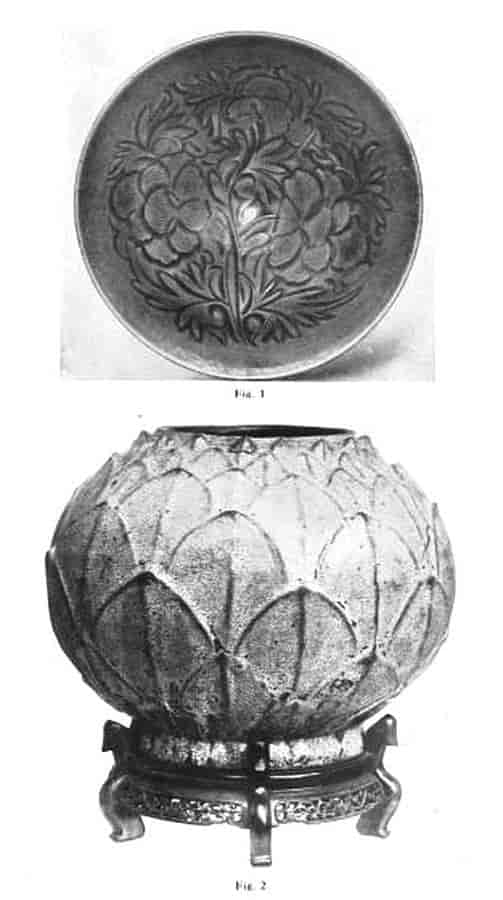
Plate 18.—Sung dynasty.
Fig. 1.—Bowl with engraved peony design under a brownish green celadon glaze. Northern Chinese. Diameter 7 34 inches. Eumorfopoulos Collection.
Fig. 2.—Vase moulded in form of a lotus flower, dark grey stoneware, burnt reddish brown, milky grey glaze, closely crackled. Height 7 inches.
Freer Collection.
Ko yao 
Ko yao (the elder brother's ware), or Ko ko yao, as it is sometimes called with the first character repeated, is unanimously ranked by Chinese writers with the Ju and Kuan wares. According to the traditional accounts, it was first made by the elder of the two brothers Chang  , who were potters of Lung–ch´üan Hsien in the Ch´u–chou Fu, province of Chekiang, each having a separate factory in the Liu–t´ien district. Most of the Chinese authorities are content to give the date of these brothers as some time in the Sung dynasty, but one account[136] narrows the period down to the Southern Sung (1127–1279 A. D.). Professor Hirth takes the rationalistic view that the story of the brothers is a myth embodying the fact that there were two distinct types of ware made in the Lung–ch´üan district. Be this as it may, the Ko yao is of considerable interest to us as forming a link between the obscure Ju and Kuan wares and the well–known Lung–ch´üan celadon, approaching the latter in its grass green and sea green varieties and the former in its most highly prized specimens of bluish green or grey tones.
, who were potters of Lung–ch´üan Hsien in the Ch´u–chou Fu, province of Chekiang, each having a separate factory in the Liu–t´ien district. Most of the Chinese authorities are content to give the date of these brothers as some time in the Sung dynasty, but one account[136] narrows the period down to the Southern Sung (1127–1279 A. D.). Professor Hirth takes the rationalistic view that the story of the brothers is a myth embodying the fact that there were two distinct types of ware made in the Lung–ch´üan district. Be this as it may, the Ko yao is of considerable interest to us as forming a link between the obscure Ju and Kuan wares and the well–known Lung–ch´üan celadon, approaching the latter in its grass green and sea green varieties and the former in its most highly prized specimens of bluish green or grey tones.
Of its close resemblance to the Kuan ware there can be no doubt, for two highly reputable Chinese writers[137] describe the two wares simultaneously and under one heading, enumerating their various colours in order of merit as fên ch´ing, tan pai, and hui sê (see p. 60), besides mentioning the several kinds of crackle which appeared in the glaze. The only distinctions which the author of the Ch´ing pi ts´ang draws between the two wares are that (1) the Kuan yao crackle is of the "crab's claw"[138] type, while that of the Ko is like fish–roe,[139] and (2) the Ko glaze is somewhat less beautiful than [68]the Kuan. With regard to the crackle, other writers assert that short cracks are characteristic of the Ko yao, and one author uses the picturesque phrase, "crackle of a hundred dangers."[140]
Accidental splashes of contrasting colour, which sometimes assumed fantastic forms, were common to the Ko and Kuan wares, as mentioned on p. 65, and the author of the Po wu yao lan explains these as "originating in the colour of the glaze and forming on its outer surface," and as "due to the fire's magic transmutation."
Another account of the ware given in the Ko ku yao lun depicts it as of deep or pale ch´ing colour, with brown mouth and iron foot, and adds that when the colour was good it was classed with Tung[141] ware. The same passage further informs us that a great quantity of the ware "recently made at the end of the Yüan dynasty" was coarse and dry in body and inferior in colour, a statement to which we shall return presently.
PLATE 19.
Vase of close–grained, dark reddish brown stoneware with thick, smooth glaze, boldly crackled. Ko ware of the Sung dynasty.
Height 10 58 inches. Eumorfopoulos Collection.
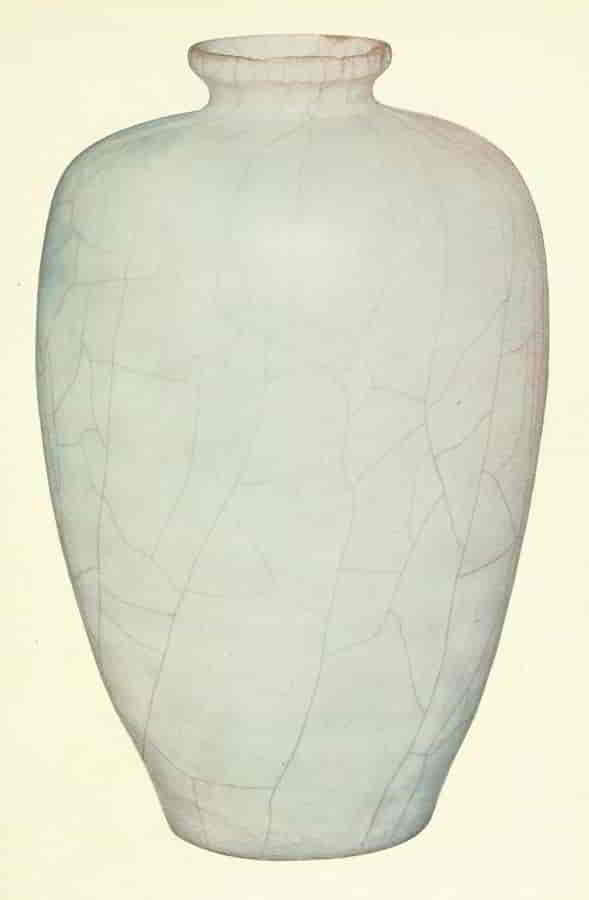
Other descriptive references to Ko yao include a verse on a Ko ink palette belonging to Ku Liu,[142] which was "green (lü) as the waves in spring"; the eighteenth–century list of Imperial wares[143] which mention "Ko glazes on an iron body," of two kinds, viz. millet–coloured and pale green[144] (or blue), both stated to have been copied from ancient specimens sent down from the palace; and a single specimen in Hsiang's Album, which is given as fên ch´ing.
In these various descriptions it is possible to recognise a celadon green ware, green as the waves of spring, while the familiar stone grey and buff crackled wares, which range from greyish white to pale grey green and greenish yellow, seem to be indicated in the expressions mi sê, fên ch´ing, tan pai, and hui sê. The modern versions of the latter class, which are fairly common, are usually known even to–day as Ko yao, the expression in potter's language being practically synonymous with "crackled wares."[145] Other ancient factories where similar wares were made are Hsiang–hu and Chi Chou.[146]
As for the finer Ko wares, which appear to have been indistinguishable from the Kuan, we may look for them in the group described on p. 65, and in such beautiful pieces as that illustrated on Plate 19, a vase of fine oval form with delicate grey glaze of faint bluish tone boldly crackled. The solid quality of the glaze of this last specimen and the texture of the surface, which is smooth but lustrous, suggest some natural substance such as the shell of an egg or a smooth polished stone rather than an artificial material. The colour perhaps more truly answers the description "egg white" (luan pai) than any other Sung glaze which I have seen. Plate 20 illustrates another choice example but with a yellower tone of glaze; and a large square vase in the Freer Collection[147] with thick, misty [72]grey glaze showing a faint tinge of red, which recall the sê ch´ing tai fên hung of the Kuan ware, was shown in the New York exhibition of 1914. All these three specimens have a dark reddish brown body of fine close grain, and their glaze is very thick and unctuous with a tendency to contract into thick wax–like drops under the base.
From certain passages in the Chinese works it appears that a revival of the Ko yao took place in the Yüan dynasty, if indeed the manufacture had not been continuous. The Ko ku yao lun, for instance, under the heading of Ko yao, states that the "ware recently made at the end of the Yüan dynasty was coarse and dry in body and inferior in colour." In the Po wu yao lan[148] we read that "certain Ko wares made in private factories took their clay from the Phœnix Hill" (at Hang Chou, where the Kuan potteries were located), and the T´ao lu[149] definitely states that clay was brought from Hang Chou for this later Ko ware. Add to these the remark in the Ko ku yao lun on the subject of Kuan ware[150]—"all the imitations which are made at Lung–ch´üan are without crackle"—and it is clear that the Lung–ch´üan potters in the fourteenth century were busy copying both the Kuan and Ko wares, and that to obtain a closer resemblance to the former they actually sent to Hang Chou for the red clay which would produce the "brown mouth and iron foot." The alleged absence of crackle would indicate a departure from the original Ko methods, but we are at liberty to doubt the universal application of such sweeping statements, and I ventured to suggest[151] that a remarkable bowl in the British Museum was a Yüan example of Ko ware, because, in spite of its Ko crackle, it corresponds so closely to the other points in the descriptions of this make. In any case, there is little doubt that it belongs to an early period of manufacture.
PLATE 20.
Deep Bowl of reddish brown stoneware with thick, boldly crackled glaze. Ko ware of the Sung dynasty.
Height (without stand) 4 inches. Eumorfopoulos Collection.
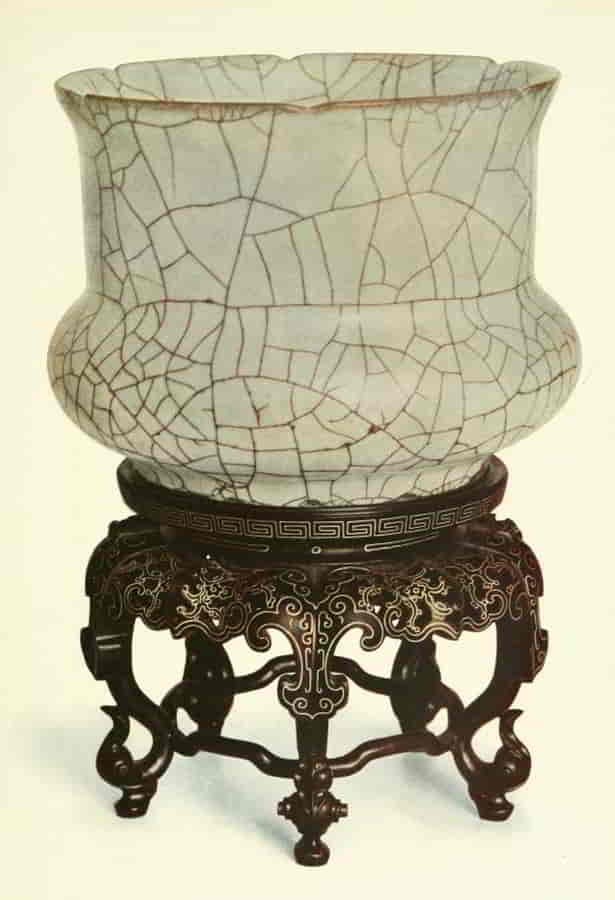
The following extract from a work entitled Pi chuang so yü,[152] which would be still more interesting if we knew its date, serves to illustrate some of the difficulties the Chinese collector had to face in the past: "Ancient examples of Ko yao of the Sung period have survived, though for a long time past genuine and counterfeit have been confused together. Among men there are very many who seek for the genuine Sung, but refined and beautiful specimens are exceedingly few.... Ts´ao Chiung, a man of high birth, secured an incense burner, in height about two inches and in width proportionate. The cover was beautiful jade carved with a pattern of sea waves of Tung ch´ing[153] colour, with a handle in form of a crane, a genuine piece, and exceedingly beautiful. It came to the ears of the eunuch Mai, governor of the district, and he put Chiung in prison and subjected him to the inquisition. His son had no choice but to offer the vessel as a gift. Later the powerful hand of the superintendent of the Board of Rites seized it. In the Chêng Tê period (1522–66) it was stolen, and, coming to the district below Wu, it became the property of Chang Hsin–fu of Tien–shan, Shanghai, who sold it for 200 ounces of gold. After that it came again into the hands of a connoisseur, and the Imperial authorities in the end did not succeed in recovering it. This was a genuine antique Ko vessel."
CHAPTER VI
LUNG–CH´ÜAN YAO 
IN discussing the celebrated Lung–ch´üan celadons, we are able to build our structure on a more solid basis. For one group of them, at any rate, is so familiar that we should be tempted to abandon the difficult Chinese descriptions and construct an essay on the ware from actually existing specimens, were it not that in so doing we should miss our chief opportunity of applying a living test to the Chinese phrases.
The district of Lung–ch´üan in the prefecture of Ch´u–chou, province of Chekiang, was noted for its potteries as early[154] as the beginning of the Sung dynasty, but its greatest celebrity was attained by the market town of Liu–t´ien, where the Chang brothers are reputed to have worked.[155] The story that the elder Chang moved to Liu–t´ien while the younger brother remained at Lung–ch´üan is, I believe, based on a misreading of a Chinese passage,[156] the true meaning of which seems to be that while the elder brother made new departures which earned for his ware the distinctive name of Ko yao, the younger continued the Lung–ch´üan traditions, and consequently his ware was known as Lung–ch´üan yao. It appears that one vital difference between the two wares was crackle, which was used by the elder and not by the younger brother.
The productions of the Lung–ch´üan district are variously named in the Ko ku yao lun, "Ch´u ware" (from Ch´u–chou Fu, the name of the prefecture), "ch´ing ware," and "old ch´ing ware," [77] and the various Chinese accounts agree in distinguishing two broad classes, the one having a thin body of fine material, and the other a thick body of coarser and heavier make.
The first of these two classes includes the Chang yao, or ware of the younger Chang, of which the Ch´ing pi ts´ang gives the following description: "There is one kind in the manufacture of which white clay is used, and the surface of the ware is covered with ts´ui[157] glaze through which the white shows in faint patches. This is what was made by the Chang family in the Sung dynasty, and is called Chang yao. Compared with the Lung–ch´üan ware in style and make, it gives the impression of greater delicacy and refinement." Another writer[158] describes it as "single–coloured and pure, like beautiful jade, and ranking with the Kuan yao; whereas the Ko yao was pale in colour."
The eleven examples figured and described in Hsiang's Album are all apparently of this class, and their colour is variously described as "green, of jade–green tint (ts´ui pi), like a wet, mossy bank or slender willow twigs," "green like the green of onion (sprouts)" (ts´ui jo ch´ing ts´ung), "green like parrot's feathers," "green like the dull green (lü) of a melon," and "soft jade–green like onion sprouts in autumn." Hsiang's similes leave no doubt as to the prevailing tint of the ware, which clearly aimed at rivalling the tint of the prized green jade. As might be expected, few if any of Chang's celadons are to be found in our collections. Relatively few in numbers, assuming them to have been the work of one lifetime, and slender in structure, it is improbable that many of them can have survived the chances of eight or nine hundred years, and even supposing that any of them have reached Europe, their identity now could only be a matter of conjecture.
The second class is best known to us in those thick, massive porcelains with greyish white body and smooth grey green glaze which have been named in Persian countries martabani and in Europe celadon. The former name is no doubt derived from the port of Martaban, on the coast of Pegu, a meeting place of Eastern and Western traders, from which the Chinese goods were shipped or transhipped for Europe and the nearer East. The latter name [78] has a more capricious origin, deriving from the shepherd Céladon, a stage personality whose familiar grey green clothing suggested a name for the grey green porcelain. He appeared in one of the plays founded on the early seventeenth–century romance, L'Astrée, written by Honoré d'Urfé.
Large dishes and plates, bowls, vases, bulb bowls and jars of this green ware have found their way to all parts of Europe in considerable numbers, and they evidently formed a staple of far Eastern trade in the Middle Ages. The subject of their distribution will be treated presently. First, we must complete their description.
The ware, as a general rule, has a greyish white mass varying from porcelain to stoneware, and with the peculiar quality of assuming a reddish brown tint wherever the glaze is absent and the "biscuit" was exposed to the fire of the kiln. It has, in fact, the "iron foot" though not the "brown mouth," for the body is of a whitish colour under the glaze, and consequently the mouth of the vessel varies from green to greenish white, according to the thickness of the glaze. The decoration is either carved, etched with fine point, or raised in relief by pressing in an intaglio mould or by the application of small ornaments separately formed in moulds. All these processes are applied to the body before the glaze is added, and the glaze, though covering them over, is transparent enough to allow the details to appear fairly distinctly. In the case of the applied reliefs, however, the glaze is often locally omitted, and the ornaments stand out in biscuit, which has assumed the usual reddish brown tint. This is well illustrated on Plate 21, in which two brown fishes are represented swimming round a sea green dish. A dish in the British Museum shows three fishes swimming beneath the green surface of the glaze. This fish design was frequent enough to have earned special notice in Chinese books, which are excessively niggard in their enumeration of designs. The Ko ku yao lun,[159] for instance, says "there is one kind of dish on the bottom of which is a pair of fishes, and on the outside are copper rings attached to lift it."
Elaborate designs of flowers, flying phœnixes in peony scrolls, dragons in clouds or waves, formed in relief by pressure in moulds, were certainly used on Sung celadons just as they were in the white Ting wares, but they seem to have been still more common on the Ming wares. But the best and most characteristic Sung[79] decoration was a beautiful freehand carving executed with admirable spirit and taste, in those bold, half naturalistic, half idealised sketches which distinguish the art of the time. Complex ornament, such as landscape and figure subjects, is occasionally found on old celadons; and there is one kind of bowl of rounded form with rather high narrow foot which is decorated inside with groups of figures carved or impressed in intaglio, the subjects being the eight Taoist Immortals, or historical personages such as Confucius, the chess–playing General, etc., usually labelled with their names in Chinese characters. The glaze on these bowls varies widely in colour and texture, being sometimes smooth celadon green, sometimes yellowish or brownish green or again a pale apple green with crackled surface; and it is possible that they come from some district other than Lung–ch´üan.[160]
The Lung–ch´üan celadon glaze is singularly beautiful with its soft, smooth translucent texture and restful tints, which vary from olive green through grass green and sea green to pale greenish grey, occasionally showing a decidedly bluish tone. The ware has enjoyed immense popularity in almost every part of the world for untold years, and nowhere more than in Japan, where choice specimens have always been highly valued, and it is not a little surprising to find that in this country alone its merits are underestimated. The Chinese themselves have been always loud in their praises of the finer varieties, though they have not always spoken in complimentary terms of the thick and massive types which were so suitable for the export trade. Of these the Ch´ing pi ts´ang observes that they readily withstand usage and handling, and do not easily break; but the workmanship is somewhat clumsy, and the designs are lacking in antique elegance. With the finer examples within reach, these strictures were perhaps only natural; but there has never been any doubt of the Chinese appreciation of the celadon glaze, for while they have never ceased to reproduce it in other factories, it is always the old Lung–ch´üan ware which serves as their standard and model.
The modern celadon glaze is made by mixing ferruginous clay with the ordinary feldspathic glaze and adding a pinch of cobalt (the mineral from which the blue colour is obtained) to give it the requisite tone[161]; and it is certain that the colour of the old [80] celadons is due to the presence of oxide of iron, whether assisted or not by oxide of cobalt. Possibly the earliest celadons were the accidental result of the iron in a strongly ferruginous clay escaping in the heat of the kiln and imparting a green tinge to an otherwise colourless glaze. The conditions in the Lung–ch´üan district would have specially favoured such an accident, for the local clays were of the ferruginous kind, as is shown by their peculiarity, which we have already noted, of turning red or reddish brown when exposed without protection to the heat of the kiln. The presence of iron in greater or less quantity is a common feature of potter's clays all the world over, and it is usual in modern potteries to pass the clay over strong magnets in order to remove this disturbing element when a pure white ware is in view. This fact alone will explain the prevalence of green tints of the celadon type among the earlier Chinese wares, and observation of these results would naturally lead to the discovery that a certain quantity of particular clay mixed with the ordinary glaze would produce a beautiful green colour, resembling jade. The reddish brown spots occasionally observed in old celadon glazes are no doubt due to flaws in the glaze–covering, which allowed a partial exposure of the body, or to a local excess of iron oxide in the material. Like a great many other accidental effects, these were turned to account by the Chinese, and in some examples we find patches of brown which evince a deliberate intention (Plate 21). These effects are highly prized by the Japanese, who call the ware Tobi seiji or "spotted celadon."
The manufacture of celadon must have been very extensive in the Lung–ch´üan district. Besides the principal factories at Liu–t´ien Shih, there were minor works at Chin–ts´un already mentioned, and according to the T´ao lu[162] at Li–shui Hsien[163] in the Ch´u–chou Fu, the latter already operative in the Sung dynasty. Its wares were included in the comprehensive term Ch´u yao, and "the material was coarse and thick, the colour similar to that of Lung–ch´üan ware, both dark and light, but the workmanship was coarser."
At the beginning of the Ming dynasty, we are told[164] that the Lung–ch´üan factories were removed to Ch´u–chou, and that the ware made on the new site was green (ch´ing), with a white body which, like the older ware, assumed a red colour in the exposed parts, but that the ware was not so good as the old. Local tradition asserts that the celadon industry in the district came to an end with the Ming dynasty.[165]
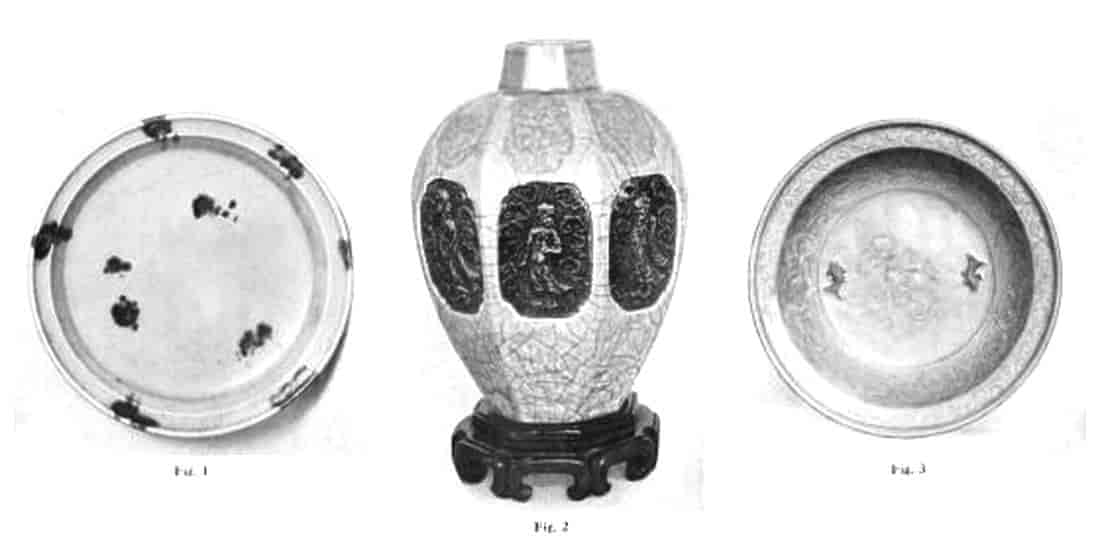
Plate 21.—Three examples of Lung–ch´üan Celadon Porcelain.
Fig. 1.—Plate of spotted celadon. (?) Sung dynasty. Diameter 6 12 inches. Eumorfopoulos Collection.
Fig. 2.—Octagonal Vase with crackled glaze and biscuit panels moulded with figures of the Eight Immortals in clouds. (?) Fourteenth century. Height 9 14 inches. Eumorfopoulos Collection.
Fig. 3.—Dish with engraved lotus scrolls and two fishes in biscuit. Sung dynasty. Diameter 11 inches. Gotha Museum.
Connoisseurs are much exercised over the differences between Sung and Ming celadons. The T´ao lu tells us nothing beyond the bare statement that the Ming ware was not so good, and the two general rules which have been laid down[166] for our guidance—viz. (1) that the colour of the Sung wares is deeper and more grass green, that of the Ming more grey green, and (2) that the bottoms of the Ming vessels are distinguished by an unglazed ring of reddish brown colour—can only be accepted with reserve. Of the two the colour test is probably the more reliable, but I have found too many exceptions in which the grey green occurs on pieces of obviously Sung origin to feel any great confidence in its guidance. The ring test breaks down in practice, and is illogical in its conception, implying, as it does, that the use of a circular support in the kiln was limited to one particular place and period. On the contrary, we know that this method of support was usual in the Siamese factories at Sawankalok,[167] and apparently before the Ming period, and as the Siamese potteries were started by Chinese, probably sent from Western China, it is only fair to suppose that this method of manufacture was in general use at an early date. The safest criterion of Sung workmanship is the style of the ware, and especially the boldness and freedom of the carved designs. In the Ming period the Sung patterns already exhibit an inevitable staleness and conventionality with a tendency to overcrowding of detail. In some cases, too, the designs are of a later order, and closely analogous to those of the blue and white Ming porcelains.
In addition to the Lung–ch´üan and Ch´u–chou celadons, which are readily recognised by their peculiar glaze and their reddish brown foot rims, there are many other kinds which are not easy to classify. Some of these have a dry, buff stoneware body and brownish green glaze, while others have a glaze of decided grey[82] or blue grey tone. In conjecturing the origin of these we must take into consideration the private factories which existed under the Northern Sung at Ch´ên–liu[168] and other localities in the neighbourhood of the eastern capital (tung ching), now named K´ai–fêng Fu, in Honan. The Ko ku yao lun[169] describes the ware of these parts under the heading Tung yao[170]: "It is pale green (ch´ing) in colour, with fine crackle, and in many cases has a brown mouth and iron foot. Compared with Kuan ware it lacks the red tinge, and its material is coarse, wanting in fineness and lustre, and far from equalling that of the Kuan ware. At the present day (i.e. 1887) it is rarely seen." Other writers repeat this passage with little alteration, though the author of the T´ao lu adds that the clay was of black colour and the glaze of varying depth. Hsiang's Album includes one specimen of the tung ch´ing tz´ŭ, describing the colour as t´ieh ts´ui, which probably means the blue green shade of distant hills.[171] Tung ch´ing glaze is included in the list of those imitated in the Imperial factories about 1780, two kinds, pale and deep, being specified; and the T´ao lu[172] informs us that the Tung ch´ing was copied to a considerable extent at Ching–tê Chên in the early nineteenth century, and that the modern glaze was exactly like the old. That this modern glaze was only a variety of celadon is shown by the recipe given in the same work,[173] viz. "to add to the ordinary glaze some of the mixture containing ferruginous earth," which differs from that given for the modern Lung–ch´üan glaze only in the absence of the pinch of cobalt (see vol ii., p. 189).
A verse from a poem by Chang–lei (1046–1106) indicates the green colour of the ware: "Green jade (pi yü) when carved[83] makes a vessel; know it to be the porcelain (tz´ŭ) of the Tung kilns  ."[174]
."[174]
In the classification of old celadons due account must be taken of the imitations made from the earliest times at Ching–tê Chên. Many of these would be distinguishable by their white porcelain body, the ordinary porcelain clay of the district not having the peculiar qualities of the Lung–ch´üan and Ch´u–chou Fu material. In fact, we know that it has been a common practice in recent times among the Ching–tê Chên potters to dress the exposed parts of their ware with brown ferruginous earth when they wished to reproduce the "brown mouth or iron foot" of the archaic wares. Another method which was found effective by imitators of the antique was to use a coarse yellowish clay for the body of the ware. This, however, should be generally recognisable. But the skill of the Chinese copyist is proverbial, and a good instance of his cunning is given in the now celebrated letters of Père d'Entrecolles, a Jesuit missionary stationed at Ching–tê Chên in the K´ang Hsi period. The passage[175] is interesting enough to be quoted in full:
"The mandarin of Kim tê Chim, who honours me with his friendship, makes for his patrons at the Court presents of old porcelain which he has himself a genius for fabricating. I mean that he has discovered the art of imitating antique porcelain, or at least that of comparative antiquity; and he employs a number of workmen for this purpose. The material of these false Kou tom, viz. counterfeit antiques, is a yellowish clay, obtained in a place quite near Kim tê Chim, called Ma ngan chan. They are constructed very thick. The mandarin has given me a plate of this make, which weighs as much as ten ordinary plates. There is nothing peculiar in the manufacture of these kinds of porcelain beyond that they are covered with a glaze made of yellow stone, mingled with the ordinary glaze, the latter predominating in the mixture, which gives the porcelain a sea green colour. When it is fired it is placed in a very rich broth made of chicken and other meats; in this it is baked a second time, and after that it is put in the foulest drain that can be found and left for a month or more. On issuing from this drain it passes for three or four hundred years old, or at any[84] rate for a representative of the preceding Ming dynasty, when porcelain of this colour and thickness was appreciated at Court. These counterfeit antiques resemble the genuine pieces also in their want of timbre when struck, and if one holds them to the ear they produce no reverberation."
The worthy father's acquaintance with the antiques was probably limited, or he would not have instanced the last quality as evidence of good imitation. On the contrary, the lack of timbre would be regarded by Chinese connoisseurs as indication of a spurious ware, the note of the old porcelains being one of the criteria of their excellence. But the passage is otherwise most instructive.
It should be remembered, too, that at the time of which d'Entrecolles speaks, an extensive use was being made at Ching–tê Chên of a beautiful celadon glaze on a fine white porcelain body. These celadons of the period will be discussed in their proper place, as they make no pretence of antiquity and are easily distinguished by their pure white body and pale soft green glaze. Indeed, they often have the ordinary white glaze under the base and a period mark in blue.
Another factory which made free use of the celadon glaze was that of Yang Chiang, province of Kuangtung. As a rule, the ware is recognisable by its reddish brown stoneware body, but in cases where the biscuit is lighter in colour and more porcellanous in texture, confusion may easily arise.
Nor must we forget the extensive manufacture of celadons outside China itself. The Corean wares have already been mentioned. As a rule, their soft velvety glaze is recognised by its peculiar bluish grey tone, difficult to describe but easy to remember when once seen. The colour, however, varies to distinctly greener and browner shades, which are liable to be confused with Chinese celadons of the Lung–ch´üan and northern types. Fortunately, most, though not all, of the Corean decorations are very characteristic, particularly the delicate inlaid designs[176] in white and black clays; and the finish of the ware underneath is usually distinctive, a very low foot rim, the base slightly convex, and the disfiguring presence of the sand, which in three little piles supported the ware in the kiln.
There are, however, quite a number of ambiguous celadons with a brownish green glaze, usually bowls, of which some are decorated inside with beautiful carved and moulded designs of bold foliage (Plate 18, Fig. 1) and even with the design of boys among flowering branches and the slight combed patterns which are found on the Corean white wares. Were it not for the apparently Chinese provenance of so many of these bowls, and the absence of the Corean characteristics in their bases, one would be tempted to class them as Corean on the strength of their general appearance. Probably we have in this group both the Chinese prototypes and the close imitations made by the Corean potters who followed these models just as they followed the white ware of Ting Chou. One of the combed bowls formerly treasured as a tea bowl in Japan is now in the Kunstgewerbe Museum, Berlin, but unfortunately the Japanese name shuko–yaki, by which Dr. Kümmel informs me it was known in Japan, sheds no light on the question of its origin.
The Sawankalok wares of Siam, too, have already had a passing mention. These are easily distinguished by their coarse grey body, reddish at the base, and thin, watery green glaze, very transparent and showing a bluish efflorescence where it has run thick. Once seen, they are hardly likely to be confused with any Chinese celadon, except a few of the coarser Ming and later types, in which the glaze happens to be very pale and thin. The Siamese wares, moreover, usually have a small raw irregular ring under the base, made by the end of a tubular kiln support, and differing from the broad regular ring on the Lung–ch´üan dishes described above.
But the most puzzling of the external celadons are those made at various times and places in Japan. They are, as a rule, close and careful copies of Chinese types, with which they are readily confounded by persons not familiar with Japanese peculiarities. In many cases, too, they will puzzle the most expert. It is well–nigh impossible to put into words any distinctive criteria of these wares. The biscuit is usually white and porcellanous, and though it sometimes assumes a natural tinge of red at the base, the colour is not so deep and decided as on the Lung–ch´üan wares. The chief distinction is an inevitable Japanese flavour in the form and decoration of the ware, but this, again, is an intangible feature which can only be realised by the practised eye. Finally, it should be said that remarkably close copies of the celadon green glaze (and of the[86] typical ornament as well) were made in Egypt and Persia in the late Middle Ages. At a short distance they might often be taken for Chinese, but on inspection the body will be found to have that soft, sandy texture which is an unmistakable characteristic of the near–Eastern pottery.
It is impossible to leave the subject of celadon without a few words on the distribution of the ware in the Middle Ages, though I have no intention of embarking on the lengthy discussion which the interesting nature of the subject invites, nor of reopening the much–debated Celadonfrage which elicited many interesting contributions[177] from Professors Karabacek, A.B. Meyer, and Hirth, and Dr. Bushell. Probably no single article of commerce can tell so much of the mediæval trade between China and the West as the old celadon porcelains whose fragments are constantly unearthed on the sites of the old–world trading stations. The caravan routes through Turkestan and the seaborne trade through the Eastern Archipelago and the Indian Ocean to the Persian Gulf, Red Sea, and east coast of Africa can be followed by porcelains deposited at the various trading centres and ports of call. Much, too, has been learnt from the writings of Chinese, Arab, and European travellers and geographers. Professor Hirth, as early as 1888, worked out the principal routes of Chinese seaborne trade from the "Records of Chinese Foreign Trade and Shipping,"[178] compiled by Chao Ju–kua about 1220 A. D., starting from the Tingui[179] of Marco Polo, which he identifies with Lung–ch´üan itself, and finishing in Egypt and Zanzibar. The porcelain was carried by land and river to the great port of Ch´üan–chou Fu, and thence in junks to Bruni in Borneo, Cochin China, and Cambodia, Java, Lambri, and Palembang, in Sumatra, where the traders of the East and West met and exchanged goods. Thence the trade proceeded to Quilom in Malabar, Guzerate, Cambray, and Malwa, and as far as Zanzibar. Numerous other localities might be mentioned,[87] and much has been written[180] of the veneration in which old Chinese wares have always been held in the Philippines and Borneo, and of the magic powers attributed to the old dragon jars by the natives of these countries.
The green celadon was highly valued in India and Persia, where it was reputed to have the power of disclosing the presence of poison. An early reference to the Chinese porcelain occurs in the writings of the Persian geographer Yacut,[181] who mentions "four boxes full of Chinese porcelain and rock crystal" among the effects of a native of Dour–er–Raçibi in Khouzistan, who died in 913 a.d. The trade with Egypt is indicated in the much–quoted incident of the gift of forty pieces of Chinese porcelain sent from Egypt by Saladin to Nur–ed–din in Damascus in 1171, and by the later gift of porcelain vases sent in 1487 by the Sultan of Egypt to Lorenzo de' Medici. A large proportion of the celadons in our collections has been brought and still comes from India, Persia, and Egypt.[182] The Sultan's treasure at Constantinople[183] teems with celadons collected in mediæval times. Fragments of celadon are unearthed on almost every important mediæval site which is excavated in the East. The British Museum has small collections of such fragments from Bijapur in India, the island of Kais in the Persian Gulf, Rhages in Persia, Ephesus, Rhodes, Cairo, and Mombasa, to mention a few sites only. Fragments of celadon were found, in company with Chinese coins ranging in date from 990–1111 A. D., by Sir John Kirk and Lieut. C. Smith, near Kilwa in Zanzibar, and the former, while British representative in Zanzibar, was able to form a considerable collection of complete specimens which were treasured by the natives with almost religious care. A story told by Sir John Kirk illustrates the attitude of the native mind towards these treasured wares. A celadon dish with particularly fine carving was the subject of a family dispute, and to satisfy the rival claims[88] a local Solomon decided that it should be divided between the disputants. One large fragment of it is now in Sir John Kirk's collection, which includes many interesting dishes, crackled and plain, and ranging in colour from dark olive green to the pale watery tint of the Sawankalok[184] wares. Other specimens of interest are the large, wide–mouthed, bowl–shaped vases with sides deeply ribbed or carved in high relief with bold floral designs. They have the peculiar feature of being constructed at first without a bottom, which was separately made in the form of a saucer and dropped in, the glaze holding it firmly in position. Similar vases[185] have been found in India and elsewhere. One of the first pieces of celadon to arrive in this country was the celebrated Warham bowl, which was bequeathed to New College, Oxford, in 1530 by Archbishop Warham. It is of dull grey green celadon, the outside faintly engraved with four lotus petals, each containing a trefoil, and in the bottom inside is the character ch´ing  (pure) surrounded by rays. It has a fine silver–gilt mount of English make.[186] It would be possible to multiply references to the traffic in celadon wares which was carried on briskly between China and the West in the Middle Ages, but enough has been said to give some idea of the extent and nature of the trade, which was mainly in the coarsest types of ware. Apart from the unlikelihood that very fine or precious porcelains would be embarked on such long and hazardous journeys, there was actually a law in force in China as early as the eighth century[187] which forbade, under penalty of imprisonment, the exportation of "precious and rare articles," anticipating by a thousand years the restrictive legislation of the Italian Government.
(pure) surrounded by rays. It has a fine silver–gilt mount of English make.[186] It would be possible to multiply references to the traffic in celadon wares which was carried on briskly between China and the West in the Middle Ages, but enough has been said to give some idea of the extent and nature of the trade, which was mainly in the coarsest types of ware. Apart from the unlikelihood that very fine or precious porcelains would be embarked on such long and hazardous journeys, there was actually a law in force in China as early as the eighth century[187] which forbade, under penalty of imprisonment, the exportation of "precious and rare articles," anticipating by a thousand years the restrictive legislation of the Italian Government.
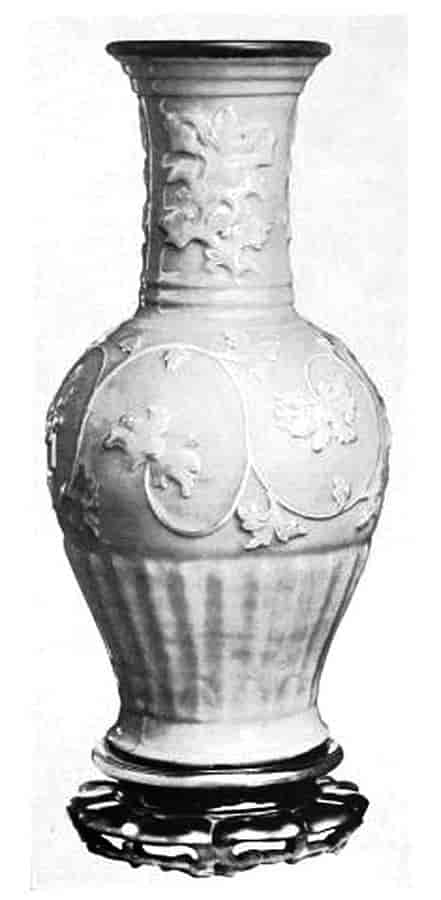
Plate 22.—Vase of Lung–ch´üan Porcelain.
With grey green celadon glaze of faint bluish tone, peony scroll in low relief. Probably Sung dynasty. Height 19 12 inches. Peters Collection.
CHAPTER VII
TING YAO 
TING ware is by general consent ranked among the finer Sung porcelains, and it is happily, like the Lung–ch´üan celadons, fairly well known to Western collectors. Its name derives from its place of origin, Ting Chou, the modern Chên–ting Fu, in the province of Chihli, where the manufacture of a white ware, if not actually a white porcelain, appears to have existed from remote times. Indeed, the "white ware (pai tz´ŭ) of Ting Chou" is mentioned in the middle of the seventh century,[188] though nothing further is heard of it until it came to enjoy the patronage of the Sung emperors. As already hinted in connection with the Ju Chou porcelain, the Ting ware suffered a temporary eclipse at Court owing to some defects in the glaze; but it was not long in recovering its reputation, for the Ko ku yao lun states that it was at its best in the Chêng Ho and Hsüan Ho periods, which extended from 1111 to 1125 A. D., and we learn that the Ting Chou potters accompanied the Court in its flight across the Yangtse in 1127. The manufacture seems to have been re–established after this event in the neighbourhood of Ching–tê Chên, and the nan ting or Southern Ting ware is said to have so closely resembled the original that to distinguish the two in after years was regarded as a supreme test of connoisseurship.[189]
Ting ware has a white body of fine grain and compact texture, varying from a slightly translucent porcelain to opaque porcellanous stoneware. Though not so completely vitrified as the more modern porcelains, and lacking their flint–like fracture, it was nevertheless capable of transmitting light in the thinner and finer specimens, and consequently it can be regarded as one of the earliest Chinese [90]wares which fulfils the European definition of porcelain. The glaze is of ivory tint, sometimes forming on the outsides of bowls or dishes in brownish gummy tears, which were regarded by Chinese collectors as a sign of genuineness.[190] The finer and whiter varieties are known as pai ting (white Ting) and fên ting (flour Ting), as distinct from the coarser kind, whose opaque, earthy body and glaze of yellowish tone, usually crackled and stained, earned it the name of t'u ting or earthen Ting.
In the best period the pure white undecorated Ting ware, with rich unctuous glaze, compared to "congealed fat" or "mutton fat," was most esteemed, though ornament was freely used, especially on the Southern Ting. Designs carved in low relief or etched with a point were considered best, the moulded and stamped ornament being rightly regarded as inferior. There is a remarkable, though sadly damaged, example of Northern Ting ware in the British Museum. It was found in a Manchurian tomb of the twelfth century, and bears out the current descriptions of the ware with its fine white body, rich ivory glaze, and "tear drops" on the reverse. The ornament, a lotus design in bold freehand carving, displays all the freshness and power of Sung craftsmanship. This dish has, moreover, a characteristic common to the Sung Ting bowls and dishes, viz. the mouth rim is bare of glaze. Many of the early wares were fired upside down, whence the bare mouth rim, which was usually hidden by a metal band.[191]
Favourite carved designs with the Ting potters seem to have been the mu–tan peony, the lily, and flying phœnixes. They are, at any rate, usually singled out for mention by Chinese writers.[192] Garlic and rushes are also incidentally mentioned as motives, and a few examples of a beautiful design of ducks on water are known in Western collections. The moulded ornament is generally more elaborate, dense peony scrolls with phœnixes flying through them, radiating panels of flowers, dragons in clouds, fishes among water plants and wave patterns, etc. To judge from Hsiang's Album, [91]carved designs borrowed from ancient bronzes must have been highly prized.
Of the three kinds of ornament usually associated by Chinese writers with the Ting ware; the hua hua (carved decoration) and the yin hua (stamped or moulded decoration) have already been mentioned. The meaning of the third, hsiu hua,[193] is not so clear, as the phrase can bear two interpretations, viz. painted ornament or embroidered ornament. In the latter sense it would suggest a rich decoration like that of brocade without indicating the method by which it was applied. But in the former it was the usual Chinese expression for painted ornament, and it is difficult to imagine that it was intended to indicate anything else in the present context. On the other hand, no examples of painted Ting ware are known to exist either in actual fact or in Chinese descriptions. This anomaly, however, may perhaps be explained in one of two ways. A creamy white ware of t´u ting type, boldly painted with brown or black designs, is known to have been made at the not far distant factories of Tz´ŭ Chou[194] in the Sung dynasty, and it is possible that either the painted Ting ware has been grouped with the Tz´ŭ Chou ware in modern collections, or that Chinese writers mistook the Tz´ŭ Chou ware for painted Ting ware and added this third category to the Ting wares by mistake. In any case they regarded the painted ware as an inferior article.
The high estimation in which fine specimens of white Ting ware have always been held by Chinese connoisseurs is well illustrated by a passage in the Yün shih chai pi t´an.[195] It tells how Mr. Sun of the Wu–i river estate treasured in his mountain retreat Ting yao incense–burners, and among them one exquisite specimen of the Sung period. It was a round vessel with ear handles and three feet, and the inscription li hsi yai ( ) was engraved in seal characters on the stand. During the Japanese raids in the Chia Ching period this vessel passed into the hands of one Chin Shang–pao, who sold it to T´ang, the President of Sacrifices (t´ai ch´ang), of P´i–ling. T´ang, whose residence bore the romantic but chilly name of Ning–an (Frozen Hut), is the celebrated collector mentioned in connection with another Ting vessel on p. 95. "Although[92] T´ang had many wonderful porcelains," the story runs, "when this vessel arrived, they all, without exception, made way for it. And so throughout the land when men discuss porcelains, they give the first place to T´ang's white incense vase. T´ang, they say, did not readily allow it to be seen." And in this respect, if all accounts are true, T´ang was not unlike a good many Chinese collectors of the present day.
) was engraved in seal characters on the stand. During the Japanese raids in the Chia Ching period this vessel passed into the hands of one Chin Shang–pao, who sold it to T´ang, the President of Sacrifices (t´ai ch´ang), of P´i–ling. T´ang, whose residence bore the romantic but chilly name of Ning–an (Frozen Hut), is the celebrated collector mentioned in connection with another Ting vessel on p. 95. "Although[92] T´ang had many wonderful porcelains," the story runs, "when this vessel arrived, they all, without exception, made way for it. And so throughout the land when men discuss porcelains, they give the first place to T´ang's white incense vase. T´ang, they say, did not readily allow it to be seen." And in this respect, if all accounts are true, T´ang was not unlike a good many Chinese collectors of the present day.
On the other hand, the Ting ware was often marred by certain blemishes which are not always easy to understand. The "awns" (mang), for instance, which degraded it at Court in favour of the Ju Chou ware in the early Sung period were probably flaws in the glaze. The "bamboo thread brush marks" mentioned in the Liu ch´ing jih cha[196] may perhaps be lines left in the glaze which was applied by means of a bamboo brush. Three other defects which rendered the ware comparatively worthless are named in the Ko ku yao lun,[197] viz. mao (thatch), mieh (bamboo splints), and ku ch´u (bare bones). The author fortunately explains that (1) to thatch (mao) means to cover over defects, (2) bamboo splints (mieh) is used of lines and recalls the brush marks mentioned above, and (3) bare bones (ku ch´u) are patches where the glaze is defective and the body shows through. Ku, in the sense of "body or biscuit," we are further informed, is a "curio–market expression." Modern collectors will probably not be so fastidious as the Chinese of the fourteenth century, and will welcome a Sung specimen of Ting porcelain, even though it suffer from mang and ku ch´u.
The pai ting and the t´u ting, the fine and coarse white varieties, alone have been identified in Western collections; but there are coloured Ting porcelains which are known to us by literary references. An apocryphal red Ting ware[198] (hung ting) is mentioned in two passages of ambiguous meaning which need not necessarily have implied a true red glaze. In any case it finds no place in the older works, such as the Ko ku yao lun and Ch´ing p´i tsang, which only speak of purple or brown (tzŭ) Ting, and black Ting. [93]"There is purple[199] Ting," says the Ko ku yao lun, "the colour of which is purple; there is ink Ting, the colour of which is black, like lacquer. The body in every case is white, and the value of these is higher than that of white Ting."
Hsiang, who figured five specimens in his Album, compared them to the colour of ripe grapes and the skin of the aubergine fruit or brinjal, one specimen being tzŭ ts´ui (purple blue); and he further states that out of a hundred and more specimens of Ting ware he had only seen ten of purple and one of black colour.
The solitary specimen of black Ting, which appears in a very unconvincing illustration in Hsiang's Album,[200] is divided into two zones, one black, the other white, and Hsiang regards it as inestimably rare and precious. In this appreciation he follows the Ko ku yao lun, but other writers, such as the author of the Ch´ing pi ts´ang, take an entirely different view, holding neither the purple nor the black Ting ware of much account. With us at present the question is of academic interest only, as no examples of either kind worthy of notice have been identified in Western collections. The nearest approach to the description of the purple variety which I have seen is a small box from a tomb in Shansi, made of white porcellanous ware with a purplish black glaze on the cover. It is, however, a crude object, and of no particular merit. As for the black Ting, the nearest analogue to that which I can quote is the vases with black or brown black glaze belonging to the Tz´ŭ Chou class. Some of these (see Plate 30) have zones of black and white recalling Hsiang's description. It is, perhaps, worth noting in this connection that the black glaze on these wares was liable to shade off into lustrous brown, indicating the presence of iron oxide, and to resemble in this respect the so–called "hare's fur" or "partridge" glazes of the celebrated Chien yao tea bowls.[201] This fact may account for a passage in an early writer,[202] who says [94]"the ancients favoured as tea bowls Ting ware with hare's fur marking, and these were used in the powdered–tea competitions," but the work deals with tea rather than ceramics, and it is probable that a confusion had arisen in the author's mind between the Chien yao tea bowls and Ting ware. On the other hand, it would appear that bowls with glaze which has some analogies with the "hare's fur" were made at an early date in Northern China. (See Fig. 1 of Plate 43 and p. 132.)
Though little is heard of the coloured Ting wares after the Sung period,[203] the manufacture of white Ting and the commoner t´u ting continued at Ching–tê Chên and elsewhere. In fact, it cannot be said to have suffered intermission up to the present day. A few of these imitative wares of later date were of such excellence as to merit historical notice. In the Yüan dynasty, for instance, P´êng Chün–pao, a goldsmith of Ho Chou, in Shansi,[204] was celebrated for his imitations of old Ting wares, and the Ko ku yao lun, an almost contemporary work, describes his productions as exactly like Ting ware when of fine body,[205] but as being "short" and "brittle," and consequently not really worth much. "But dealers in curiosities give them the name of hsin ting or New Ting, and amateurs collect it at great cost, which is most ridiculous." Again, the Po wu yao lan describes another wonderful imitation of Ting ware made in the sixteenth century[206] by Chou Tan–ch´üan, a native of Wu–mên, who settled at Ching–tê Chên, and was reputed the best potter of his time. Though, generally speaking, his material was not as fine as the original, still his copies of Wên wang censers[207] and sacrificial vessels with "monster heads and halberd ears" so closely resembled the originals that it was only necessary to "rub away the kiln–gloss all over the surface" to make the illusion complete. Among the literary references to pottery and [95]porcelain collected in books viii. and ix. of the T´ao lu is a story narrated in the Yün shih chai pi t´an, illustrating the cleverness of Chou Tan–ch´üan. Julien[208] has translated it as follows: "One day he (Chou) embarked on a merchant boat from Kin–tchong and landed on the right bank of the Kiang. Passing P´i–ling, he called on T´ang, the President of the Sacrifices (T´ai ch´ang), and asked permission to examine at leisure an ancient tripod of Ting porcelain[209] which was one of the gems of his collection. With his hand he took the exact measurements of the vessel; then he made an impression of the patterns on the tripod with some paper which he had hidden in his sleeve, and returned at once to Ching–tê Chên. Six months after he returned and paid a second visit to Mr. T´ang. Taking from his sleeve a tripod, he said to him, 'Your Excellency owns a tripod censer of white Ting porcelain. Here is its fellow, which belongs to me.' T´ang was astounded. He compared it with the old tripod, which he kept most carefully preserved, and could find no difference. He tried its feet against those of his own vessel and exchanged the covers, and found that it matched with perfect precision. T´ang thereupon asked whence came this wonderful specimen. 'Some time ago,' answered Chou, 'I asked your leave to examine your tripod at leisure. I then took all its measurements with my hand. I assure you that this is a copy of yours, and that I would not deceive you in the matter.' The T´ai ch´ang, realising the truth of this statement, bought for forty ounces of silver the tripod, which filled him with admiration, and placed it in his collection beside the original as though it were its double. In the Wan Li period (1573–1619), Tu–chiu, of Huai–an, came to Fou–liang. Smitten with a deep longing for T´ang's old censer, he could think of nothing else, and even saw it in his dreams. One day he went with Kien–yu, the T´ai ch´ang's nephew, and after much importunity he succeeded in getting from him for a thousand ounces of silver the imitation made by Chou, and returned home completely happy."
Other examples of Ting imitations in the late Ming period, described in the Po wu yao lan, include "magnolia blossom cups; covered censers and barrel–shaped censers with chain–armour pattern, ball and gate embroidery and tortoise pattern mingled together in an ornamental ground." But we gather that though these have[96] been confounded with Chou's work they were inferior both in material and workmanship to his early masterpieces.
At any rate, it is certain that besides these conspicuous craftsmen whose names have become historical, there were many nameless potters at Ching–tê Chên who devoted their skill to the imitation of pai ting porcelain in the Ming and Ch´ing dynasties. Very beautiful wares of this class are occasionally seen which have a "slickness" of decoration and a mechanical refinement of finish characteristic of an art which is already crystallised and has lost its freshness and spontaneity. These are, no doubt, the work of later copyists. Indeed, we are expressly told in the T´ao lu[210] that at the end of the eighteenth century there were still potters at Ching–tê Chên who made a specialty of pai ting ch´i or white Ting wares. These, moreover, were makers of curiosities and ornamental wares (wan), and they sometimes painted their wares with underglaze blue.
Among the provincial wares of the Ting type the Ko ku yao lun mentions Hsiang yao, which "has crab's claw crackle. When rich and lustrous it is highly esteemed, but when yellow and of coarser material, it is of little merit or value." Another work[211] gives this ware a flattering mention in stating that the Ting ware resembled Hsiang yao in colour. The locality of its manufacture is left in doubt, but it was probably Hsiang–shan, in the Ning–po prefecture of Chekiang. The T´ao lu names a good number of producers of white ware, some definitely described as of Ting type, among the lesser factories. Su Chou,[212] for instance, in Anhui, in the modern prefecture of Fêng–yang, had a pottery dating from the Sung period. Its productions resembled Ting ware in colour, and had a considerable reputation. In fact, when the Ting porcelain became scarce the Su Chou ware was largely bought in Northern China as a substitute, though in reality it was far from equal to the genuine Ting.
Ssŭ Chou,[213] too, another place in Anhui, had a pottery dating from Sung times, which made wares of Ting type, and "persons who liked a bargain often bought them in place of Ting porcelain." In the same district, during the Yüan and Ming periods, a thin white ware with "earthen" body was made at Hsüan Chou,[214] which was evidently of t´u ting type. Brinkley[215] speaks of a pottery of this kind which is greatly esteemed by the Japanese under the name of Nyo–fu ware[216]; and a little wine cup with a slight engraved floral decoration in the British Museum is possibly an example of this class. It has an earthy looking body, and creamy white glaze, and is thin and very light to handle. Under the base are engraved the words  han hsing ("to contain fragrance").
han hsing ("to contain fragrance").
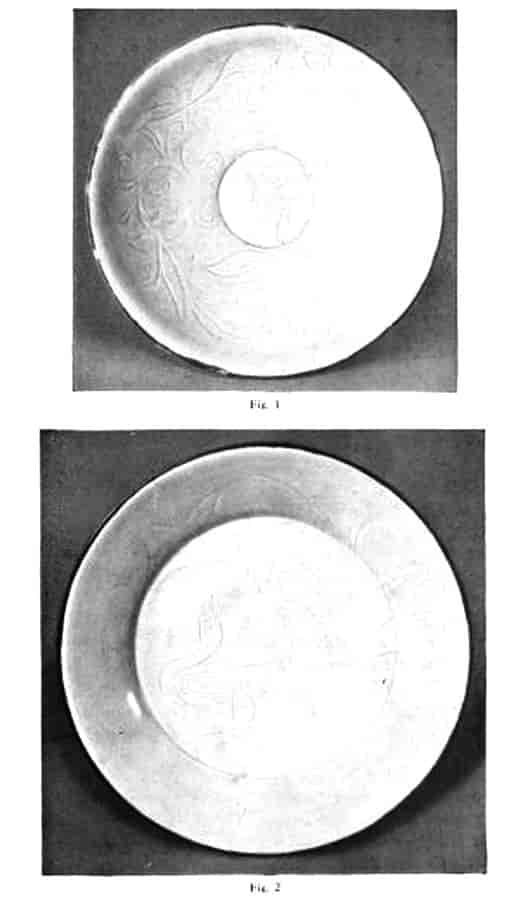
Plate 23.—Ivory white Ting Ware, with carved ornament. Sung dynasty.
Fig. 1.—Bowl with lotus design. Diameter 8 12 inches. Eumorfopoulos Collection.
Fig. 2.—Dish with ducks and water plants. Diameter 8 34 inches. Alexander Collection.
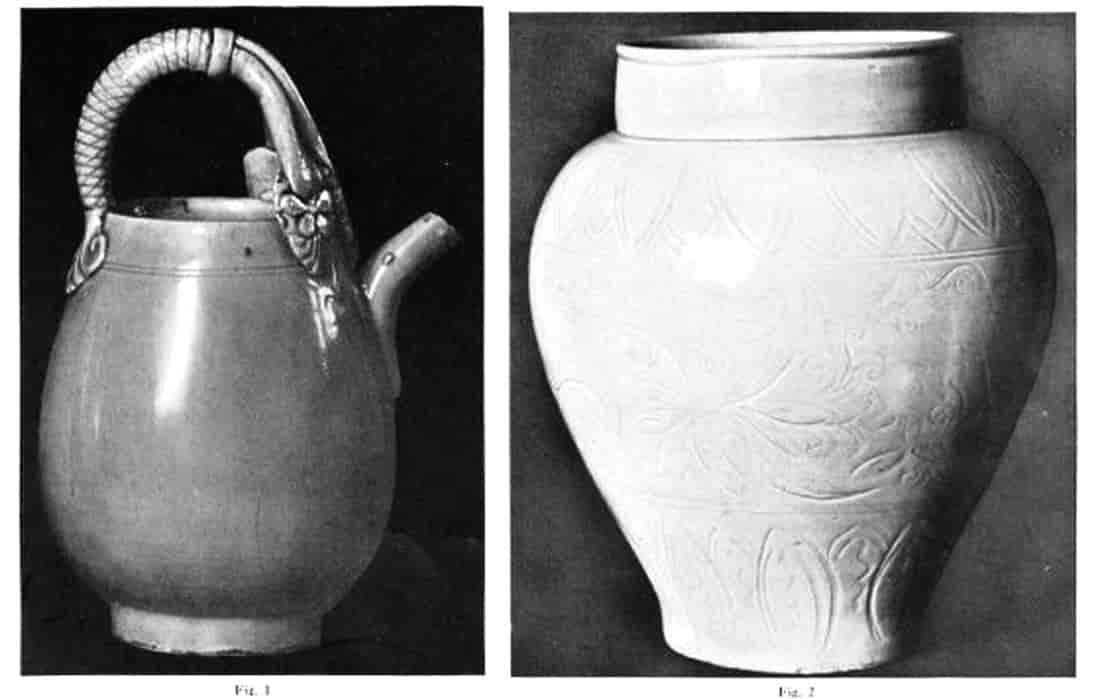
Plate 24.—Sung and Yüan Porcelain.
Fig. 1.—Ewer, translucent Porcelain, with smooth ivory white glaze. Sung or Yüan dynasty. Height 6 inches. Alexander Collection.
Fig. 2.—Vase of ivory white Ting ware with carved lotus design. Sung dynasty. Height 11 12 inches. Eumorfopoulos Collin.
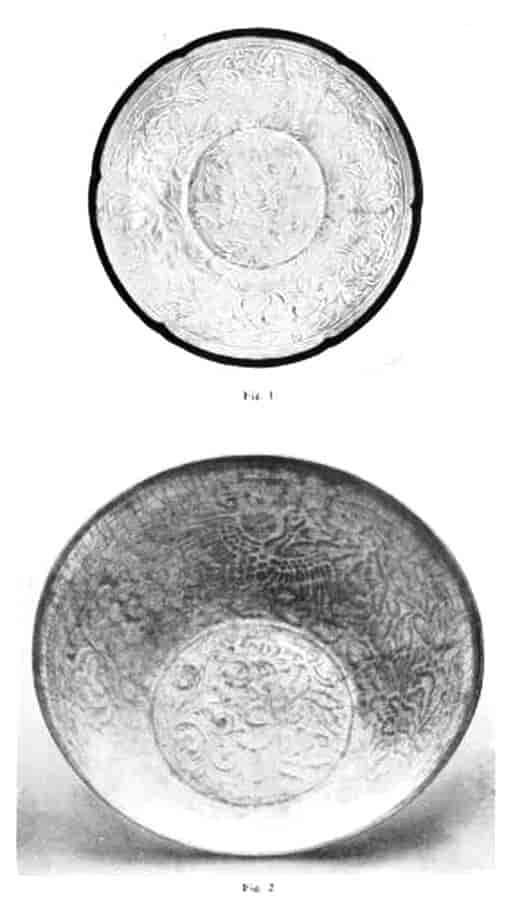
Plate 25.—Ting Ware with moulded designs, Sung dynasty.
Fig 1. Plate with boys in peony scrolls, ivory white glaze. Diameter 7 34 inches. Peters Collection.
Fig. 2. Bowl with flying phœnixes in lily scrolls, crackled creamy glaze; t´u ting ware. Diameter 6 inches. Koechlin Collection.
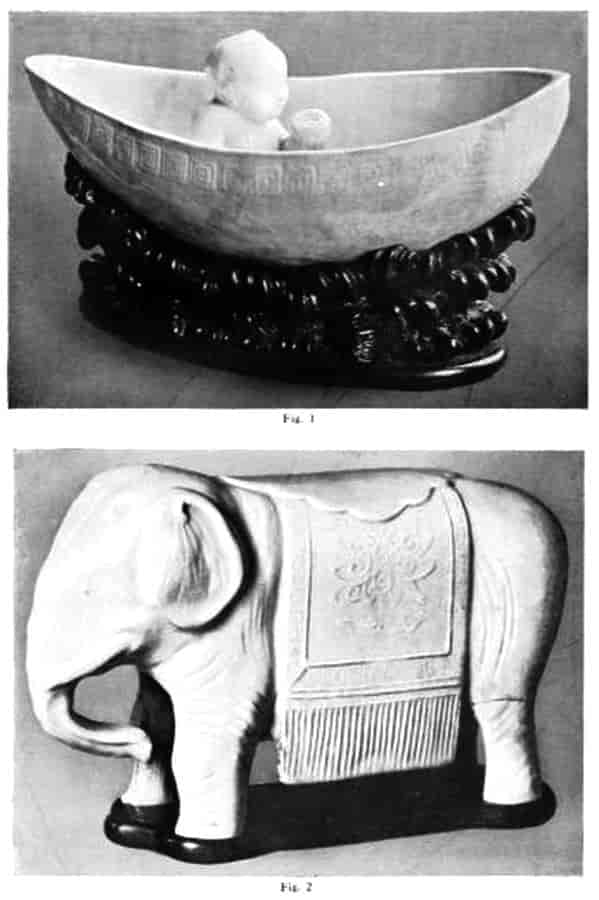
Plate 26.—T´u ting Ware, Sung dynasty, with creamy crackled glaze.
Fig. 1.—Brush washer in form of a boy in a boat. Length 7 18 inches. Rothenstein Collection.
Fig. 2.—Figure of an elephant. Length 10 12 inches. Eumorfopoulos Collection.
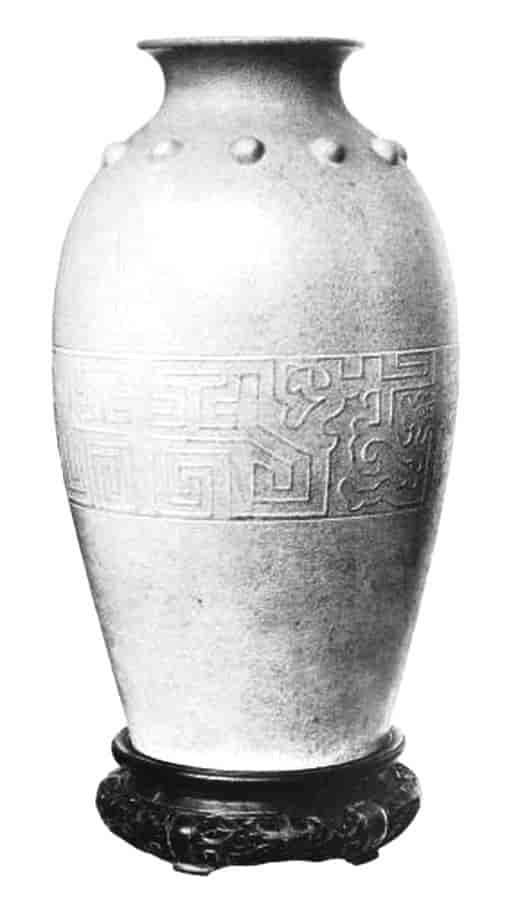
Plate 27.—Vase of bronze form with row of studs and moulded belt of k´uei dragon and key–fret patterns.
"Ostrich egg" glaze. (?) Kiangnan ware, of Ting type; Sung dynasty. Height 17 58 inches. Peters Collection.
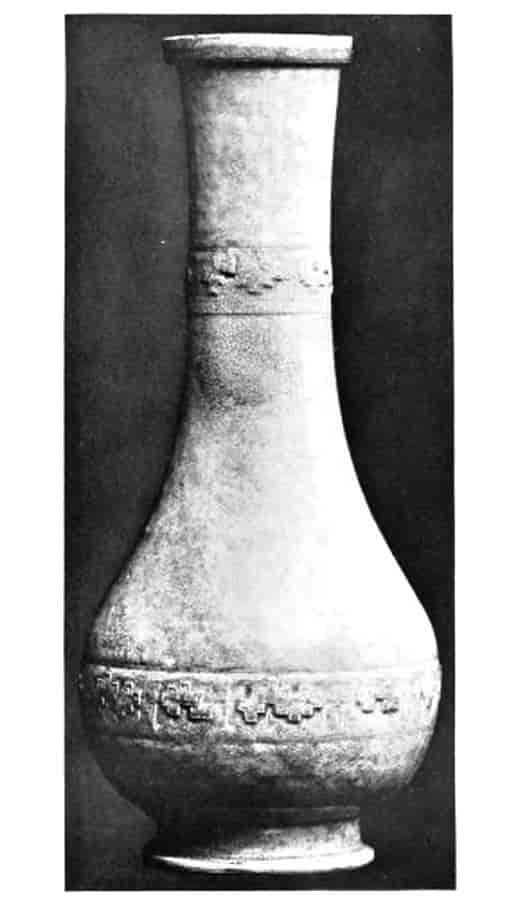
Plate 28.—Vase of bronze form with two bands of raised key pattern.
Thick creamy glaze, closely crackled and shading off into brown with faint tinges of purple. (?) Kiangnan Ting ware. Fourteenth century. Height 15 12 inches. Koechlin Collection.
In Kiangsu, the western portion of Kiang–nan, is the "white earth village" Pai–t´u Chên,[217] where potteries existed from Sung times, making a ware of the local clay, very thin, white and lustrous, beautiful in form and workmanship. Thirty kilns were worked, chiefly by families of the name Tsou, under the direction of a headman, the potters numbering several hundreds.
Under the heading of Hsi yao,[218] the T´ao shuo alludes to four factories in the province of Shansi, which are interesting to–day in view of the various wares excavated in the railway cuttings now under construction in that province. A fuller description of these potteries is given in the T´ao lu, which mentions P´ing–yang Fu in the southern half of Shansi as a pottery centre in the T´ang and Sung dynasties, where the ware was white but disqualified by a glaze lacking in purity. At Ho Chou, in the same district, a superior ware was made as early as the T´ang dynasty, which was even considered worthy of mention in the Ko ku yao lun, probably because of the connection of P´êng Chün–pao (see p. 94) with this place in the Yüan dynasty. The T´ao lu tells that the Ho ware was made of fine rich material, the body unctuous and thin, and the colour usually white, and that it was more beautiful than P´ing–yang ware—a qualified compliment! A coarse pottery made at Yu–tzü Hsien, in the T´ai–yüan prefecture in the north, and at P´ing–ting Chou in the west, complete the quartet. The former dated from T´ang times, and the latter, dating from the[98] Sung, was made of a dark–coloured clay which gave a dusky tinge to the white glaze. A small melon–shaped vase, reputed to have come from a tomb in Shansi, is shown in Plate 11. It has a hard, buff grey body, with a dressing of white slip and white glaze, the effect of the combination being a pleasing surface of solid–looking ivory white. A factory which made white wares in the neighbouring province of Shansi is named in the twelfth century Ch´ing po tsa chih.[219] It was situated at Huang–p´u Chên, in Yao Chou, where, as we are told in the T´ao shuo, they had at an early date made flat–bottom bowls which were called "little seagulls." The place is near Hsi–an Fu.
Wares of the t´u ting, the "earthy" Ting, type, with creamy glaze, were made at Nan–fêng Hsien,[220] in the province of Kiangsi, during the Yüan dynasty; and at Chi Chou[221] in the same province there were factories in the Sung dynasty which deserve some attention. The latter were situated at Yung–ho Chên, in the Chi Chou district, in the prefecture of Chia–an Fu, and one of the productions appears to have resembled the purple (tzŭ) Ting ware, though it was coarser and thicker, and of no great merit. The Ko ku yao lun[222] speaks of five factories in this place producing white and purple (tzŭ) wares, flower vases of large size and considerable value, and small vases which were ornamented, and crackled wares of great beauty. The best of these potteries belonged to a man named Shu  . We are further informed by the Chü chai tsa chi[223] that Shu, the old man (Shu wêng), was skilled in making ornamental objects, and that his daughter, Shu chiao (the fair Shu), excelled him. Her incense burners and jars of various kinds commanded a price almost equal to that of Ko yao. The author proceeds to describe a dish and a bowl in his own collection as of "grey ware with invisible blue[224] glaze, which was capable of keeping water sweet for a month." It has been assumed that the decoration of the "small vases" was painted,[225] but the expression in the text (yu hua)[226] gives no clue to the kind [99]of decoration, and we are left quite in the dark as to its real nature.
. We are further informed by the Chü chai tsa chi[223] that Shu, the old man (Shu wêng), was skilled in making ornamental objects, and that his daughter, Shu chiao (the fair Shu), excelled him. Her incense burners and jars of various kinds commanded a price almost equal to that of Ko yao. The author proceeds to describe a dish and a bowl in his own collection as of "grey ware with invisible blue[224] glaze, which was capable of keeping water sweet for a month." It has been assumed that the decoration of the "small vases" was painted,[225] but the expression in the text (yu hua)[226] gives no clue to the kind [99]of decoration, and we are left quite in the dark as to its real nature.
The industry seems to have ended abruptly at the beginning of the Yüan dynasty, the story being that when the Sung minister Wên was passing by all the ware in the kilns turned to jade, and the potters, fearing that the event might reach the Emperor's ears, closed down the kilns and fled to Ching–tê Chên. The meaning of this myth has never been satisfactorily explained, but it was pointed out that a large number of Yung–ho names appear in the early lists of Ching–tê Chên potters, and the Ko ku yao lun asserts that excavations on the site of the kilns were made in the Yung Lo period (1403–1424), and that several kinds of jade cups and bowls were found—cautiously adding, however, that this might or might not have been the case. The ruins of the Yung–ho potteries seem to have been still visible in the fifteenth century.[227]
From a passage in the T´ao lu we learn that crackle was a speciality of some of the Yung–ho potters. Under the heading of Sui ch´i yao[228] (crackle wares), we are told that "these are the wares made in the Southern Sung period. Originally, they were a special class of the ware made at Yung–ho Chên.... The clay was coarse but strong, the body thick, the material heavy. Moreover, there were 'millet coloured' (mi sê) and pale green (fên ch´ing) kinds.[229] The potters used hua shih (steatite) in the glaze, and the crackle was in running lines, like a broken thing. They smeared and blackened the ware with coarse ink or ochreous earth; then they finished it. Afterwards they rubbed it clean, and it was found to have hidden lines and stains of red or black, like cracked ice, beautiful to look at. There were besides pieces with plain crackled ground, to which they added blue decoration." This appears to be the first mention of painted blue decoration, and if it is true that it was made in the Sung period, it carries this important method back farther than has been usually supposed. Possibly the ware was of the same type as the coarse crackled porcelain, with roughly painted blue designs, found in Borneo and Malaysia, where it is credited with great antiquity. There is a very interesting[100] specimen in the Kunstgewerbe Museum, Berlin, which bears on this question. It came from Japan, where it had been treasured as a Chinese tea bowl of the Sung period, and it has a brownish green crackled glaze painted in dark blue with the characters O mi t´o fo (Amitabha Buddha), which was sometimes written in this way as a charm against evil.
CHAPTER VIII
TZ´Ŭ CHOU  WARE
WARE
A LARGE and important class of wares, closely related to the Ting group, was made at Tz´ŭ Chou, formerly in the Chang–tê Fu in Honan, and now included in the Kuang–p´ing Fu in Chihli. The name of the place, previously Fu–yang, was changed to Tz´ŭ Chou in the Sui dynasty (589–617 A. D.), and as it was derived, as Chinese writers are careful to explain, from the tz´ŭ stone from which the ware was made, we may infer that this material, and no doubt the local potteries, assumed importance at this early date. There were, in fact, a few fragments of pottery of the Tz´ŭ Chou type, decorated with brown spots, among the Chinese wares found on the ninth–century site of Samarra, in Persia, by Professor Sarre (see p. 148); and a finely painted fragment of a Tz´ŭ Chou vase in the Anthropological Museum at Petrograd was brought from a site in Turfan, which was in all probability as early as the tenth century. Moreover, it is constantly asserted by traders in China that this or that piece of painted Tz´ŭ Chou ware was found in a T´ang tomb, and in many cases, such as that of the brown–painted vase with lotus design mentioned on p. 33, the form of the specimen and the style of the decoration are quite consistent with a T´ang attribution. There is, however, no information on the subject earlier than the Sung dynasty, when the Tz´ŭ Chou factories enjoyed a high reputation.[230] The Ko ku yao lun gives the following brief notice of them under the heading "Old Tz´ŭ wares":—
"Old Tz´ŭ wares (tz´ŭ ch´i) were made at Tz´ŭ Chou, in the Chang–tê Fu in Honan. Good specimens closely resemble Ting ware, but have not the tear–stains. There are, besides, specimens with engraved and painted[231] ornament. The plain white pieces command a higher price than Ting ware. The recent (i.e. late [102]fourteenth century) productions of the factory are not worthy of consideration."
If, as this account seems to imply, the Tz´ŭ Chou factories were in low water at the end of the Yüan dynasty, like many other potteries at this time, they managed to retrieve their fortunes, for they still carry on an unbroken tradition to this day.[232] The ware is in general use among the common folk of Peking and Northern China,[233] and is still decorated (though coarsely) in the antique style with free and sketchy painted designs in dark brown and maroon slip, the body being greyish white, with creamy crackled glaze. This is, of course, only one kind out of many, but the traditions have been so closely preserved that from this type alone it is easy to identify many Tz´ŭ Chou specimens among the early wares which have lately come from excavations in China.
The quantity of pottery produced at Tz´ŭ Chou in the last nine or ten hundred years must have been enormous, but as the post–Sung wares do not seem to have appealed to Chinese connoisseurs, little has been heard of it until recent times, and the stray specimens which did find their way to Europe were either unclassified or grouped with Corean specimens in deference to a mistaken Japanese opinion.[234] Now, however, considerable interest has been taken in the ware by Western collectors, and a plentiful supply is forthcoming, so that it is possible to make a comparative study of the different types, and to appreciate the varied and clever decorative methods of the Tz´ŭ Chou potters. But the conservative nature of the wares will always make it extremely difficult for us to fix the exact period during the many centuries when any individual piece was made, and the early dates assigned indiscriminately, though perhaps excusable on account of the archaic character of the painted decoration, should be accepted with caution.
The plain white Tz´ŭ Chou wares of the Sung period, which favourably compared with the Ting porcelain, have been identified in a few instances only by peculiarities of shape. Indeed, it is unlikely that we shall have any other means of discriminating them from the latter ware. But by far the largest group of [103]the Tz´ŭ Chou family consists of the painted wares. Like the rest of the Tz´ŭ Chou pottery which has so far been identified, these have a greyish buff body of porcellanous stoneware usually coated with a white clay slip and covered with a transparent glaze almost colourless, but with a creamy tinge. On this glaze, and sometimes under it, the painters executed rapid, bold, and rather impressionist designs in shades of brown, varying from black to a soft sepia colour. The earliest specimens seem to have been of this kind, and it is certain that this method of decoration was practised in the Sung period, if not earlier.[235] In a few cases the glaze seems to have been omitted, the brown painting appearing on a lustreless white slip; and where the brown or black colour was laid on in broad washes, details were often etched out with a pointed instrument. The black, moreover, when in considerable areas, sometimes developed passages of lustrous coffee brown[236] (due to the presence of iron), such as is seen in the "partridge cups" of Chien yao. It is probable that the Sung Tz´ŭ Chou ware, with its solid ivory white surface, often crackled, and its sketchy floral designs, may have served as a model to the Japanese for the Kenzan style of decoration and the ivory white Satsuma faience.
Another style of ornament, which may date from Sung times, and is certainly common on later wares, consists of a broad band of floral scrolls, with large lily or aster flowers, enclosed by smaller zones of floral pattern or formal designs. Next come the large panels of figure subjects, usually of Taoist sages, or birds and animals in foliage, enclosed by bands of formal ornament or floral scrolls. In some cases a beautiful pale blue glaze of turquoise tint covers this class of ornament (Plate 32, Fig. 1), strangely recalling the Persian and Syrian pottery with still black paintings under a turquoise glaze. Indeed, it was a common error a few years back [104]to class the stray specimens of this type as Persian; but a comparison with the brown–painted Tz´ŭ Chou specimens shows their true origin, and the discovery of a small dish of this kind in a Sung tomb[237] proves the antiquity of this method of decoration in China.
The brown and black was supplemented, in the Ming period if not earlier, first by a maroon slip and later by iron red and green enamel.[238] A specimen with panelled decoration in these colours was described by Brinkley[239] as having been preserved in Japan since 1598, showing that this class of decoration was at any rate contemporary with the "red and green family" of porcelain. A specimen in the Benson Collection shows, further, that aubergine and green were sometimes used in combination with turquoise glaze, as in the Ming "three–colour porcelain." Under–glaze blue is also found on Tz´ŭ Chou wares, but we have no clue to the date when it was introduced.
The ordinary ware, made in quite modern times at Tz´ŭ Chou, is illustrated by a small flask and a figure obtained by Dr. Bushell, and now in the British Museum. Though decorated in the characteristic style with slight sketchy design in brown and maroon, they show a decided falling off when compared with the older specimens. The body is a hard, greyish white stoneware; there is no slip covering, and the glaze is yellowish, soft–looking, and freely crackled, without the solid qualities of the older ivory glaze on a white slip coating. I am inclined to think that this degenerate type of ware dates back no farther than the nineteenth century, and that the Tz´ŭ Chou pottery preserved its character up to and perhaps throughout the eighteenth century. There are several examples of pottery pillows, with body and glaze of good quality and finely painted in black and brown, with panelled designs sometimes containing floral motives, sometimes figure subjects. One of these, exhibited at the Burlington Fine Arts Club in 1910,[240] was tentatively ascribed to the late Ming period. Since then the British Museum has acquired another, and I have heard of two more in private hands. The three last bear the mark of a potter named Chang,[241] and on some of them we find additional inscriptions containing the words ku hsiang (of old Hsiang) and hsiang ti (of the region of Hsiang). Hsiang, I find, is the old name of Chang–tê Fu, the prefecture in which Tz´ŭ Chou is situated, and this fact definitely connects the ware with the factories under discussion. At the same time the relatively large number of these pieces in our collections and the style of Chang's mark seem to indicate that they are of fairly recent date, probably not older than the seventeenth century.
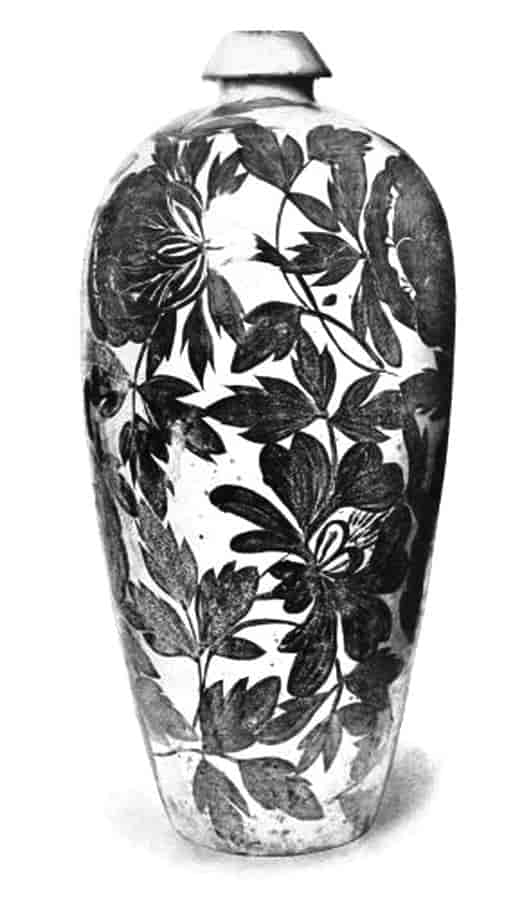
Plate 29.—Vase of Porcellanous Stoneware.
With creamy white glaze and designs painted in black. Tz´ŭ Chou ware, Sung dynasty (960–1279 A. D.). Height 17 inches. In the Louvre.
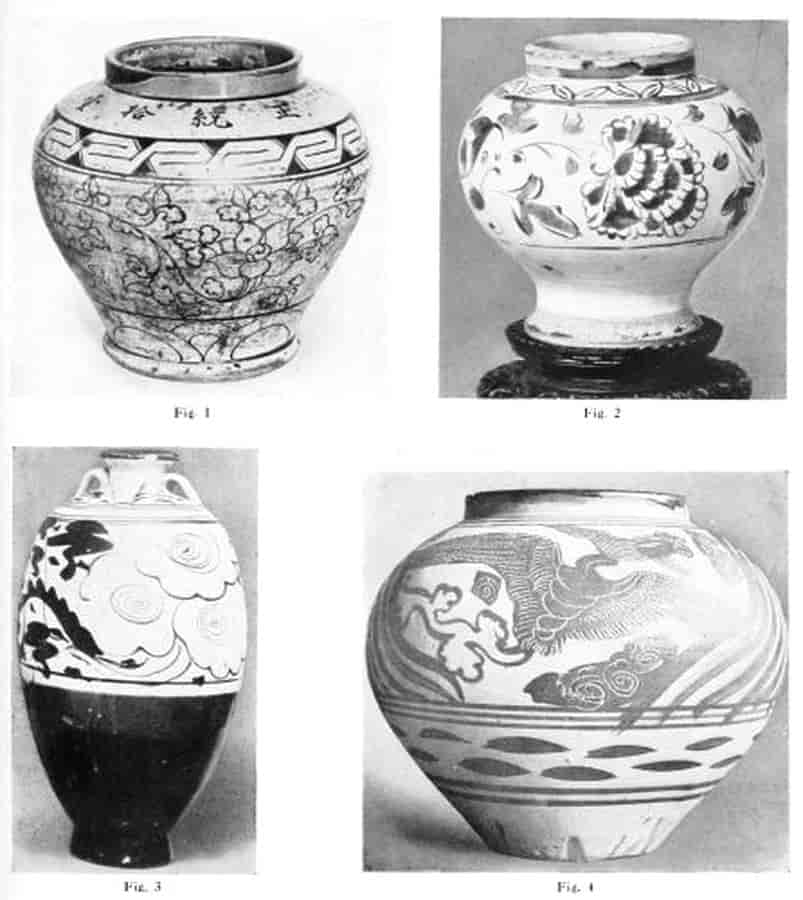
Plate 30.—Four Jars of painted Tz´ŭ Chou Ware.
Fig. 1.—Dated 11th year of Chêng T´ing (1446 A. D.). Height 9 12 inches. Eumorfopoulos Collection.
Fig. 2.—Painted in red and green enamels. (?) Sung dynasty. Height 4 12 inches. Alexander Collection.
Fig. 3.—Lower half black, the upper painted on white ground. Sung dynasty. Height 15 12 inches. Benson Collection.
Fig. 4.—With phœnix design, etched details. Sung dynasty. Height 9 34 inches. Rothenstein Collection.
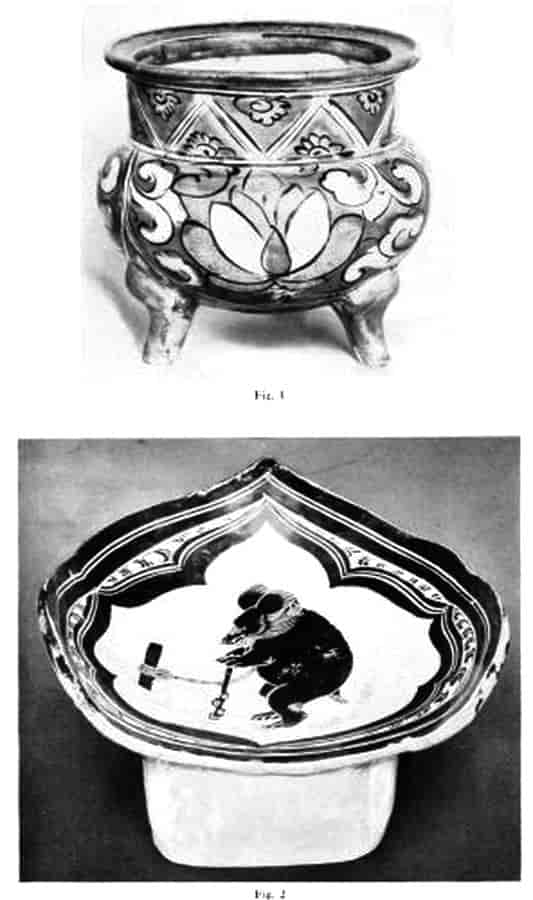
Plate 31.—Tz´ŭ Chou Ware. Eumorfopoulos Collection.
Fig. 1.—Tripod Incense Vase in Persian style with lotus design in pale aubergine, in a turquoise ground. Sixteenth century. Height 6 12 inches.
Fig. 2.—Pillow with creamy white glaze and design of a tethered bear in black. Sung dynasty. Length 12 12 inches.
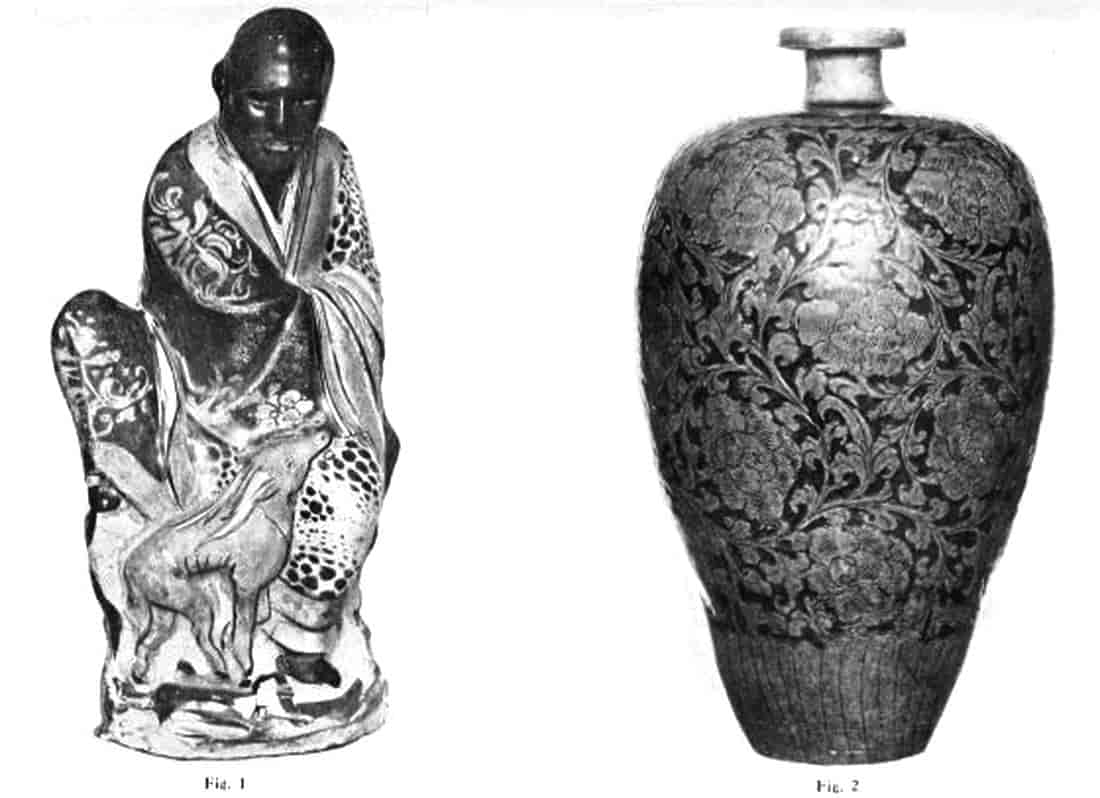
Plate 32.—Tz´ŭ Chou Ware. Eumorfopoulos Collection.
Fig. 1.—Figure of a Lohan with a Deer, creamy white glaze coloured with black slip and painted with green and red enamels. Said to be Sung dynasty. Height 12 12 inches.
Fig. 2.—Vase with graffiato peony scrolls under a green glaze. Sung dynasty. Height 16 inches.
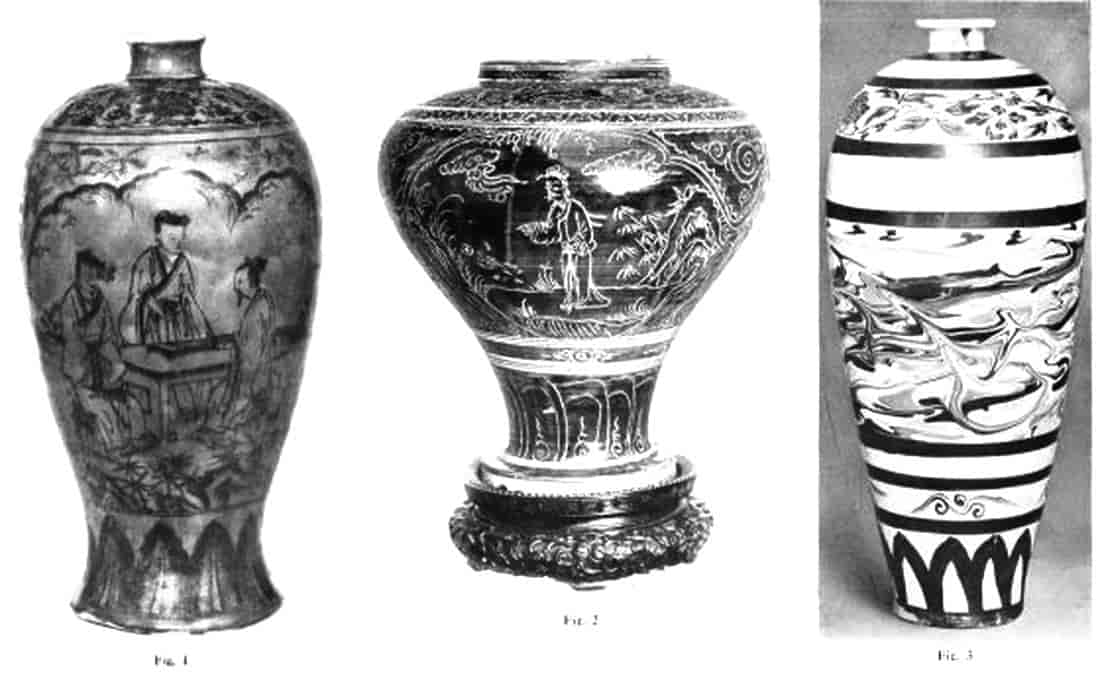
Plate 33.—Tz´ŭ Chou Ware.
Fig. 1.—Vase with panel of figures representing music, painted in black under a blue glaze. Yüan dynasty. Height 11 12 inches. Eumorfopoulos Collection.
Fig. 2.—Vase with incised designs in a dark brown glaze, a sage looking at a skeleton. Yüan dynasty. Height 12 78 inches. Peters Collection.
Fig. 3.—Vase with painting in black and band of marbled slips. Sung dynasty. Height 16 inches. Eumorfopoulos Collection.
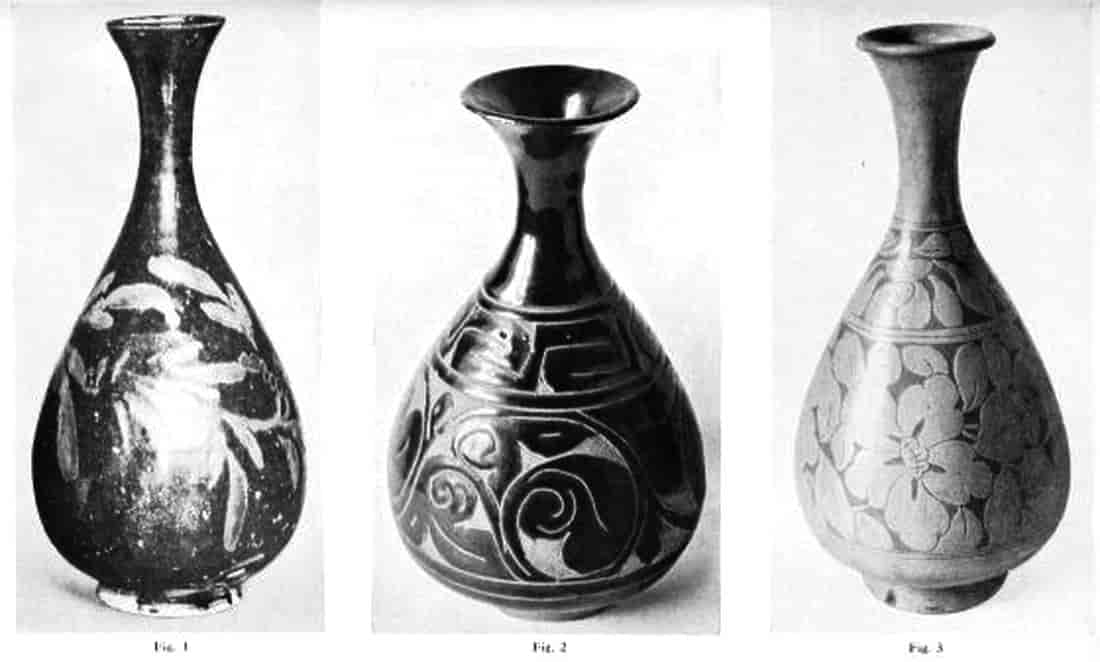
Plate 34.—Tz´ŭ Chou Ware. Eumorfopoulos Collection.
Fig. 1.—Bottle of white porcellanous ware with black glaze and floral design in lustrous brown. Sung dynasty or earlier. (?) Tz´ŭ Chou ware. Height 13 12 inches.
Fig. 2.—Bottle with bands of key pattern and lily scrolls cut away from a black glaze. Sung dynasty. Height 9 14 inches.
Fig. 3.—Bottle with graffiato design in white slip on a mouse–coloured ground, yellowish glaze. Sung dynasty. Height 13 inches.
On the other hand, a greater age has been credited to these pillows in the belief that they are "corpse pillows" recovered from ancient tombs, a theory for which a quotation from a Ming writer in the T´ao shuo is responsible.[242] It is stated that "the pillows of ancient porcelain that are two feet and a half long and six inches broad may be used. Those only one foot long are known as 'corpse pillows,' and are among the things found in ancient tombs; and even when these are of white Ting Chou porcelain of the Sung dynasty, they ought not to be used." Now the pillows made by Chang and others are rarely more than a foot long, and according to this passage should be regarded as corpse pillows. But I cannot help thinking that either the measurements given are incorrect, or that the figures are inaccurately quoted; for apart from the difficulty of making porcelain pillows thirty inches long, such a size would be wholly unnecessary, and is, in fact, more than twice the length of the ordinary Chinese pillow, as we know from existing examples in various materials. At the present day there is no such distinction in size between the two sorts of pillow, and de Groot[243] assures us that the head of the corpse is rested on a small pillow "not differing from those in use among the living."
From the same passage in the T´ao shuo we learn that a curious belief existed in China that porcelain pillows were "efficacious in keeping the eyes clear and preserving the sight, so that even in old age fine writing can be read," and that this belief obtained as early as the Sung dynasty, much use of such pillows having been made in the court of Ning Tsung.
Among the many types of Tz´ŭ Chou ware, old and new, figures and statuettes, usually of deities, played an important part. There are examples of coarse modern figures in the British Museum,[106] but there are others,[244] strong and forcefully modelled, which rank with the best ceramic statuary. These, no doubt, belong to the older and better periods. A good example is shown in Plate 32.
The other large group of Tz´ŭ Chou wares, that with engraved designs (hua, hua), is perhaps the most interesting of the three. One class, the white ware with carved ornament, if it existed, has been merged, like the plain white, in the Ting wares. The vase (Plate 33, Fig. 2) with brown glaze and panelled design exactly corresponding to those of the typical painted wares, but engraved with a pointed instrument through the brown glaze, forms a link between the two main groups.[245] But the more characteristic Tz´ŭ Chou engraved ornament is executed by what is usually known as the graffiato process, the lines of the design being cut through a layer of slip which contrasts in colour with the underlying material. This is illustrated by those vases on which the ornament is etched through a covering of white slip disclosing the greyish body beneath, or, better still, by specimens like Plate 34, Fig. 3, in which the ground of the pattern is freely cut away, exposing considerable areas of the body.[246] The greyish body colour combines with the transparent but creamy glaze to produce a delicate mouse–coloured surface, from which the pattern stands out in ivory white. In other cases a thick lustrous brown black glaze has been boldly carved, leaving the design to contrast with an unglazed grey biscuit (Plate 34, Fig. 3). By varying and combining these different methods, and by changing and counter–changing the slips, a great diversity of effects was readily obtained. It has been frequently remarked that some of the engraved specimens with bands of large foliage scrolls have an astonishing resemblance to Italian graffiato ware of the sixteenth century; and this resemblance is particularly striking when, as sometimes happens, a green glaze is used instead of the ordinary creamy covering. No doubt these carved wares, like their fellows with painted ornament,[107] were made for many centuries, but there is good reason to think that they date back to early times, for fragments both of the graffiato with white slip and mouse–coloured ground, and of the dark brown glaze cut away, were found in Sir Aurel Stein's excavations in Turfan on sites which can hardly have been open after the twelfth century.[247] An important example recently acquired by the British Museum actually bears a Sung date. It is a pillow with carved panels on the sides containing each a large flower and formal foliage; and on the top is a panel with the four characters Chia kuo yung an ("everlasting peace in the family and state") etched in a ground powdered with small circles. This panel is flanked by two incised inscriptions stating that the pillow was made by the Chao family in the fourth year of Hsi Ning (i.e. 1071 A. D.). I have seen one other dated specimen of graffiato Tz´ŭ Chou ware with beautifully carved floral designs and an inscription of the year 1063. Another Tz´ŭ Chou type is seen in a pillow in the Eumorfopoulos Collection which has passages of marbling in black and brown, and small black rosette ornaments inlaid in Corean fashion. The variety of decorations used on this group of wares seems to be inexhaustible.
It has already been hinted that other factories were at work on the same lines as Tz´ŭ Chou, and as we have no means of identifying their peculiarities, it would perhaps be safer to use some such formula as "Tz´ŭ Chou type" in the ascription of doubtful pieces. Po–Shan Hsien, in Shantung, was mentioned in a note on p. 103, and the T´ao lu[248] gives a short account of another factory at Hsü Chou,[249] in Honan, where the tz´ŭ stone (see p. 101) was also used in wares which were both plain white and decorated. This factory was active in the Ming dynasty, and it is stated that its wares were superior to the "recent productions"[250] of Tz´ŭ Chou.
A reference to porcelain figures in Honan in the Sung dynasty may be quoted in this connection. It occurs in the Liang ch´i man chih, an early thirteenth–century work by Fei Kuan, and runs as follows: "In Kung Hsien (in the Honan Fu) there are porcelain (tz´ŭ) images called by the name of Lu Hung–chien. If[108] you buy ten tea vessels you can take one image. Hung–chien was a trader who dealt in tea—unprofitably, for he could not refrain from brewing his stock. Hung–chien formerly was very fond of tea, and it brought him to ruin." Possibly the images of Hung–chien, which were given away with ten tea vessels, were made at Tz´ŭ Chou or Hsü Chou. Figures are still part of the stock–in–trade of the former factory.
CHAPTER IX
CHÜN WARES AND SOME OTHERS
Chün Chou  ware[251]
ware[251]
THE Chün ware is said to have been first made in the early part of the Sung dynasty at Chün Chou or Chün–t´ai, the modern Yü Chou in the K´ai–fêng Fu in Honan. Like the Lung–ch´üan celadon, thanks to its strength and solidity, it has survived in sufficient numbers to give us some idea of the qualities which Chinese writers have described in picturesque terms. That it finds no mention in the Cho kêng lu and the Ko ku yao lun seems to imply that it was not appreciated by the virtuosi of the fourteenth century, owing, no doubt, to the fact that, as hinted in later works, it was chiefly destined for everyday uses and aimed at serviceable qualities rather than "antique elegance." By the end of the Ming dynasty, however, its beautiful glazes had won it a place among the celebrated Sung wares, although even at this time certain varieties only were considered estimable. The Ch´ing pi ts´ang, for instance, which appears to rank the Chün ware above that of Lung–ch´üan, gives the following criticism: "The Chün Chou ware, which is red like rouge, is highly prized; that which is ch´ing like onion blue (ts´ung ts´ui), and that which is purplish brown (tzŭ) like ink, are esteemed second; single–coloured pieces, which have the numerals one, two, etc., as marks on the bottom, are choice; the specimens of this ware with mixed colours (tsa sê) are not worth collecting." It was not long, however, before even the despised "mixed colours" were not only appreciated by collectors, but studiously imitated by the Ching–tê Chên potters.
The body of the wares, which are now classed as "Chün type," varies considerably in quality and texture. The choicest examples in Western collections, usually deep flower pots or shallow bulb bowls with lovely glazes of dove grey, lavender, crushed strawberry,[110] dappled purple and crimson, and other tints, are made of a clay which, though dark–coloured on the exterior, shows considerable refinement and closeness of texture within. It is, in fact, a porcellanous ware of whitish grey tone. It is noticed that these pieces are almost always marked with incised Chinese numerals, and there are critics who would confine the Chün wares to this group alone. But it is clear from a passage in the Po wu yao lan[252] that there were other types in which the body was of "yellow sandy earthenware," coarse and thick, and without refinement, with all the characteristics, in fact, of the ware which these same critics habitually relegate to the category of Yüan tz´ŭ, or ware of the Yüan dynasty. But we shall return to this question later. Modern Chinese collectors, we are told,[253] in recognition of these distinctions, classify Chün wares in two groups, tz´ŭ t´ai (porcelain body) and sha t´ai (sandy, or coarse–grained, body).
The Chün glazes are of the thick, opalescent kind which flows sluggishly and often stops short of the base in a thick, wavy roll or in large drops. On the upper edges of the ware they are thin and more or less transparent and colourless, but in the lower parts and the hollows in which the glaze collects in thick masses the depth and play of the colour are wonderful. These irregularities are specially noticeable on the coarse bodies, but even on the more refined specimens where the glaze has a smoother flow and more even distribution, the colour is never quite continuous or unbroken. In the opalescent depths of the glaze, bubbles, streaks, hair–lines, and often decided dappling are observed, and a scarcely perceptible crackle is usually present.[254] Some of these markings which variegate the surface of the Chün wares have been noticed by Chinese writers as "hare's fur marking" and "flames of blue."[255] Others, which appear to be irregular partings in the colour of the glaze, have been named ch´iu ying wên or "earthworm marks." These last rarely appear except on the finer type of Chün wares, and, like the "tear stains" on the Ting porcelains, they are regarded as signs of authenticity.
PLATE 35
Flower pot of Chün Chou ware of the Sung Dynasty.
Grey porcellanous body; olive brown glaze under the base and the numeral shih (ten) incised. Height (without the wooden stand) 5 78 inches.
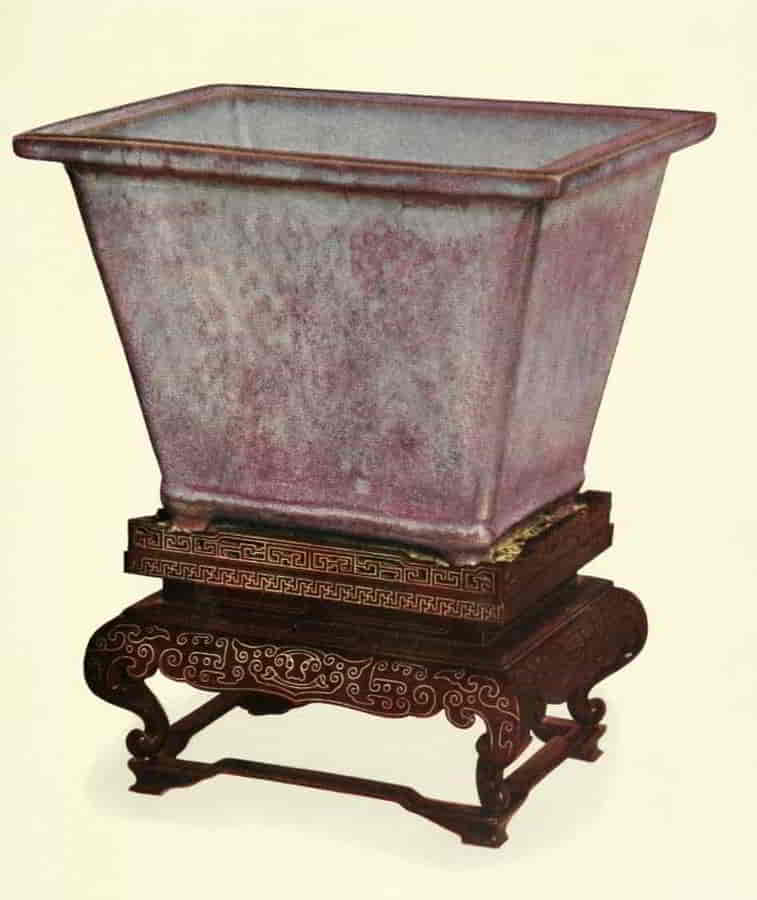
Eumorfopoulos Collection.
Though the beautiful Chün wares of the tz´ŭ t´ai group will always be rare and costly, Western collectors have been fortunate in securing a fair number of specimens, and a wonderful series of them was brought together in March, 1914, in the exhibition held by the Japan Society of New York. The forms of the flower pots vary considerably. Some have globular body with high spreading neck and wide mouth; others are bell–shaped like a deep cup; others are deep bowls with sides shaped in six or eight lobes like the petals of a flower; others are of quatrefoil form; and others of oblong rectangular shape with straight sides expanding towards the mouth. The saucers in which they stood are shallow bowls corresponding in form to the pots, but supported by three or four feet which are usually shaped like the conventional cloud scroll or ju–i head. They are otherwise without ornament, except in the case of the plain rounded saucers, which have two bands of raised studs or bosses, borrowed, no doubt, from a bronze vessel. These flower pots and saucers are almost invariably incised with a numeral under the base, and the fact that when the pots and saucers fit properly the numerals on each are found to tally seems to indicate they are, as suggested below, size numbers. But there is no doubt that[114] the saucers or stands were often used separately as bulb bowls, like the vessels of similar shape which are found in celadon and other wares. Vases of the fine Chün ware are occasionally seen. There is a choice example in the Pierpont Morgan Collection, a small ovoid vase with flat base; and in the same collection is a low beaker–shaped vase with flaring neck and globular body strengthened with four square ribs in imitation of a bronze.[256] No numbers have appeared so far on any of these vases, nor, as far as I am aware, on any Sung Chün wares except the flower pots and saucers. I have, however, seen dishes on which a number has been subsequently cut, and numbers occur on later copies of the Chün types described below.
The numerals engraved under the base of the flower pots, saucers, and bulb bowls in the finer Chün wares range from 1–10. Their significance has given rise to some debate, but the most reasonable theory seems to be that they indicate the sizes of the different forms, No. 1 being the largest, though an extra large bulb bowl[257] in the Eumorfopoulos Collection has the additional mark  ta (great). This is the view which, I believe, is usually accepted in China, and Mr. Eumorfopoulos, who has an exceptional series of these wares, has applied the test to all he has seen, and has found the size theory to hold good in all but a few cases, for which an explanation may yet be found.[258] Another suggestion, supported by some American collectors of note, such as Mr. Freer and Mr. Peters, is that the numbers refer to the Imperial kilns, and that the pieces so marked are Imperial wares. Whether the former theory will continue to stand the test of application to every fresh specimen remains to be seen. With regard to the latter, I shall give reasons presently for doubting that any special Imperial patronage was extended to this kind of ware; and whatever truth there may be in this explanation of the numbers, it is highly improbable that any serious evidence can ever be produced to sustain it.
ta (great). This is the view which, I believe, is usually accepted in China, and Mr. Eumorfopoulos, who has an exceptional series of these wares, has applied the test to all he has seen, and has found the size theory to hold good in all but a few cases, for which an explanation may yet be found.[258] Another suggestion, supported by some American collectors of note, such as Mr. Freer and Mr. Peters, is that the numbers refer to the Imperial kilns, and that the pieces so marked are Imperial wares. Whether the former theory will continue to stand the test of application to every fresh specimen remains to be seen. With regard to the latter, I shall give reasons presently for doubting that any special Imperial patronage was extended to this kind of ware; and whatever truth there may be in this explanation of the numbers, it is highly improbable that any serious evidence can ever be produced to sustain it.
PLATE 36
Chün Wares
Fig. 1.—Flower pot of six–foil form. Chün Chou ware of the Sung dynasty. The base is glazed with olive brown and incised with the numeral san (three). Height 7 34 inches. Alexander Collection.
Fig. 2.—Bowl of Chün type, with close–grained porcellanous body of yellowish colour. Sung dynasty. Diameter 5 34 inches. Eumorfopoulos Collection.
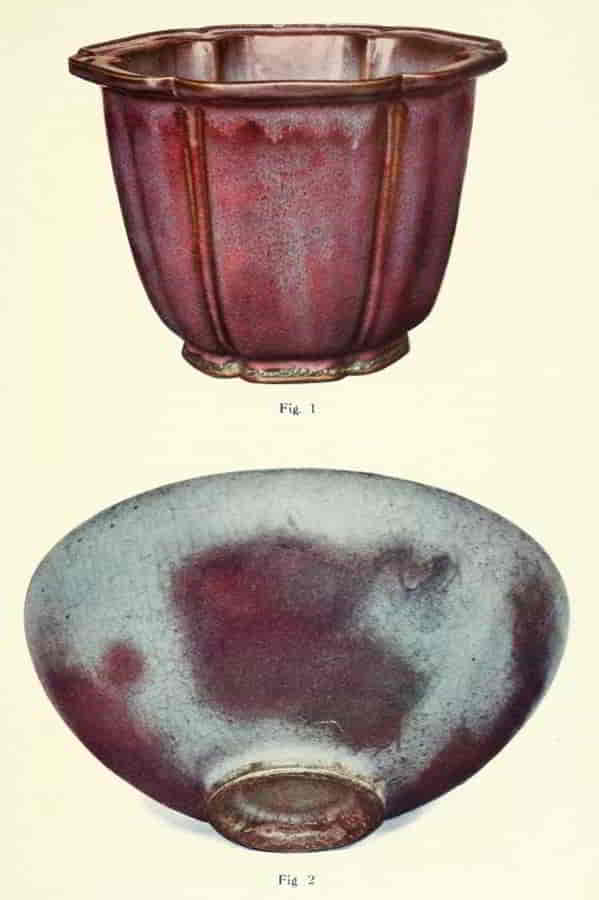
It would be possible to construct a formidable list of the colours which appear in the Chün glazes, though many of the accidental effects would be very difficult to describe. On the edge and salient parts where the glaze is thin the colour is usually a transparent olive green which passes with the thickening of the glaze into a frothy grey shot with fine purple streaks. The grey sometimes remains thick and opaque, covering large areas, and it is liable to become frosted over with a dull film of crab–shell green. It is in this frosting and in the opaque curded grey that the V–shaped and serpentine partings known as "earthworm marks" most frequently occur; and sometimes a steel blue colour emerges in these partings and in small spots in the grey. For under the grey there seems to be always blue and red struggling upwards towards the surface. Hence the blue and lavender tinge which is so constant, the t´ien lan of the Chinese. But it is the red which almost always triumphs, emerging in fine streaks of purple, crimson or coral, like the colour lines in shot silk, or in strong flecks and dappling, completely overpowering the grey, which only remains on sufferance in a few fleecy clouds. The fine lines of colour are usually associated with a smooth silken surface to which a faint iridescence gives additional lustre; whereas the strongly dappled and mottled glaze is full of bubbles and pinholes (sometimes called "ant tracks" by the Chinese) which give the surface the seeded appearance of a strawberry. The red dappling is usually opaque and tending towards crimson or rouge red. It will be seen that the red varies in quantity from a mere tinge or flush to the intensity almost of a monochrome, and in tone from a pale or deep lavender to aubergine, plum purple, rose crimson, and rouge red. Making allowance for the capricious nature of Chinese colour words, these tints will be found to correspond with several of those indicated in the Yung Chêng list quoted on p. 119. On rare examples the grey and red colours are in abeyance, and the dominant tint is the transparent olive green, which is usually confined to the edges. This and the crab–shell green mentioned above supply the green shades which the Chinese writers include among the Chün colours.
But none of these glazes can with strict accuracy be described as monochromes "of uniformly pure colour" which the Po wu yao lan seems to have regarded as indispensable in the first–class Chün ware. In fact, it is difficult to conceive the possibility of a Chün glaze of perfectly uniform tint, without any trace of the perpetual war waged in the kiln between the red, grey, and blue elements. The nearest approach to a single colour is seen in some[118] of the grey glazes, but here, too, the colour is only relatively pure; and I am convinced that the expression used by the Po wu yao lan is exaggerated, and the meaning is that the nearer the Chün colours approach to uniformity the more they were prized. It is true that several examples depicted in Hsiang's Album are monochrome purple, but I have no more confidence in the colouring of these illustrations than in the carved decoration which is indicated under their glaze, a phenomenon unrecorded in any other Chinese work, unexampled in any known specimen of the ware, and unlikely in view of the nature and the thickness of the Chün glaze itself.
It is clear, however, that an exaggerated mottling of the glaze and a confusion of many colours was viewed with disfavour by the old Chinese connoisseurs. These effects were explained in the Po wu yao lan as due to insufficient firing. Regarded in this light they were viewed with contempt by the earlier Chinese writers and labelled with mocking names, such as lo kan ma fei (mule's liver and horse's lung), pig's liver, and the like. In reality, they were the forerunners of the many delightful flambé glazes which the eighteenth–century potters were able to produce at will when they had learnt that, like all the Chün colours except the brown glaze on the base, they could be obtained from oxide of copper under definite firing conditions. How far the old Chün effects were due to opalescence[259] it is impossible to say, but we know that all of them can be obtained, whether turquoise, green, crimson, or lavender grey, by that "Protean medium," oxide of copper, according as it is exposed in the firing to an oxidising or reducing atmosphere, conditions which could be regulated by the introduction of air on the one hand, or wood smoke on the other, at the right moment into the kiln.
It should be added that the finer Chün wares as seen in the flower pots and stands have an olive or yellowish brown glaze over the base, which in rare instances is overrun by frothy grey or lavender. Another constant feature of these pieces is a ring of small scars or "spur marks" on the base.
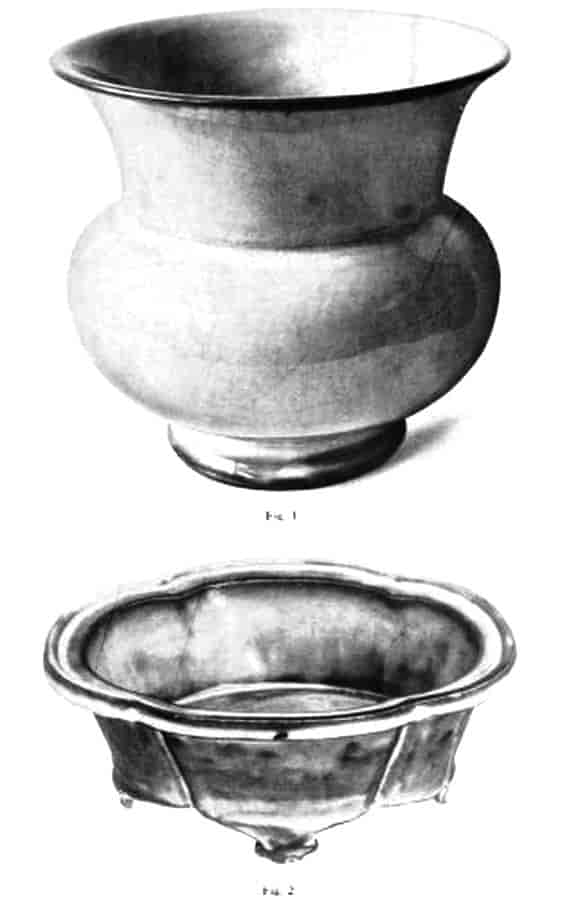
Plate 37.—Chün Chou Ware with porcellanous body (tz´ŭ t´ai). Sung dynasty.
Fig. 1.—Flower Pot, with lavender grey glaze. Numeral mark, ssŭ (four). Diameter 8 34 inches. Eumorfopoulos Collection.
Fig. 2.—Bulb Bowl, of quatrefoil form, pale olive glaze clouded with opaque grey. Numeral mark, i (one). Length 10 inches. Freer Collection.
The list of porcelains made at the Imperial factories about 1730[260] includes a series of imitations of Chün glazes from specimens sent from the palace collections, which serve at once to show the variety of Chün colours and the extent to which they were copied. The actual colours described are:
(1) Rose purple (mei kuei tzŭ  ).
).
(2) Cherry apple red (hai t´ang hung  ).
).
(3) Purple of the aubergine flower (ch´ieh hua tzŭ  ).
).
(4) Plum bloom (mei tzŭ ch´ing  ).
).
(5) Donkey's liver and horse's lung (lü kan ma fei  ), with the addition of four kinds obtained from other sources.[261]
), with the addition of four kinds obtained from other sources.[261]
(6) Deep purple (shên tzŭ  ).
).
(7) "Millet colour" (mi sê  ).
).
(8) Sky blue (t´ien lan  ).
).
(9) Furnace transmutation or flambé (yao pien  ).
).
The potters of the Yung Chêng period (1723–35) succeeded wonderfully in their work of imitation, and existing examples bear witness to the beautiful colour effects which they obtained. The body of the ware, however, was, as a rule, a fine white porcelain,[262] which had to be carefully concealed by the brown glaze on the base. Many of the Yung Chêng specimens are marked with the seal mark of the period, and occasional instances occur in which this mark has been ground off in order to pass the piece as old. I have such a specimen, which was actually bought in the trade for Sung. It is a small dish, with beautiful turquoise green glaze in the centre and a flambé red on the sides. The place where the mark has been ground away when washed clean showed a fine white porcelain body. It is stated in the T´ao lu that the potters at Ching–tê Chên began to imitate the Chün wares towards the end of the Sung dynasty. No evidence is given to support the assertion, which may be merely a local tradition; but one certainly sees occasional specimens with a porcelain body masked by a dark brown clay dressing under the base, the glazes of which obviously imitate the Chün. There are, for instance, saucers and bowls of this kind with purple glaze finely shot with grey on the exterior and a lavender grey inside which appear to be older than[120] the Yung Chêng period, though their shape precludes a greater age than the Ming dynasty.
There are, however, many other imitations of Chün ware in which the body is not of tell–tale white porcelain. The Po wu yao lan, for instance, written at the end of the Ming dynasty, states that "in the present day among the recent wares all this type of ware (viz. the Chün type) has the sandy clay of Yi–hsing[263] for its body; the glaze is very similar to the old, and there are beautiful specimens, but they do not wear well." Yi–hsing is the place where the red stoneware tea pots, often called Chinese "buccaro," were made, and we know that a Yi–hsing potter, named Ou, was famous at the end of the Ming dynasty for his imitations of Ko, Kuan, and Chün glazes.[264] A bowl in the British Museum seems to answer the description of Ou's ware. It has a hard red stoneware body, and a thick undulating glaze of pale lavender blue colour, the comparative softness of which is attested by the well–worn surface of the interior.
The "Yung Chêng list" includes yet another type based upon Chün ware. It is called "Chün glaze of the muffle kiln," clearly a low–fired enamel rather than a glaze, whose colour is between the Kuangtung ware and the added[265] glaze of Yi–hsing, though in surface–markings, undulations and transmutation tints it surpasses them. This appears to be the "robin's egg" type of glaze,[266] to use the American collector's phrase, a thick, opaque enamel of pale greenish blue tint flecked with ruby red (see Plate 128).
The manufacture of glazes of the Chün type has continued at Yi–hsing since the days of Ou, and what is called Yi–hsing Chün is still manufactured in considerable quantity, the streaky lavender glazes being of no little merit. When applied to incense burners and vessels of archaic form, they are capable of being passed off as old, though the initiated will recognise them by their want of depth and transparency and by the peculiar satiny lustre of their surface.
PLATE 38
Chün Wares
Fig. 1.—Bowl of eight–foil shape, with lobed sides, of Chün type. Sung dynasty. Close–grained porcellanous ware of yellowish colour. Height 1 78 inches.
Fig. 2.—Pomegranate–shaped water pot of "Soft Chün" ware. Probably Sung dynasty. Height 3 12 inches. Alexander Collection.
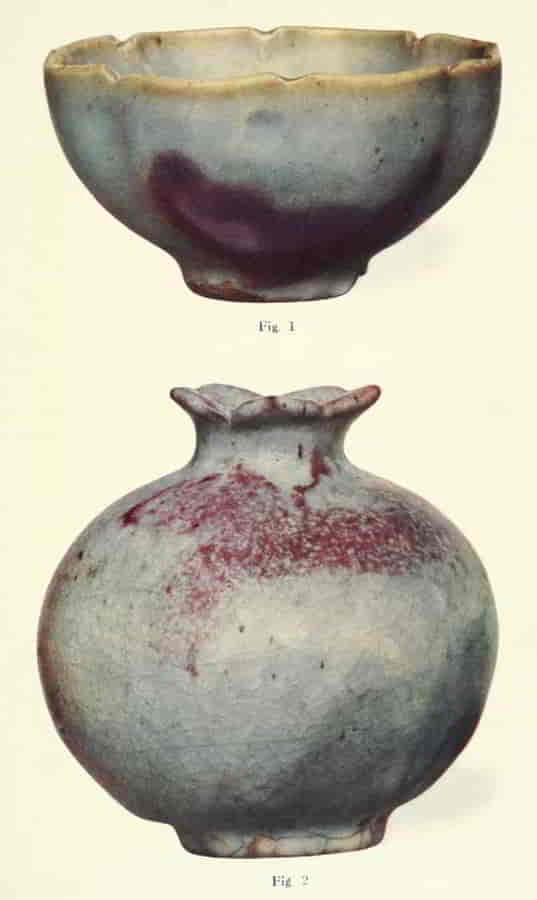
Another ware which has a superficial resemblance to Chün yao has been made for a long period at the Kuangtung factories,[267] if it does not actually go back to Sung times. A typical specimen, shown in Plate 51, is a vase of baluster form with wide shoulders strengthened by a collar with foliate edge, and small neck and mouth, ornamented with a handsome lotus scroll in relief. The body is a buff stoneware, and the glaze is thick, opaque, and closely crackled, and of pale lavender grey warming into purple.
Glazes of this kind have been made at several potteries in Japan e.g. Hagi, Akahada, and Seto.[268] Besides such specimens as this, there are many of the streaky, mottled Canton stonewares which are remotely analogous to the variegated Chün wares. The glazes of this type are more fluescent than those described in the preceding paragraph and have greater transparency, and the intention of their makers to imitate Chün types is shown by incised numerals which are occasionally added under the base. They are known in China as Fat–shan Chün, from the locality in which they are made, and though some examples may go back to Ming times, the best may, as a rule, be ascribed to the eighteenth century and the indifferent specimens to the present day.
From this digression on Chün imitations to which the mention of Yi–hsing led us, we must return to the original wares. It has been said that Chinese connoisseurs recognise two groups of Chün ware, the tz´ŭ t´ai and the sha t´ai, and there is no doubt that the contrast between the body material of the two is very marked. In explanation of this the Chinese to–day allege[269] that the flower pots and stands were made of a tribute clay sent annually from the Ching–tê Chên district to the "Imperial kilns" at Chün Chou, and that the coarser articles were made of native clays. The story has the air of an ex post facto explanation, and it is open to many grave objections. In the first place it is nowhere mentioned in Chinese literature, and in the second place the Chün Chou kilns, so far from having been described as "Imperial" in the Sung dynasty, are entirely ignored by the earlier writers, and even in the late Ming works, where they are first mentioned, the Chün wares are reckoned as of secondary importance. Thirdly, there does not seem to have been any need to import kaolin, for Chün Chou was in[124] one of the kaolin producing districts of China.[270] There are, moreover, many specimens of the Chün type which hold an intermediate position between the finer flower pots and the coarse "Yüan tz´ŭ" wares, and these have a decidedly porcellanous body, though inclined to be yellowish at the base rim. Some of these have glazes almost as smooth and even as the flower pots, and of a beautiful lavender grey colour with patches or large areas of aubergine or amethystine purple, which in rare cases covers the entire exterior of a bowl. In their finer types they are scarcely distinguishable from the specimens which we have tentatively classed as Kuan on p. 65, and in their coarser kinds they seem to belong to the so–called "Yüan tz´ŭ" which are discussed at the end of this chapter.
Meanwhile, we must consider a very distinctive group to which the term sha t´ai, in its sense of "sandy body," applies with particular exactitude. In the catalogue of the New York exhibition of March, 1914, I ventured to differentiate this type by the name of "soft Chün," which its general appearance seems to justify. It is well illustrated in Plates 38 and 39. The body is buff and varies in texture from stoneware to a comparatively soft earthenware not far removed in colour from that of delft or maiolica, though, like so many Chinese bodies, it has a tendency to assume a darker red brown tint where exposed at the foot rim. The glaze is unctuous and thick, but not opaque, often, indeed, showing considerable flow and transparency: it is opalescent, and at times almost crystalline, and endued with much play of colour. It varies from a light turquoise blue of great beauty to lavender and occasionally to a strong blue tint, and, as a rule, it is broken by one or more passages of crimson red or dull aubergine purple, sometimes in a single well–defined patch, sometimes in a few flecks or streaks, and sometimes in large irregular areas. This glaze usually covers the entire exterior and appears again under the base, leaving practically no body exposed except at the actual foot rim. It has been attributed to various factories. The pure turquoise specimens have even been called Ch´ai, and a little piece of this kind was figured by Cosmo Monkhouse[271] as Kuan ware. On the other hand, I am told[272] that it is widely known in China as Ma chün,[273] and is usually thought to be of the Ming dynasty, but no reason is assigned for either the name or the date, and both seem to be based on traders' gossip to which no special importance need be attached. A fine vase of this kind in the British Museum has been much admired by Chinese connoisseurs, and they have, as a rule, pronounced it to be Sung. The important specimen (Plate 39) in the FitzWilliam Museum, Cambridge, was obtained from a tomb near Nanking,[274] a circumstance which is in favour of an early origin. In other respects this class of ware seems to answer to the aubergine and "sky blue" Chün types described by Chinese writers, and I regard it as one of the Sung varieties of Chün Chou ware, with "yellow, sandy earthenware" body of which the Po wu yao lan makes mention.[275]
PLATE 39
Two examples of "Soft Chün" ware.
Fig. 1.—Vase of buff ware, burnt red at the foot rim, with thick, almost crystalline glaze. Found in a tomb near Nanking and given in 1896 to the FitzWilliam Museum, Cambridge. Probably Sung dynasty. Height 8 18 inches. Alexander Collection.
Fig. 2.—Vase of yellowish ware with thick opalescent glaze. Yüan dynasty. Height 13 38 inches. Alexander Collection.
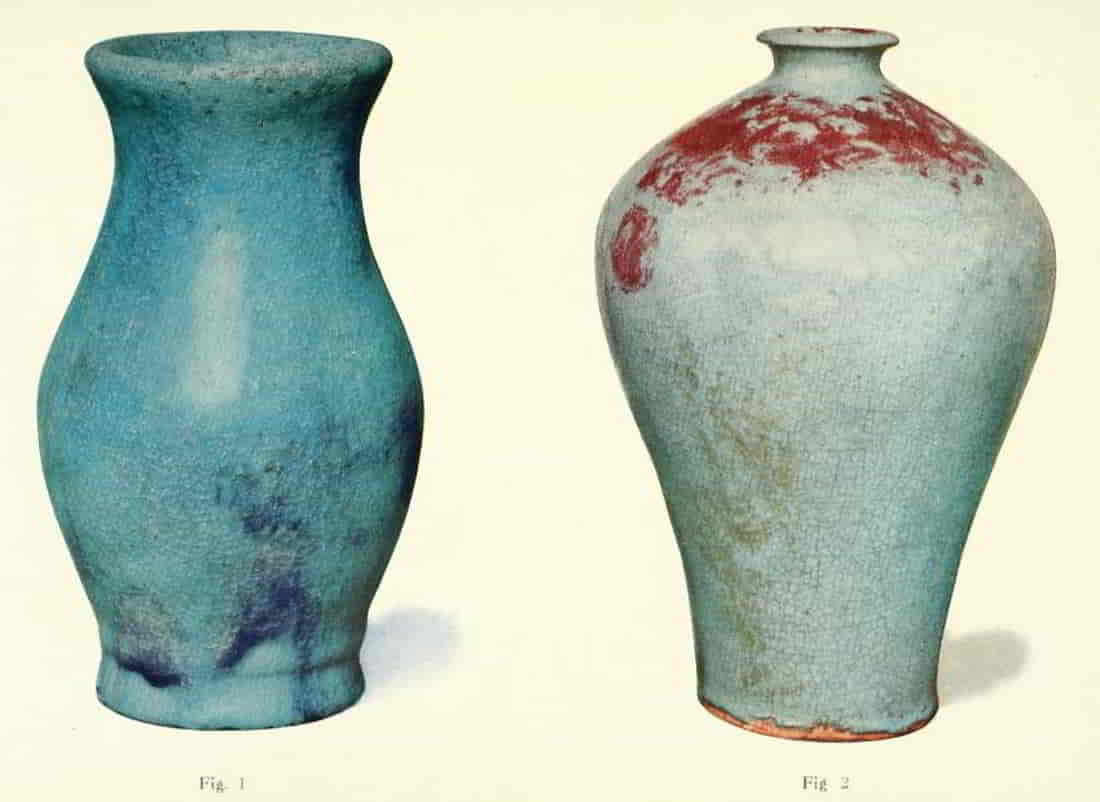
That it continued to be made after the Sung period is practically certain, and there are specimens which one would unhesitatingly regard as Ming or Yüan from their form. But, on the other hand, the prevailing shapes are of the Sung kind, and we have very little to guide us in dealing with the various Chün types except the form and the quality of the ware. The "soft Chün" was very closely imitated at Yi–hsing on a yellowish body which resembles the original in colour, but is generally harder, with a thick unctuous glaze of somewhat crystalline texture and a turquoise lavender colour, with rather thin and feeble patches of dull crimson, which lack the spontaneous appearance of the originals. These Yi–hsing copies are often marked with an incised numeral like the Canton Chün.
With regard to the duration of the Chün Chou factories, the standard Chinese works on ceramics are curiously silent. They take no account of the ware after the Sung period, and leave us to infer that it either ceased to be made or ceased to be worthy of mention after that time. In two places only have I found any hint of its survival in later times. One is an incidental mention of Sung, Yuan, and Ming Chün wares in a modern work,[276] and the other is in the pottery (not the porcelain) section in the great K´ang Hsi Encyclopædia.[277] The latter passage is taken from the administrative records of the Ming dynasty, and contains two references[128] to large supplies of vases (p´ing and t´an) and wine jars obtained from Chün Chou and Tz´ŭ Chou in the Hsüan Tê period (1426–1436) and in the year 1553 of the Chia Ching period. We further learn that in 1563 an Imperial edict abolished both the tax which had previously been levied on the Chün Chou wares and the subsidy which had to a great extent counterbalanced the tax. These documents prove beyond doubt that potteries of considerable size existed at Chün Chou in the Ming dynasty, though their mention in this particular context seems to imply that the ware was no longer ranked among the porcelains, and had apparently ceased to be regarded as an artistic production.
From this time onwards to the present day the ceramic history of this district is a blank, and we are unable to say whether the modern Yü Chou pottery is a continuation or only a revival of the ancient art of the place. A specimen of this modern ware in the Field Museum, Chicago, has close affinities with the "soft Chün." Its base shows a buff stoneware body washed over with dark brown clay, and the glaze is somewhat opalescent though thinner than the old glaze, and its colour is a light blue of a tint more grey than turquoise. Quantities of this modern Yü Chou ware are to be found in Peking, and occasionally it is passed off as old Chün, but no one with experience of the originals would be deceived by it.
Finally, there is the important group of wares obviously belonging to the Chün family but commonly described as Yüan tz´ŭ or ware of the Yüan dynasty (1280–1367), although no sanction for this name is found in the older Chinese books. The ware, however, is fairly common in the form of bowls, shallow dishes, and, more rarely, vases and incense burners. The bowls which are the most familiar examples are usually of conical form, with slightly contracted mouth and small foot, coated with thick fluescent glazes, which form in deep pools at the bottom within, and end outside in thick drops or a billowy line some distance above the base, leaving a liberal amount of the body material exposed to view. The body is of the sha t´ai class and usually of coarse grain, varying from a dark iron grey to buff stoneware and soft brick red earthenware, though, as already noted, there are finer specimens which link it with the tz´ŭ t´ai group. It is this roughness of substance which has caused the ware to be relatively little esteemed in China, for the glaze is often of singular beauty. The varieties in colour are innumerable and clearly due to the opalescence of the thick, bubbly glaze, combined with the ever–changing effects of copper oxide on a highly fired ware. Lavender grey, dove grey, brown, and grey green are conspicuous, but as the thickness of the glaze varies with its downward flow, so the colour changes in tone and intensity from a thin, almost colourless skin on the upper edges to deep pools of mingled tints where the glaze has collected in thick masses. It is usually streaky and shot with fine lines of colour, but sometimes there are large areas of misty grey or greenish brown tones too subtle for description. A section of these glazes will generally disclose the presence of red, and this red often bursts out on the surface in patches which contrast vividly with the surrounding tones. If the patches are large they will be found to shade off into green in the centre or at the edges. It should be added that crackle is almost always present, though it varies much in intensity and does not seem to have been intentional.
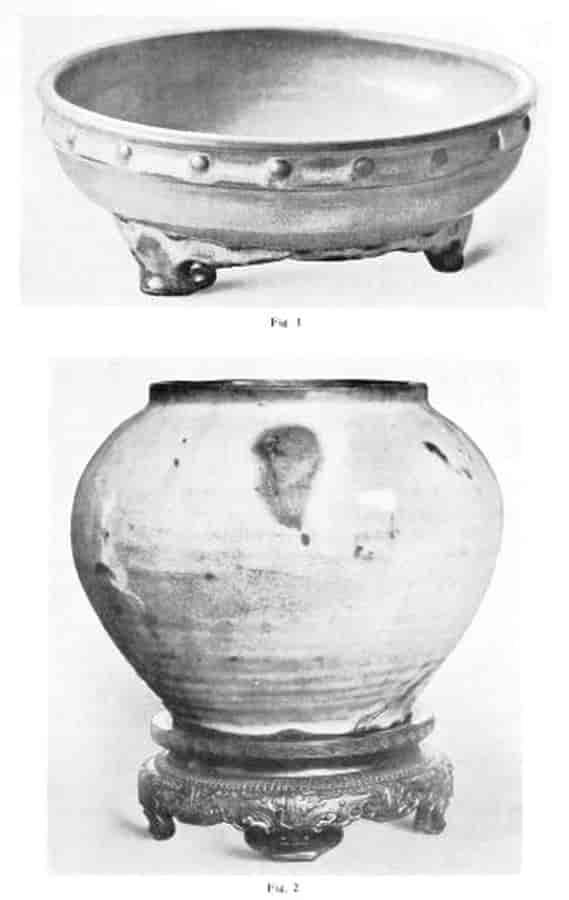
Plate 40.—Chün Chou Ware.
Fig. 1.—Bulb Bowl, porcellanous ware with lavender grey glaze passing into mottled red outside. Numeral mark, i (one). Sung dynasty. Diameter 9 14 inches. Eumorfopoulos Collection.
Fig. 2.—Vase of dense reddish ware, opalescent glaze of pale misty lavender with passages of olive and three symmetrical splashes of purple with green centres. Sung or Yuan dynasty. Height 10 38 inches. Peters Collection.
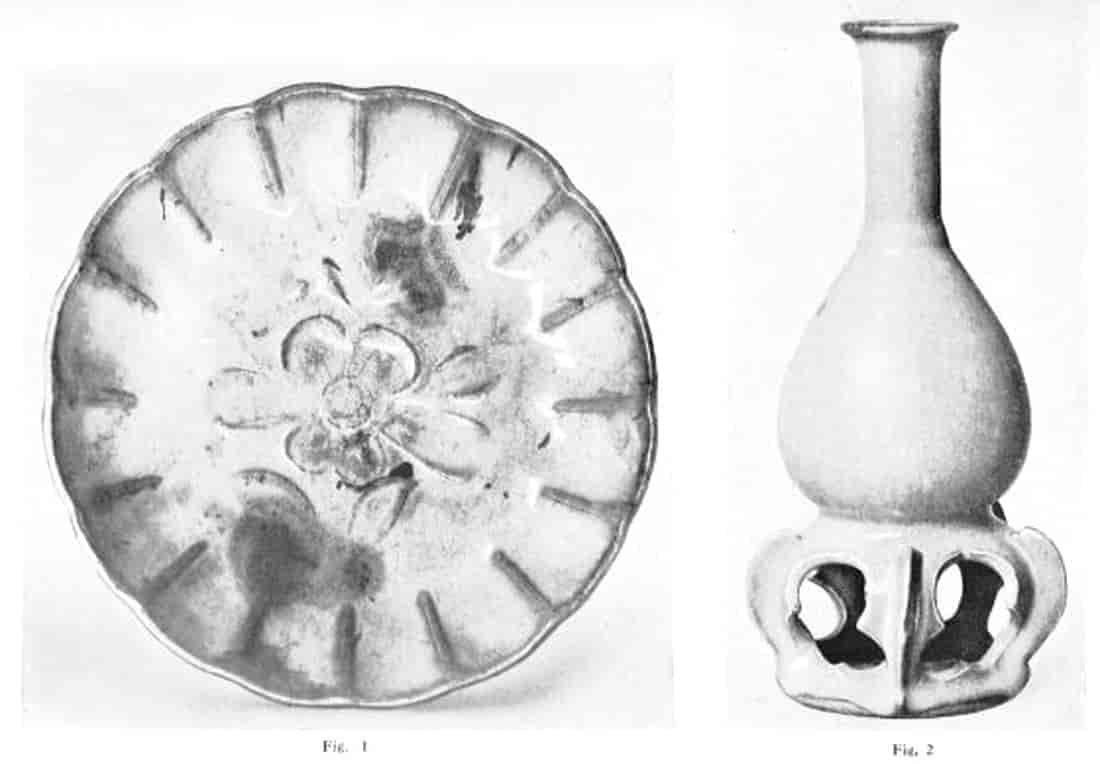
Plate 41.—Chün Chou Ware.
Fig. 1.—Dish with peach spray in relief. Variegated lavender grey glaze with purplish brown spots and amethyst patches, frosted in places with dull green. Sung dynasty. Diameter 8 12 inches. Freer Collection.
Fig. 2.—Vase and Stand, smooth lavender grey glaze. Sung or Yüan dynasty. Height 7 34 inches. Alexander Collection.
Decoration of any kind is unusual on these wares except on the large tripod incense burners, which often have slight applied reliefs in the form of animals, dragons, or peony sprays. Mr. Freer's dish (Plate 41, Fig. 1) with the raised floral spray is quite exceptional.
Whatever the verdict may be on the technical qualities of these rugged pieces as compared with more finely finished porcelain, there can be no doubt of the artistic merit of the subtle glaze colours, and I have seen people whose undoubted taste in other forms of art had not previously been directed to things ceramic, display a sudden and unexpected enthusiasm over the rough Yüan bowls. The peculiar shape of these bowls—which, without their foot take the form of a half coco–nut—has raised the question whether it can be in any way connected with the Polynesian khava bowls. The latter are actually made of coco–nut, and, curiously enough, their interior after much use acquires a vivid patina, whose colour recalls some of the Yüan tz´ŭ glazes. The resemblance, however, remarkable as it is, can only be accidental, for it is practically certain that the tints of these ceramic glazes were quite unforeseen. Long use has usually given the surface of the Yüan tz´ŭ a smooth, worn feeling, but in its first freshness the glaze had a very high and brilliant lustre. This is shown by a few pieces which have lately been sent from China, where they were excavated evidently on the site of the old factory, and still remain in their[130] seggars or fireclay cases to which they became attached by some accident in the kiln. These and other spoilt pieces or wasters would be of immense interest if only the circumstance of their finding had been faithfully recorded. Unfortunately, however, they passed through many hands before reaching Europe, and we have only hearsay to support the statement that they were found in the neighbourhood of Honan Fu. The locality is a likely enough spot and not remote from Chün Chou, but we must consider that the real origin of the Yüan tz´ŭ has yet to be settled, and we must still remain in doubt whether the ware is a coarse variety of Sung Chün Chou ware, a continuation of that manufacture in the Yüan dynasty, or the production of a different factory. Judging from the character of the glazes, I am inclined to accept the first two alternatives, which are not mutually exclusive, for while many of the specimens have the appearance of Sung wares, there is every reason to suppose that the manufacture continued through the Yüan period. The formula, "Sung or Yüan ware of Chün type," adopted in the catalogue of the exhibition at the Burlington Fine Arts Club in 1910, is a discreet compromise which may well be retained till further evidence from China is forthcoming.
The evidence of Sir Aurel Stein's excavations in the regions of Turfan, imperfect as it is, points to the existence of this kind of ware at least as early as the Sung dynasty. Fragments with the typical glaze of the so–called Yüan–tz´ŭ were found, for instance, on a site which was thought to have been closed in the Sung dynasty, and again at Vash–shahri, which was "believed to have been occupied down to the eleventh or twelfth century." Making ample allowance for error in calculating the dates of these buried cities, we may still fairly consider that some of these finds come within the limits of the Sung dynasty.
Chien  yao
yao
This ware, which has already been mentioned in several passages, originated at Chien–an, but the factory was subsequently removed to the neighbouring Chien–yang. Both places are in the Chien–ning Fu, in the province of Fukien, and the term Chien yao derives from the character chien, which occurs in all these place names. The beginning of the manufacture is unknown, but it certainly dates back to the early Sung period, being mentioned[131] in a tenth–century work,[278] and the potteries were still flourishing at the commencement of the Yüan dynasty.[279] A characteristic specimen figured in Plate 42 is a tea bowl with soft, dark brown earthenware body and thick, lustrous, purplish black glaze, mottled and streaked with golden brown. The brown forms a solid band at the mouth and tails off into streaks and drops on the sides, finally disappearing in a thick mass of black. The spots and streaks of brown suggested to Chinese writers the markings on a partridge's breast or on hare's fur, and the bowls are usually known as "hare's fur cups"[280] or "partridge cups." The dark colour of the glaze made them specially suitable for the tea–testing competitions which were in fashion in the Sung period, the object of the contest being to see whose tea would stand the largest number of waterings, and it was found that the least trace of the tea was visible against the black glaze of the Chien bowls. The testimony of an eleventh–century writer[281] on this point is of interest. "The tea," he says, "is light in colour and suits the black cups. Those made at Chien–an are purplish black (kan hei) with markings like hare's fur. Their material, being somewhat thick, takes long to heat, and when hot does not quickly cool, which makes them specially serviceable. No cups from any other place can equal them. Green (ch´ing) and white cups are not used in the tea–testing parties."
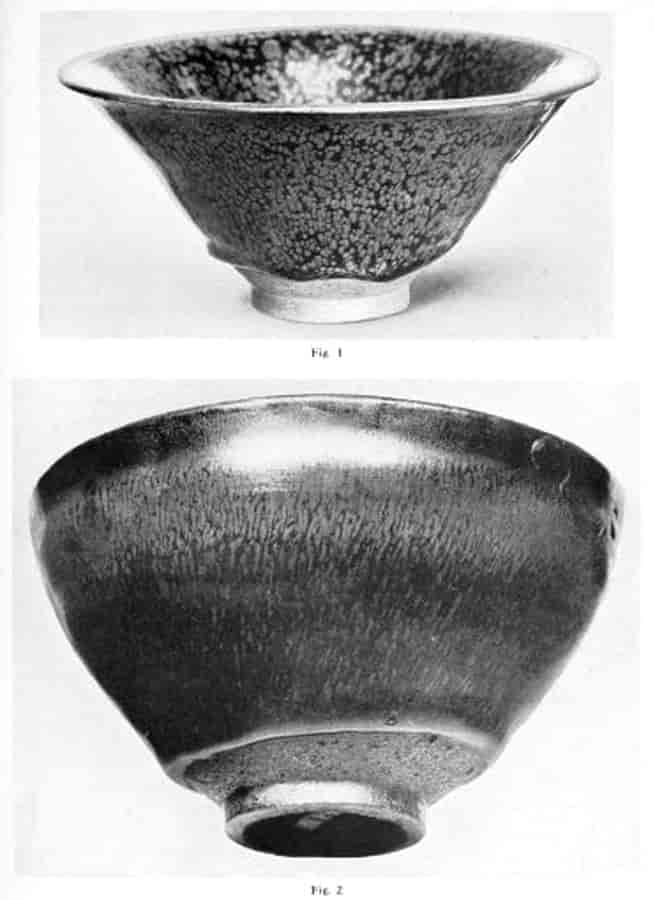
Plate 42.—Two Temmoku Bowls, dark–bodied Chien yao of the Sung dynasty.
Fig. 1.—Tea Bowl (p´ieh), purplish black glaze flecked with silvery drops. Diameter 7 12 inches. Freer Collection. Fig. 2.—Tea Bowl with purplish black glaze shot with golden brown. Height 3 34 inches. British Museum.
The Chinese tea contests were adopted by the Japanese, who elaborated them into the curious ceremony known as Cha no yu, which later assumed a semi–political aspect. The Japanese Cha jin (initiates of the tea ceremony) have always prized the Chien yao bowls, to which they gave the name temmoku, and Brinkley speaks of a great variety of Chien yao glazes which he saw in Japan. Of some he says that "on a ground of mirror black are seen shifting tints of purple and blue; reflections of deep green, like the glossy[132] colour of the raven's wing; lines of soft silver, regular as hair." The tea–testing contests seem to have lost popularity in China at an early date, and late Ming writers took little interest in the partridge cups, which one[282] at least of them voted "very inferior." In Japan, on the other hand, the vogue of the tea ceremonies has continued unabated to modern times, and no doubt the Chien bowls were eagerly acquired by the Japanese æsthetes. Hence their rarity in China to–day. Moreover, the Japanese potters of Seto and elsewhere have copied them with astonishing cleverness, so that the best Seto imitations are exceedingly difficult to distinguish from the originals. The ordinary run of the Japanese copies, however, are recognised by a body of lighter tint and finer, more porcellanous texture, besides their general imitative character and the Japanese touch which is learnt by observation but is not easy to define in words.
Though we hear nothing further of this Chien yao after the Yüan dynasty it is practically certain that the manufacture of pottery of some sort continued in the district. A small pot of buff stoneware with a translucent brown glaze (much thinner than that of the hare's fur bowls and without the purple tint or the golden brown markings) was found in a tomb near, Chien–ning Fu with an engraved slab dated 1560. The find was made by the Rev. H.S. Phillips, who presented the pot, with a rubbing of the inscription, to the British Museum.
In addition to the characteristic temmoku we have now quite a large family of bowls, dishes, jars, and vases with thick purplish black glazes more or less diversified by golden brown and tea–dust green, which are at present grouped with the Chien yao pending some more precise information as to their origin. They are, however, distinguished by a coarse porcellanous body of greyish white or buff colour, and I understand that many of the bowls have come from excavations in Honan; and there are features in the ornament and in the ware itself which suggest that they date back as far as the T´ang period. Fig. 3 of Plate 43, for instance, with its large brown mottling on a black glaze, is analogous in form and material to the white–glazed T´ang wares and in the mottling of the glaze to the typical T´ang polychrome. The bowls, which are usually small and shallow with straight sides, wide mouth, and very narrow foot, or with rounded sides slightly contracting at the[133] mouth, have neither the weight of material nor smooth solidity of glaze which characterise the true Chien yao. On the other hand, they are more varied in the play of black and brown, and in some cases they have designs and patterns which are clearly intentional. The two extremes of colour are a monochrome black, usually of purplish tint but sometimes brownish, and a lustrous brown often decidedly reddish in tone. Between these come the black glazes which are more or less variegated with brown in the form of mottling, streaks, tears, irregular patches, and definite patterns. The glaze in these bowls usually extends to the foot rim, and sometimes reappears in a patch under the base. The ornament in some cases takes the form of rosettes or plum blossom designs in T´ang style incised through the glaze covering; in others, as in Fig. 1 of Plate 43, we find a leaf design (evidently stencilled from a real leaf) expressed in brown or dull tea green; and occasionally there are more ambitious designs, such as a hare or bird or foliage, incised. On a red brown bowl in the Museum für Ostasiatische Kunst at Cologne there are traces of a floral pattern in a lustrous medium which resembles faded gilding.
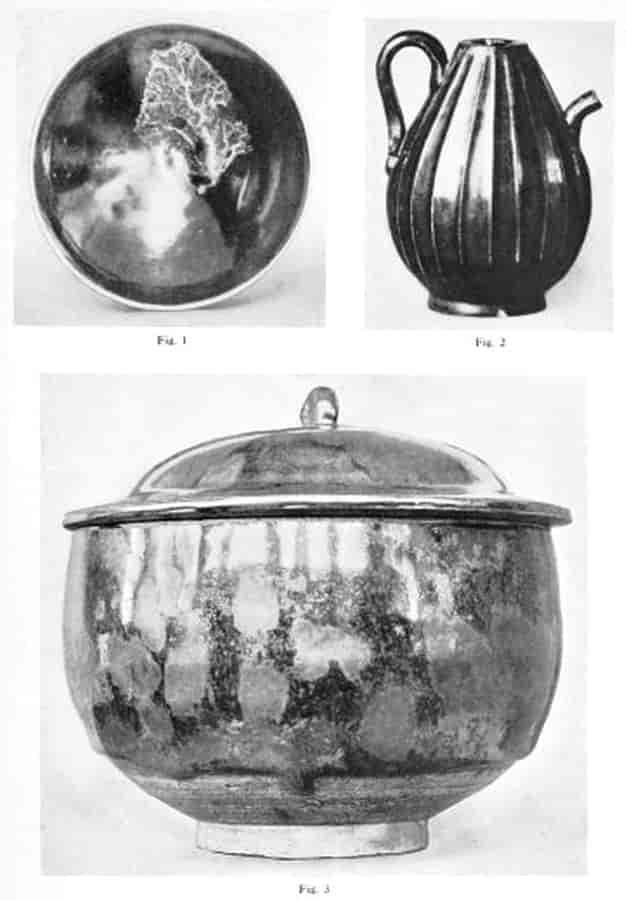
Plate 43.—Three Examples of "Honan temmoku," probably T´ang dynasty.
Fig. 1.—Bowl with purplish black glaze, stencilled leaf in golden brown. Diameter 6 inches. Havemeyer Collection.
Fig. 2.—Ewer with black glaze. Height 4 34 inches. Alexander Collection.
Fig. 3.—Covered Bowl, black mottled with lustrous brown. Height 7 inches. Cologne Museum.
We have already noted how the purplish black glaze of the Tz´ŭ Chou ware breaks into lustrous brown; the black Ting ware and the debateable red Ting have been discussed; and if we add this family which may perhaps be provisionally described as Honan temmoku, it would appear that glazes analogous to those of the Chien yao "hare's fur" bowls were widely used in Northern China at an early date.
A word of explanation may appropriately be added here of the expression wu–ni yao,[283] which occurs in several passages in Chinese books on pottery. It means "black clay ware," and as a general term would naturally include the "hare's fur bowls." Indeed, one passage[284] actually speaks of the wu–ni yao of Chien–an, and the T´ao lu, which gives the ware a paragraph to itself, states that it was made at Chien–an, in Chien–ning Fu, beginning in the Sung dynasty, and that its clay was black. It further adds that the glaze is "dry and parched" and that it was sometimes green (ch´ing). It is clear from the above quotations that wu–ni yao was a general expression for the dark–bodied Chien ware; and there the matter would have ended had not early works, such as the Cho kêng lu and Ko ku yao lun, mentioned it in the category[134] of Kuan and Ko wares, the former naming it with the Hsün and Yu–hang wares, which were inferior to the Kuan, and the latter adding to the passage dealing with Kuan wares the following note: "There are black wares which are called wu–ni yao, all of which were imitated at Lung–ch´üan. They have no crackle." The Po wu yao lan, however, explains that these wares "were admitted by confusion into the category of Kuan and Ko wares," and that the "error has been handed down to this day." Probably it was the green variety which caused the confusion, as there seems no reason why the black glazes should have been associated with the Kuan class, though the dark red clay of the Phœnix Hill from which the Hang Chou Kuan ware was made may have had some resemblance to the dark red brown body of the Chien yao. As for the Lung–ch´üan imitations, we can only imagine that the statement refers to the later Ko wares, which are said to have been made with material brought from Hang Chou,[285] and that their glaze, too, was of the green variety, as would be expected in the Lung–ch´üan district, the home of the green celadons. At the same time it will be remembered that wu–ni yao means simply "black clay ware," and might have been fairly applied to any dark–bodied ware wheresoever made.
As already mentioned, many fragments of pottery were included in the important finds made by Sir Aurel Stein in his excavations in Turfan. Unfortunately, many of the sites have little evidential value, because they have clearly been revisited at comparatively late periods; but there are a few localities which ceased to be inhabited as early as the Sung dynasty, and which furnished fragments of glazed pottery and porcellanous wares. I only mention those sites which, as far as these finds are concerned, were not vitiated by the occurrence of obviously recent wares. On one site named Ushaktal, supposed to have been abandoned in the Sung dynasty, if not before, were fragments of greenish brown celadon with combed ornament on the body, such as was certainly made in Corea and probably in China as well. The same site produced opalescent glazes of the Chün and Yüan type. The site of Vash–shahri, which was "occupied probably down to the eleventh or twelfth century," produced a number of interesting fragments (1) with buff and grey stoneware bodies and glazes of the opalescent Chün and Yüan kinds, (2) the same body with emerald green crackled[135] glaze, (3) celadon glazes over carved ornament, (4) speckled olive brown glaze resembling the later "tea dust," (5) opaque dark brown glaze, (6) speckled dark purplish brown glazes, (7) thick greenish glaze evenly dappled with pale bluish grey spots.
Early wares found on the mixed sites, such as Kan Chou and Hsi Yung ch´êng, which were occupied down to Sung times but evidently visited later, include carved white porcelain and creamy white ware of the t´u Ting class, and several kinds of Tz´ŭ Chou wares, the graffiato, as well as the black painted. But evidence from excavations of this kind is always open to the objection that the ruins may have been visited later, and the broken pottery dropped by subsequent explorers. This objection, however, cannot reasonably be offered to more than a small proportion of the objects found, and these finds, though not in themselves conclusive, may be regarded, at any rate, as valuable corroboration of existing theories.
CHAPTER X
MIRABILIA
MANY strange things are recorded by the early Chinese writers in connection with pottery and porcelain, and the tales are solemnly repeated from book to book, though occasionally a less credulous author adds some such comment as "This may be true, or, on the other hand, it may not." It is difficult, however, entirely to discredit the serious and circumstantial account given by a provincial governor of a curious custom which prevailed in his district. Fan Ching–ta, who was appointed administrator in Kuang–si in 1172, tells[286] us that "the men of Nan (–ning Fu) practise nose–drinking. They have pottery vessels such as cups and bowls from the side of which stands up a small tube like the neck of a bottle. They apply the nose to this tube and draw up wine or hot fluids, and in the summer months they drink water. The vessels are called nose–drinking cups. They say that water taken through the nose and swallowed is indescribably delicious. The people of Yung Chou have already recorded the facts as I have done. They grow a special kind of gourd for the purpose." Another extract from the same writer's works alludes to "drums with contracted waist" made of pottery in the villages of Lin–kuei and Chih–t´ien. The village people made a speciality of the manufacture of this pottery (yao), and baked it to the correct musical tone. On the glaze, we are told, they painted red flower patterns by way of ornament. The allusion to painting in red on the glaze at this early period is interesting, but it is quite likely that the designs were only in some unfired pigment.
Some of the stories may be regarded merely as figurative descriptions of the superhuman skill of the artist in rendering "life–movement." Thus we are told[287] of "four old porcelain (tz´ŭ) bowls painted with coloured butterflies. When water was poured in,[137] the butterflies floated on the surface of the water, fluttering about as if alive." It was an unnatural proceeding for butterflies in any case, and we can quite understand why "those who saw this, all maintained secrecy and did not divulge it."
A somewhat similar poetic licence is taken by the same author in another passage with reference to certain cups and bowls, apparently of the Sung dynasty, which were found in the K´ang Hsi period on the site of an old temple. "The bowls had a minute wave pattern which moved and undulated as in a picture by Wu Tao–tzŭ. As for the cups, when a little water was poured into them four fishes arose out of the sides and swam and dived."
But most curious of all were the Chinese views on the subject of "furnace transmutations" (yao pien) and the fables which sprang from them. At the present day the strange behaviour of metallic oxides, notably copper, under certain firing conditions, is well known and turned to good account. But in early times, when the unexpected happened, and a glaze which contained an infinitesimal quantity of copper oxide was accidentally subjected to an oxidising or reducing atmosphere in the kiln (by the admission of air or smoke at the critical moment), instead of coming out a uniform colour, was streaked and mottled all over with red, green and blue, or locally splashed with crimson or mixed colour, the potters saw in the phenomenon something supernatural. It was a terrifying portent, and on one occasion, we are told, they broke the wares immediately, and on another they even destroyed the kilns and fled to another place.
However, the irregular formation of the Chinese kilns greatly favoured these accidental effects, and in time they became comparatively common, so that these true "furnace transmutations" were taken for granted; and though they were not clearly understood before the end of the K´ang Hsi period, fairly rational explanations of them were offered by some of the late Ming writers. Thus the curious splashes of contrasting colour which appeared on the Kuan, Ko and Chün wares were attributed to the "fire's magical transmutation."
In these cases only a partial transmutation had taken place, affecting the glaze alone. But the idea of transmutation in the fire was carried farther in the Chinese imagination, and stories grew of cases in which "the vessel throughout was changed and became wonderful." Su Tung–p´o has, for instance, left a poem on[138] a vase organ, in the preface of which it is related[288] that in the year 1100 A. D., "while they were drinking at a farewell banquet to Liu Chi–chung, they heard the sounds of an organ and flute," and that on investigation "it was discovered that the sounds came out of a pair of vases, and that they stopped when the meal was over." Another story of the Sung dynasty tells of a wonderful basin in which the moisture remaining after it had been emptied displayed, when frozen, a fresh pattern every day. At first it was a spray of peach blossom, then a branch of peony with two flowers, then a winter landscape, "with water and villages of bamboo houses, wild geese flying, and herons standing upon one leg."
The story of the "self–warming cups" told by an early Sung writer[289] evidently belongs to the realm of pure fiction: "In the treasury of T´ien Pao (742 A. D.) there were green (ch´ing) ware (tz´ŭ) wine cups with markings like tangled silk. They were thin as paper. When wine was poured into them it gradually grew warm. Then it had the appearance of steaming, and next of boiling. Hence the name 'self–warming cups.'"
Scarcely less marvellous is the incident recorded in the Yü chang ta shih chi, written about 1454.[290] "At the time when the temple of the god (of pottery) was in existence, an Imperial order was given to Ching–tê Chên to make a wind–screen; but it was not successful, and was changed in the kiln into a bed six feet long and one foot high. At the second attempt it was again changed and became a boat three feet long. Inside the boat were the various fittings all complete. The officials of the prefecture and district all saw it. But it was pounded to pieces with a pestle, for they did not dare to let it go to court." Another story[291] tells how Chia and I (John Doe and Richard Roe) when hunting were led in pursuit of a wounded hare into an ancient tomb in the mountains, where they found a large jar containing two white porcelain vases and an ink slab. Chia broke one of the vases, but I stopped any further vandalism and carried the other specimens home. He used the vase for flowers, but for several days he noticed "an, emanation from within issuing from the Yin yün (generative power[139] of nature) like a vapour of cloud." Being puzzled, he tried plucking the stalks of the flowers, and "found that they contained no moisture, and yet the plants did not wither. Moreover, the buds kept strong, as if they had rooted in the clay of the vase. So he began to be astonished at the vase, regarding it as a kind of yao pien. One day, during a great storm of wind and rain, suddenly there was a flash and a peal of thunder, and the vase was shaken to pieces. I was very much alarmed and distressed."
The Yang hsien ming hu hsi speaks of instances in which the Yi–hsing teapots were affected in a peculiar way, the ware changing from drab to rosy red when filled with tea; and we have already seen that Hsiang Yüan–p'ien illustrates in his Album examples of this, which he solemnly assures us he would not have believed had he not seen it happen before his eyes. In all these cases the ware was supposed to have been completely changed in the kiln and to have acquired supernatural properties. "The magic of the god had entered into the ware in the firing and had not left it."
CHAPTER XI
PORCELAIN AND ITS BEGINNINGS
THE reader will have noticed that the word porcelain, which was avoided in the discussion of the earlier periods, has insensibly crept into the chapters which deal with the Sung wares. It was no longer right or proper that it should be excluded, and it is high time that our attitude on the interesting question of its origin was defined. Unfortunately, that attitude is still—and must necessarily remain—one of doubt and uncertainty, but we can at least clear away some of the existing misapprehensions on the subject.
The myth which carried back the manufacture of porcelain some eighteen centuries before our era has been definitely discredited, and the snuff bottles supposed to have been found in ancient Egyptian tombs which gave rise to the idea are now known to be of quite modern make. The more modest computation which placed the invention in the Han dynasty (206 B. C. to 220 A. D.) might have been almost as lightly dismissed had not Dr. Bushell, after disposing of the theory in his Oriental Ceramic Art[292] in 1899, seen fit to reverse his decision in later publications.[293]
The reasons given for this later attitude are on the surface so convincing that it is necessary to consider them in detail and to examine the authorities on which they are based. Bushell's statement runs as follows: "It is generally agreed that porcelain was first made in China, but authorities differ widely in fixing a date for its invention. The Chinese attribute its invention to the Han dynasty, when a new character tz'ŭ was coined to designate, presumably, a new substance. The official memoir on 'Porcelain Administration' in the topography of Fou–liang, the first edition of which was published in 1270, says that according to local tradition[141] the ceramic works at Hsin–p'ing (an old name of Fou–liang) were founded in the time of the Han dynasty, and had been in constant operation ever since. This is confirmed by T'ang Ying, the celebrated superintendent of the Imperial potteries, appointed in 1728, who states in his autobiography that the result of his researches shows that porcelain was first made during the Han dynasty at Ch'ang–nan (Ching–tê Chên), in the district of Fou–liang."
From this and the passages immediately following it is clear that Bushell at that time leant strongly to the Han theory, which he had previously discarded, for three reasons, which we shall now examine. The first rests on the character tz'ŭ. Whether the character tz'ŭ was coined to designate a new substance in the Han dynasty is by no means certain. It undoubtedly appears in the Han dictionary, the Shuo Wên, but with the meagre definition "pottery ware,"[294] and without any further indication of its nature. The second is based on a passage in the Annals of Fou–liang, which on examination proves to contain only the general word t'ao (ware) and not the character tz'ŭ at all. The actual passage runs: "The manufacture of pottery (t'ao) at Hsin–p'ing began in the Han dynasty. Speaking generally, this pottery was strong, heavy, and coarse, being fashioned of rich clay with moisture added, after methods handed down from the ancients." The third invokes the authority of T'ang Ying, but on reference to the autobiography of this distinguished ceramist in the Chiang hsi t'ung chih, we again find reference only to t'ao and not to tz'ŭ, viz. "It (t'ao) is not the growth of one day. Research shows that it began in the Han dynasty and was transmitted through succeeding generations. Its place (of manufacture) changed (from time to time), but it flourished at Ch'ang–nan." One obvious place for T'ang's research would be the Annals of Fou–liang, and I shrewdly suspect that his conclusions were based on the very passage quoted above, of which his words give a clear echo. But in any case, neither passage has any bearing on the origin of porcelain unless we assume that t'ao is the same as tz'ŭ, and that both words definitely mean porcelain,[142] an assumption which is not only quite unwarranted but in any case begs the whole question.
The Chinese words used at the present day for porcelain are tz'ŭ, t'ao, and yao, all of considerable antiquity, though their forms have undergone various changes and their meaning has been modified from time to time to keep pace with the evolution of the ware. The word tz'ŭ  , as we have seen, was defined in the Han dictionary as merely "pottery ware." Its modern definition is a hard, fine–grained variety of t'ao, and if we add to this the quality of resonance—i.e. of emitting a musical note when struck—we have all the requirements of porcelain according to the Chinese definition. The synonym
, as we have seen, was defined in the Han dictionary as merely "pottery ware." Its modern definition is a hard, fine–grained variety of t'ao, and if we add to this the quality of resonance—i.e. of emitting a musical note when struck—we have all the requirements of porcelain according to the Chinese definition. The synonym  , containing the radical
, containing the radical  shih (a stone), which is also pronounced tz'ŭ, has come in the last two centuries to be used interchangeably with the older word
shih (a stone), which is also pronounced tz'ŭ, has come in the last two centuries to be used interchangeably with the older word  , in spite of the protests of eighteenth–century purists.[295]
, in spite of the protests of eighteenth–century purists.[295]
The word t'ao  is a term even more comprehensive than our word "china." In the Han dictionary it appeared in the form
is a term even more comprehensive than our word "china." In the Han dictionary it appeared in the form  t'ao or yao (previously pronounced fou), composed of
t'ao or yao (previously pronounced fou), composed of  fou (earthenware) and the radical
fou (earthenware) and the radical  pao (to wrap), and its meaning was kiln, and by extension the products of the kiln. At that time the word in its modern form was only used as a proper name.
pao (to wrap), and its meaning was kiln, and by extension the products of the kiln. At that time the word in its modern form was only used as a proper name.
The third character yao (the Japanese yaki) is precisely synonymous with t'ao, meaning first a kiln and then wares of any kind. In its form  it occurs in the Han dictionary; another form is
it occurs in the Han dictionary; another form is  , which, according to a Sung writer,[296] dates from the T'ang period, and a third form
, which, according to a Sung writer,[296] dates from the T'ang period, and a third form  is current in modern dictionaries.
is current in modern dictionaries.
In short, the Chinese terms are all of a general and comprehensive kind, capable of embracing pottery, stoneware, and porcelain impartially, and there is no single Chinese word which corresponds to our precise term "porcelain." Under these circumstances[143] it is clear that no theory on the origin of porcelain can be based merely on the occurrence of any of these words in early Chinese texts. Still less can any such theory be constructed from the very promiscuous use of the word "porcelain" in European translations, and it is a thousand pities that both Julien and Bushell were not more discriminating in this matter, or that they did not always (as Julien sometimes and Professor Hirth usually did) give the Chinese character in parentheses when any reasonable doubt could exist. Had this been done we should have been spared misleading references to "two porcelain cups of the Han dynasty,"[297] and such loose writing[298] as "In the Wei dynasty (221–264 A. D.) which succeeded the Han we read of a glazed celadon ware made at Lo Yang for the use of the palace, and in the Chin dynasty (265–419) we have the first mention of blue porcelain produced at Wên–chou, in the province of Chehkiang, the progenitor of the sky–blue glazes tinted with cobalt, which afterwards became so famous." The "glazed celadon," needless to say, is purely conjectural, pottery (t'ao) vessels being all that is specified in the passage on which the statement is obviously based; and the "blue porcelain" is evidently no other than the p'iao tz'ŭ (mentioned by the poet P'an Yo and discussed on p. 16), which is better rendered "green ware."[299]
The same kind of criticism applies to all the other references in early writers until we reach the Sui dynasty (581–617 A. D.). In the annals of this period there is a much discussed passage in which it is stated that the art of making a substance known as liu–li[300] had been lost in China, and that the workmen did not dare to experiment, but that one Ho Ch'ou  , a connoisseur in pictures and antiquities, succeeded in making it with green ware (lü tz'ŭ), and that his imitations were not distinguishable from the original substance.
, a connoisseur in pictures and antiquities, succeeded in making it with green ware (lü tz'ŭ), and that his imitations were not distinguishable from the original substance.
To understand the full import of this passage it is necessary to explain the nature of liu–li, and this is fortunately made quite clear by the author of the T'ao shuo in a commentary so interesting that I give it in full:
"I find that liu–li comes from the countries of Huang–chih,[144] Ssŭ–t'iao and Jih–nan.[301] That produced in Ta–ch'in (the eastern provinces of the Roman Empire) is in ten colours—pink, white, black, yellow, blue, green, deep purple, deep blue (or green), red, and brown. Liu–li was originally a natural substance.[302] Yen Shih–ku,[303] commenting in the Annals of the Han Dynasty, says, 'At the present time they commonly use molten stones, adding a number of chemicals and then pouring the substance (into moulds) and forming it; but it is unsubstantial, brittle, and not a successful casting.' In the Northern Wei dynasty, in the reign of T'ai Wu (424–451 A. D.), a man of the Ta Yüeh–chih[304] who came to trade at the capital, said he could make liu–li by melting stones. Eventually he collected the ore and made it (liu–li), and the finished article surpassed the original in its brilliance and colour. The method has been handed down to the present day, and it was probably only an accidental intermission which occurred in the Sui dynasty. But the Chinese castings are brittle in substance, and when hot wine is poured into them they fly to pieces in the hand. What a pity the Yüeh–chih method has been handed down instead of Ch'ou's!"
The allusions to melting stones, casting, etc., in this passage leave no doubt that the liu–li, as made in China, was a kind of glass, imitating a natural stone.[305] It is, in fact, usually translated in the dictionaries as "opaque glass," and in connection with pottery it has the sense of glaze—e.g. liu li wa "glazed pottery."
We can now return to Ho Ch'ou, who "took green ware and made liu–li."[306] It has been thought that what he made must have been a kind of porcelain, but there is no indication of any[145] such achievement, for though it is possible to make an artificial porcelain with glass as a constituent, the converse is not true: you cannot make glass out of either pottery or porcelain. The most probable explanation of the passage seems to be that Ho Ch´ou (who was apparently not a potter) experimented at some pottery with the materials used in glazing the green ware, and found that he could make a very good glass (liu–li) with the potter's green glaze, and perhaps other ingredients, a result which is in no way surprising, seeing that the softer ceramic glazes have a very close affinity to glass. But no further inferences can be drawn from this passage, and it is not even clear that Ho Ch´ou made a ceramic ware at all. All we are told is that he made liu–li. I have rather laboured this negative point, because Professor Zimmermann has published a declaration of belief that Ho Ch´ou was the discoverer of porcelain.[307] Apart from the obvious criticism which the writer himself anticipates, that such an epoch–making discovery would hardly have escaped the notice of Ho Ch´ou's biographer, Professor Zimmermann opens his case with a fundamental error, for which he has to thank Dr. Bushell. It is true that he only names Julien as the source of his information, but his version of the story of Ho Ch´ou is taken verbatim from Bushell's Oriental Ceramic Art,[308] where the crucial passage is unfortunately rendered "but he (Ho Ch´ou) succeeded in making vessels of green porcelain which could not be distinguished from true glass." This mistranslation puts an entirely different complexion on the passage, and goes a long way to justify Professor Zimmermann's inferences that Ch´ou made a glassy ware of the nature of porcelain. It is an instructive instance of the pitfalls which beset the student of Chinese subjects, especially when he has to rely on other people's translations.
Strange to say, a similar mistranslation occurs in Dr. Hirth's short but excellent treatise on Ancient Chinese Porcelain,[309] in a passage which is nevertheless of great importance to our quest. It has been the custom with Chinese compilers of reference works to incorporate the material of previous editions, adding their own commentaries and any further information which happened to[146] have reached them, and to this we are indebted for the preservation of many passages from ancient writers which would otherwise be extremely difficult of access. Thus Hirth found embalmed in the Sung Pharmacopœia two early references to the material pai o  which he shows to be without doubt the kaolinic earth used in the manufacture of porcelain, and which, like many other strange materials, entered into Chinese medicinal prescriptions. The first mention of this substance is taken from the writings of T´ao Yin–chü, who died in 536 A. D., to the effect that the pai o, besides being used in medicines, was employed at that time for painting pictures; and Hirth argues that so celebrated a writer on scientific subjects as T´ao Yin–chü could not have failed to note it if the pai o had been in general use for ceramic purposes as well. This is followed by a quotation from the T´ang Pharmacopœia (compiled about 650 A. D.): "It (pai o) is now used for painter's work, and rarely enters into medicinal prescriptions; during recent generations it has been prepared from white ware[310] (tz´ŭ)." By rendering the last sentence "during recent generations it has been used to make white porcelain," Hirth invested the passage with a greater interest than it actually possesses. But even when stripped of this fictitious importance, it constitutes the first literary evidence we have of the use of kaolin by Chinese potters. This is followed by another quotation from the T´ang Pharmacopœia recommending for medicinal purposes a powder prepared from the white ware of Ting Chou.[311]
which he shows to be without doubt the kaolinic earth used in the manufacture of porcelain, and which, like many other strange materials, entered into Chinese medicinal prescriptions. The first mention of this substance is taken from the writings of T´ao Yin–chü, who died in 536 A. D., to the effect that the pai o, besides being used in medicines, was employed at that time for painting pictures; and Hirth argues that so celebrated a writer on scientific subjects as T´ao Yin–chü could not have failed to note it if the pai o had been in general use for ceramic purposes as well. This is followed by a quotation from the T´ang Pharmacopœia (compiled about 650 A. D.): "It (pai o) is now used for painter's work, and rarely enters into medicinal prescriptions; during recent generations it has been prepared from white ware[310] (tz´ŭ)." By rendering the last sentence "during recent generations it has been used to make white porcelain," Hirth invested the passage with a greater interest than it actually possesses. But even when stripped of this fictitious importance, it constitutes the first literary evidence we have of the use of kaolin by Chinese potters. This is followed by another quotation from the T´ang Pharmacopœia recommending for medicinal purposes a powder prepared from the white ware of Ting Chou.[311]
Whether we are to understand that the Chinese pharmacist ground up broken pieces of Ting ware or merely made use of the refined and purified clay obtained at the potteries, matters little. Neither proceeding would be without parallel in Europe in far later times than the T´ang period. But the specific reference to white Ting ware at this early date is most interesting in view of the fact that Ting Chou was celebrated in the Sung dynasty for a white ware which is undoubtedly a kind of porcelain.
The presence of a kaolin–like material in a dark–coloured ware, probably of the third century, which was disclosed by the analysis made by Mr. Nicholls in Chicago, has already been recorded (p. 15). We have no means of ascertaining what length of time[147] elapsed before a white material of this nature was evolved, but it was clearly in existence in the beginning of the sixth century. Possibly it was not porcelain according to the strict European definition, but there is every reason to suppose that it was a hard white ware, such as the Chinese would not hesitate to include in their porcelain category. Such a ware appears on some of the funeral vases which may safely be referred to the early T´ang period (see p. 26), and in default of other evidence I think we can say that porcelain in the Chinese sense already existed at the end of the Sui dynasty.[312]
Though this period happens to coincide with the lifetime of Ho Ch´ou, neither his name nor any other has been associated with the event by the Chinese, and it is highly probable that porcelain only came into being by a process of evolution from pottery and stoneware, the critical moment arriving with the discovery of deposits of kaolinic earth. As a mere speculation, I would suggest that the deposits were those at Han tan, the modern Tz´ŭ Chou, which supplied material for the Ting Chou potters.[313] It is, at any rate, significant that the new name, which we are led to suppose was derived from the tz´ŭ stone,[314] was given to that place in the Sui dynasty.
Numerous literary references from this time onwards have already been quoted which are highly suggestive of porcelain. The "false jade vessels" of T´ao Yü in the early years of the seventh century; the eighth–century tea bowls of Yu Chou and Hsing Chou which were compared respectively to jade and ice, to silver and snow, the former being green and the latter white. The twelve cups used for musical chimes by Kuo Tao–yüan; the white bowls immortalised by the poet Tu "of ware (tz´ŭ) baked at Ta–yi, light but strong, which gives out a note like jade when struck."
The quality of translucency which in Europe[315] is regarded as distinctive of porcelain is never emphasised in Chinese descriptions. I can find no mention of it in any of the earlier writings,[316] and the first unmistakable literary evidence of its existence[317] comes from a foreign source. The Arab traveller, Soleyman, who describes his experiences in China in the ninth century, states that "they had a fine clay (ghādar) from which bowls were made, and in the transparency of the vessels the light of the water was visible; and they were (made of) fine clay."[318] This statement practically proves the existence of translucent porcelain in the T´ang dynasty, and we confidently await the arrival of specimens from Chinese excavations. Some of the export porcelains of the time have been actually unearthed at Samarra on the Euphrates by Professor Sarre,[319] of the Kaiser Friederik Museum, Berlin, and they include (1) bowls of gummy white porcelain with unglazed gritty base; (2) greenish white ware; (3) yellowish white with small crackle; and (4) a pure white porcelain with relief designs, such as birds[149] and fishes, under the glaze. Other pottery found on that site included mottled ware of typical T´ang type, and a creamy white of the Tz´ŭ Chou type with brown spots.[320]
From considerations of form and the general character of the ware, I am inclined to regard three specimens in Plates 44 and 45 as belonging to the T´ang period. Fig. 1 of Plate 44 has a thin ivory white glaze running in gummy drops and clouded with pinkish buff staining outside and with a reddish discoloration within. Fig. 2 of the same Plate is remarkable in many ways. It is so thin as to seem to consist of little else but glaze, and is consequently almost as translucent as glass. The colour of the glaze is pearly white powdered with tiny specks, and the crackle is clearly marked. The base is flat and discloses a dry white body of fine grain. But its most conspicuous feature is the arresting beauty of its outline, which recalls some choice specimen of Græco–Roman glass, and displays a classic feeling frequently observed in T´ang pottery and in the Corean wares which owe so much to T´ang models.
Fig. 2, Plate 45, shows the celebrated phœnix ewer belonging to Mr. Eumorfopoulos which has proved so difficult to classify.[321] It is a white porcellanous ware translucent in the thinner parts, and the glaze is of light greenish grey with a tendency to blue in places. The form and ornament show strong analogies with specimens of T´ang pottery. The neck, for instance, may be compared with Fig. 2 of Plate 14; the phœnix head and the foliate mouth with Fig. 1 of Plate 9, and the carved ornament on the body with Fig. 3 of Plate 14.
Among the Sung wares many of the white Ting specimens are found to be translucent in their thinner parts, and these may be fairly regarded as porcelain proper. A considerable number of other white porcelains have come over of late under the description of Sung wares, and many of them are certainly early enough in form and style to belong to that period. They are true hard porcelain, translucent, and of a creamy white colour. Being for the[150] most part without decoration, they can only be judged by their forms, and in view of the conservative habits of the Chinese, it would be rash to assert too emphatically their Sung origin. Yüan and even early Ming dates are suggested by the more cautious critics; but the possibility of a Sung origin having been established, I am inclined to give the evidence of form its full weight.
There are, besides these, other well–defined types of translucent porcelain which may confidently be attributed to a period as early as the Sung, but here the possibility—nay, probability—of a Corean origin has to be considered. It is certain that many of them have been found in Corean tombs; the provenance of the rest is doubtful. One type is a delicious smooth white porcelain with glaze of faintly bluish tinge, highly translucent, and worked very thin at the edges. The base of the vessels (usually small shallow bowls or saucers) is unglazed, and shows a soft–looking sugary body of close texture, rather earthy than glassy, and slightly browned by the fire. They have, in fact, almost the appearance of a "soft–paste" porcelain like that of Chelsea. These are so different from any known Chinese type that I strongly incline to a Corean origin for them. Another type is of hard but translucent ware with glaze of distinctly bluish tinge. A bowl in the British Museum is a good example of this. Of the usual conical form, it has a plain outside, and the inside is decorated with an incised design of not very clear meaning, but apparently a close foliage ground with highly formalised figures of boys. If this interpretation is correct, it is a conventional rendering of the well–known pattern of boys in foliage, Chinese in origin, but frequently used by the Corean potters. The design ends in Corean fashion, about an inch below the rim, leaving a plain band above it. The glaze is a faint bluish colour all over, and is powdered with specks, a fault in the firing; the base is almost entirely unglazed, and the biscuit, where exposed, has turned reddish brown. The style of this piece is strongly Corean. The same peculiarities in the base are shared by another type of small bowl, usually decorated inside with a sketchy design in combed lines. Some of these are creamy white; others are bluish white with a decided blue tinge in the well of the bowl where the glaze has formed thickly.[322] Another group, which is also said to be represented among the Corean tomb wares, is practically indistinguishable from the creamy white Ting Chou porcelain.
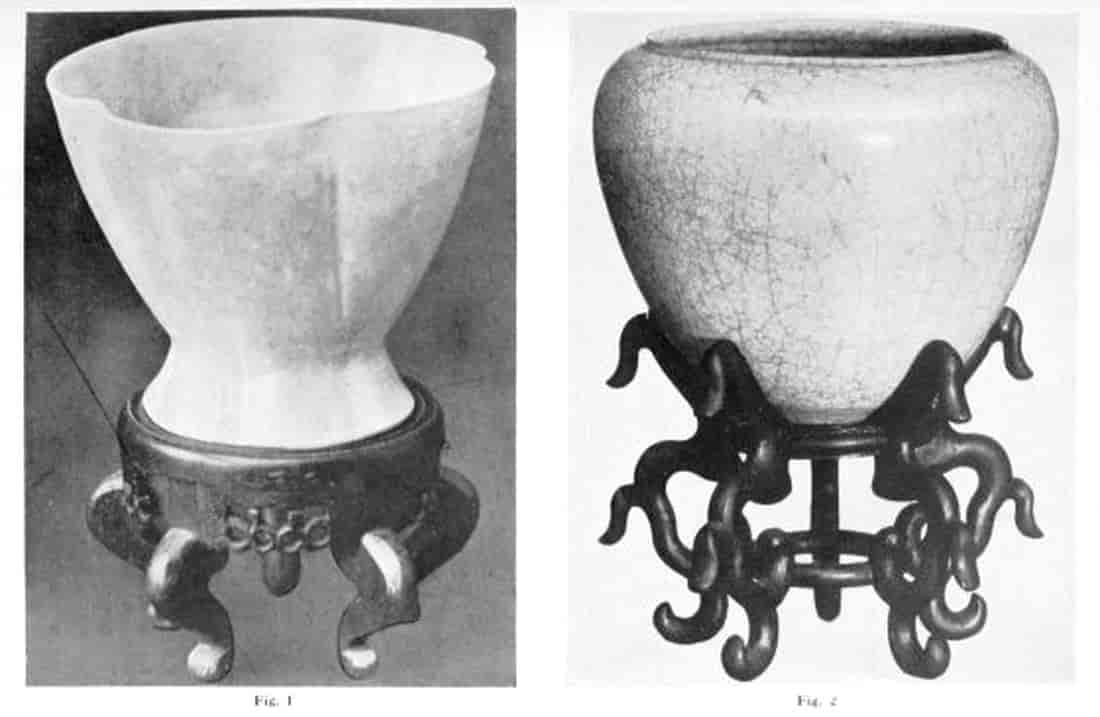
Plate 44.—Early Translucent Porcelain, probably T´ang dynasty.
Fig. 1.—Cinquefoil Cup with ivory glaze clouded with pinkish buff stains. Diameter 3 34 inches. Breuer Collection.
Fig. 2.—Vase of white, soft–looking ware, very thin and translucent with pearly white, crackled glaze powdered with brown specks. Height 3 18 inches. Peters Collection.
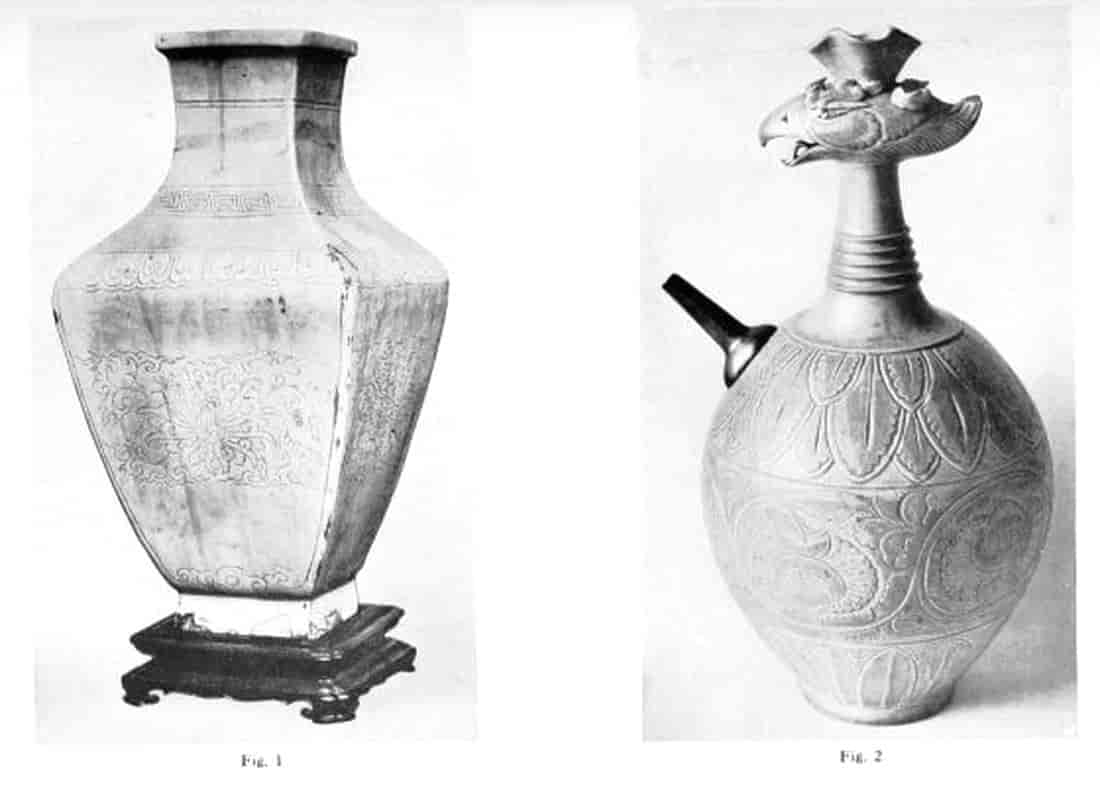
Plate 45.—T´ang and Sung Wares.
Fig. 1.—Square Vase with engraved lotus scrolls and formal borders. T´u–ting ware, Sung dynasty. Height 20 inches. Peters Collection.
Fig. 2.—Ewer with phœnix head, slightly translucent porcelain with light greenish grey glaze with tinges of blue in the thicker parts; carved designs. Probably T´ang dynasty. Height 15 14 inches. Eumorfopoulos Collection.
The whole question of these interesting porcelains is complicated by the fact that the Coreans were admittedly indebted to the Ting Chou potters for many of their designs;[323] and by the fact that while close intercourse between China and Corea existed the Coreans may well have imported Chinese wares and deposited some of them in the tombs. An authentic find of these porcelains in a Chinese tomb would give important evidence on this point, but so far there is no evidence of their being found in China beyond the statement of traders, and it is quite certain that they have been found in Corean tombs. It may be added that the Japanese class them as hakugorai or white Corean ware, and stoutly support their Corean origin.
CHAPTER XII
CHING–TÊ CHÊN
CHING–TÊ CHÊN, the metropolis of the ceramic world, whose venerable and glorious traditions outshine Meissen and Sèvres and all the little lights of Europe, and leave them eclipsed and obscure, is an unwalled town or mart (chên) on the left bank of the Ch´ang River, which flows into the Po–yang Lake, on the northern border of the province of Kiangsi. In ancient times it was known as Ch´ang–nan Chên, the mart on the south of the Ch´ang, but when the Sung Emperor Chên Tsung commanded that officially manufactured porcelain (kuan chih tz´ŭ) should be sent to the capital, and that the workmen should inscribe the pieces with the nien hao or name of the period, which in this case was Ching Tê (1004–1007), the name of the place was changed to Ching–tê Chên.
The district town is Fou–liang, seven miles higher up the river, a place of relatively small importance, but the residence of the district magistrate; and both Fou–liang and Ching–tê Chên are within the prefectural jurisdiction of Jao Chou Fu, which is situated near the mouth of the Ch´ang.
The wares of Ching–tê Chên are distributed by various routes, some overland to Chi–mên or to Wu–yuan and thence to Hang Chou, Su Chou, Shanghai, etc.; the rest by boat down the Ch´ang, and thence either to Kiu–kiang on the Yangtze for further dispatch to Chin–kiang and northwards via the Grand Canal, or to the south–west corner of the lake and up the estuary of the Kan River to Nan–Ch´ang Fu. From this latter town they could be carried by water (with an interruption of thirty miles of road) all the way to Canton. They are known under various names in Chinese books—Chên yao, Ching–tê yao, Fou–liang yao, Jao Chou yao, Jao yao, Ch´ang–nan yao, and Nan–ch´ang yao—all of which are easily explicable from the foregoing paragraph.
The old name of Fou–liang was Hsin–p´ing, and according to[153] the Annals of Fou–liang the manufacture of pottery[324] was traditionally held to have begun in the district of Hsin–p´ing in the Han dynasty. In the same passage the development of the local industry is traced by means of a few significant incidents. In the first year of Chih Tê in the Ch´ên dynasty (583 A. D.) the potters of the district were called upon to provide plinths for the Imperial buildings at Chien–k´ang (afterwards Nanking), but the plinths, when finished, though cleverly made, were not strong enough to carry the weight of the columns. In the fourth (or, according to another reading, the second) year of Wu Tê of the T´ang dynasty (621 A. D.), "porcelain jade"[325] was offered as tribute to the Emperor under the name of false jade vessels (chia yü ch´i), and from this time forward the duty (of supplying the Emperor) became an institution,[326] and a potter named Ho Chung–ch´u gained a great reputation. In the Ching Tê period of the Sung dynasty, as already stated, officially manufactured porcelain was sent to the capital, where it supplied the needs of the palaces and great establishments. In the T´ai Ting period of the Yüan dynasty (1324–1327) the porcelain factory came under the inspection of the Intendant of the Circuit, who supplied the required wares when orders had been received, and closed the factory if there were no orders (from the Court).
Continuing into the Ming dynasty, the same authority gives details of the various administrative changes which may perhaps be "taken as read," one or two important facts only calling for mention. Thus in the thirty–fifth year[327] of Hung Wu, we are told that the factories were opened, and that supplies of porcelain were sent to the Court. There seems to have been some difference of opinion about the building of the Imperial Ware Factory (Yü ch´i ch´ang).
Some authorities place this event in the Hung Wu period, but the Chiang hsi t´ung chih,[328] though quoting the other opinions in a note, mentions only the building of the Imperial Factory in the reign of Chêng Tê (1506–1521) in the main text, viz.: "In the beginning of the Chêng Tê period the Imperial Ware Factory was established for dealing specially with the Imperial wares." The Imperial establishment was burnt down in the Wan Li period, and again destroyed in the revolt of Wu San–kuei in 1675, but the most serious blow dealt to the prosperity of Ching–tê Chên fell in the T´ai p´ing rebellion in 1853, when the town was sacked and almost depopulated. The Imperial Factory was rebuilt in 1864, and the industry has in a great measure revived, though it is still but the shadow of its former greatness.
Though this great porcelain town has traded with the whole world for several centuries, "bringing great profit to the Empire and to itself great fame" (to quote from the T´ao lu), it seems to have been rarely visited by Europeans, and first–hand descriptions of it are few. We are fortunate, however, in possessing in the letters[329] of Père d'Entrecolles an intimate account of the place and its manufactures, written by a Jesuit missionary who was stationed in the town in the early years of the eighteenth century. These interesting letters are so well known that I shall not quote them extensively here. The picture they give of the enormous pottery town, with its population of a million souls and the three thousand furnaces which, directly or indirectly, provided a living for this host, and of the arresting spectacle of the town by night like a burning city spouting flames at a thousand points, a description which inspired the oft–quoted lines in Longfellow's "Keramos," shows us the place in the heyday of its prosperity.
A more modern but scarcely less interesting account of Ching–tê Chên and the surrounding country appears in a Consular report,[155] made in 1905, of a Journey in the Interior of Kiangsi,[330] from which I have taken the following paragraphs:
"During the last forty–five years Ching–tê Chên has had time to recover, in a very large measure, from this last calamity, but it is said to be not so busy or so populous as before the T´ai p´ing rebellion.
"Everything in Ching–tê Chên either belongs to, or is altogether subordinate to, the porcelain and earthenware industry. The very houses are for the most part built of fragments of fireclay (called 'lo–p´ing–t´u') that were once part either of old kilns or of the fireclay covers in which porcelain is stacked during firing. The river bank is covered for miles[331] with a deep stratum of broken chinaware and chips of fireclay, and, as far as one could judge, the greater part of the town and several square miles of the surrounding country are built over, or composed of, a similar deposit. A great industry, employing hundreds of thousands of hands, does not remain localised in a single spot for 900 years without giving to that spot a character of its own.
"This is perhaps what struck me most forcibly in Ching–tê Chên—that it is unlike anything else in China. The forms, the colour, the materials used in the buildings, the atmosphere, are somewhat reminiscent of the poorer parts of Manchester, but resemble no other large town that I have ever visited.
"At present there are 104 pottery kilns in the town, of which some thirty or so were actually in work at the time of my visit. The greater part of the kilns only work for a comparatively short season every–summer. During this busy season, when every kiln is perhaps employing an average of 100 to 200 men, the population of Ching–tê Chên rises to about 400,000, but of this nearly, if not quite, half are labourers drawn from a wide area of country, chiefly from the Tuch´ang district, who only come for the season, live in rows of barrack–like sheds, and do not bring their families with them."
It is interesting to compare this modern account with the Memoirs of Chiang,[332] written in the Yüan dynasty, from which we[156] see that the work was carried on in the same intermittent fashion, the potters receiving land to cultivate instead of payment, living round the master of the pottery, and being liable to be summoned to the kilns when required. The opening of the kilns in those days was in some measure dependent on the success of the harvest, and in any case the work depended on the season, as the paste would freeze in winter, and could not be worked.
The hills which surround Ching–tê Chên are rich in the materials required by the potters, china clay and china stone of various qualities, fireclay for the seggars (cases to protect the porcelain in the kiln), or for mixing in the coarser wares, and numerous other minerals. There was water–power which could be used in the mills for crushing and refining the minerals, and abundant wood for firing. Although coal is worked nowadays not many miles away, the potters still adhere to the wood, which has served their kilns from time immemorial. It should be added that at the present day—and no doubt for some time past—the local clays have been supplemented from various districts, supplies coming overland from Chi–mên and by water from greater distances.
A good Chinese map of Ching–tê Chên is given in the T´ao lu (bk. i., fol. 1), and a large map of the district is attached to Mr. W. Clennell's report, which is easily obtainable.
This description of Ching–tê Chên has led us far from the period with which we are at present concerned. In the Sung dynasty the place had already arrived at considerable importance, and the record of its 300 kilns implies a very large population. The excellence of its porcelain had already won for it the onerous privilege of supplying Imperial needs, and, as we have seen, it was consecrated under the new and Imperial name of Ching–tê Chên in the opening years of the eleventh century. The earliest existing record of its productions, the Memoirs of Chiang, written at the beginning of the fourteenth century, tells us that the Sung porcelains made at Ching–tê Chên were pure white[333] and without a flaw, and were carried for sale to all parts under the proud name of "Jao Chou jade." It rivalled the "red porcelain" of Chên–ting Fu and the green of Lung–ch´üan in beauty.
The Ko ku yao lun describes the Imperial ware of this time as "thin in body and lustrous," and mentions "plain white pieces with contracted waist," adding that the specimens "with unglazed rim,"[334] though thin in body, white in colour, lustrous, and surpassingly beautiful, are lower in price than the Ting wares.
It is not too much to assume that some of this "Jao Chou jade" has survived to the present day, and we may look for it among the early translucent white porcelains, of which a considerable number have reached Europe during the last few years. Many of these have Sung forms and the Sung style, though, of course, plain white wares are always difficult to date. In the specimens to which I refer the glaze is usually of a warm ivory tone, tending to cream colour; it is hard and usually discontinued in the region of the base, both underneath and on the side, and the exposed body is rather rough to the touch. (See Plate 24, Fig. 1.)
It is not clear whether we are to infer from the comparison with Lung–ch´üan ware quoted above that the Ching–tê Chên potters produced a celadon in the Sung dynasty, but it is probable enough that they did so, and that the green or greenish white (ch´ing pai)[335] made in the Yüan period was a continuation of this. If we can believe the statement in the T´ao lu, they began early to copy the wares of other factories, imitating the Chün Chou ware at the end of the Sung period and the crackled Chi Chou ware in the Yüan.
It seems to me possible that the reference to the imitation of Chün ware may be explained by an interesting passage from a late twelfth–century[336] writer quoted in the T´ao lu, who says that in the Ta Kuan period (1107–1110) there were among the Ching–tê Chên wares "furnace transmutations" (yao pien) in colour red like cinnabar.[337] He is inclined to attribute this phenomenon to the fact that "when the planet Mars in the Zodiac approaches its greatest brightness, then things happen magically and contrary to the usual order." The potters were evidently disturbed by the appearance of the wares, and broke them. He tells us, further, that he stayed at Jao Chou and obtained a number of specimens[158] (of the local ware), and after examining them he could say that, "compared with the red porcelain (hung tz´ŭ) of Ting Chou,[338] they were more fresh and brilliant in appearance." It will be remembered that an echo of this last sentence occurred in the Memoirs of Chiang.
A passage in the Po wu yao lan[339] might be taken to mean that blue–painted porcelain, "blue and white," was made at Ching–tê Chên prior to the Yüan period, but as the remainder of the sentence seems to be based on the Ko ku yao lun, and no evidence is given for the words in question, too much importance need not be attached to a phrase which may be a confusion arising from the ch´ing pai of earlier writers.
CHAPTER XIII
THE YÜAN  DYNASTY, 1280–1367 A.D.
DYNASTY, 1280–1367 A.D.
THE Yüan dynasty, which lasted from 1280 to 1367, was established by Kublai Khan, grandson of the great Mongol conqueror, Genghis Khan. The Mongols completely subjugated China, and though their rule was comparatively brief, it had a disastrous effect on the artistic development of the country. The Mongol governors whose services to the reigning house had been rewarded by all the lucrative posts, made full use of their opportunities to enrich themselves by extortion and oppression. Trade and industry were convenient subjects for their exactions, and these consequently languished. The ceramic industry was among the sufferers, and many of the old potteries were closed down in this troubled period. The potteries at Ching–tê Chên, which had gradually risen to a position of great importance in the Sung dynasty, suffered for this eminence by being brought under the immediate care of a Mongol commissioner, and much of their trade passed into the hands of manufacturers in Kiangsi and Fukien.[340] The earliest account[341] which we have of the industry in this important centre, written at the beginning of the fourteenth century, ends with a bitter cry against the depredations of the governors and the subordinate officials, who were banded together to rob the people, and against whom no redress could be obtained. Dr. Bushell published a translation of the chief part of it in Oriental Ceramic Art,[342] and apart from the sorrowful picture which it draws it gives a good idea of the productions of the district in the Yüan dynasty. A short notice in the T´ao lu gives a slightly different impression, and leads us to suppose that the heavy hand of the Mongol officials[160] was felt chiefly at the Imperial potteries, while the private factories were comparatively flourishing and even supplied some of the wares required by the Court.
We learn from the Memoirs of Chiang that a variety of porcelains were made to meet the tastes of the different regions of Southern China. The market in Northern China does not seem as yet to have been studied. Thus, while the kilns at Hu–t´ien,[343] on the river bank opposite to Ching–tê Chên, supplied a brownish yellow[344] ware which was popular in the province of Chêkiang, the greenish white[345] porcelain of Ching–tê Chên found a profitable market in Hunan and Hupeh, Szechuan, and Kuangtung. The inhabitants of Kiangsu and Anhui seem to have been less critical, for the inferior wares known as "yellow stuff" (huang liao), which did not sell in Kiangsi, Kiangnan, Kuangtung, Fukien, and Chêkiang, was foisted on them.
The finest porcelain was made of the stone (shih) from Chin–kêng, while stone and earth from other neighbouring sites were used for mixing in the inferior wares and for making seggars[346] and moulds. The glaze was made of "glaze earth" from Ling–pei mixed with the ashes of brushwood from the Yu–shan hills which had been burnt with lime and persimmon wood. I mention these technical details because their similarity with the description of the manufacture in the eighteenth century show that the method of porcelain making at both periods was essentially the same. The decoration was effected by stamping or pressing in moulds, by painting or by carving[347]; and the ware was fired either upright or inverted.
Some idea of the forms and ornament of these wares may be gathered from another passage which would be far more illuminating if the fanciful names used were less difficult to understand. Bushell has boldly translated them according to his ideas, and I quote his renderings in inverted commas and in the pious hope that they may be correct, giving at the same time the original characters.
There were bowls (wan), with high feet and with fish and water[161] ornament; platters (t´ieh) with "glazes shaded in different tones,"[348] sea eyes, and snow flowers[349]; dishes (p´an) of the horse hoof and betel–nut kinds, the latter suggesting a brownish red colour; large bowls (yü) with lotus ornament (or shaped like a lotus flower), or of "square form with indented corners"[350]; bowls and platters (wan t´ieh) with painted decoration,[351] with silver designs,[352] with "fluted sides,"[353] and with "encircling strings."[354] Such wares as these had a profitable market in Chêkiang, Kiangnan, Kiangsi and Fukien.
There were besides incense burners of many forms, most of which were modelled after bronzes, e.g. those shaped like the fabulous beast i, "which eats tigers and can go five hundred li at a bound"[355]; those like the bronze incense burners on three or four feet (ting), like the cups used in the ancestral temple (i), like the large iron cauldrons (li). Others had elephant legs, and others were shaped like incense caskets or barrels. The vase forms include the goblet (ku),[356] the gall–bladder (tan), the wine pot (hu) with spout and handle, the Buddhist washing vessel (ching), the gardenia (chih tzŭ), the lotus leaf (ho yeh), the gourd (hu lu), musical pipes (lü kuan), vessels with ring–and–mask handles shou huan,[357] and glass (liu li) forms.
The Ko ku yao lun, which was written about sixty years later than the publication of the Memoirs of Chiang, supplements this information in a short paragraph on "Old Jao Chou wares." "Of the Yüan wares," it says,[358] "those with small foot and moulded ornament (yin hua), and the specimens inscribed inside with the characters shu fu[359] are highly valued. The recently made wares with large foot and plain white (su) glaze are wanting in brilliancy (jun). There are also green (ch´ing) wares and those with enamelled[162] (wu sê)[360] ornament, and they are very common. Of the modern (i.e. beginning of the Ming dynasty) wares good specimens with white colour and lustrous material are very highly valued. There are besides dark green[361] wares with gilt ornament. They are chiefly wine pots and wine cups, which are very lovely."
The T´ao lu has a paragraph on the shu fu wares which reflects (not always very clearly) these earlier accounts, adding that "this is the ware made in the private (min) factories and supplied to the palace; the material had to be fine, white and unctuous clay, and thin specimens were preferred.... Inside them were written the characters shu fu as a mark. At the time the private factories also issued imitations of these wares; but of the porcelains destined for the Emperor ten out of a thousand, one out of a hundred, only were selected. The private factories were unable to achieve uniform success." The author has inserted the gilt and enamelled,[362] and a large number of the other wares mentioned in the Memoirs of Chiang and the Ko ku yao lun in that irresponsible fashion which makes much of the Chinese ceramic literature exceedingly difficult to handle. Indeed, one is tempted to ask what was his authority for the statement that the "private factories" made the shu fu ware, in spite of the very circumstantial tone of the passage.
It is clear that the best of the Yüan wares made at Ching–tê Chên was plain white or white with engraved and moulded designs; and in this connection it is interesting to find an example of shu fu porcelain described and illustrated in Hsiang's Album.[363] It is a small, bottle–shaped vase with bulbous mouth, engraved with a dragon and cloud design, and stated to be marked with the characters shu fu under the base. We are told that in colour, form, and design it was copied from a specimen of the Northern Ting ware, and that the shu fu ware, itself copied from Ting Chou originals, served as a model for the fine white engraved porcelains of the Yung Lo and Hsüan Tê periods of the Ming dynasty. It stood, in short, midway between the soft, opaque–looking, creamy white Sung ware and the thin, hard, and highly[163] translucent Ming porcelain, such as the white Yung Lo bowl in the Franks Collection (see Plate 59). Just such an intermediate position as this is held by a bowl[364] in the British Museum with white, translucent body, soft–looking glaze of faint creamy tinge and engraved design of phœnixes and peony plants in Sung style. It has, moreover, a raw mouth rim which shows that it was fired inverted, and as there is no shu fu mark it may well have been one of the copies of the Palace types which the T´ao lu informs us were made at the private factories.
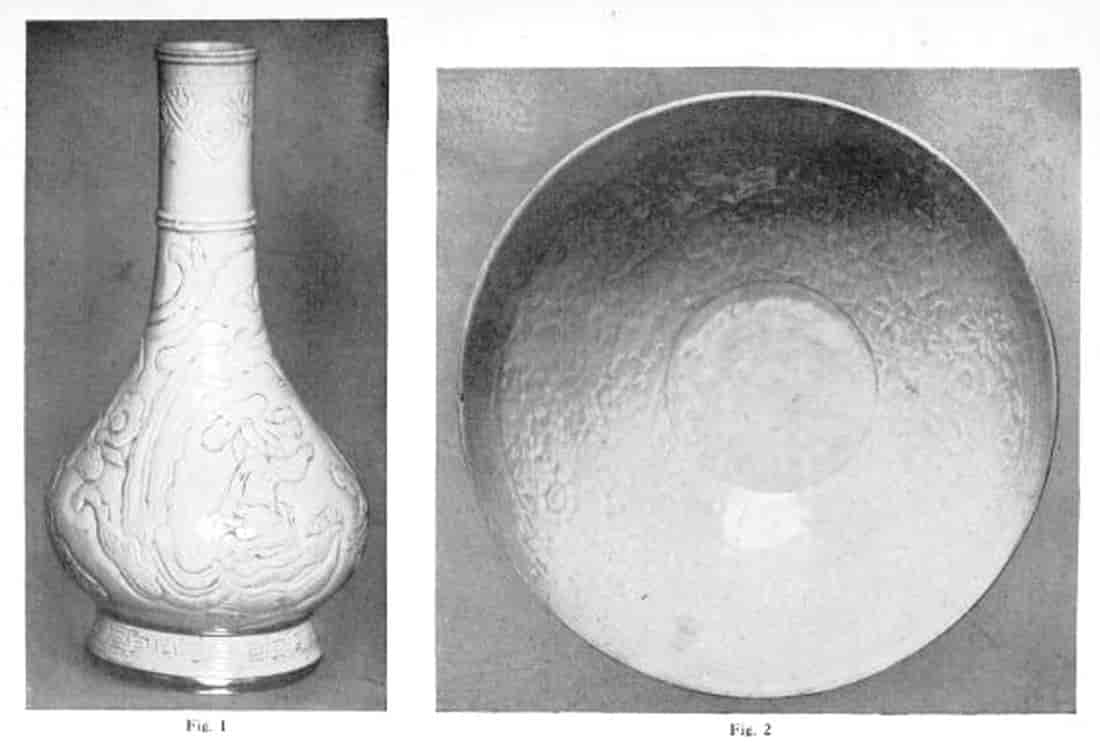
Plate 46.—Ting Ware and Yüan Porcelain.
Fig.1.—Bottle with carved reliefs of archaic dragons and ling chih funguses. Fèn ting ware, said to be Sung dynasty. Height 8 34 inches.
Fig. 2.—Bowl with moulded floral designs in low relief, unglazed rim. Translucent porcelain, probably Yüan dynasty. Diameter 8 inches. Eumorfopoulos Collection.
It is always difficult to determine the age of plain white wares, but among the archaic specimens of translucent porcelain with creamy white glaze and rough finish at the base which have come from China in recent years under the varying descriptions of Sung, Yüan and early Ming, there are, no doubt, several examples of the Yüan wares of Ching–tê Chên (see Plate 46, Fig. 2).
The mention, in the Memoirs of Chiang and the Ko ku yao lun, of painted decoration, enamelled ornament, silvering, and gilding, though apparently but crudely used and little appreciated, is nevertheless of great interest from the historical standpoint.
The potteries at Hu–t´ien which are mentioned in the Memoirs of Chiang (see p. 160) were only separated from Ching–tê Chên by the width of the river. They are described in the T´ao lu[365] as active at the beginning of the Yüan dynasty and producing a ware which, though of coarse grain, had "a considerable amount of antique elegance," and appealed to the taste of the inhabitants of the Chêkiang. The clay was hard and tough, and the colour of the ware brownish yellow[366] as a rule, but even when of a "watery white" tone it was tinged with the same brown colour. At the end of the eighteenth century all trace of the factories had disappeared, though the village still existed[367] and the old wares were still to be found.
Brinkley, who seems to have met with examples of the ware in Japan, describes it as follows[368]: "The pâte is thick and dense, without any of the delicacy of porcelain, and the glaze is muddy[164] yellow.... The surface of the pieces is generally relieved by deeply incised designs of somewhat archaic character, figure subjects being most common. Some examples are preserved in Japanese collections, where they are known as Ningyo–de (figure subject variety) in allusion to the nature of the incised designs." In spite of its apparent roughness it was thought worthy of imitation at Ching–tê Chên in the Ming dynasty.[369]
Among the causes to which was attributed the lack of prosperity at Ching–tê Chên in the Yüan period, the Memoirs of Chiang includes (1) the uncertainty of the season on which the opening of the factory partly depended, (2) the intolerable taxation and the exactions of officials, and (3) the competition of the potteries at Lin–ch´uan, Nan–fêng Hsien, and Chien–yang, all of which, as Bushell indicates, lay on the trade route between Ching–tê Chên and south–eastern coast towns.
Of these we learn in the T´ao lu that Lin–ch´uan[370] in the Fu–chou Fu in Kiangsi (not far south of Ching–tê Chên) made a ware of fine clay and thin substance, the colour of which was mostly white with a slight yellowish tinge, and that some of the pieces were coarsely ornamented, though we are not informed how the ornament was applied. The same authority informs us that Nang–fêng Hsien[371] in the Chien–yang Fu (also in Kiangsi) made a ware of refined clay but somewhat thick substance, which was, as a rule, decorated with blue designs (ch´ing hua), though some had the colour of the t´u ting ware, i.e. the coarser and yellower variety of Ting Chou porcelain.
From this passage it appears that "blue and white" may be added to the types of ware made in the Yüan period.
The third factory, at Chien–yang in Fukien, has already been discussed at some length. It was chiefly celebrated for the dark–coloured wares (wu–ni yao) and the "hare's fur" and "partridge" tea bowls.[372]
These names by no means exhaust the list of factories which were active in the Yüan period. Others have been incidentally mentioned elsewhere under the headings of Yüan–tz´ŭ, P´êng ware, Hsin Ting ware, etc.[373]
The Ko ku yao lun enumerates certain pottery forms which, it asserts, were not in use before the Yüan period. As usual, the Chinese descriptions are exceedingly difficult to visualise, and in many cases are open to several interpretations, and are not easy to reconcile with established facts. However, I quote the passage as it stands: "Men of old when they drank tea used p'ieh[374] (? bowls with curved sides), which were easy to drain and did not retain the sediment. For drinking wine they used cups (chan); they had not yet tried cups with handles (pa chan[375]), and in old times they had no ch'üan p'an.[376] The Ting ware ch'üan p'an which one sees nowadays are the brush washers (hsi) of olden times. The men of old used 'decoction vases' for pouring wine, and did not use ewers (hu p'ing) or bowls with contracted lip or tea cups (ch'a chung) or dishes with rims.[377] These were all forms used by the Mongols. The men of China only began to use them in the Yüan dynasty. They never appear in old Ting or Kuan wares."[378]
CHAPTER XIV
KUANGTUNG  WARES
WARES
THOUGH the province of Kuangtung has long been celebrated for its pottery, only very meagre information is procurable on the history of its factories. A single reference in the T´u shu[379] carries us back to the T´ang dynasty (618–906), when we learn that earthenware cooking vessels were made in the potteries (t´ao chia) of Kuang Chou (i.e. Canton), which when glazed were better than iron vessels and more suitable for the decoction of drugs. "A vessel of the capacity of a bushel sold for ten cash: and they were things which were worth preserving."
The next mention occurs in the T´ao lu, which gives a short account of the wares under the heading Kuang yao, but beyond the statement that the industry originated at Yang–Chiang, it gives no information as to the date or circumstances of its commencement.[380] For the rest this account is very confused and unsatisfactory,[167] and seems in part to refer to the porcelain decorated at Canton (see vol. ii., p. 211), or more probably to the Canton enamels. It is only in the last passage that we come into touch with a ware which is readily recognised as the familiar Canton stoneware. This is a hard–fired ware, usually dark brown at the base, but varying at times to pale yellowish grey and buff, with a thick smooth glaze distinguished from other ceramic glazes by its characteristic mottling and dappling. The colour is often blue, flecked and streaked with grey green or white over a substratum of olive brown, or again green with grey and blue mottling. At times the brown tints predominate, but the most prized varieties are those in which the general tone is blue. These were specially selected for imitation at the Imperial factories under T´ang Ying, and they are highly valued in Japan, where the ware in general goes by the name of namako.[381] In other specimens the glaze has a curdled appearance, and sometimes it seems to have boiled up like lava. The mottled glazes at times have a superficial resemblance to the dappled Chün wares, and there is no doubt that in recent times these imitative effects have been studied.
The dating of the mottled Kuangtung wares, or Canton stonewares as they are commonly named, is always a difficult matter. They are still made and exported in large quantities, but it is certain that they go back at least to late Ming times. Sir Arthur Church exhibited a tray of this ware at the Burlington Fine Arts Club in 1910[382] which bore a date corresponding to 1625, and the name of the maker, Chin–shih. The glaze of this interesting piece is remarkably deep, rich and lustrous, and it may be regarded as typical of the finest period of the ware. The tray illustrated by Fig. 1 of Plate 48 closely resembles it in colour and quality. Stamped marks occasionally occur in these wares, the most frequent [168]being the seals used by two potters, apparently brothers, named Ko Ming–hsiang and Ko Yüan–hsiang (see p. 221). It was formerly said that they lived at the end of the Ming period, but Dr. Bushell in his Chinese Art[383] reduced their antiquity to the reign of Ch´ien Lung (1736–1795). No reason is given for either of these dates, but their work is familiar, and as some of the examples have a decidedly modern aspect, I am strongly in favour of the later attribution. Plate 47 is a fine example of a Kuangtung glaze, in which the blue is conspicuous.[384] It is probably of seventeenth–century date.
Another Kuangtung group consists chiefly of figures and objects modelled in the round and coated with rich crimson red flambé or pea green celadon glazes, with a liberal display of dark brown or red biscuit. Figures of the god of War and other deities are often represented, the draperies heavily glazed and the flesh parts in unglazed biscuit, which sometimes has the appearance of being browned by a dressing of ferruginous clay. (See Plate 48.)
PLATE 47
Vase of buff stoneware with a scroll of rosette–like flowers in relief: thick flocculent glaze of mottled blue with passages of dull green and a substratum of brown. Kuangtung ware, seventeenth century.
Height 10 14 inches. Benson Collection.
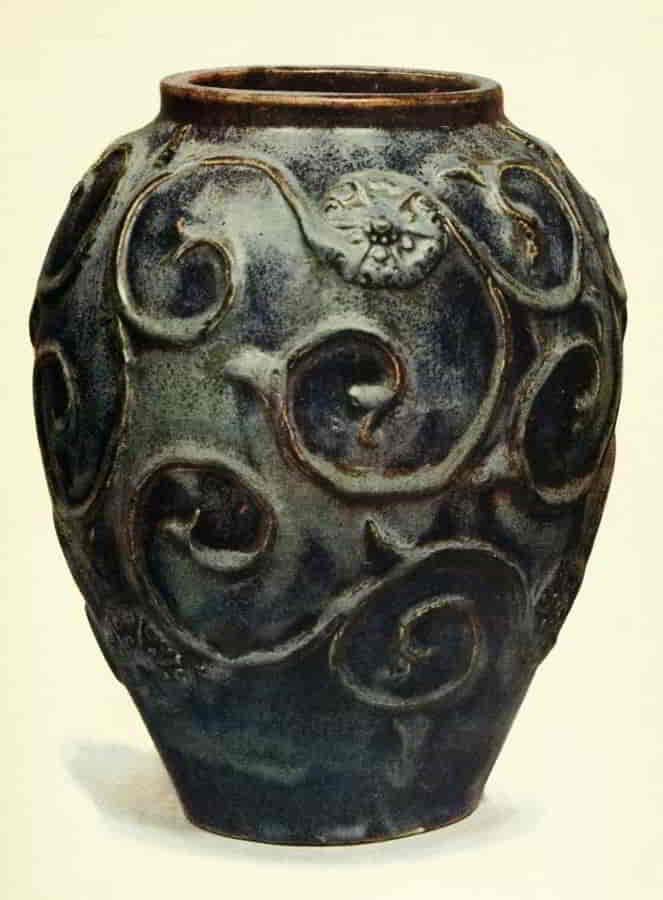
Brinkley[385] describes several additional types of Kuang yao, including a buff stoneware with "creamy crackled glaze of t´u Ting type."[386] "The characteristic type is a large vase or ewer[387] decorated with a scroll of lotus or peony in high relief and having paint–like, creamy glaze of varying lustre and uneven thickness, its buff colour often showing tinges of blue." Vases of similar make seem also to aim at copying the red–splashed lavender glazes of the Chün and Yüan wares, and sometimes the colour is very beautiful, but the glaze has distinctive characteristics (see Plate 48, Fig. 2). It is opaque, and lacks the translucent and flowing character of the originals, and the surface has a peculiar sticky lustre, and something of that silken sheen which distinguishes the Canton[171] and Yi–hsing glazes of this class. The crackle, too, is more open and obvious. Some of these pieces have the appearance of considerable antiquity, and are reputed to date back to Sung times.[388] Midway between these and the familiar mottled Canton stoneware come what are known in China as the Fat–shan Chün.[389] Their obvious intention to imitate the old Chün wares is declared by the appearance of numerals incised in Chün Chou fashion under the base. A typical example (see Plate 51) is a high–shouldered flower vase with short neck and small mouth (not a Sung but a Ming form, be it noted), with thick, rolling, crackled glaze of pinkish cream colour, shading into lavender and flushing deep red on the shoulders. In rare instances the crimson spreads over the greater part of the surface. The biscuit at the base is brownish grey if its light tint is not concealed by a wash of dark clay. The glaze, unlike that of the type described by Brinkley, is fairly fluescent, thin at the mouth, and running thick in the lower levels. Other examples of this class have heavily mottled grey or blue glazes nearer in style to the Canton stoneware. Indeed, they are clearly made at the same factory as the latter, for we have a connecting link between the two groups in a vase in the Eumorfopoulos Collection, a tall cylinder with streaky lavender blue glaze and the usual silken lustre, the base of buff colour washed with brown slip and marked with the square seal of Ko Ming–hsiang. Many of these "Fat–shan Chün" wares are exceedingly attractive, but by far the most beautiful are the rare dishes in which the glaze has been allowed to form in deep pools of glass in the centre.[390] In these pieces all the changing tints of the surrounding glaze are concentrated in the cavity in a crystalline mass of vivid colour. Such wares are, I think, not older than the Ch´ing dynasty, though they have been erroneously described by some writers as Sung.[391]
With regard to the dates of the Fat–shan Chün types, the remarks made on the Canton stoneware apply equally to them. Many are frankly modern; the finer pieces may be assigned to the eighteenth century, and a few perhaps go back to the Ming dynasty. From the current name we infer that they are made at Fat–shan, but this is the only evidence existing on the question. Fat–shan is situated a few miles south–west of Canton with which it is connected by railway. It is a large town, "renowned for its vast silk manufactures, cloth–making, embroidery, cutlery, matting, paper, and porcelain."[392] No doubt the word porcelain in this context is a comprehensive term, and includes stoneware and pottery, if, indeed, it means anything else. But the precise provenance of the various kinds of Kuang yao is far from clear. All that we learn from the T´ao lu is that the Kuang yao originated at Yang–chiang. Probably the type of mottled glaze which characterises the Canton stoneware was first made there, and was afterwards adopted in the factories which sprang up in the neighbourhood of Canton. Other localities in the province of Kuangtung in which the ceramic industry is represented include Chao–Ch´ing Fu,[393] which may be only a trading centre for the wares; Shih–wan, in Po–lo Hsien, a few miles east of Canton, which is said[394] to supply the Canton markets with "pots, dishes, and jars of every needed shape and size, some of the latter as large as hogsheads, glazed and unglazed, together with a large variety of imitation grotto work and figures for gardens, gallipots, little images, etc."; and the prefecture of Lien–chou, in the extreme south of the province, which exports its wares from Pak–hoi. A few specimens bought in the neighbourhood of the Shih–wan potteries, and no doubt of local make, are in the British Museum. They consist of lion joss–stick holders, crab–shaped pots for growing lily bulbs, and small figures of a hard, rough stoneware of buff or drab colour. The bulb pots have an opaque green glaze with passages of transparent flambé colours, not unlike the Yi–hsing or Canton Chün glazes, and the other pieces have washes of the thin, translucent green, turquoise, yellow, and purplish brown glazes which are usually applied on the biscuit of pottery or porcelain. The exhibits at the Paris Exhibition[395] in 1878 included "tea jars, tobacco pots, medicine jars, cassolettes, various pots, plates, sauce vessels, rice bowls, wine and rice cups, spoons, bird–cage pots, mortars, candlesticks, crucibles and lamps" from the Pak–hoi district.
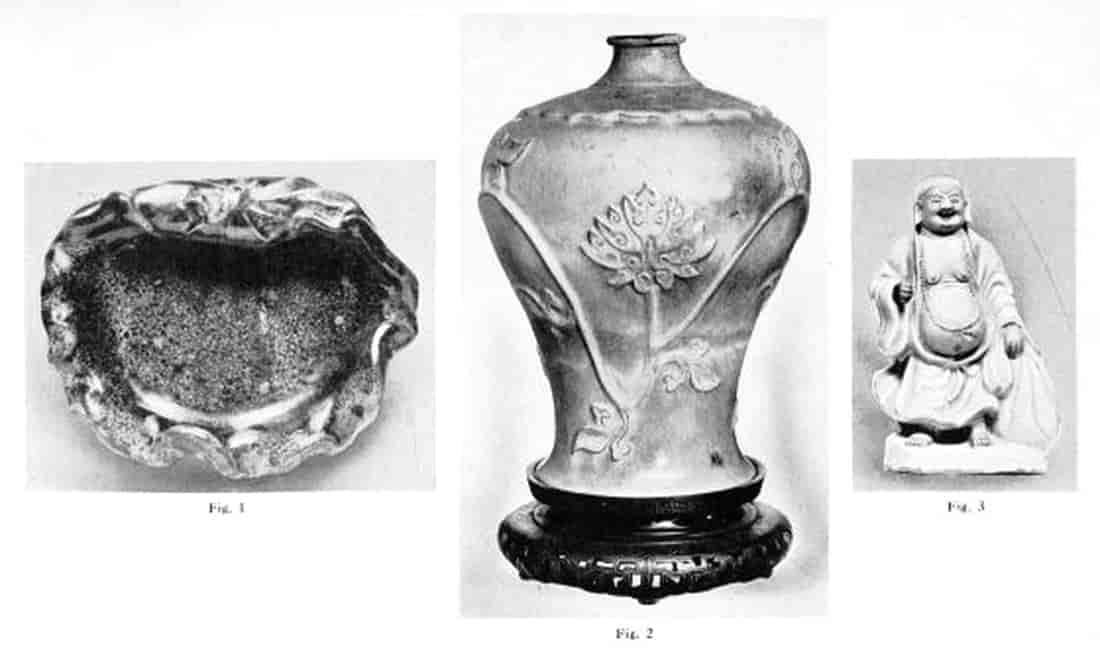
Plate 48.—Kuangtung Ware.
Fig. 1.—Dish in form of a lotus leaf, mottled blue and brown glaze. About 1600. Diameter 8 14 inches. British Museum.
Fig. 2.—Vase with lotus scroll in relief, opaque, closely crackled glaze of pale lavender grey warming into purple. (?) Fourteenth century. Height 7 78 inches. Peters Collection.
Fig. 3.—Figure of Pu–tai Ho–shang, red biscuit, the draperies glazed celadon green. Eighteenth century. Height 8 14 inches. British Museum.
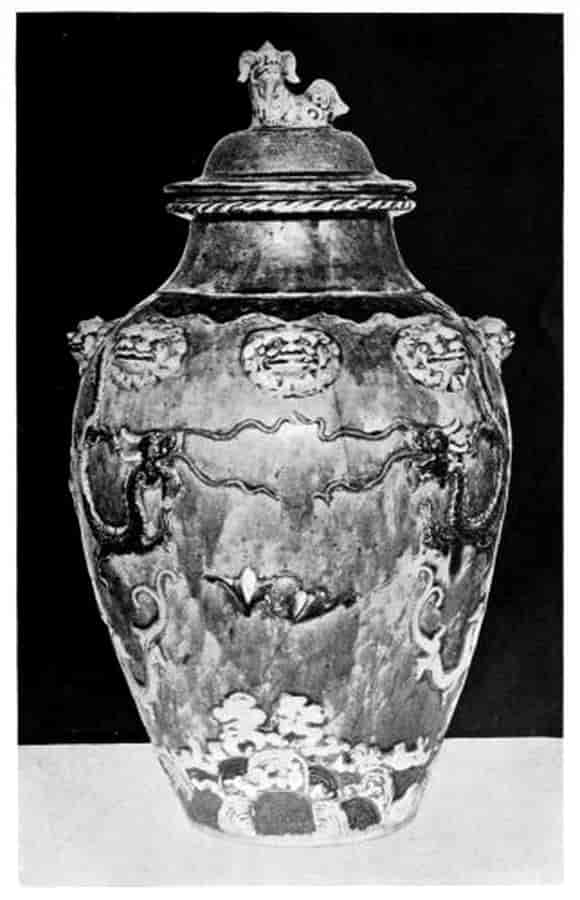
Plate 49.—Covered Jar of Buff Stoneware.
With cloudy green glaze and touches of dark blue, yellow, brown and white; archaic dragons, bats and storks in low relief; border of sea waves. Probably Kuangtung ware, seventeenth century. Height 33 inches.
Eumorfopoulos Collection.
CHAPTER XV
YI–HSING  WARE
WARE
THE potteries at Yi–hsing Hsien, in the prefecture of Ch´ang–chou, in Kiangsu, at no great distance from Shanghai, have long been celebrated for elegantly shaped teapots of unglazed stoneware in red and other colours. They have, in fact, been honoured with a special book, the Yang–hsien ming hu hsi,[396] or "Story of the teapots of Yang–hsien" (an old name for Yi–hsing), written in the seventeenth century[397]; but though extracts from this work occur in the T´ao lu and elsewhere, I have been unable to get access to any copy of the original. This deficiency, however, has been made good by an important translation given by Brinkley[398] of a short Japanese work which, he says, "owes nothing to Japanese research, being merely transcribed from Chinese annals." The legendary story of the discovery of the all–important clay deposits in Mount Tao–jung Shu–shan is followed by a description of the chief varieties of this material which include light yellow clay for mixing; another, yellow clay called shih huang (stone yellow) which turned to cinnabar red in the firing; a blue clay which turned to dark brown; a clay which produced a "pear skin" colour; a light scarlet clay which produced a pottery of the colour of pine spikelets; a light yellow clay making a green ware; and another producing a light red pottery. The "pear skin" clay mixed with white sand formed a material of a light ink brown colour.
With these materials, and with their conspicuous skill in blending clays, it may well be imagined that the Yi–hsing potters were able to make innumerable varieties in their ware. The commonest shades, however, are deep and light red, chocolate brown, buff, drab and black brown; occasionally the clays are speckled—e.g. buff ware with blue specks—or powdered with minute particles[175] of quartz, and frequently two or more clays are used in contrasting tints on the same piece. The body of the ware is sometimes soft enough to powder under the knife, but as a rule it is a very hard stoneware, capable of receiving a fine polish on the lapidary's wheel. The choicest teapots are unglazed, though often a sort of natural gloss has formed on the surface in the kiln.
But to continue the history of the factories as outlined in Brinkley's translation, we are told that the first maker of "choice utensils of pottery for tea–drinking purposes" was a priest of the Chin–sha temple about thirteen miles south–east of Yi–hsing, and that the first really great Yi–hsing potter was Kung Ch´un  who flourished in the Chêng Tê period (1506–1521). Though it would appear that Kung Ch´un, while attending his master Wu I–shan at the Chin–sha temple, surreptitiously learnt the secrets of the priest, his fame completely eclipsed that of his teacher, and he is usually venerated as the founder of the Yi–hsing potteries. His pots are described as being "hand made, and in most of them thumb–marks are faintly visible. Generally their colour is that of a chestnut, and they have a subdued lustre like oxidised gold. Their simplicity and accuracy of shape are inimitable; worthy to be ascribed to divine revelations."
who flourished in the Chêng Tê period (1506–1521). Though it would appear that Kung Ch´un, while attending his master Wu I–shan at the Chin–sha temple, surreptitiously learnt the secrets of the priest, his fame completely eclipsed that of his teacher, and he is usually venerated as the founder of the Yi–hsing potteries. His pots are described as being "hand made, and in most of them thumb–marks are faintly visible. Generally their colour is that of a chestnut, and they have a subdued lustre like oxidised gold. Their simplicity and accuracy of shape are inimitable; worthy to be ascribed to divine revelations."
Supernatural qualities form the only point in common between this description and that of the two teapots figured in Hsiang's Album,[399] and confidently assigned to Kung Ch´un. One of these is a drab ware and of hexagonal shape, which appears to have been formed in a mould; the other is in the form of a wine ewer and of vermilion red; and both are stated to have the wonderful quality of changing colour when filled with tea. In fact, in the second illustration the artist has depicted this phenomenon, the pot being vermilion red above and green below the tea–line. The price of these two pots in the sixteenth century was no less than 500 taels or ounces of silver.[400] Brinkley's translation gives a considerable list of Yi–hsing potters who made a reputation in the Ming dynasty, but as the characters are not added it does not always help us to identify the names,[401] among the potter's marks, and in [176]most cases the characteristics assigned to them are entirely vague. We learn, for instance, that one man's "forte was beauty of decoration," and that three others were "renowned for the excellence of their pottery." On the other hand, it is important to read that Tung Han in the Wan Li period (1573–1619) was "the first potter who ornamented the surface of the Yi–hsing ware with elaborate designs in relief," and that many of the pieces designed by Ch´ên Chung–mei,[402] who had formerly been a porcelain maker, "such as perfume boxes, flower vases, paper weights, and so forth, show singularly fine moulding and chiselling. His vases were shaped in the form of flowers, leaves, and fruits, and were decorated with insects. His dragons sporting among storm–clouds, with outstretched claws and straining eyes; his statuettes of the goddess Kuanyin, her features at once majestic and benevolent—these are indeed wonderful productions, instinct with life." This passage shows, at any rate, that in the Ming period the Yi–hsing potters did not confine their attention to tea wares. Perhaps the most celebrated Yi–hsing potter was Shih Ta–pin, who followed in the footsteps of the great Kung Ch´un, and eventually surpassed him.
Brinkley's translation gives us very precise views of what the true form of the teapot should be. It should be small, so that the bouquet of the tea be not dispersed, and every guest should have a pot to himself. It should be shallow, with a cover which is convex inside; and it is very important that the spout should be straight. Crooked spouts were very liable to become obstructed by the tea leaves. "One drinks tea for pleasure, and one may justly feel irritated if the beverage declines to come out of the pot." The true form of teapot, we are told, began with Kung Ch´un, from which one infers that the tea bowls of the T´ang and Sung usage were in vogue up to his time. But the correct shape once established, the Yi–hsing potters soon began to take liberties with it, and to twist it into all manner of fanciful forms, such as fruits (persimmon, pomegranate, finger citron), the leaf or the seed–pod of the lotus, creature forms such as fish leaping from waves, a phœnix, and innumerable other quaint shapes, always skilfully modelled and often of high artistic merit.
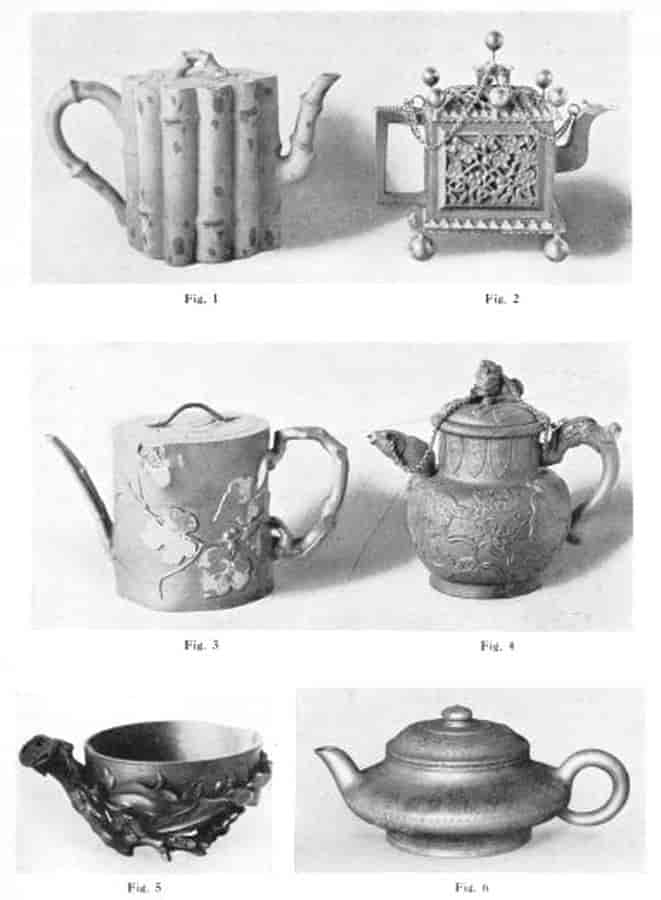
Plate 50.—Yi–hsing Stoneware, sometimes called Buccaro.
Figs. 1–4.—Teapots in the Dresden Collection, late seventeenth century. (1) Buff with dark patches. Height 5 inches. (2) Red ware with pierced outer casing. Diameter 5 12 inches. (3) Black with gilt vine sprays. Height 4 12 inches. (4) Red ware moulded with lion design. Height 4 34 inches. Fig. 5.—Peach–shaped water vessel, red ware. Diameter 4 18 inches. Dresden Collection. Fig 6.—Red teapot, moulded design of trees, etc. Inscription containing the name of Ch´ien Lung. Diameter 4 12 inches. Hippisley Collection.
The ware, as already stated, is chiefly red, dark and light, chocolate brown, buff, and drab, and it is usually without glaze. The decoration consists of: (1) Engraved designs, cut in the ware while it was still soft. These are usually inscriptions of a poetic nature, great importance being attached to the calligraphy. Indeed, we are told that "some of the potters of Yi–hsing owed their reputation chiefly to their skill in carving inscriptions. Such a man was Chan–chien, whose style of writing has been much imitated by modern artists. Another was Ta–hsin, who was employed by Shih Ta–pin to write inscriptions, and who was such a master of penmanship that his inscriptions have been carefully transcribed and are used by connoisseurs as a standard of excellence." (2) Low reliefs, either formed in the teapot mould or separately stamped out and stuck on. Occasionally gilding is found on these, but it is probably a European addition. (3) Stamped diapers of key fret, and other familiar patterns, usually forming the background for relief ornament or borders. (4) Openwork designs applied in panels over an inner lining which was usually washed with a light–tinted clay. The pierced work is commonly of floral design, often the prunus, bamboo and pine pattern, and on dishes and saucers it has no backing but is left à jour. All these methods of ornament are found on the examples which reached Europe at the end of the seventeenth century, and they supplied designs for the European potters of that period. (5) A later type of ornament consists of opaque coloured enamels in painted designs or as ground–colours completely hiding the surface of the ware. The colours are always of the famille rose variety, including opaque pink,[403] and I do not know of any example which suggests an earlier date than Ch´ien Lung (1736–1795). Most, indeed, appear to be nineteenth century.
In addition to these, certain less familiar styles of ornament are found on the smaller objects, such as the heads of opium pipes, which are beautifully made and tastefully decorated. The red ware is sometimes coated with a transparent glaze of yellowish tint, giving a surface of warm reddish brown, exactly similar to [178]the eighteenth century Astbury ware of Staffordshire; or, again, it is polished on the lapidary's wheel like the Böttger ware of Dresden. Inlaid designs in fine white clay and marbling are further varieties; and occasionally coloured glazes of great beauty occur. But these will be discussed presently.
There is no limit to the variety of articles made by the Yi–hsing potters, but they chiefly excelled in small and dainty articles for the writing–table, the toilet, and the tea–table, and personal ornaments. Their tea wares have always been highly prized in Japan, where they have been cleverly copied in Banko ware and by the Kioto potters. Similarly, when tea–drinking became an institution in Europe in the last half of the seventeenth century, and the East India companies set themselves to supply the necessary apparatus from China, the Yi–hsing red teapots became fashionable, and were immediately imitated by enterprising potters. The Dutch and English seem to have been the first to succeed in this new departure, and we read that Ary de Milde and W. van Eenhorn, of Delft, applied for a monopoly of the manufacture in Holland in 1679, while John Dwight, of Fulham, included the "Opacous, redd and Dark coloured Porcellane or China" in the patent taken out in London five years later. The brothers Elers, of Dutch extraction, started the industry in Staffordshire about 1693, and made red stoneware teapots scarcely distinguishable from the Chinese, and which sold for a guinea a piece.
The Yi–hsing wares in the celebrated Chinese ceramic collection formed by Augustus the Strong at Dresden supplied designs for the fine red stoneware made in the first years of the eighteenth century by Böttger, who also discovered the secret of true porcelain in Europe and founded the famous Meissen porcelain factory.
From the earliest days of their importation the Yi–hsing wares have been known in Europe, especially in Italy, Spain, and Portugal, by the Portuguese name of buccaro. The true buccaro is a scented pottery, first imported from Central and South America, where it was made by the Indian population and afterwards manufactured in Portugal and Spain; and Count Lorenzo Magalotti, who wrote in 1695, protested against the application of the name "to certain unglazed pieces of Oriental origin," asserting that "true Buccaro never came from China or Japan, and that they must not be looked for out of the pottery sent over from Central America[180] or the Portuguese imitations."[404] But the protests of purists were unavailing, and buccaro seems to have become a regular term for unglazed pottery, even the archaic black ware from the Etruscan tombs receiving the name of buchero nero.
PLATE 51
Two Vases with glaze imitating that of the Chün Chou wares: in the Eumorfopoulos Collection.
Fig. 1.—Vase of Fat–shan (Kuangtung) Chün ware. Late Ming. Height 9 34 inches.
Fig. 2.—Bottle–shaped Vase, the base suggesting a lotus flower and the mouth a lotus seed–pod, with a ring of movable seeds on the rim. Thick and almost crystalline glaze of lavender blue colour with a patch of crimson. Yi–hsing Chün ware of the seventeenth century. Height 9 34 inches.
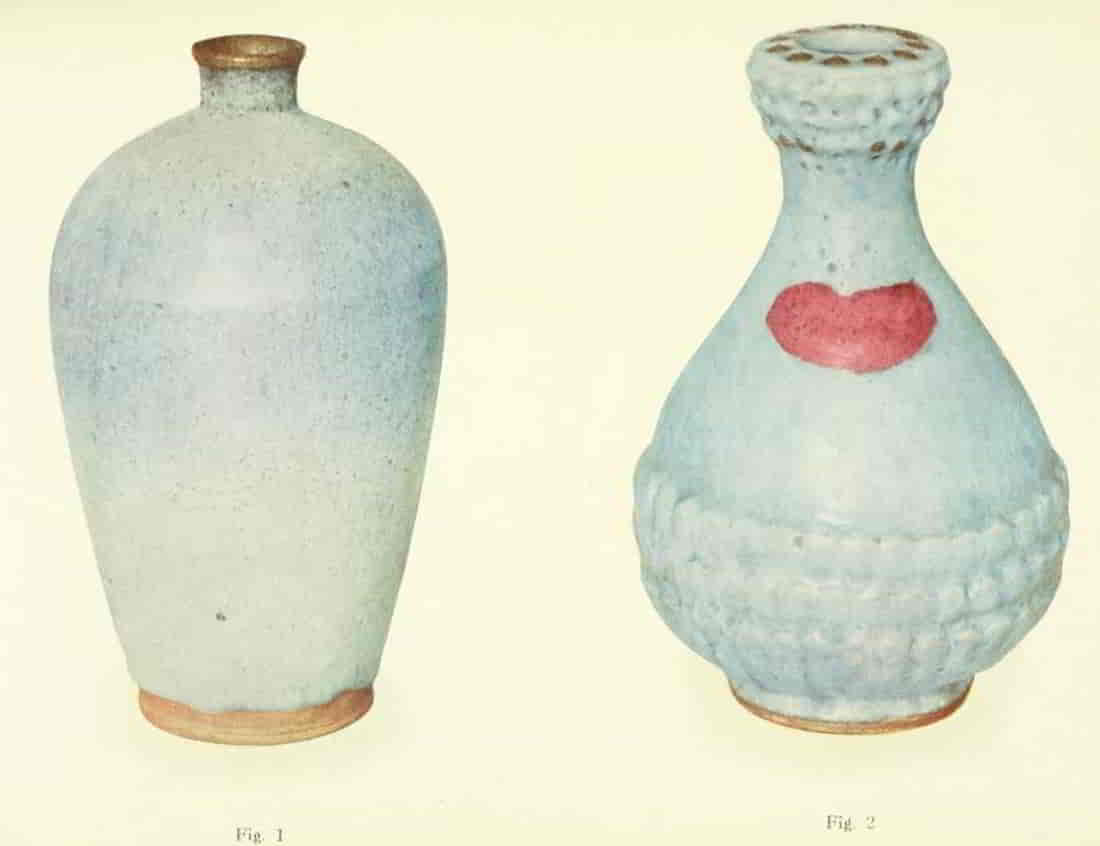
Another important group of Yi–hsing wares presents an entirely different aspect, and indeed it is little understood in Europe, though it is probably bought by unwary collectors for the Sung types which it purports to imitate. This is the Yi–hsing Chün, to which allusion has already been made in discussing the imitation Chün wares. The traditions of this manufacture go back to the Ming dynasty, when a potter named Ou  gained a great reputation for his glazes, which "copied the Ko ware in crackle and the Kuan and Chün wares in colour."[405] This is, no doubt, the manufacture mentioned in the Po wu yao lan in the passage dealing with Chün yao: "At the present time (i.e. 1621–1627), among the recent manufactures this kind of ware is all made with the sandy clay (sha t´u) of Yi–hsing as body; the glaze is rather like the original, and in some cases beautiful, but it does not wear well."
gained a great reputation for his glazes, which "copied the Ko ware in crackle and the Kuan and Chün wares in colour."[405] This is, no doubt, the manufacture mentioned in the Po wu yao lan in the passage dealing with Chün yao: "At the present time (i.e. 1621–1627), among the recent manufactures this kind of ware is all made with the sandy clay (sha t´u) of Yi–hsing as body; the glaze is rather like the original, and in some cases beautiful, but it does not wear well."
Though the original glazed wares of Ou are probably rarer to–day than their Chün Chou prototypes, there is no reason to suppose that Ou´s successors have not kept up the continuity of the manufacture. It is certainly very much alive to–day, and an early eighteenth century reference to "the applied glaze of Yi–hsing"[406] seems to imply its existence at that time. I have [182]before me as I write a tripod incense burner of archaic form, the body a light buff stoneware and the glaze a deep lavender, breaking into blue. It is a thick and rather opaque glaze, sufficiently flowing to have left the upper edges almost bare and formed thickly on the flatter and lower levels; the colour is broken by streaks and clouding, which mark the downward flow of the glaze; the surface has a barely perceptible crackle, which will no doubt become more marked with age, and a subdued lustre between the brilliancy of the old opalescent Chün types and the viscous, silken sheen of the Canton glazes[407] which also imitate them. The colour and glaze are distinctly attractive, and have much in common with the old Chün glazes, and though this is a frankly modern piece, it shows the potentialities of the ware. Similar specimens made, say, a hundred or two hundred years ago, and proportionately aged by time and usage, might well cause trouble to the collector.
There are, besides, quantities of common glazed pottery made at Yi–hsing in the present day, and probably for a considerable time back, which has no mission to imitate the antique. Many of the modern ginger pots are said to come from this locality, and their glazes—some with clear colours (yellow, green, or purple), others opaque and clouded, often covering moulded ornament in low relief—may help us to identify kindred types of glaze on pieces which are more ornamental and perhaps much older. But pottery, as distinct from porcelain and the finer stonewares, has never commanded much interest in China, and it has never been systematically collected and studied. The result is that it is extremely difficult to place the various types which appear from time to time except in large and ill–defined groups. A series of typical pieces of modern Yi–hsing pottery, for instance, would no doubt be of the greatest value in identifying the rather older wares made in the same place under similar traditions, but no one in Europe[408] has thought it worth their while to form one.
I have noticed that a certain type of glazed pottery is distinguished by a concave base which serves instead of the usual hollowed–out[183] foot and foot rim, and by a glaze which stops a little short of the base in an even, regular line which is quite distinct from the wavy glaze line of the Yuan and earlier wares. A jar of this type in the British Museum has a typical Yi–hsing glaze, and though this is not perhaps sufficient ground for generalising, I would suggest that this peculiar finish is an indication of Yi–hsing manufacture.
CHAPTER XVI
MISCELLANEOUS POTTERIES
IN addition to the factories which have received individual notice, there are numerous others which are only names to us; and, on the other hand, there is a host of nameless wares which have reached Europe at various times and through divers channels, and are now awaiting classification with very little chance of being definitely located. A consideration, however, suggested by the Chinese Commercial Guide[409] may help towards the grouping of these miscellaneous wares. We are told that the charges for freight forbid the wares to be carried far in the ordinary way of internal trade, and that manufactures of pottery are numerous, supplying the local needs. Now the number of ports open to foreign trade in China is limited, and in the past the sea trade was of far smaller volume, and was concentrated in a few of the southern coast towns. Consequently, in dealing with pottery which we may assume to have been brought by the export trade to Europe, it will be necessary for general purposes to take account only of the factories in the neighbourhood of the seaports in question. These will be found to be almost entirely in the southern half of China.
Thus, starting from the south and following the coast line, we come first to the potteries which supplied Pak–hoi and Canton, and we may assume that Hongkong and Kowloon would be supplied from the neighbourhood of Canton. These have already been discussed, and we can pass on to Swatow, which would draw supplies from the Ch´ao–chou Fu potteries. This neighbourhood furnished an exhibit to the Paris Exhibition of 1878, consisting of "tea jars, tobacco jars, braziers and pots, lamps, tiles, flower pots, fruit jars, spoons, vases of various sorts, figures, dishes, cups and saucers, and spittoons."
PLATE 52
Wine Jar with Cover and Stand. Fine stoneware with ornament in relief glazed green and yellow in a deep violet blue ground. Four–clawed dragons ascending and descending among cloud–scrolls in pursuit of flaming pearls; band of sea–waves below and formal borders including a ju–i pattern on the shoulder. Cover with foliate edges and jewel pattern, surmounted by a seated figure of Shou Lao, God of Longevity. About 1500 A. D.
Height 22 12 inches. Grandidier Collection, Louvre.
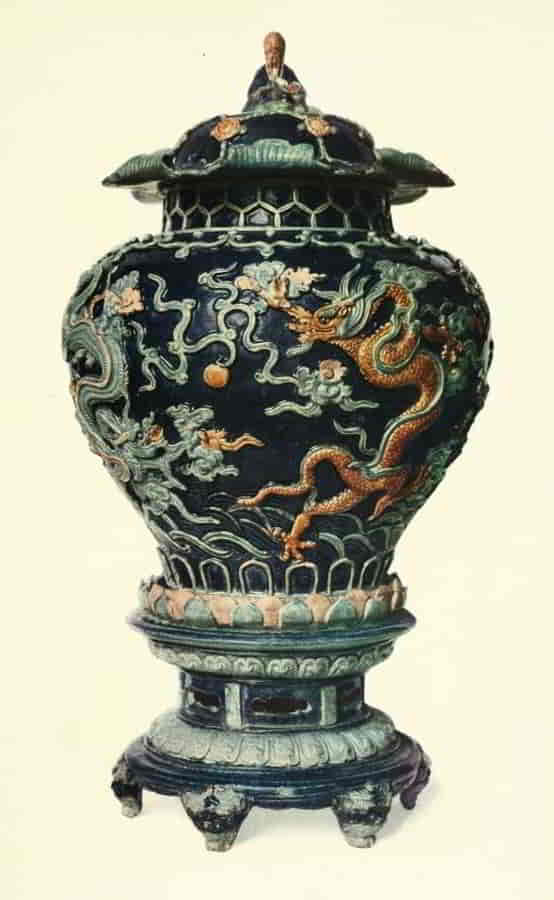
At the same exhibition, Amoy, to which we come next, was represented by "dishes, rice bowls, wine cups, saucers and spoons, preserve jars, wine bottles, etc., in common porcelain," besides tiles of various kinds, which implies the manufacture of pottery as well. These wares, we are informed in the catalogue, are largely exported to Saigon, Siam, Manilla, etc.; a statement confirmed by the Chinese Commercial Guide,[410] which adds India, the Archipelago, and the southern provinces. This is interesting in view of the quantities of coarse china, blue and white[411] and coloured, which is brought from these parts by collectors who take its crude appearance as evidence of age. The factories are located at Pa–kwoh, a village near Shih–ma, which lies between Amoy and Chang–chou Fu. Tung–an Hsien in the same neighbourhood is also named as a pottery centre.
There are several important factories within easy reach of Shanghai. Those at Yi–hsing have been discussed at some length, but there is another large centre of the industry on the east side of the Lake T´ai–hu opposite to Yi–hsing. This is Su Chou  , which, according to the catalogue of the Paris Exhibition, was still celebrated for its pottery in 1878. But the reputation of Su Chou does not rest on its modern achievements. Its name occurs frequently in the pottery section of the great encyclopædia (compiled by order of the Emperor K´ang Hsi) as one of the prominent pottery centres in the Ming dynasty. Tiles for the palaces and temples of Nanking were made there, and vases and wine vessels for the Imperial Court. The nature of these last can be guessed from a hint given in one passage of the encyclopædia[412]: "At Su Chou iron rust (hsiu) and other materials are used for the yellow wares. For the vessels with dragon and phœnix destined for Imperial use, a resinous substance[413] and cobalt blue[414] are used."
, which, according to the catalogue of the Paris Exhibition, was still celebrated for its pottery in 1878. But the reputation of Su Chou does not rest on its modern achievements. Its name occurs frequently in the pottery section of the great encyclopædia (compiled by order of the Emperor K´ang Hsi) as one of the prominent pottery centres in the Ming dynasty. Tiles for the palaces and temples of Nanking were made there, and vases and wine vessels for the Imperial Court. The nature of these last can be guessed from a hint given in one passage of the encyclopædia[412]: "At Su Chou iron rust (hsiu) and other materials are used for the yellow wares. For the vessels with dragon and phœnix destined for Imperial use, a resinous substance[413] and cobalt blue[414] are used."
In the Hsüan Tê period (1426–1435), Su Chou was noted for [188]the manufacture of artistic pots for holding fighting crickets. In reference to these we are informed in the T´ao shuo (see Bushell, op. cit., p. 140) that "those fabricated at Su Chou by the two makers named Lu  and Tsou
and Tsou  were beautifully moulded, and artistically carved and engraved, and the pots made by the Elder and the Younger Hsiu
were beautifully moulded, and artistically carved and engraved, and the pots made by the Elder and the Younger Hsiu  , two daughters of Tsou, were the finest of all. At this time fighting crickets was a favourite pastime, and hundreds and thousands of cash were staked upon the event, so that they did not grudge spending large sums upon the pots, which were decorated in this elaborate way, and consequently far surpassed the ordinary porcelain of the period."
, two daughters of Tsou, were the finest of all. At this time fighting crickets was a favourite pastime, and hundreds and thousands of cash were staked upon the event, so that they did not grudge spending large sums upon the pots, which were decorated in this elaborate way, and consequently far surpassed the ordinary porcelain of the period."
The large and important potteries at Po–shan Hsien  in the Ch´ing–chou Fu, in Shantung, were represented only by a small exhibit at the Paris Exhibition of 1878, consisting of "a bottle of glazed pottery, three tea jars in red ware, ten specimens of glazed pottery, a brazier in terra cotta, and seven crucibles." Laufer tells us that these potteries date back to Sung times, and have preserved the old traditions of manufacture. The district is also noted for its glass, enamels and glazing materials, but it is situated inland, and not conveniently near any of the treaty ports.
in the Ch´ing–chou Fu, in Shantung, were represented only by a small exhibit at the Paris Exhibition of 1878, consisting of "a bottle of glazed pottery, three tea jars in red ware, ten specimens of glazed pottery, a brazier in terra cotta, and seven crucibles." Laufer tells us that these potteries date back to Sung times, and have preserved the old traditions of manufacture. The district is also noted for its glass, enamels and glazing materials, but it is situated inland, and not conveniently near any of the treaty ports.
In the early days of the European trading companies, pottery, as distinct from porcelain, does not seem to have received much attention from the merchants, and we may fairly assume that most of the earthenwares which reached Europe before the last century hailed from the neighbourhood of Canton or from Yi–hsing and the Shanghai district. But long before the first European vessels reached the coasts of China, Arab and Chinese merchantmen had carried cargoes of pottery and coarse porcelain to the Philippines, the East Indian Archipelago, the Malay Peninsula, Siam, Ceylon, and India. The Arabs had a trading station in Canton in the eighth century, and Chinese junks sailed from Canton and the Fukien ports in the Sung, Yüan, and Ming dynasties. A Chinese account of the sea trade in the twelfth and thirteenth centuries may be read in the work of Chao Ju–kua,[415] and it will be found from this book and from Marco Polo's accounts that Ch´üan–chou Fu on the Fukien coast was a busy centre of foreign trade in the Sung and Yüan periods. Hirth[416] has traced the probable route by which [189]the Lung–ch´üan celadons reached this port for shipment, and doubtless the other wares, including coarse white porcelain, stonewares and pottery, which are found in the Philippines and Borneo (to name only two of many localities) were largely supplied from the Fukien potteries. Many of these wares are of undoubted antiquity, and some of the types are unknown in China to–day. They may have been made solely for export, but in any case their disappearance in China is quite intelligible. For even in the eighth century the merchants were forbidden[417] to export "precious and rare articles," and most of these trade goods are of coarse make and unlikely to be preserved by the Chinese at home.
On the other hand, the natives of the Philippines and the Dyaks of Borneo have preserved these old potteries with scrupulous care. The various types of jars have been christened with special names[418] alluding to their form or decoration; they have been credited with supernatural powers; and numerous legends have grown endowing them with life and movement, power of speech, and influences malevolent or benign.
A good collection of these pots would be of considerable interest, but the value attached to them by their native owners is out of all proportion to their intrinsic worth, and makes them difficult to procure. An important series, however, of the Philippine jars has been formed by the Field Museum at Chicago, and they are described with full illustration in one of the excellent publications of that institution.[419] Among other things we are told that "every wild tribe encountered by the writer in the interior of Luzon, Palawan, and Mindanao possesses these jars, which enter intimately into the life of the people. Among many the price paid by the bridegroom for his bride is wholly or in part in jars. When a Tinguian youth is to take his bride, he goes to her house at night, carrying with him a Chinese jar which he presents to his father–in–law. The liquor served at ceremonies and festivals is sometimes contained in these jars, while small porcelain dishes contain the food offered to the spirits."[420]
A general similarity in form is noticeable in the Philippine[190] jars, an ovoid body more or less elongated being common to all, while the neck varies a little in its height and width. A series of loop handles or pierced masks on the shoulder, to hold a cord for suspension, is a constant feature. The older types, which are said to date back to a period ranging from the thirteenth to the fifteenth century, are frequently decorated with one or two large dragons coiling round the sides, and either modelled in low relief or incised in the body. Others are quite plain, and the glazes include black, brown, dark green, and a brownish yellow of varying depth. A later group, not older than the end of the Ming dynasty, is without ornament, but coated with single–colour or variegated glazes of the Canton and Yi–hsing types—e.g. speckled blue with green flecks, green with blue streaks and lines, blue and green mottled and crackled, light bluish green—the glaze often ending short of the base in an even line, which is, perhaps, characteristic of Yi–hsing.
The British Museum has a small series from Borneo, which includes, among the older types of pottery, a jar with black–brown glaze and bands of cloud design and stiff leaves deeply incised, and an ovoid jar with many loop handles on the shoulders, two dragons in relief, and a ground of incised wave pattern all covered with a yellowish brown glaze which ends in a regularly waved line some way short of the–base. Of later make is a jar with translucent purplish brown glaze, and four circular panels with figure ornament in low relief glazed green, a type described by the Japanese as "Old Kochi."[421] There are, besides, a jar with roughly painted blue dragon designs under a crackled white glaze, the ware being a coarse porcellanous stoneware; another with enamel colours in addition to the underglaze blue including the rose pink which is not older than the eighteenth century; and another type with rough stoneware or earthen body covered with a crackled, greyish white enamel of putty–like surface on which enamel colours are coarsely painted. The typical jar which the island natives so highly prize is of the ovoid form with a number of loop handles on the[192] shoulder and dragons in relief.[422] An unusually ornate example is shown on Plate 49. It has a cloudy green crackled glaze with dragons of both the ordinary and the archaic kind, besides storks and a bat in low relief, and there are touches of dark blue and yellow, white and brown in the glaze. It is probably of Canton make and not older than the seventeenth century. In modern times jars are made in Borneo itself by the Chinese in the coast towns.
PLATE 53
Vase with chrysanthemum handles: buff stoneware with chrysanthemum design outlined in low relief and coloured with turquoise, green and pale yellow glazes in a dark purple ground. About 1500 A. D.
Height 19 12 inches. Eumorfopoulos Collection.
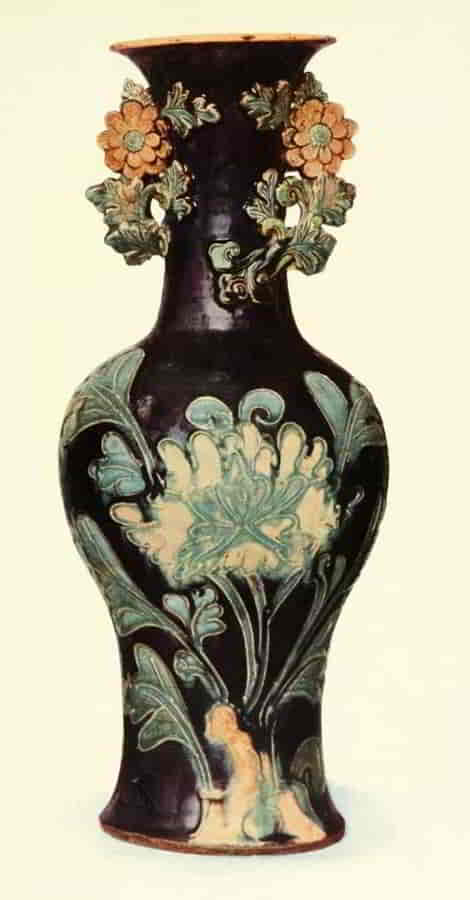
A certain amount of Chinese pottery found its way, like the celadon porcelains in early times, by the caravan routes into Turkestan, India, Persia, and Western Asia. Such wares would be more naturally drawn from the potteries in Honan, Chihli, and the north–western provinces, and it is not surprising that the fragment found by Sir Aurel Stein in the buried cities of Turkestan should have included the brown painted wares of Tz´ŭ Chou.
But the greatest difficulties in classification are presented by the miscellaneous pottery which collectors have picked up from time to time in China, or antique dealers have sent over to supply the demand created by the increasing interest taken in Chinese pottery by Western amateurs. These come, as a rule, without any hint as to their place of origin, and in most cases it is quite impossible to locate them. There are, however, certain well–defined groups which come together naturally.
One of these is represented by the Tradescant jar in the Ashmolean Museum, Oxford. It was exhibited at the Burlington Fine Arts Club in 1910, and described in the catalogue[423] as "Jar with globular body, short neck, and wide mouth; five loop handles; stoneware covered with a bright green glaze; the ornament consists of floral scrolls in yellow with touches of brown and is in low relief; round the base a formal design. Height, 12 inches." A similar jar is shown on Plate 56, and in the Goff collection in the Brighton Museum is another of the same make, but with the design incised with a point instead of applied in relief. The Tradescant Collection was given to Elias Ashmole in 1659 by John Tradescant. It was formed by the father of the donor, who died in 1627, so that[194] at the lowest computation the antiquity of these wares is fixed in the late Ming period. Another group is represented by Plate 58, Fig. 2. Its characteristics are a comparatively thin buff earthenware body, soft enough to powder under the knife, and a sparing use of brownish yellow, bright turquoise, green[424] and aubergine glazes of the usual crackled type applied direct to the body. The specimens are generally vases or incense burners of curious and archaic forms, with ornament moulded in low relief, the whole bearing the unmistakable signs of a ware which has been pressed in a mould. The inside and bottom of the incense burners are usually unglazed. The colours, as a rule, are pleasing and soft, and it is the common practice to label them indiscriminately Ming. As nothing definite is known of their place of origin, this chronology can only be based on their archaistic appearance, or on the fact that they have the usual "on biscuit" glazes, which seems to be the accepted signal for a Ming attribution. Needless to say, the use of this method of colouring survived the demise of the last Ming emperor, and it is improbable that wares which must be comparatively common in China (judging from the handsome way in which the quite recently created demand for them has been answered) should have a minimum antiquity of two hundred and seventy years.
The fact is that dating of these glazed potteries is as difficult as that of the cognate glazed tiles, and it is as unreasonable to exclude a Ch´ing origin as it would be to exclude a Ming. The balance of probabilities, at any rate, is in favour of the bulk of them being no older than the eighteenth century.
PLATE 54
Vase with lotus handles: buff stoneware with lotus design modelled in low relief and coloured with aubergine, green and pale yellow glazes in a deep turquoise ground. About 1500 A. D.
Height 18 inches. Grandidier Collection, Louvre.
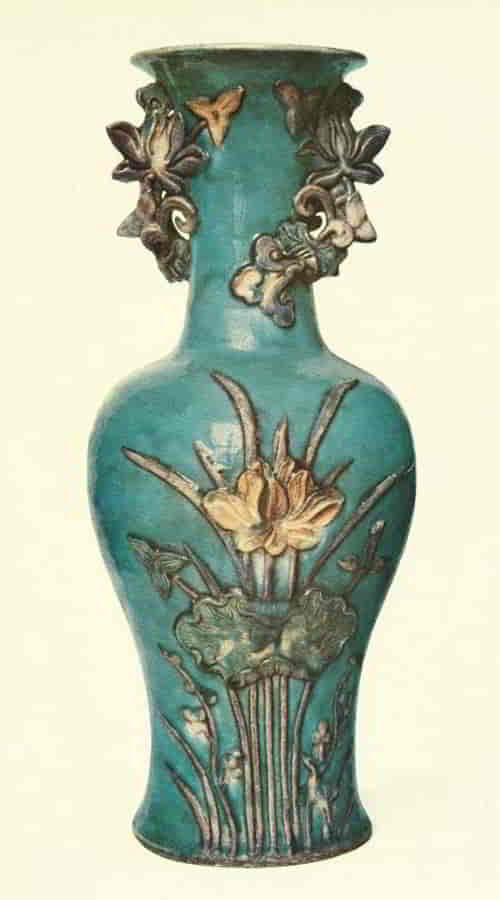
A third group is also consistently labelled Ming, but with better reason, though even here a little more elasticity in the dating is advisable. It has an exact parallel in porcelains of undoubted Ming origin, viz. those represented by Plate 61, etc., which usually take the form of jars and vases with designs outlined in fillets of clay, or channelled or even pierced à jour. The spaces between the outlines are filled with coloured glazes which are fired, in the case of porcelain, in the cooler parts of the biscuit kiln. These are the glazes de demi–grand feu, according to the French definition, and they
[197]consist of turquoise and aubergine purple or violet and green (the three colours or san ts´ai, all minutely crackled), supplemented by a white formed by slip and a thin brownish yellow. Occasionally the purple is so deep as to appear almost black; and the details of the designs are often etched in the paste with a fine point. Precisely similar wares are found with an earthenware body; and they are, no doubt, contemporary with the analogous porcelains, though how long the traditions of this type of ware continued has never been precisely determined. The porcelain on which washes of turquoise and aubergine glaze are combined is a development of this type, and this has certainly survived to comparatively modern times. Reticulated ornament was used on the three–colour pottery vases no less than on the porcelain (Plate 55); and besides the covered wine jars and vases there are figures and grotto pieces of similar style both in pottery and porcelain, many of which must date from Ming times.
Plate 53 illustrates a beautiful vase in the Eumorfopoulos Collection which belongs to a cognate group. It has a buff stoneware body, the ornament is outlined in relief, and the glazes which fill the outlines are very similar to those of our main group, though some of the colours are more transparent and glassy and wanting in the solidity of the latter. The chrysanthemum handles are a frequent feature of the vases of this class, of which a notable instance is in the Salting Collection. Plate 54 illustrates another vase of similar kind, but with lotus handles, lotus designs, and a fine turquoise ground. Of the same type, but less rare, are certain wide–mouthed jars, bowls, and flower pots with bold floral designs, lotuses, etc., outlined in fillets of clay and filled with the same kinds of glaze, the background now turquoise and now aubergine (Plate 58, Fig. 1). The base is usually washed over with a thin purplish brown. These several types were copied in the Japanese Kishiu pottery in the nineteenth century, and though the copies are rarely difficult to distinguish by the eye alone the Japanese glazes (particularly the aubergine) will be found on handling to have a peculiar moist and rather sticky surface. Though no doubt of Ming origin, it is extremely probable that the manufacture of the Chinese bowls and flower pots of this class continued into the last dynasty.
Fig. 2 of Plate 56 exemplifies another kind of pottery with fine white body like pipeclay, and usually with sharply moulded designs[198] in antique bronze style and in the bronze forms of beakers and four–legged incense burners. The glaze is usually leaf green, but it often breaks out into a frothy grey scum, such as is seen on some of the Canton and Yi–hsing glazed pottery. It is a common practice to label these wares as T´ang, but I am inclined to place them in a much more recent period (seventeenth or eighteenth century), and to locate them among the miscellaneous Kuangtung wares, pending further information on the subject.
There are other specimens with a somewhat similar white and relatively soft body material, not glazed but stained with a brownish black dressing of clay, and somewhat recalling bronze. These are usually vases of elegant, well–moulded form, such as Plate 56, Fig. 3, and they are often marked Nan hsiang t´ang.[425] They are, no doubt, of relatively modern make.
Though it would be easy to suggest many possible places of origin for these wares, such speculation can be of no real value without far more definite evidence than we possess at present. Still, it may serve some useful purpose in the future, if not at once, if we add one or two more records, however meagre, to the existing lists of Chinese potteries. The section of the T´u shu, which is devoted to T´ao kung (the pottery industry), mentions the following factories as of some importance in the Ming dynasty. In the province of Honan, in addition to the well–known potteries of Chün Chou and Ju Chou, we read that there was a factory in the Ju–ning Fu at the village of Ts´ai  , which was intermittently active in the first half of the fifteenth century.[426]
, which was intermittently active in the first half of the fifteenth century.[426]
From another passage we learn that in the valleys of Ching[427]  and the hills of Shu (or Szech´uan) there are black and yellow clays suitable for pottery; that the potters had their kilns in holes in the mountains; and that they used the yellow clay for the body of the ware and overlaid it with the black, making jars, drug pots, cauldrons, pots, dishes, bowls, sacrificial vessels, and the like. They also made one kind of ware which resembled that of Chün Chou.
and the hills of Shu (or Szech´uan) there are black and yellow clays suitable for pottery; that the potters had their kilns in holes in the mountains; and that they used the yellow clay for the body of the ware and overlaid it with the black, making jars, drug pots, cauldrons, pots, dishes, bowls, sacrificial vessels, and the like. They also made one kind of ware which resembled that of Chün Chou.
Specimens of modern pottery in the Field Museum, Chicago, include ornamental wares such as pomegranate–shaped water pots, etc., covered with an oily green glaze recalling some of the Sung[199] types. The body is apparently dark coloured, and shows brown at the edges where the glaze is thin. This ware is made at Ch´êng–tu in Szech´uan.
The geographical annals of the province of Shensi are quoted[428] with reference to potteries in the T´ung–chou Fu as follows: "The inhabitants of Lei–hsiang and Pai–shui[429] are good potters, and the porcelains (tz´ŭ ch´i) which they make are of surpassingly clever workmanship. These are what are commonly called lei kung ch´i (vessels of the Lord of Thunder). Some say that the potteries of Hsiang only began to be active when the original wares had ceased to be made. The village of Lei–hsiang is east of Shên Hsien, and it is the place of the temple of the Hsiang family. The inhabitants of the place sometimes dig up castaway Hsiang wares. Their shape and style are archaic; the colour of the ware is green (lü), deep and dark, but brilliant. One kind has slight ornament in raised clay, but if the hand is passed over it, the surface feels smooth and without perceptible relief or indentation.[430] When compared with the Hsüan,[431] Ko and other wares, it may be said to surpass them." The description in the last part seems to apply to the older wares which preceded those made in the district at the time of writing.
The modern potteries at Yo Chou in Shensi are represented in the Field Museum, Chicago, by a black–painted ware in Tz´ŭ Chou style, by a greyish white ware with sketchy blue designs, and by a black slag–like earthenware which is extremely light to handle. It is also suggested that a well known type of pottery, painted with free floral designs in black and white on a creamy glaze which is stained a pinkish brown colour, is an earlier product of the same potteries.
The potteries at Ch´ü–yang Hsien  in the Chên–ting Fu, in Chihli, are mentioned[432] in the administrative records of the Ming dynasty in the Hsüan Tê period, and again under the dates 1553 and 1563, as supplying wine jars and vases for the Court. This place is only a few miles east of Ting Chou, which was celebrated for its white wares in the Sung period, and these references carry the record of the industry in that district to the last[200] part of the Ming dynasty. Unfortunately, nothing is said of the nature of the wares made at this time for the Court.
in the Chên–ting Fu, in Chihli, are mentioned[432] in the administrative records of the Ming dynasty in the Hsüan Tê period, and again under the dates 1553 and 1563, as supplying wine jars and vases for the Court. This place is only a few miles east of Ting Chou, which was celebrated for its white wares in the Sung period, and these references carry the record of the industry in that district to the last[200] part of the Ming dynasty. Unfortunately, nothing is said of the nature of the wares made at this time for the Court.
Reference is made elsewhere (p. 202) to the potteries at Wu–ch´ing Hsien, in the Peking district. Possibly these are the potteries described, by Bushell[433] as still active in modern times. "The ordinary glaze," he remarks, "is a reddish brown of marked iridescence, shining with an infinity of metallic specks, an effective background to the moulded decoration which covers the surface. The designs are generally of hieratic character."
The "sun–stone" glazes made at the Rookwood Potteries (Cincinnati, Ohio, U.S.A.) and on the Lancastrian wares[434] are of this kind, the infinity of metallic specks being due to "super–saturation" of the glaze with iron oxide. A specimen of this modern Peking ware may be seen in the British Museum.
The tile works at Liu–li–chü, near Peking, date back to the Yüan dynasty, and their modern productions as represented in the Field Museum include a pottery with incised designs filled in with yellow, green, and dark aubergine glazes, not unlike in style to the Japanese Sanuki ware. Another type has forms taken from bronzes and is distinguished by a shining green glaze.
In the province of Shantung, besides the tile works at Lin–ch´ing,[435] the important, potteries at Yen–shên Chên  in the Ch´ing–chou Fu are noticed[436] as follows: "The inhabitants have inherited from their ancestors the art of making good pottery. The usual wares are cisterns (kang), jars (ying), cauldrons (fu), and such–like pottery (fou), made without flaw. The profit to the people is not less than that made at Ching–tê Chên on the right bank of the Yangtze." Yen–shên Chên is quite close to Po–shan Hsien, and no doubt the industry at the two places is intimately connected. The latter, which is noted to this day for its manufactures of pottery and glass, has already been mentioned[437] more than once.
in the Ch´ing–chou Fu are noticed[436] as follows: "The inhabitants have inherited from their ancestors the art of making good pottery. The usual wares are cisterns (kang), jars (ying), cauldrons (fu), and such–like pottery (fou), made without flaw. The profit to the people is not less than that made at Ching–tê Chên on the right bank of the Yangtze." Yen–shên Chên is quite close to Po–shan Hsien, and no doubt the industry at the two places is intimately connected. The latter, which is noted to this day for its manufactures of pottery and glass, has already been mentioned[437] more than once.
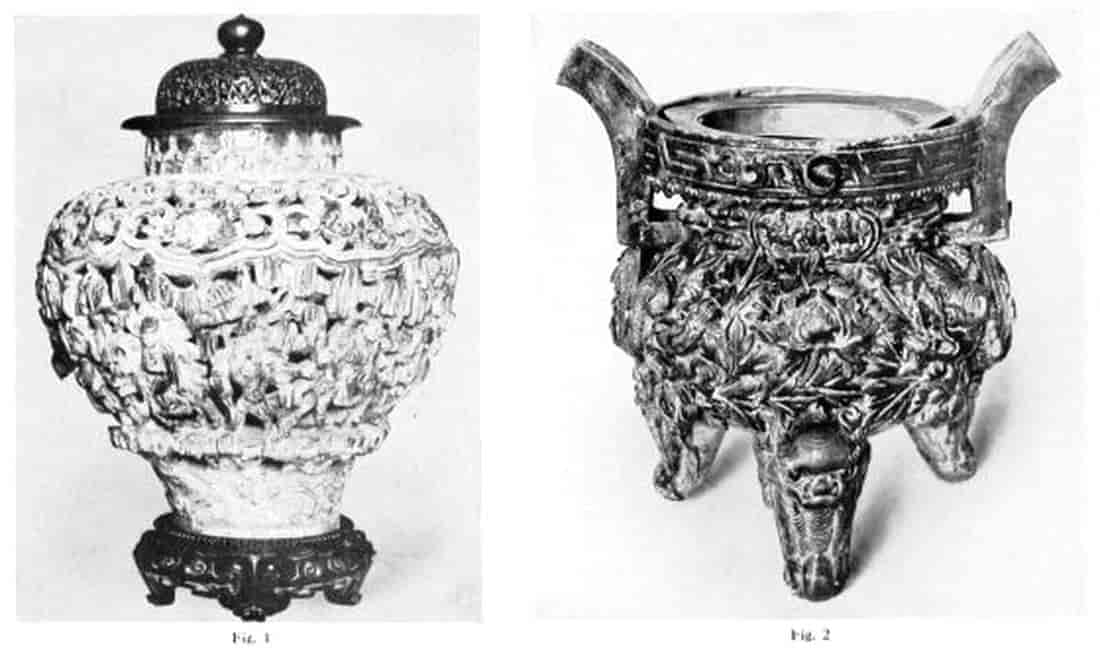
Plate 55.—Ming Pottery with dull san ts´ai glazes.
Fig. 1.—Wine Jar with pierced outer casing, horsemen and attendants, rocky background. Fifteenth century. Total height 19 12 inches. Eumorfopoulos Collection. Fig. 2.—Tripod Incense Vase, dragons and peony designs and a panel of horsemen. Dated 1529 A. D. Height 22 inches. Messel Collection.
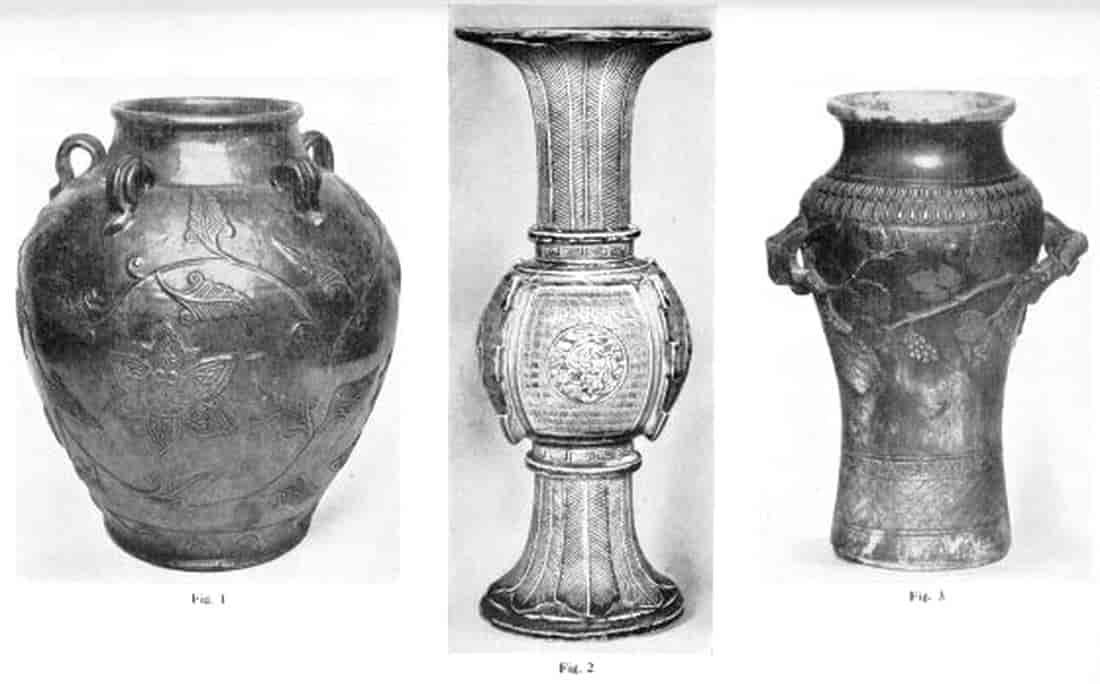
Plate 56.—Miscellaneous Pottery.
Fig. 1—Jar with dull green glaze and formal lotus scroll in relief touched with yellow and brown glazes. About 1600. Height 12 inches. Guff Collection. Fig. 2—Beaker of bronze form, soft whitish body and dull green glaze. (?) Seventeenth century. Height 16 12 inches. Eumorfopoulos Collection. Fig. 3.—vase of light buff ware with dull black dressing, vine reliefs. Mark, Nan hsiang t´ang (see p. 219). Eighteenth century. Height 11 12 inches. Eumorfopoulos Collection.
At Yi–chên  in the Yang–chou Fu, in Kiangsu, there were factories which supplied wine jars, etc., to the palace at Nanking in the early years of the Ming dynasty; and in the seventh year of Chia Ching (1528) supplies of similar vessels were sent from Ning–kuo Fu
in the Yang–chou Fu, in Kiangsu, there were factories which supplied wine jars, etc., to the palace at Nanking in the early years of the Ming dynasty; and in the seventh year of Chia Ching (1528) supplies of similar vessels were sent from Ning–kuo Fu  in the south–west of Anhui.[438] The latter place is mentioned elsewhere[439] under its earlier name of Hsüan Chou
in the south–west of Anhui.[438] The latter place is mentioned elsewhere[439] under its earlier name of Hsüan Chou  as producing a thin white ware made of "plastic clay" in the Yüan and Ming periods. A verse of Wang Shih–chêng (1526–1593) speaks of the "snow white porcelain of Hsüan Chou."[440] The T´ao lu enumerates factories which began in the Ming dynasty and continued to the nineteenth century, and apparently produced an inferior type of porcelain, and probably pottery as well. They were located at Huai–ch´ing Fu
as producing a thin white ware made of "plastic clay" in the Yüan and Ming periods. A verse of Wang Shih–chêng (1526–1593) speaks of the "snow white porcelain of Hsüan Chou."[440] The T´ao lu enumerates factories which began in the Ming dynasty and continued to the nineteenth century, and apparently produced an inferior type of porcelain, and probably pottery as well. They were located at Huai–ch´ing Fu  , I–yang Hsien
, I–yang Hsien  , Têng–fêng Hsien
, Têng–fêng Hsien  , and Shan Chou
, and Shan Chou  in Honan; at Yi Hsien
in Honan; at Yi Hsien  and Tsou Hsien
and Tsou Hsien  in Yen–chou Fu in Shantung; in the Lung Shang
in Yen–chou Fu in Shantung; in the Lung Shang  district in Shensi, and at Hêng–fêng
district in Shensi, and at Hêng–fêng  in Kiangsi. The last–mentioned factory was established by a man named Ch´ü Chih–kao from Ch´u–chou Fu in the early Ming period. In the Chia Ching period (1522–1566) it was transferred to the I–yang
in Kiangsi. The last–mentioned factory was established by a man named Ch´ü Chih–kao from Ch´u–chou Fu in the early Ming period. In the Chia Ching period (1522–1566) it was transferred to the I–yang  district to a place called Ma–k´êng, not many miles south of Ching–tê Chên. Both the Lung–shang and Ma–k´êng wares are described as very coarse.
district to a place called Ma–k´êng, not many miles south of Ching–tê Chên. Both the Lung–shang and Ma–k´êng wares are described as very coarse.
The value of pottery for architectural purposes was recognised in China from the earliest times. Unglazed bricks and tiles of Han and pre–Han periods are preserved by Chinese collectors, particularly when they happen, as is often the case, to have inscriptions in old seal characters, or other ornament. The familiar Chinese roof tile is a long convex object like a horizontal section of a tube, and those intended for the border are ornamented at one end with a disc, usually stamped with a dragon or other design in sunk relief. Here and there, on the apex of the roof or at the corners, are ornamental tiles carrying figures of deities, heroes, mythical creatures or birds, modelled in the round and usually with great force and skill. Besides these, architectural mouldings and antefixal ornaments in pottery are commonly used on temples and pavilions of an ornamental kind.
The use of tiles—and, no doubt, of other architectural embellishments in pottery—was encouraged by government enactments at various times. In the T´ang dynasty (618–906 A. D.),[441] in the districts south and west of the Yangtze, under the inspectorship of[202] a man named Tan  , the inhabitants were ordered to use tiles on their houses in place of wood in order to lessen the risk of fire; kilns were erected to provide the tiles, and those who were too poor to carry out the alterations by themselves received State help. A somewhat similar but more important edict was issued in the twenty–seventh year of Hung Wu[442] (1394), that bricks and tiles should be used in all the buildings in the capital, which was then Nanking, and that kilns should be set up every year on the Chü–pao shan for their manufacture. It was not long after this that the famous "porcelain pagoda" was erected at Nanking,[443] the lower part of which was faced with white porcelain bricks, the remaining storeys with pottery with coloured glazes.
, the inhabitants were ordered to use tiles on their houses in place of wood in order to lessen the risk of fire; kilns were erected to provide the tiles, and those who were too poor to carry out the alterations by themselves received State help. A somewhat similar but more important edict was issued in the twenty–seventh year of Hung Wu[442] (1394), that bricks and tiles should be used in all the buildings in the capital, which was then Nanking, and that kilns should be set up every year on the Chü–pao shan for their manufacture. It was not long after this that the famous "porcelain pagoda" was erected at Nanking,[443] the lower part of which was faced with white porcelain bricks, the remaining storeys with pottery with coloured glazes.
Tile factories existed in all parts of China to supply local needs, and the few singled out for mention in the T´u Shu[444] were perhaps of more than usual importance in the Ming dynasty. They are Lin–ch´ing  in the extreme west of Shantung; Su Chou
in the extreme west of Shantung; Su Chou  in Kiangsu, on the east side of the lake T´ai–hu, and facing the potteries of Yi–hsing, which supplied tiles for the palaces and temples of Nanking; the neighbouring Ch´ang–chou Chên, and Yi–chên and Kua Chou in the Yang–chou Fu of the same province; Wu–Ch´ing Hsien
in Kiangsu, on the east side of the lake T´ai–hu, and facing the potteries of Yi–hsing, which supplied tiles for the palaces and temples of Nanking; the neighbouring Ch´ang–chou Chên, and Yi–chên and Kua Chou in the Yang–chou Fu of the same province; Wu–Ch´ing Hsien  , in the district of Peking, where the potters asked for permission to make tiles for public use in 1574.
, in the district of Peking, where the potters asked for permission to make tiles for public use in 1574.
The tile works at Liu–li–chü (mentioned on p. 200) date from the Yüan dynasty. They are also situated in the neighbourhood of Peking, but whether in the Wu–ch´ing Hsien or not, I have failed to discover.
When Peking became the capital of the Ch´ing emperors, no doubt the tile factories at Wu–ch´ing Hsien assumed still greater importance; and according to the catalogue of the exhibition in Paris in 1878,[445] the neighbourhood of Amoy was then celebrated for its bricks and tiles. This branch of the potter's industry is represented by a small collection of bricks, tiles, mouldings, and antefixal ornaments in the British Museum. It includes unglazed bricks from the Great Wall of China, which may date from 220 B. C., a few Han bricks and tile–ends with moulded ornament; white porcelain bricks and coloured pottery tiles and mouldings from the Nanking pagoda; and tiles from the Ming tombs near Nanking, which were built in 1400 A. D., and like the pagoda destroyed in the T´aip´ing rebellion in 1853. The Nanking tiles and mouldings are of hard buff pottery with translucent glazes of green and yellow colour, minutely crackled, additional colours being formed with red and creamy white slips. The tile–ends are ornamented with dragon medallions.
PLATE 57
Seated figure of Kuan Yü, the war–god of China, a deified warrior. Reddish buff pottery with blue, yellow and turquoise glazes, and a colourless glaze on the white parts. Sixteenth century.
Height 20 38 inches. Eumorfopoulos Collection.
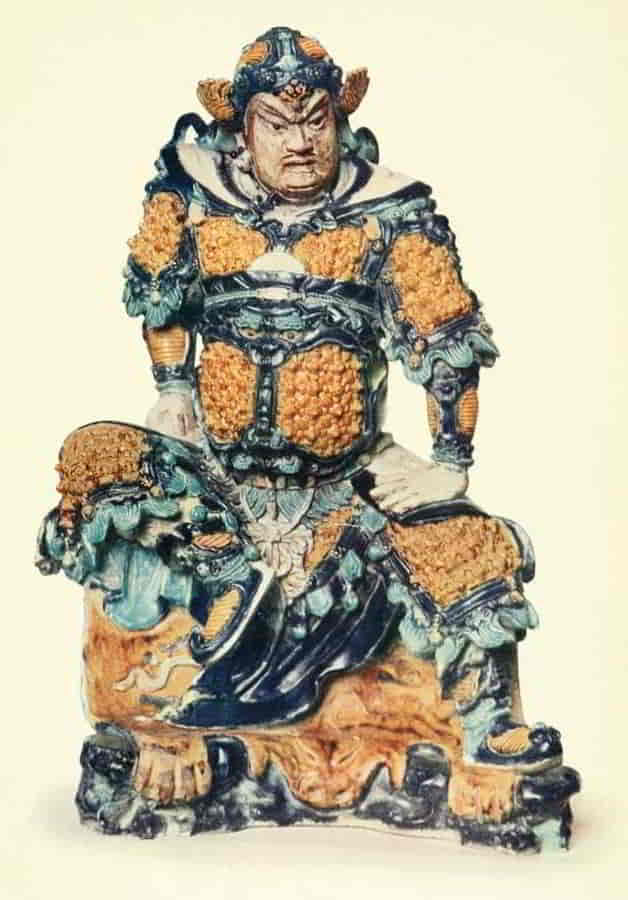
Other architectural pottery in the same collection came from the Imperial pleasure grounds at Peking, which were wrecked in 1860. These include tiles and antefixal ornaments from the pavilions and temples in the Yüan Ming Yüan and from the Summer Palace, and a few blue–glazed tiles from the Temple of Heaven. Numerous tiles with relief figures and pottery figures from niches were picked up in the ruins of the temples and pavilions in the Imperial grounds after their capture in 1860; and many of the mouldings were found to display strong European influences, due, no doubt, to the designs of the Jesuits Attiret and Castiglione, who assisted the Emperor Ch´ien Lung in erecting some of the buildings. Some of these are in the British Museum besides antefixes in the form of yellow dragon heads from the Winter Palace at Peking and from the celebrated Temple of Kin–shan, or Golden Island, in the Yangtze; and a tile from the Huang–ssŭ, the Great Lama temple, built by K´ang Hsi in 1647. The tile in question is evidently part of a restoration, for it bears the date corresponding to 1770.
The ordinary tiles and mouldings are not likely to be extensively collected by private individuals, but many of the ridge tiles, with figures of deities, horsemen, lions, ch´i–lin, and phœnixes, have found their way into collections to which their spirited modelling has served as a passport. The glazes on these are often richly coloured, and include yellow, green, violet purple, aubergine and purplish black, and occasionally high–fired glazes with flambé or variegated colours. By accident or design, the figures are not infrequently detached from their tiles and mounted on wooden stands. The pottery figures from niches in the walls of temples and public buildings are often finely modelled and richly glazed, and, needless to say, they find a welcome in Western collections (Plate 58).
It is a common but illogical practice to assign all these figures in architectural pottery to the Ming dynasty; illogical, because so[206] many of them have been brought from the Imperial buildings at Peking which are known to have been mostly erected in the K´ang Hsi and Ch´ien Lung period. On the other hand, nothing is more difficult to date than this type of glazed pottery, in which the ware, the colours, and the decorative traditions seem to have continued almost unchanged from the early Ming times to the present day. The tiles from the Nanking pagoda and from the eighteenth–century buildings at Peking are practically interchangeable.
Nor must we forget that the potters who made the architectural pottery often turned their hands and materials to the manufacture of vases and figures and other ceramic ornaments for domestic use, and even imposing altar sets for the temples. An important example of this work is seen in Fig. 2 of Plate 55, a large incense vase[446] of traditional form (from an altar set) with bowl–shaped body, wide mouth, two upstanding handles, and three feet with lion masks. It is ornamented with a peony scroll and two dragons in high relief, and is made of pottery with a dull turquoise green glaze. An inscription on the handles proclaims the fact that it was "dedicated by the chieftain Kuo Hsin–shê; made in the eighth year of Chia Ching," i.e. 1529. In more recent times the tile works near Peking have turned their attention to the manufacture of vases and bowls with rich soft monochrome glazes, yellow, green, turquoise and aubergine in the manner of the similarly coloured porcelains which are highly prized, and, as Bushell tells us, "the soft excipient (i.e. the pottery body) seems to impart an added softness" to the glazes. "The fact that yellow clay," he continues, "used often to be mixed with the porcelain earth in the old fabrics to enhance the brilliancy of the glaze colours, gives a certain vraisemblance to the fraudulent reproductions which I have seen sold for as many dollars as they would cost in cents to produce." It is unlikely that the issue of these by–products of the tile factories is confined to the neighbourhood of Peking. Among the miscellaneous potteries I should add that Ka–shan,[447] in Chekiang, is reputed to have been noted in the seventeenth and eighteenth centuries for a fine porcellanous stoneware with opaque, camellia–leaf green glaze minutely crackled.
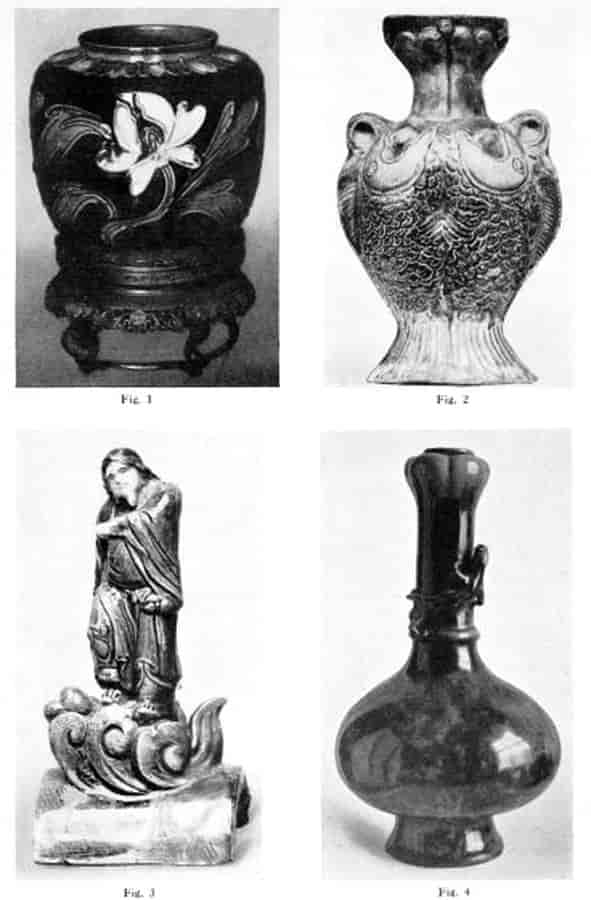
Plate 58.—Miscellaneous Pottery.
Fig. 1.—Jar with lotus design in green, yellow and turquoise glazes in an aubergine ground. About 1600. Height 6 12 inches. Hippisley Collection. Fig. 2.—Vase of double fish form, buff ware with turquoise, yellow and aubergine glazes. (?) Seventeenth century. Height 5 34 inches. British Museum. Fig. 3.—Roof–tile with figure of Bodhidharma, deep green and creamy white glazes. Sixteenth century. Height 10 78 inches. Benson Collection. Fig. 4.—Bottle with archaic dragon (ch´ih lung) on neck, variegated glaze of lavender, blue and green clouded with purple and brown. (?) Eighteenth century Yi–hsing ware. Height 10 inches. Peters Collection.
CHAPTER XVII
MARKS ON CHINESE POTTERY AND PORCELAIN
THE custom of placing on works of art the name of the maker, the date of manufacture, or some sign or symbol indicating the intention with which they were made, dates back in China at least as far as the Han dynasty. Such marks occur on pottery and porcelain rarely at first, but with a frequency which increases in proportion as we draw nearer to modern times. They are incised or stamped in the soft body of the ware, or painted under the glaze (usually in blue) or over it in enamel colours or gold; and they are generally placed on the base of the ware, though there are fairly numerous instances in which the mark is written along the mouth rim or in some other more or less conspicuous position.
The earliest marks, as far as I am aware, are incised, and those on the Han, T´ang, and Sung potteries, not to mention the intermediate dynasties, should be scrutinised with the greatest care to make sure whether the incisions were made before the pottery was baked or afterwards. There should be no difficulty in determining this point, for the lines cut with a sharp instrument in the fired ware are necessarily harder and less free than those incised in the soft clay, and the edges of the incisions will present obvious differences in the two cases. Unfortunately the early date–marks which I have seen up to the present have almost all been cut after the firing. It does not necessarily follow that such inscriptions are modern additions. Indeed in many cases they are in a style which is clearly old. But their value as evidence is very small, for it is impossible to prove the exact time of their carving; and at best we can only regard them as representing the opinion of some former owner as to the date of the vessel in question. At their worst, they are deliberate frauds added by modern vendors with intent to deceive.
Incised or stamped marks have always been common on pottery, but porcelain is usually marked by painting with a brush, and for this purpose underglaze blue is the commonest medium, red and[208] other on–glaze colours being used chiefly on the relatively modern wares decorated in famille rose enamels. Similarly the ordinary script is usual in marks, and seal characters are quite exceptional on porcelain earlier than the eighteenth century.
It is not safe to take the older date–marks on porcelain at their face value. The Chinese with their proverbial veneration for antiquity habitually placed the date–marks of the classical reigns on their porcelain whether decorated in the style of the period mentioned or not. Already in the sixteenth century the Hsüan Tê and Ch'êng Hua marks were used in this way, and in the K'ang Hsi period the names of these two classic reigns were used more frequently than that of the K'ang Hsi period itself. In fact the Hsüan Tê and Ch'êng Hua are on the whole the most familiar marks of all, though the actual wares of these two periods are among the rarest. The date–marks of the other Ming Emperors are less frequently plagiarised, except upon the deliberate imitations of the wares of the time, such as those made at the Imperial factory in the Yung Chêng period, which we may be sure were carefully marked with the appropriate nien hao. Moreover, the Japanese, who have expended much ingenuity on reproducing Ming wares, have made free with Ming date–marks, especially those of Chia Ching and Wan Li.
In the year 1677 the potters at Ching–tê Chên were forbidden by an order of the district prefect[448] to inscribe the period–name of the Emperor or any sacred writing on their porcelain, lest the names should be profaned in the breaking of the ware. It is certain that this prohibition was not effective for long; but probably the current date–mark was suppressed for a time at least, and it is quite likely that we should trace to this interval the custom of putting symbols or conventional marks inside the double ring which was usually occupied by the nien hao, a common practice in the K'ang Hsi period. In many cases, too, the rings were left empty; but it is a mistake to regard this as an infallible sign of K'ang Hsi manufacture, for it is a thing which might happen at any time through negligence, the rings being made by one person and the marks written by[209] another. There are, besides, well authenticated instances of the empty double ring on Wan Li porcelain,[449] and on post K'ang Hsi wares. It was, however, such a frequent occurrence on the K'ang Hsi wares that the modern imitators make a common practice of leaving the rings blank on their copies of the K'ang Hsi blue and white. It is not clear whether the prefect's prohibition applied to the names of Ming emperors, but probably it did not, as it is unlikely that the adherents of the reigning dynasty would be sensitive about the titles of the house which they had exterminated. In any case, Ming marks, especially those of the fifteenth century, are very common on the K'ang Hsi porcelain, and the K'ang Hsi mark itself is comparatively rare except on the specimens which must belong to the later years of the reign.
En revanche, the K'ang Hsi mark is freely used on quite modern wares, that period being now regarded as classical; so that we are confronted with the paradox that if a specimen of fine quality[450] is marked Ch'êng Hua, it may generally be assumed that it was made in the K'ang Hsi period, while the bulk of the pieces which bear the K'ang Hsi mark are of modern date.
The Yung Chêng and Ch'ien Lung porcelains are highly esteemed to–day, and consequently the marks of these periods are considered worthy of a place on modern imitations; but on the whole the bulk of the specimens bearing these marks will be found to belong to the period indicated, and the imitations are generally so coarse as to be unmistakable. The temptation to borrow the reign marks of the subsequent periods is so slight that we may safely accept the later marks as correct indications of date.
Marks written in enamel colours and even in gold become increasingly common on the famille rose porcelains from the Yung Chêng period onwards, the red mark being more familiar on the modern wares than the blue; and seal characters frequently replace the ordinary script in the reign marks of the Yung Chêng and subsequent periods. Date marks in seal form before the eighteenth century are very unusual, and should be regarded with suspicion.
It will be seen from the foregoing notes that Chinese date marks must be treated with great caution. In fact it is safer to regard them merely as secondary evidence, first basing one's judgment[210] on the paste and glaze, the style of decoration and the quality of the colours. The one exception to this declaration of unfaith is the marks on the Imperial porcelain. These would naturally be correct and reliable, except where deliberate imitations of the older wares were undertaken; and then, no doubt, the mark of the period imitated would be used to make the illusion complete. The Imperial marks were the work of calligraphers who were selected for the purpose, and the writing is careful and in good style. In fact a well–written mark is almost as certain a sign of Imperial ware as the five–clawed dragon itself.[451]
At the private factories the marks were often carelessly, even illegibly, written, and probably little trouble was taken with this part of the decoration except on the choicer specimens. On a large proportion of the private wares the mark was omitted altogether.
The marks on Chinese pottery and porcelain may be conveniently grouped under the following headings:—
(1) Date marks.
(2) Hall marks.
(3) Potters' names and factory marks.
(4) Marks of dedication, felicitation, commendation, etc.
(1) Date marks.
The date marks conform to the two Chinese systems of chronology, (a) the cyclical and (b) the reign names of the Emperors.
(a) The system by which the years are divided into cycles of sixty, each year of the cycle having a name, carries back Chinese chronology to the year 2637 B. C., from which the first cycle is dated. We are at present in the 76th cycle.
The year names are composed of two characters, the first being one of the Ten Stems, and the second one of the Twelve Branches; and as the stems and the branches are taken in strict rotation, it is clear that the combinations will not be exhausted until sixty have been formed, that number being the least common multiple of ten and twelve.
The Ten Stems  Shih kan are as follows:—
Shih kan are as follows:—
| 1 |  chia chia |
 |
corresponding to the element  mu = wood. mu = wood. |
| 2 |  i i |
||
| 3 |  ping ping |
 |
corresponding to the element  huo = fire. huo = fire. |
| 4 |  ting ting |
||
| 5 |  wu or mou[211] wu or mou[211] |
 |
corresponding to the element  t´u = earth. t´u = earth. |
| 6 |  chi chi |
||
| 7 |  kêng kêng |
 |
corresponding to the element  chin = metal. chin = metal. |
| 8 |  hsin hsin |
||
| 9 |  jên jên |
 |
corresponding to the element  shui = water. shui = water. |
| 10 |  kuei kuei |
The Twelve Branches  shih êrh chih, which correspond to the twelve animals of the zodiac, and through them to the twelve divisions of the day are as follows:—
shih êrh chih, which correspond to the twelve animals of the zodiac, and through them to the twelve divisions of the day are as follows:—
| Appertaining to the sign of the |
Corresponding to | |||||
| 1 |
 |
tzŭ | rat | Aries | 11–1 a.m. | N. |
| 2 |
 |
ch´ou | ox | Taurus | 1–3 a.m. | N.N.E. 3/4E. |
| 3 |
 |
yin | tiger | Gemini | 3–5 a.m. | E.N.E. 3/4N. |
| 4 |
 |
mao | hare | Cancer | 5–7 a.m. | E. |
| 5 |
 |
ch´ên | dragon | Leo | 7–9 a.m. | E.S.E. 3/4S. |
| 6 |
 |
ssŭ | serpent | Virgo | 9–11 a.m. | S.S.E. 3/4E. |
| 7 |
 |
wu | horse | Libra | 11 a.m.–1 p.m. | S. |
| 8 |
 |
wei | sheep | Scorpio | 1–3 a.m. | S.S.W. 3/4W. |
| 9 |
 |
shên | monkey | Sagittarius | 3–5 a.m. | W.S.W. 3/4W. |
| 10 |
 |
yu | cock | Capricornus | 5–7 a.m. | W. |
| 11 |
 |
hsü | dog | Aquarius | 7–9 a.m. | W.N.W. 3/4N. |
| 12 |
 |
hai | boar | Pisces | 9–11 a.m. | N.N.W. 3/4W. |
The table of cycles subsequent to the Christian era,[452] i.e. cycles 45–76, dating from 4–1928 A. D., will be useful in calculating the year of the cyclical dates with the help of the accompanying table of numerals:—
| (a) | (b) | (c) | ||||
| 1 |
 |
i |
 |
or |
 |
|
| 2 |
 |
êrh |
 |
" |
 |
|
| 3 |
 |
san |
 |
" |
 |
|
| 4 |
 |
ssŭ |
 |
|||
| 5 |
 |
wu |
 |
|||
| 6 |
 |
liu |
 |
|||
| 7 |
 |
ch´i |
 |
|||
| 8 |
 |
pa |
 |
|||
| 9 |
 |
chiu |
 |
|||
| 10 |
 |
shih |
 |
or |
 |
|
(a) is the normal form; (b) is commonly used for accounts; (c) is used on drafts, pawntickets, etc.
TABLE OF CYCLICAL DATES FROM A.D. 4
| CYCLE BEGINNING | ||||||
| Cyclical Signs |
4 | 64 | ||||
| 304 | 364 | 124 | 184 | 244 | ||
| 604 | 664 | 424 | 484 | 544 | ||
| 904 | 964 | 724 | 784 | 844 | ||
| 1204 | 1264 | 1024 | 1084 | 1144 | ||
| 1504 | 1564 | 1324 | 1384 | 1444 | ||
| 1804 | 1864 | 1624 | 1684 | 1744 | ||
 |
04 | 64 | 24 | 84 | 44 | |
 |
05 | 65 | 25 | 85 | 45 | |
 |
06 | 66 | 26 | 86 | 46 | |
 |
07 | 67 | 27 | 87 | 47 | |
 |
08 | 68 | 28 | 88 | 48 | |
 |
09 | 69 | 29 | 89 | 49 | |
 |
10 | 70 | 30 | 90 | 50 | |
 |
11 | 71 | 31 | 91 | 51 | |
 |
12 | 72 | 32 | 92 | 52 | |
 |
13 | 73 | 33 | 93 | 53 | |
 |
14 | 74 | 34 | 94 | 54 | |
 |
15 | 75 | 35 | 95 | 55 | |
 |
16 | 76 | 36 | 96 | 56 | |
 |
17 | 77 | 37 | 97 | 57 | |
 |
18 | 78 | 38 | 98 | 58 | |
 |
19 | 79 | 39 | 99 | 59 | |
 |
20 | 80 | 40 | 100 | 60 | |
 |
21 | 81 | 41 | 101 | 61 | |
 |
22 | 82 | 42 | 102 | 62 | |
 |
23 | 83 | 43 | 103 | 63 | |
 |
24 | 84 | 44 | 104 | 64 | |
 |
25 | 85 | 45 | 105 | 65 | |
 |
26 | 86 | 46 | 106 | 66 | |
 |
27 | 87 | 47 | 107 | 67 | |
 |
28 | 88 | 48 | 108 | 68 | |
 |
29 | 89 | 49 | 109 | 69 | |
 |
30 | 90 | 50 | 110 | 70 | |
 |
31 | 91 | 51 | 111 | 71 | |
 |
32 | 92 | 52 | 112 | 72 | |
 |
33 | 93 | 53 | 113 | 73 | |
 |
34 | 94 | 54 | 14 | 74 | |
 |
35 | 95 | 55 | 15 | 75 | |
 |
36 | 96 | 56 | 16 | 76 | |
 |
37 | 97 | 57 | 17 | 77 | |
 |
38 | 98 | 58 | 18 | 78 | |
 |
39 | 99 | 59 | 19 | 79 | |
 |
40 | 100 | 60 | 20 | 80 | |
 |
41 | 101 | 61 | 21 | 81 | |
 |
42 | 102 | 62 | 22 | 82 | |
 |
43 | 103 | 63 | 23 | 83 | |
 |
44 | 104 | 64 | 24 | 84 | |
 |
45 | 105 | 65 | 25 | 85 | |
 |
46 | 106 | 66 | 26 | 86 | |
 |
47 | 107 | 67 | 27 | 87 | |
 |
48 | 108 | 68 | 28 | 88 | |
 |
49 | 109 | 69 | 29 | 89 | |
 |
50 | 110 | 70 | 30 | 90 | |
 |
51 | 111 | 71 | 31 | 91 | |
 |
52 | 112 | 72 | 32 | 92 | |
 |
53 | 113 | 73 | 33 | 93 | |
 |
54 | 114 | 74 | 34 | 94 | |
 |
55 | 115 | 75 | 35 | 95 | |
 |
56 | 116 | 76 | 36 | 96 | |
 |
57 | 117 | 77 | 37 | 97 | |
 |
58 | 118 | 78 | 38 | 98 | |
 |
59 | 119 | 79 | 39 | 99 | |
 |
60 | 120 | 80 | 40 | 100 | |
 |
61 | 121 | 81 | 41 | 101 | |
 |
62 | 122 | 82 | 42 | 102 | |
 |
63 | 123 | 83 | 43 | 103 | |
It will be seen that cyclical dates without any indication of the particular cycle intended are merely tantalising. On the other hand when the reign is specified as well, the combination gives the most precise form of date. But unfortunately there are many cases in which the reign name is absent, and we can only judge the cycle by the style of the ware, a calculation which is always open to dispute. It is not often that the cycle is so clearly indicated by an indirect method as in the oft–quoted mark yu hsin ch´ou nien chih  = made in the hsin ch´ou year recurring (yu).This can only be 1721, when the hsin ch´ou year actually recurred in the (sixty–first year of) reign of K´ang Hsi.[453]
= made in the hsin ch´ou year recurring (yu).This can only be 1721, when the hsin ch´ou year actually recurred in the (sixty–first year of) reign of K´ang Hsi.[453]
(b) The more usual form of date mark is that which gives the reign name of an Emperor. On ascending the throne the Emperor discarded his family name and assumed a title by which his reign was thenceforth known. This is the name which appears in the date marks, and it is known as the nien (period) hao (name). After his death the Emperor received another title, the miao hao, or name under which he was canonised; but though reference might be made to him in history under his miao hao, it is obvious that the posthumous name cannot occur on contemporary date marks.
In reckoning the date of an Emperor's reign it was not usual to include officially the year in which his predecessor had died, but to date the reign from the first day of the year following. Thus, though K´ang Hsi became Emperor in 1661, his reign is dated officially from 1662.
The Imperial date mark is usually written in six characters beginning with the name of the dynasty and ending with the words nien chih (made in the period): the nien hao coming in the middle:—
1 2 3 4 5 6
e.g. Ta ming ch´êng hua nien chih = made (chih)
4 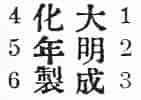
in the Ch´êng Hua period (nien) of the great Ming (dynasty).
Occasionally the word nien is replaced by yü  (Imperial), [214] yü chih meaning made by Imperial command; and in place of chih we sometimes find the word tsao
(Imperial), [214] yü chih meaning made by Imperial command; and in place of chih we sometimes find the word tsao  or more rarely tso
or more rarely tso  both of which have the same meaning "made."
both of which have the same meaning "made."
The six characters may be written in two lines of three, or in three lines of two, or again in one long line read from right to left; and for reasons of space, and sometimes for no apparent reason, the first two characters are omitted, e.g.  . The omission of the nien hao is rare except on a few Japanese copies of Chinese porcelain, e.g.
. The omission of the nien hao is rare except on a few Japanese copies of Chinese porcelain, e.g.  ta ming nien chih = made in the great Ming dynasty.
ta ming nien chih = made in the great Ming dynasty.
As already mentioned, the seal forms of the mark were frequently employed from the eighteenth century onwards (see p. 209). An archaic form of seal character occurs in the Yung Lo mark which is given below.
The use of the nien hao on the Imperial wares made at Ching–tê Chên was made obligatory by a command issued in the Ching–tê period (1004–1007), when the name of the town was altered to Ching–tê Chên.
Ming Dynasty
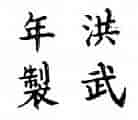 HUNG WU, 1368–1398.
HUNG WU, 1368–1398.
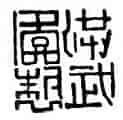 Same in seal characters.
Same in seal characters.
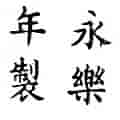 YUNG LO, 1403–1424.
YUNG LO, 1403–1424.
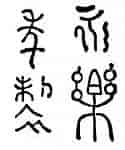 Same in archaic characters.
Same in archaic characters.
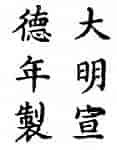 HSÜAN TÊ, 1426–1435.
HSÜAN TÊ, 1426–1435.
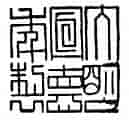 Same in seal characters.
Same in seal characters.
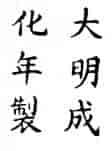 CH´ÊNG HUA, 1465–1487.
CH´ÊNG HUA, 1465–1487.
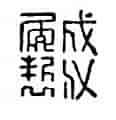 Same in seal characters (the first two omitted).
Same in seal characters (the first two omitted).
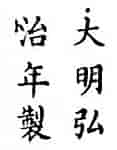 HUNG CHIH, 1488–1505.
HUNG CHIH, 1488–1505.
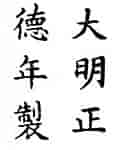 CHÊNG TÊ, 1506–1521.
CHÊNG TÊ, 1506–1521.
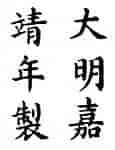 CHIA CHING, 1522–1566.
CHIA CHING, 1522–1566.
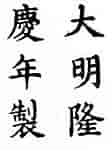 LUNG CH´ING, 1567–1572.
LUNG CH´ING, 1567–1572.
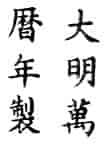 WAN LI, 1573–1619.
WAN LI, 1573–1619.
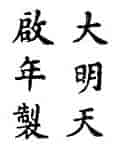 T´IEN CH´I, 1621–1627.
T´IEN CH´I, 1621–1627.
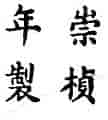 CH´UNG CHÊNG, 1628–1643.
CH´UNG CHÊNG, 1628–1643.
Ch´ing Dynasty.
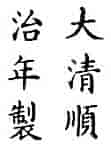 SHUN CHIH, 1644–1661.
SHUN CHIH, 1644–1661.
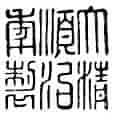 Same in seal characters.
Same in seal characters.
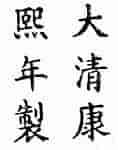 K´ANG HSI, 1662–1722.
K´ANG HSI, 1662–1722.
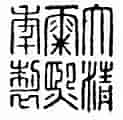 Same in seal characters.
Same in seal characters.
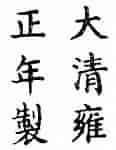 YUNG CHÊNG, 1723–1735.
YUNG CHÊNG, 1723–1735.
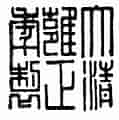 Same in seal characters.
Same in seal characters.
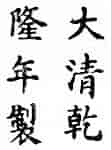 CH´IEN LUNG, 1736–1795.
CH´IEN LUNG, 1736–1795.
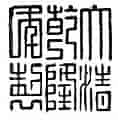 Same in seal characters.
Same in seal characters.
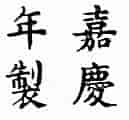 CHIA CH´ING, 1796–1820.
CHIA CH´ING, 1796–1820.
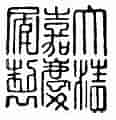 Same in seal characters.
Same in seal characters.
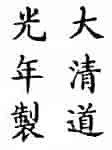 TAO KUANG, 1821–1850.
TAO KUANG, 1821–1850.
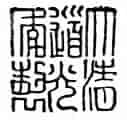 Same in seal characters.
Same in seal characters.
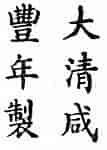 HSIEN FÊNG, 1851–1861.
HSIEN FÊNG, 1851–1861.
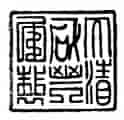 Same in seal characters.
Same in seal characters.
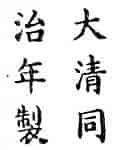 T´UNG CHIH, 1862–1874.
T´UNG CHIH, 1862–1874.
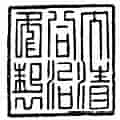 Same in seal characters.
Same in seal characters.
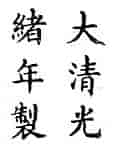 KUANG HSÜ, 1875–1909.
KUANG HSÜ, 1875–1909.
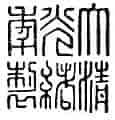 Same in seal characters.
Same in seal characters.
(2) Hall marks.
The "hall mark," which is of frequent occurrence on both porcelain and pottery, is so called because it includes the word t´ang  (hall) or some equivalent such as chai
(hall) or some equivalent such as chai  (a study), t´ing
(a study), t´ing  (a pavilion), hsien or hsüan
(a pavilion), hsien or hsüan  (a porch, balcony or pavilion), kuan
(a porch, balcony or pavilion), kuan  (a residence or hostelry), fang
(a residence or hostelry), fang  (a room or house), chü
(a room or house), chü  (a dwelling). The word t´ang as explained in Giles's Dictionary is "a hall: especially a hall of justice or court; the ancestral hall; an official title." T´ang ming is "the family hall name—a fancy name usually consisting of two characters followed by t´ang (e.g. wu tê t´ang chin = Chin of the military valour hall), and referring to some event in family history. It is generally inscribed in one of the principal rooms of the house, and is used in deeds, on graves, boundary stones, etc."
(a dwelling). The word t´ang as explained in Giles's Dictionary is "a hall: especially a hall of justice or court; the ancestral hall; an official title." T´ang ming is "the family hall name—a fancy name usually consisting of two characters followed by t´ang (e.g. wu tê t´ang chin = Chin of the military valour hall), and referring to some event in family history. It is generally inscribed in one of the principal rooms of the house, and is used in deeds, on graves, boundary stones, etc."
The hall mark, then, may contain the studio name of the maker or of the recipient of the ware, or it may have reference literally to the building for which the ware was intended. The last interpretation can be generally applied to the marks referring to halls or pavilions in the precincts of the Imperial palace. Again, the hall may be the shop of a dealer who ordered the goods. But in the absence of prepositions, it is not always—not often, I should perhaps say—possible to determine which of these alternatives is implied in any particular hallmark; e.g.  Lin yü t´ang chih may mean "made in the Abundant–Jade Hall," or "for" the same, or by a man whose studio name was Lin–yü t´ang.
Lin yü t´ang chih may mean "made in the Abundant–Jade Hall," or "for" the same, or by a man whose studio name was Lin–yü t´ang.
As to the antiquity of hall marks, it was not considered anachronistic to cut one on a Han granary urn which is now in the British Museum; but unfortunately as the cutting was done after the ware was baked it is now impossible to say at what period it was executed. A Sung example is quoted in the Ni ku lu (written in the middle of the sixteenth century) as inscribed on a Ting Chou vase in the handwriting of the Mi family, viz., jên ho kuan  (Hotel of Benevolence and Harmony). A similar mark similarly placed is
(Hotel of Benevolence and Harmony). A similar mark similarly placed is  jên ts´un t´ang (Hall of Benevolence), on a Tz´ŭ Chou jar in the Eumorfopoulos Collection.
jên ts´un t´ang (Hall of Benevolence), on a Tz´ŭ Chou jar in the Eumorfopoulos Collection.
Hall marks on Ming porcelain are rare. There is, however, one which occurs fairly often on late Ming porcelains of various kinds, including pieces decorated in blue and blue and white, underglaze red, blue and enamel colours, pierced designs and slip. This is  yü t´ang chia ch´i, "beautiful vessel for the Jade Hall."
yü t´ang chia ch´i, "beautiful vessel for the Jade Hall."
It is improbable that the yü t´ang was a factory name, as the specimens so marked have little homogeneity. Giles's Dictionary tells us that yü t´ang is a name for the Han Lin College at Peking, which was so called in memory of Chou Chih–lin of the Sung dynasty, upon whom the Emperor bestowed these two characters in admiration of his qualities. From this we might infer that the wares so marked were made for the Han Lin; but why, one asks, in that case should the examples in our collections be so many and so evidently of the same period? On the whole I prefer to regard the mark as of general (and complimentary) significance, i.e. "beautiful vessel for the home of pure worth," like another mark much affected on late Ming porcelain fu kuei chia ch´i ("fine vessel for the rich and honourable!").
Hall marks are very frequent on the porcelains of the Ch´ing dynasty, and enough are given below to illustrate their various forms. Many of them are no doubt hall names of makers and decorators, and as such belong to the category of artists' signatures.
Special interest attaches to those hall marks which have been identified as referring to pavilions in the precincts of the Imperial palace. We are told by Bushell[454] that the "fashion of inscribing upon porcelain made for the Imperial palace the name of the particular pavilion for which it was intended seems to have begun in the reign of Yung Chêng," and observation shows that these hall marks only[219] become frequent on the later porcelains. In fact most of the examples with which I am acquainted are nearer in style to the Tao Kuang than to the Yung Chêng wares, and the majority of the hall marks written in red on the glaze will be found to be of early nineteenth century date.
HALL MARKS
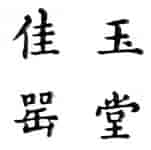 Yü t´ang chia ch´i = fine vessel for the jade hall (late Ming).
Yü t´ang chia ch´i = fine vessel for the jade hall (late Ming).
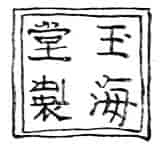 Yü hai t´ang chih = made for the Yü–hai (jade sea) hall (about 1700).
Yü hai t´ang chih = made for the Yü–hai (jade sea) hall (about 1700).
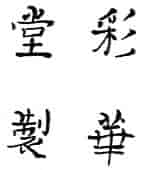 Ts´ai hua t´ang chih = made for the hall of bright painting (nineteenth century).
Ts´ai hua t´ang chih = made for the hall of bright painting (nineteenth century).
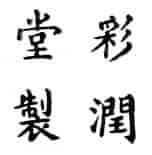 Ts´ai jun t´ang chih = made for the hall of bright colours (nineteenth century).
Ts´ai jun t´ang chih = made for the hall of bright colours (nineteenth century).
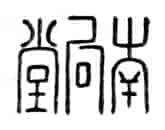 Nan hsiang t´ang = south aspect hall (on eighteenth century pottery).
Nan hsiang t´ang = south aspect hall (on eighteenth century pottery).
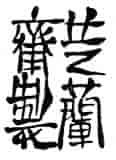 Chih lan chai chih = made for the epidendrum hall (seventeenth century).
Chih lan chai chih = made for the epidendrum hall (seventeenth century).
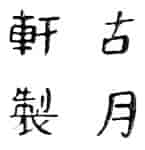 Ku yüeh hsüan chih = made by Ku–yüeh–hsüan. (See Vol. ii., p. 215.)
Ku yüeh hsüan chih = made by Ku–yüeh–hsüan. (See Vol. ii., p. 215.)
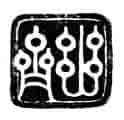 Yu ch´ai = quiet pavilion—a studio name of a painter.
Yu ch´ai = quiet pavilion—a studio name of a painter.
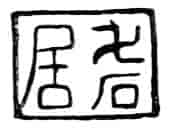 Wan shih chü = myriad rocks retreat; studio name of a painter.
Wan shih chü = myriad rocks retreat; studio name of a painter.
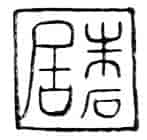 Chu shih chü = red rocks retreat; studio name of a painter.
Chu shih chü = red rocks retreat; studio name of a painter.
PALACE HALL MARKS
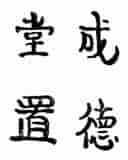 Ch´êng tê t´ang chih = ordered for the Ch´êng–tê (complete virtue) hall.
Ch´êng tê t´ang chih = ordered for the Ch´êng–tê (complete virtue) hall.
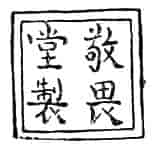 Ching wei t´ang chih = made for the Ching–wei (reverent awe) hall.
Ching wei t´ang chih = made for the Ching–wei (reverent awe) hall.
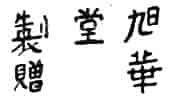 Hsü hua t´ang chih tsêng = made for the Hsü–hua hall, for presentation.
Hsü hua t´ang chih tsêng = made for the Hsü–hua hall, for presentation.
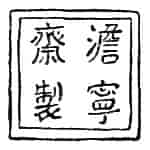 Tan ning chai chih = made for the Tan–ning (peace and tranquillity) pavilion.
Tan ning chai chih = made for the Tan–ning (peace and tranquillity) pavilion.
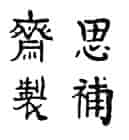 Ssŭ pu chai chih = made for the Ssŭ–pu pavilion (i.e. pavilion for meditation for the correction of faults).
Ssŭ pu chai chih = made for the Ssŭ–pu pavilion (i.e. pavilion for meditation for the correction of faults).
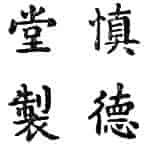 Shên tê t´ang chih = made for the Shên–tê (cultivation of virtue) hall. (See Vol. ii., p. 264.)
Shên tê t´ang chih = made for the Shên–tê (cultivation of virtue) hall. (See Vol. ii., p. 264.)
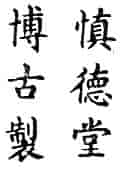 Shên tê t´ang po ku chih = antique made for the Shên–tê hall.
Shên tê t´ang po ku chih = antique made for the Shên–tê hall.
(3) Potters' names, etc.
Marks which include potters' names (apart from the uncertain hall marks) are rare on Chinese porcelain though frequent enough on pottery. But it will be remembered that at Ching–tê Chên at any rate the porcelain passed through so many hands that the individuality of the work was lost, and consequently a personal mark would be, as a rule, misleading. The question of signatures in the field of the decoration has been discussed[455] with the conclusion that they belong rather to the artists who painted the original copied by the pot–painters than to the pot–painter himself.
Perhaps we should include here a fairly common type of mark, usually in the form of a small seal of a conventional and quite illegible character, which goes by the name of "shop marks." But it is not clear whether they refer to the maker or the firm who ordered the porcelain.
POTTERS' MARKS
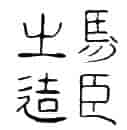 Ma chên shih tsao = made by ma ch´ên–shih (on a T´ang vase).
Ma chên shih tsao = made by ma ch´ên–shih (on a T´ang vase).
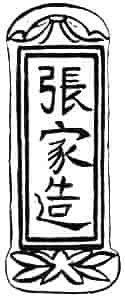 Chang chia tsao = made by the Chang family (on Tz´ŭ Chou ware). (See Vol. i., p. 105.)
Chang chia tsao = made by the Chang family (on Tz´ŭ Chou ware). (See Vol. i., p. 105.)
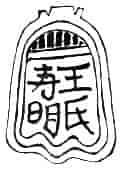 Wang shih ch´ih ming = Mr. Wang Ch´ih–ming (on Tz´ŭ–Chou ware).
Wang shih ch´ih ming = Mr. Wang Ch´ih–ming (on Tz´ŭ–Chou ware).
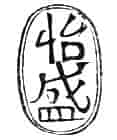 I shêng = harmonious prosperity. Perhaps a potter's name (on Kuangtung ware).
I shêng = harmonious prosperity. Perhaps a potter's name (on Kuangtung ware).
MARKS ON KUANGTUNG WARE
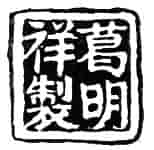 Ko ming–hsiang chih = made by Ko Ming–hsiang (eighteenth century).
Ko ming–hsiang chih = made by Ko Ming–hsiang (eighteenth century).
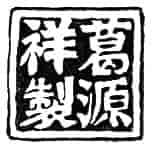 Ko yüan hsiang chih = made by Ko Yüan–hsiang (eighteenth century).
Ko yüan hsiang chih = made by Ko Yüan–hsiang (eighteenth century).
 Huang yün chi = mark of Huang–yün (nineteenth century).
Huang yün chi = mark of Huang–yün (nineteenth century).
 Li Ta–lai = potter's name.
Li Ta–lai = potter's name.
 Hou–ch´ang = potter's name.
Hou–ch´ang = potter's name.
POTTERS' MARKS—continued.
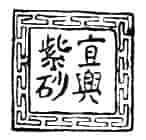 Yi hsing tzŭ sha = brown earth (lit. sand) of Yi–hsing.
Yi hsing tzŭ sha = brown earth (lit. sand) of Yi–hsing.
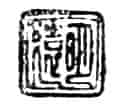 Ming–yüan = a late Ming potter at Yi–hsing.
Ming–yüan = a late Ming potter at Yi–hsing.
 Hui mêng–chên = name of a late Ming potter at Yi–hsing, copied on modern wares.
Hui mêng–chên = name of a late Ming potter at Yi–hsing, copied on modern wares.
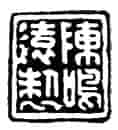 Ch´ên Ming Yüan chih = made by Ch´ên Ming–Yüan, Yi–hsing.
Ch´ên Ming Yüan chih = made by Ch´ên Ming–Yüan, Yi–hsing.
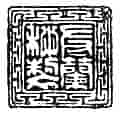 Yü lan pi chih = secretly made by Yü–lan; Yi–hsing (nineteenth century).
Yü lan pi chih = secretly made by Yü–lan; Yi–hsing (nineteenth century).
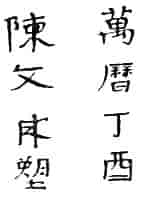 Wan li ting yu ch´ên wên ching su = Ch´ên Wên–ching modelled it in the ting–yu year of Wan Li (i.e. 1597).
Wan li ting yu ch´ên wên ching su = Ch´ên Wên–ching modelled it in the ting–yu year of Wan Li (i.e. 1597).
MARKS ON FUKIEN WHITE PORCELAIN
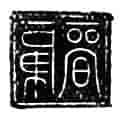 Chao–chin = a potter's name.
Chao–chin = a potter's name.
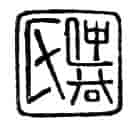 Chung t´un shih = Chung–t´un family.
Chung t´un shih = Chung–t´un family.
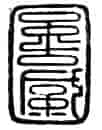 (?) Li–chih = a potter's name.
(?) Li–chih = a potter's name.
 Shan jên ch´ên–wei = the hermit Ch´ên–wei.
Shan jên ch´ên–wei = the hermit Ch´ên–wei.
 Lai–kuan = potter's name.
Lai–kuan = potter's name.
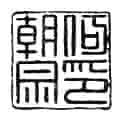 Chao tsung ho yin = seal of Ho Chao–tsung.
Chao tsung ho yin = seal of Ho Chao–tsung.
POTTERS' NAMES, ETC.
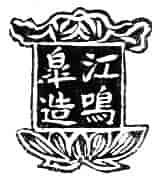 Chiang ming kao tsao = made by Chiang Ming–kao (about 1700).
Chiang ming kao tsao = made by Chiang Ming–kao (about 1700).
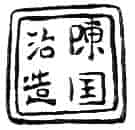 Ch´ên kuo chih tsao = made by Ch´ên Kuo–chih (about 1700).
Ch´ên kuo chih tsao = made by Ch´ên Kuo–chih (about 1700).
 Tao kuang ting wei wên lang shan chih = made by Wên Lang–shan in the ting–wei year of Tao Kuang (i.e. 1847).
Tao kuang ting wei wên lang shan chih = made by Wên Lang–shan in the ting–wei year of Tao Kuang (i.e. 1847).
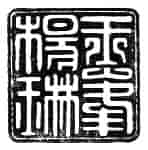 Yü fêng yang lin = Yang Lin of Yü–fêng. (See Vol. ii., p. 212.)
Yü fêng yang lin = Yang Lin of Yü–fêng. (See Vol. ii., p. 212.)
 (?) Trader's mark on export porcelain. (See Vol. ii., p. 136.)
(?) Trader's mark on export porcelain. (See Vol. ii., p. 136.)
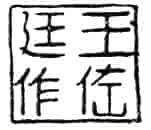 Wang tso t´ing tso = made by Wang Tso–t´ing (early nineteenth century).
Wang tso t´ing tso = made by Wang Tso–t´ing (early nineteenth century).
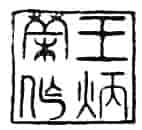 Wang ping jung tso = made by Wan Ping–jung (early nineteenth century).
Wang ping jung tso = made by Wan Ping–jung (early nineteenth century).
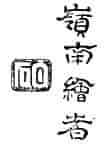 Ling nan hui chê = Ling–nan (Canton) painting. Seal of Pai–shih (white rock). (See Vol. ii., p. 211.)
Ling nan hui chê = Ling–nan (Canton) painting. Seal of Pai–shih (white rock). (See Vol. ii., p. 211.)
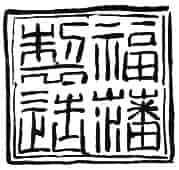 Fu fan chih tsao = made on the borders of Fukien. (See Vol. ii., p. 108.)
Fu fan chih tsao = made on the borders of Fukien. (See Vol. ii., p. 108.)
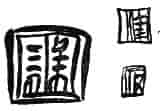 Three examples of "shop marks."
Three examples of "shop marks."
(4) Marks of dedication, felicitation, etc.
In many cases the place of a date mark, hall mark, or potter's name is taken by a word or phrase commending or describing the ware or invoking a benediction on the possessor. Such marks may be conveniently subdivided into marks of (a) dedication, (b) felicitation, (c) commendation; to which may be added (d) symbols used as marks.
(a) Marks of dedication indicating the destination or intention of the ware contain the name of a place or person or some word suggesting the use to which the vessel was dedicated. This group naturally overlaps that of the hall marks, there being no essential difference between a palace hall mark and such a mark as Shu fu  (Imperial palace) which was inscribed on the Imperial porcelain of the Yüan dynasty.
(Imperial palace) which was inscribed on the Imperial porcelain of the Yüan dynasty.
A few marks of dedication are mentioned in the Po wu yao lan[456] e.g.  t´an (altar) on the altar cups of the Hsüan Tê period;
t´an (altar) on the altar cups of the Hsüan Tê period;  ch´a (tea),
ch´a (tea),  chiu (wine),
chiu (wine),  tsao t´ang (decoction of jujubes), and
tsao t´ang (decoction of jujubes), and  chiang t´ang (decoction of ginger), which were inscribed inside the altar cups of the Chia Ching period, besides
chiang t´ang (decoction of ginger), which were inscribed inside the altar cups of the Chia Ching period, besides  chin lu (golden seal),
chin lu (golden seal),  ta chiao (great sacrifice), and
ta chiao (great sacrifice), and  t´an yung (altar use), which were written beneath them; all indicating the offerings and the altars for which the cups were destined.
t´an yung (altar use), which were written beneath them; all indicating the offerings and the altars for which the cups were destined.
Dedications to temples, institutions, and even to individuals, often of considerable length, also occur not infrequently.
(b) Marks of felicitation include good wishes such as ch´ang ming fu kuei (long life, riches and honour), wan fu yu t´ung (may infinite happiness embrace all your affairs), both of which have been noted on Ming porcelain; words of good omen such as fu, lu, shou, separately or together,  chi (good luck),
chi (good luck),  ch´ing (prosperity), etc.
ch´ing (prosperity), etc.
(c) Marks of commendation are also frequent, especially in the K´ang Hsi period and on blue and white porcelain. They allude to the beauty of the ware, comparing it with jade or gold or gems, or to the subject of the decoration; and they vary in length from a single character such as  yü (jade) to a sentence like ch´i shih pao ting chih chên (a gem among precious vessels of rare stone).
yü (jade) to a sentence like ch´i shih pao ting chih chên (a gem among precious vessels of rare stone).
(d) A sacred symbol or emblematic ornament often replaces the mark on K´ang Hsi porcelain; but as these will be found among the symbols, etc., described in vol. ii., ch. xvii., there is no need to discuss them any further. The most frequently used are the pa pao (Eight Precious Things), and the pa chi hsiang (the Eight Buddhist Emblems of Happy Augury).
MARKS OF FELICITATION, ETC.
 Shun = harmony.
Shun = harmony.
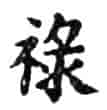 Lu = prosperity.
Lu = prosperity.
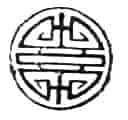 Shou = longevity (seal form).
Shou = longevity (seal form).
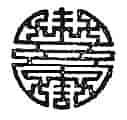 The same, with the Swastika interwoven.
The same, with the Swastika interwoven.
 The "spider" mark, a fanciful form of shou.
The "spider" mark, a fanciful form of shou.
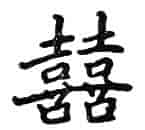 hsi (joy) repeated = double joy, a wedding symbol.
hsi (joy) repeated = double joy, a wedding symbol.
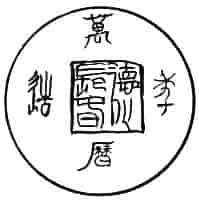
tê hua ch'ang ch'un = virtue culture and enduring spring; enclosed by Wan li nien tsao = made in the Wan Li period (1573–1619).
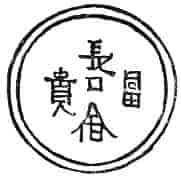
Mark resembling a "cash" or coin inscribed ch'ang ming fu kuei = long life, riches, and honours!
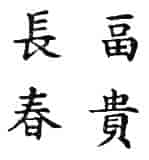 fu kuei ch'ang ch'un = riches, honours, and enduring spring!
fu kuei ch'ang ch'un = riches, honours, and enduring spring!
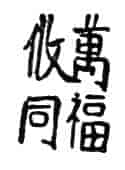 Wan fu yu t'ung = a myriad happinesses embrace all (your affairs)!
Wan fu yu t'ung = a myriad happinesses embrace all (your affairs)!
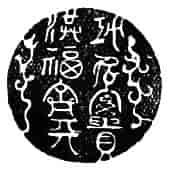 Kung ming fu kuei Hung fu ch'i t'ien = a famous name, riches and honours, vast happiness equalling heaven!
Kung ming fu kuei Hung fu ch'i t'ien = a famous name, riches and honours, vast happiness equalling heaven!
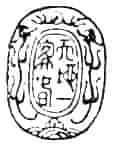 t'ien t'i yi chia ch'un = spring time for the whole family of heaven and earth.
t'ien t'i yi chia ch'un = spring time for the whole family of heaven and earth.
 ta ya chai = pavilion of grand culture. The Empress dowager's mark.
ta ya chai = pavilion of grand culture. The Empress dowager's mark.
MARKS OF COMMENDATION
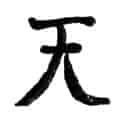 t´ien = heaven.
t´ien = heaven.
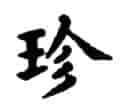 Chên = a gem.
Chên = a gem.
 Ya wan = elegant trinket.
Ya wan = elegant trinket.
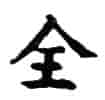 Ch´üan = complete.
Ch´üan = complete.
 Yü = jade.
Yü = jade.
 Chên wan = precious trinket.
Chên wan = precious trinket.
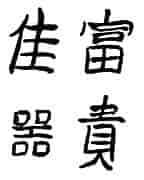 fu kuei chia ch´i = fine vessel for the rich and honourable.
fu kuei chia ch´i = fine vessel for the rich and honourable.
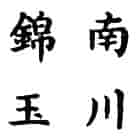 Nan ch´uan chin yü = embroidered jade of Nan–ch´uan (i.e. Ching–tê Chên).
Nan ch´uan chin yü = embroidered jade of Nan–ch´uan (i.e. Ching–tê Chên).
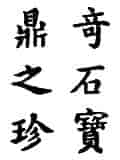 Ch´i shih pao ting chih chên = a gem among precious vessels of rare stone.
Ch´i shih pao ting chih chên = a gem among precious vessels of rare stone.
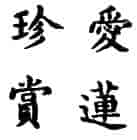 Ai lien chên shang = precious reward of the lover of the lotus.
Ai lien chên shang = precious reward of the lover of the lotus.
 han hsing = to contain fragrance.
han hsing = to contain fragrance.
For other marks on porcelain and pottery see Marks on Pottery and Porcelain, by W. Burton and R.L. Hobson, and The New Chaffers.
MISCELLANEOUS MARKS AND SYMBOLS
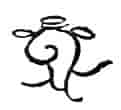
Conch–shell.

Incense–burner (ting).

ju–i head.

Knot (chang).
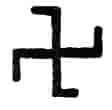
Swastika (wan).

Swastika in a lozenge symbol.

Stork (on a late Ming blue and white dish).
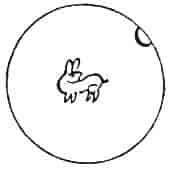
The moon hare.

The moon hare.
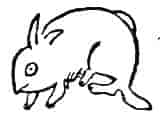
The moon hare.

Artemisia leaf.
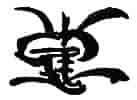
Fungus (ling–chih).

Fungus (ling–chih).
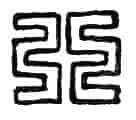
Fu (one of the twelve ornaments on ancient embroidery).
END OF VOL. I.
PRINTED BY
CASSELL & COMPANY, LIMITED, LA BELLE SAUVAGE,
LONDON, E.C.
F 15.115
FOOTNOTES:
[1] In the Kuei ch´ien chih quoted in the T´ao lu, bk. ix., fol. 10.
[4] In the Ai jih t´ang ch´ao, quoted in the T´ao lu, bk. ix., fol. 18 verso.
[5] The pi sê, or "secret colour," is used as a general term for glazes of the celadon type, among which the writer in question includes all the celebrated wares of antiquity from the T´ang "green (ts´ui) of a thousand hills," the Yüeh ware, the Ch´ai "blue (ch´ing) of the sky after rain," to the Sung Ju, Kuan, Ko, Tung–ch´ing, and Lung–ch´üan wares.
[6] e.g. the K´ao Kung chi, a relic of the Chou dynasty (1122–256 B. C.).
[7] T´ao shuo, bk. ii., fol. 1. See S.W. Bushell, Chinese Pottery and Porcelain, being a translation of the T´ao shuo, Oxford, 1910, p. 34.
[8] A work of the fifth century B. C., quoted in the Ching–tê Chên T´ao lu, bk. ix., fol. 1.
[9] Chinese Pottery of the Han Dynasty, Leyden, 1909, pp. 10–14.
[10] Quoted in the Ching–tê Chên T´ao lu, bk. ix. fol. 1.
[11] Loc. cit.
[13] See Hirth, China and the Roman Orient.
[14] Berthold Laufer, Jade, Field Museum of Natural History, Publication 154, Anthropological Series, vol. x., Chicago, 1912, pp. 232 and 233.
[15] Occasionally of potters.
[16] La Sculpture sur pierre en Chine au temps des deux dynasties Han, Paris, 1893. A few of these are figured by Bushell in Chinese Art, vol. i. See also Chavannes, Mission archéologique dans la Chine septentrionale, Paris, 1909.
[17] If geological arguments could be accepted at their face value, a vase found at Chi–ning Chou, in Shantung, would go far to prove the existence of a highly sophisticated glazed pottery at a date not less than 500 years B. C. The find is described and illustrated in the Zeitschrift für Ethnologie, Jahrg. 43, 1911, p. 153, by Herr Ernst Börschmann. The vase, which is 10 cm. high, is of globular form, with a short straight neck and two loop handles. It is of hard buff ware, with a chocolate brown glaze with purplish reflexions of a metallic appearance, and the glaze covers only the upper part of the exterior and ends in an uneven line with drops. One would say Sung or possibly T'ang, and of the type associated with the name Chien yao. This pot was found not in a tomb, but in the undisturbed earth at a depth of seven metres, by a German architect, while sinking a well; and a reasoned case from the stratification of the soil is made out to prove that it must have at least an antiquity of twenty–four hundred years. It is, however, proverbial that geological arguments applied to relatively modern archæology lead to results more startling than correct; and I refuse to accept this solitary specimen as evidence to upset the whole theory of the evolution of Chinese pottery. For it must do nothing less. This piece is of a style which is at present unknown before the T'ang dynasty. It has nothing in common with Han pottery as we know it, still less with Chou, and to accept its Chou date would be to believe that an advanced style of manufacture was in use 500 years B. C., that it was forgotten again for some twelve centuries, and then reappeared in precisely the same form. Fukien white porcelain seals have been found in an Irish bog in positions from which geologists might infer a colossal antiquity, but the history of porcelain has not been disturbed on that account; and I cannot help thinking that this strange phenomenon at Chi–ning Chou must be regarded in much the same light.
[18] Berthold Laufer, Pottery of the Han Dynasty, Leyden, 1908.
[19] Laufer seems to have mistaken it for the beginning of the regular Chinese crackle (see op. cit., p. 8). The Han green glaze contains a large proportion of lead oxide and is coloured with oxide of copper.
[20] See Bushell, Chinese Pottery and Porcelain, p. 96. "In the tomb of the Empress Tao, consort of Wu Ti (140–85 B. C.) there was found one lac–black earthenware dish."
[21] One of these, in the form of a small roller, by which a continuous pattern could be impressed, is figured by Laufer, op. cit. Plate xxxvi.
[22] See Burlington Magazine, December, 1913, where it is published with a note on the inscription by F.S. Kershaw.
[23] Burial Customs in Szechuan, Journal of the North–China Branch of the Royal Asiatic Society, vol. xli., 1910, p. 58, etc.
[24] A very large series of Han sepulchral pottery, including most of the known types, is in the Field Museum, Chicago; but most of our large museums possess specimens enough to give a good idea of the ware.
[25] Bk. ix., p. 3, quoting the Chêng tzŭ t´ung, which in turn quotes the Han Shu, or Han Histories. Presumably this is the Nan Shan near Lung Chou, in Shensi.
[26] Fragments of this ware which were brought back by the Grünwedel expedition in 1903 are in the Museum für Völkerkunde, in Berlin.
[27] See Bushell, op. cit., p. 97.
[28]  . See also Bushell's translation of the T´ao shuo, pp. 97 and 98.
. See also Bushell's translation of the T´ao shuo, pp. 97 and 98.
[29] Tu Yü, in his "Verses upon Tea." See T´ao shuo, Bushell's translation, p. 98. The words used are Ch´i tsê t´ao chien  for which Bushell has given the free and rather misleading version, "Select cups of fine porcelain."
for which Bushell has given the free and rather misleading version, "Select cups of fine porcelain."
[30] tz´ŭ wa, a phrase which Bushell has translated "porcelain and earthenware," though it is improbable that porcelain was meant at this early period (see Chap. XI.)
[31] J.J.M. de Groot, The Religious System of China. Leyden, 1894, vol. ii., p. 383.
[32] Loc. cit., p. 807.
[33] Loc. cit., p. 808.
[34] De Groot, loc. cit., p. 401.
[35] Loc. cit., p. 696.
[36] Loc. cit., p. 808.
[37] De Groot, loc. cit., p. 809.
[38] De Groot, loc. cit., p. 717.
[39] Loc. cit., p. 718.
[40] Who visited China about 1280.
[41] No doubt this mortuary pottery was made locally to supply local needs, and there is no occasion to refer it to any of the better known pottery centres, though we do find mention of an imperial order for sepulchral ware sent to the potters at Hsin–p´ing (the old name for the district town of Ching–tê Chên) in the T´ang dynasty. See T´ao lu, bk. viii., fol. 2, quoting from the Hsiang ling ming huan chih.
[42] See A Glossary of Reference on Subjects Connected with the Far East, by H.A. Giles, Shanghai, 1900. "The practice among Chinese women of cramping the feet is said by some to have originated about 970 A. D. with Yao Niang, concubine of the pretender Li Yü. The lady wished to make her feet like the new moon. Others say that it was introduced by Pan Fei, the favourite of the last monarch of the Ch´i dynasty, 501 A. D."
[43] See the Toyei Shuko (Illustrated Catalogue of the ancient Imperial Treasure called Shoso–in, by Omura Seigai, Tokyo, 1910), Nos. 154, 155 and 156.
[44] Another common characteristic of the T'ang base is a central ring, or one or two concentric circles incised on the wheel.
[45] Laufer (Jade, p. 247) sounds a note of warning about the reconstruction of many of the T'ang figures. They were very frequently broken in the course of excavation, and when a head was missing its place was commonly supplied from another find. Another and more serious warning is given by F. Perzynski in the Ostasiatischer Zeitschrift, January to April, 1914, p. 464, in an article describing forgeries of coloured T'ang figures, and vases and ewers with mottled green and yellow glazes, in Honan Fu.
[46] Ruins of Desert Cathay, vol. ii., p, 195. Similarly bowls with spotted glaze are indicated in several of the silk pictures found by Sir Aurel Stein at Tun–huang, which are temporarily exhibited in the King Edward VII. galleries in the British Museum.
[47] Fragments of similarly glazed ware were discovered by Sir Aurel Stein on sites in Turfan, which were supposed to be of T'ang date (see p. 134).
[48] In a paper by Sir C. Hercules Read in the fifteenth number of Man, a publication of the Anthropological Institute.
[50] See A.W. Bahr, Old Chinese Porcelain and Works of Art in China, Plate IV.
[52] Ruins of Desert Cathay, vol. 11., fig. 197.
[53] Mr. C.L. Freer has in his collection in Detroit a vase of hard reddish ware with a freely drawn lotus design in brown under a pale green glaze, with parts of the flower in dry reddish brown slip or pigment over the glaze. It has the characteristic T´ang base and appears to belong to that period.
[54] The small rosettes which commonly occur In the inlaid Corean designs recall these stamped T´ang patterns. Indeed the analogy between the Corean patterns in general and those found on T´ang pottery is most significant.
[55] It is now in the collection of Mrs. Potter Palmer.
[56] Yesdijird III., after his overthrow by the Arabs In 641, fled to Merv, and there appealed for aid to the Chinese Emperor. He does not appear to have fled for refuge to China, as has been sometimes asserted.
[57] The classical prototype is seen in a vase In the Fourth Vase Room (Case C) in the British Museum, on which we find two similar figures in relief surrounded by a grape vine scroll.
[58] Since writing the above note my attention has been drawn to a delightful article in the Neue Rundschau (Oct., 1913, p. 1427) by F. Perzynski, entitled Jagd auf Götter. Mr. Perzynski describes his hazardous journey to an almost inaccessible cave temple on a mountain top near Ichou in Chihli, and there is little doubt that this is the place from which our wonderful figure came. He speaks of the hill as the Acthlohanberg, implying a tradition of eight of these figures of Lohan, which had apparently been concealed in this and other caverns for safety during a period of iconoclasm, such as occurred in the ninth and the thirteenth centuries, when thousands of Buddhist shrines were wrecked. He found the shrine bare of the Lohan, except for a few fragments. The rest had been pillaged, and several of the figures had evidently been broken in the attempt to remove them through the narrow aperture of the caves, or to conceal them afterwards. Parts of them, and a sadly damaged Lohan, were actually shown to him in the neighbourhood; and he afterwards succeeded in obtaining a complete figure and a torso, which were exhibited by him in Berlin. On the altar of the shrine he found an incense burner of glazed ware, which he attributed to the Yüan dynasty, and there was a tablet recording the restoration of the altar in the reign of Chêng Tê (early sixteenth century). It is interesting to note that Mr. Perzynski assumed at once that these figures are of T´ang date. Incidentally, he mentions a visit to a hill which he calls the Kuanyinberg, where a cavern temple exists containing the remains of a colossal statue of Kuanyin. It is now broken, but Mr. Perzynski saw it standing in its enormous stature of three metres high, to which must be added a stand a metre high and two in width. This figure was originally in glazed pottery, possibly also of the T´ang period, but a great part of it had been restored in wood and plaster in the seventeenth century.
[59] See Japanese Temples and their Treasures, by Shiba–junrokuro, with translations by Mr. Langdon Warner, Tokyo, Shimbi Shoin, 1910, vol. ii., nos. 238, 268, and 300.
[60]  .
.
[62]  , sometimes written
, sometimes written  .
.
[63]  ts´ui sê. Ts´ui is the colour of "a bird with blue–green feathers: a kingfisher" (Giles), and it seems to have been used indifferently to express a bluish green colour and greenish blue like turquoise. In Lu Kuei–mêng's poem it suggests the colour of distant hills. A passage in a seventeenth–century work, the Ch´i sung t´ang shih hsiao lu (quoted in the T´ao lu, bk. ix., fol. 8), seems to imply that there were lustrous reflections in the glaze of some of the Yüeh wares. It runs, "Yüeh yao cups with small feet are of the light green (ch´ing) of the chestnut husk; when turned sideways they are the colour of emerald green jade (fei ts´ui)."
ts´ui sê. Ts´ui is the colour of "a bird with blue–green feathers: a kingfisher" (Giles), and it seems to have been used indifferently to express a bluish green colour and greenish blue like turquoise. In Lu Kuei–mêng's poem it suggests the colour of distant hills. A passage in a seventeenth–century work, the Ch´i sung t´ang shih hsiao lu (quoted in the T´ao lu, bk. ix., fol. 8), seems to imply that there were lustrous reflections in the glaze of some of the Yüeh wares. It runs, "Yüeh yao cups with small feet are of the light green (ch´ing) of the chestnut husk; when turned sideways they are the colour of emerald green jade (fei ts´ui)."
[66] See T´ao shuo, bk. ii., fol. 5 recto, quoting the Sung work, Kao chai man lu, and T´ao lu, bk. ix., fol. 9, quoting a twelfth–century work, the Ch´ing pi tsa chih, "The pi sê vessels were originally the wares offered daily to the house of Ch´ien when it ruled over the country. No subject was allowed to have them. That is why they were called pi sê."
[67] Bk. v., fol. 4 recto.
[68] See T´ao shuo, bk. ii., fol. 5 verso.
[70] See ch. vi.
[71] Bk. vii., fol. 13 recto.
[72] T´ang kuo shih pu, quoted in the T´ao shuo; see Bushell's translation (Chinese Pottery and Porcelain), p. 36. It is worthy of note that Hsing Chou was in the same district as Tz´ŭ Chou, which has long been celebrated for its pottery. See p. 101.
[73] As stated in Yo fu tsa lu, a tenth–century work on music, quoted in the T´ao shuo, bk. ii., fol. 4 recto. Twelve cups were used, and they were sometimes marked with numerals.
[74] Not to be confused with the more celebrated Ting Chou  in Chihli.
in Chihli.
[75] ho  , a coarse cloth or serge, used to suggest a brownish tint; cf. sê ho ju t´ung = colour ho like copper.
, a coarse cloth or serge, used to suggest a brownish tint; cf. sê ho ju t´ung = colour ho like copper.
[76] As quoted in the T´ao lu (see Julien, p. 5). The reference does not appear in the British Museum copy of the Ko ku yao lun.
[77] Quoted in the T´ao shuo, bk. ii., fol. 5 recto, and bk. v., fol. 3 recto.
[78] Ku Ying–t´ai in the Po wu yao lan, published in the T´ien Ch´i period (1621–1627).
[79] By Ts´ao–chao in 1387; republished in a revised and enlarged edition by Wang–tso in 1459.
[80] In the T´ao shuo, bk. ii., fol. 5 verso.
[81]  yü kuo t´ien ch´ing yün p´o ch´u chê. It will be observed that the colour word used is ch´ing, which has the meaning of blue or green, indifferently.
yü kuo t´ien ch´ing yün p´o ch´u chê. It will be observed that the colour word used is ch´ing, which has the meaning of blue or green, indifferently.
[82] Chang Ying–wên, in the Ch´ing pi tsang, written at the end of the sixteenth century.
[83] In the Ju shih we wên, quoted in the T´ao lu, bk. ix., fol. 19, where we are told that "merchants bring fragments of Ch´ai ware to sell for 100 ounces of silver. They say that if inlaid in the helmet at the approach of battle, they are able to turn aside the fire implements (huo ch´i)."
[84] For example, in the Li t´a k´an k´ao ku ou pien, a modern work, we find: "As to what they call at present Yüan and Chün wares, these in material, colour, sound, and brilliancy are similar to Ch´ai yao, but they differ in thickness, and are perhaps the common folk's imitation wares, and not the Imperial Shih Tsung ware. But we are not yet able to say. If the ware has sky blue colour, clear and brilliant on a coarse yellow brick–earth body, and rings like bronze, it must be Ch´ai ware. As to Chün ware ... the specimens have in every case red colour and variegated surface...."
[87] I have seen, for instance, a remarkable ware of white porcellanous type, with a transparent glaze of a faint bluish tinge, to which the name Ch´ai was boldly given. It was certainly an early type, perhaps as early as the Sung dynasty, but it belonged to a class of porcelain which is almost certainly Corean. The only specimen I have seen with a mark of the Posterior Chou period is not a blue–glazed piece but a large vase with wonderful purplish black glaze of the Chien–yao type in the Eumorfopoulos collection. The mark, however, has been cut at some time subsequent to the manufacture, and can only be regarded as reflecting some unknown person's opinion as to the date of the piece.
[88] Jade, op. cit., p. 17.
[89] See L. Binyon, Painting in the Far East, chap. ix.
[90] Porcelain, A Sketch of its Nature, Art and Manufacture, p. 56.
[91] This colour is quite distinct from the turquoise of the demi–grand feu, a more lightly fired colour familiar on the later porcelains.
[92] Mr. Burton's practical experiments and the beautiful results obtained by following out his conceptions of Chinese methods are well known to all admirers of the Lancastrian pottery.
[93] A late sixteenth–century work, published with translations by Dr. S.W. Bushell, 1908, under the title of Porcelain of Different Dynasties.
[94] I have already had occasion to criticise the inconsistencies in the colouring, etc. of this work. See Burlington Magazine, April, 1909, p. 23.
[95] Quoted in the T´ao lu, bk. ix., fol. 9 verso. We gather from this passage that Ju Chou potters were summoned to the Imperial precincts at K´ai–fêng Fu; for Ju Chou itself is some distance from the capital.
[96] The Liu ch´ing jih cha—a Ming work quoted in the T´ao shuo—describes it as "in colour like Ko ware, but with a faint yellowish tinge"; and the more modern T´ao lu (bk. vi., fol. 2) speaks of it as having "clay fine and lustrous like copper."
[97]  tan ch'ing, according to the Ko ku yao lun.
tan ch'ing, according to the Ko ku yao lun.
[98]  luan pai; according to the Po wu yao lan. Of three specimens figured in Hsiang's Album (op. cit., pp. 19, 22 and 34), two are described as yü lan (i.e. sky blue), and fên ch'ing (pale blue or green), and the third is undescribed.
luan pai; according to the Po wu yao lan. Of three specimens figured in Hsiang's Album (op. cit., pp. 19, 22 and 34), two are described as yü lan (i.e. sky blue), and fên ch'ing (pale blue or green), and the third is undescribed.
[99] Pt. i., fols. 8 and 9.
[100] It is not clear what these markings were, whether spots in the glaze or a kind of crackle. The simile of "crabs' claws" is applied to crackle in other passages.
[102] This interesting list, given in the Chiang hsi t'ung chih, bk. xciii., fol. ii., is summarised in vol. ii., ch. xii. It is also quoted in the T'ao lu, and translated by Bushell, O.C.A., p. 369.
[103] See Bushell, O.C.A., plate 77.
[104] In a passage referring to modern imitations, the T´ao lu (bk. vii., fol. 10) states that "at Ching–tê Chên, the makers of the large vases known as kuan ku (imperial antiques) for the most part imitate the colour of Ju yao glaze. Beautiful specimens of these (imitations) are commonly called 'blue of the sky after rain.'"
[105] P. 39. Account of a mission to Corea in 1125 by Hsü Ching.
[106] Hsiang's Album, op. cit., Fig. 19.
[107] Son of the author of the Ch´ing pi tsang. His father (see p. 53) declared that he had seen Ju porcelain.
[108] In the Cho kêng lu, published in 1368, but of special interest because it repeats the statements of a Sung writer, Yeh–chih, author of the Yüan chai pi hêng.
[109] Op. cit., plate 20.
[110] Cosmo Monkhouse, Chinese Porcelain, plate 1, and Bushell, Chinese Art, vol. ii., pg. 7.
[111] Liu Yen–t´ing.
[112] It would seem as if the manufacture had never entirely ceased at Ju Chou, for we read in Richard's Geography, p. 61, "The environs (of Ju Chou) were formerly very industrial, but have lost their activity. The manufacture of common pottery is still carried on and gives it some importance."
[114] The T´ao lu (bk. vi., fol. 2 verso). It is obvious that the term Kuan yao (Imperial ware) is liable to cause confusion, as it might be—and indeed was—equally applied to any ware made at any time at the Imperial factory. In recognition of this fact the Sung Kuan yao was sometimes named in later writers Ta Kuan  ware, after the Ta Kuan period.
ware, after the Ta Kuan period.
[115] A passage quoted in T´ao lu, bk. ix., fol. 13, from an eighteenth–century work, the Wên fang ssŭ k´ao, forms a commentary on this attitude. "The old capital Kuan factory," It says, "had only a brief existence, so that we must consider the Hsiu nei ssŭ make to be first and the 'recent wares' to be second."
[116] The list of wares made at the Imperial factories at Ching–tê Chên about 1730, and published in the Chiang hsi t´ung chih (vol. xciii., fol. 11), refers to the imitation of Kuan wares as follows: "Ta Kuan glazes on an iron–coloured body. These are three kinds—yüeh pai, fên ch´ing, ta lü—all imitating the colour and lustre of Sung ware sent to (or from) the palace (nei fa sung ch´i)." There is no reason to suppose that Ta Kuan here is more than a mere synonym for Kuan (ware).
[117] Chang Ying–wên in the Ch´ing pi tsang, published in 1595.
[118]  a phrase which is not very lucid. In fact, I suspect a confusion with another tan
a phrase which is not very lucid. In fact, I suspect a confusion with another tan  , which means "egg," and would give the sense "egg white," like the luan pai of the Ju yao.
, which means "egg," and would give the sense "egg white," like the luan pai of the Ju yao.
[119] On the subject of crackle, see vol. ii., p. 197. The idea of a crackle assuming the form of round four– or five–petalled flowers like plum blossoms was carried out by the Ch´ien Lung potters on some of the medallion bowls (see vol. ii., p. 244), with a ground of bluish green enamel on which a network of lines and plum blossoms was traced in black.
[120]  Ch´êng ni, lit. "pure, limpid, or clear clay," an expression which is explained in the T´ao shuo (bk. i., fol. 4 verso) as "refined earth," the word ch´êng (or ling) being equivalent to
Ch´êng ni, lit. "pure, limpid, or clear clay," an expression which is explained in the T´ao shuo (bk. i., fol. 4 verso) as "refined earth," the word ch´êng (or ling) being equivalent to  t´ao, which means to wash.
t´ao, which means to wash.
[121]  jung ch´ê, lit. "brilliant penetrate, or brilliant right through."
jung ch´ê, lit. "brilliant penetrate, or brilliant right through."
[122] The age is here probably the Sung period, for we must bear in mind that the author of the Cho kêng lu is practically quoting verbatim from the Sung writer Yeh–chih.
[123] Ko ku yao lun, bk. vii., fol. 22.
[124] It may also explain the ruddy tinge of the green glaze, which, being transparent, would allow the reddish brown body colour to show through in the thinner parts.
[125] An early sixteenth–century work, the Tu kung t´an tsuan (quoted in the T´ao lu, bk. ix., fol. 8 verso) tells of a Chinese sybarite Li Fêng–ming, who held a "lotus flower banquet. There were crystal tables twelve in number, and on them a series of vessels, all of Kuan porcelain, a display of elegance rarely seen at any time."
[126] Ya ku ch´ing pao shih. Ya ku is explained by Bretschneider (Mediæeval Researches, vol. i., p. 174) as equivalent to the Arabic yakut, and meaning a corundum, of which the Chinese recognise various tints, including deep blue, pale blue, muddy blue, besides yellow and white.
[127] Ch´ing ts´ui jo yü lan t´ien.
[128] Sê ch´ing tai fên hung. A more literal rendering of this phrase is "the colour of the glaze is ch´ing, with a tinge of red," which would refer to the reddish tone of a pale lavender glaze. On the other hand, the word tai is apparently used to describe the contrasting colours in parti–coloured jade and agate, e.g. huang sê tai t´u pan in Laufer (Jade, p. 140) to describe "yellow jade with earthy spots," and again (op. cit., p. 142), ch´ing yü tai hei sê, "green jade with passages of black colour."
[129] Po wu yao lan (quoted in the T´ao shuo, vol. iii., fol. 13 verso). These accidental effects are mentioned on both the Kuan and Ko wares, and are said to be either of a yellowish or a brownish red tint.
[130] "Wares of the Sung and Yüan Dynasties," Burlington Magazine, May, 1909, Plate i., fig. 4.
[131] See Burlington Magazine, May, 1909, Plate i., fig. 28; Plate ii., fig. 6.
[132] Speaking of the imitations of Kuan yao early in the nineteenth century, the T´ao lu (bk. ii., fol. 10) remarks: "Originally there were special departments for imitating Kuan yao. Now, only the imitators of the crackled wares make it. As for the imitations made at the (Imperial) factory, they are more beautiful," sc. than those made in the private factories.
[133] Bk. xxix., fol. 11.
[134] The word Hsü  has the meaning "continuation," and if it be not a place–name at present unidentified, it might conceivably be "the continuation or later Kuan ware."
has the meaning "continuation," and if it be not a place–name at present unidentified, it might conceivably be "the continuation or later Kuan ware."
[135] Bk. vii., fol. 6 verso.
[136] The Ch´i hsiu lei k´ao, quoted by Hirth, Ancient Chinese Porcelain, p. 37.
[137] The authors of the Po wu yao lan and the Ch´ing pi ts´ang.
[138]  hsieh chao wên, a debatable phrase, which seems best explained as a large irregular crackle resembling the tangle of claws seen on the top of a basket of crabs.
hsieh chao wên, a debatable phrase, which seems best explained as a large irregular crackle resembling the tangle of claws seen on the top of a basket of crabs.
[139]  Yü tzŭ. A crackle of finer mesh, which French writers describe as truité, or resembling the scales of a trout.
Yü tzŭ. A crackle of finer mesh, which French writers describe as truité, or resembling the scales of a trout.
[140]  pai chi sui, used by the author of the P´ai shih lei p´ien; see other references in the T´ao shuo and the T´ao lu.
pai chi sui, used by the author of the P´ai shih lei p´ien; see other references in the T´ao shuo and the T´ao lu.
[142] Quoted in the T´ao shuo (bk. v., fol. 9 verso).
[143] See vol. ii., p. 223.
[144]  mi sê fên ch´ing. Mi sê is rendered in Giles's Dictionary, "Straw colour, the colour of yellow millet," and all Chinese authorities whom I have questioned agree that it is a yellow colour. Bushell in much of his published work rendered it "rice coloured," following Julien's couleur du riz, and others, including myself, have been misled by this rendering. Bushell, however, in a note in Monkhouse's Chinese Porcelain, p. 67, which is quoted at length in vol. ii., p. 220, pronounces in favour of the rendering yellow. The difficulty of finding a true yellow among the Sung wares to support the comparison with yellow millet has further complicated the question. The vase in the Victoria and Albert Museum, which is figured in Monkhouse (fig. 22) as a specimen of old mi sê, is probably a Yung Chêng reproduction of the Sung type. It has a stone–coloured crackle glaze, overlaid with a brownish yellow enamel, a technique which is foreign to the Sung wares. Possibly one type of Sung mi sê was illustrated by the "shallow bowl with spout, of grey stoneware with opaque glaze of pale sulphur yellow," which Mr. Alexander exhibited at the Burlington Fine Arts Club in 1910 (Cat. K. 18). Another kind is described by Bushell in the catalogue of the Morgan collection (p. 38) as follows: "Shallow bowl (wan). Greenish yellow crackled glaze of the Sung dynasty, leaving a bare ring at the bottom within. A specimen of ancient mi sê or millet–coloured crackle from the Kiang–hsi potteries. Formerly the possession of His Excellency Chang Yinhuan. D. 6 inches." Specimens of this type, with greenish and brownish yellow crackle glaze, have been found in Borneo, where they have been reputed to be of enormous age; there are several examples in the British Museum. The Hirth collection in the Gotha Museum includes four high–footed bowls of brownish yellow colour which seem to belong to this class.
mi sê fên ch´ing. Mi sê is rendered in Giles's Dictionary, "Straw colour, the colour of yellow millet," and all Chinese authorities whom I have questioned agree that it is a yellow colour. Bushell in much of his published work rendered it "rice coloured," following Julien's couleur du riz, and others, including myself, have been misled by this rendering. Bushell, however, in a note in Monkhouse's Chinese Porcelain, p. 67, which is quoted at length in vol. ii., p. 220, pronounces in favour of the rendering yellow. The difficulty of finding a true yellow among the Sung wares to support the comparison with yellow millet has further complicated the question. The vase in the Victoria and Albert Museum, which is figured in Monkhouse (fig. 22) as a specimen of old mi sê, is probably a Yung Chêng reproduction of the Sung type. It has a stone–coloured crackle glaze, overlaid with a brownish yellow enamel, a technique which is foreign to the Sung wares. Possibly one type of Sung mi sê was illustrated by the "shallow bowl with spout, of grey stoneware with opaque glaze of pale sulphur yellow," which Mr. Alexander exhibited at the Burlington Fine Arts Club in 1910 (Cat. K. 18). Another kind is described by Bushell in the catalogue of the Morgan collection (p. 38) as follows: "Shallow bowl (wan). Greenish yellow crackled glaze of the Sung dynasty, leaving a bare ring at the bottom within. A specimen of ancient mi sê or millet–coloured crackle from the Kiang–hsi potteries. Formerly the possession of His Excellency Chang Yinhuan. D. 6 inches." Specimens of this type, with greenish and brownish yellow crackle glaze, have been found in Borneo, where they have been reputed to be of enormous age; there are several examples in the British Museum. The Hirth collection in the Gotha Museum includes four high–footed bowls of brownish yellow colour which seem to belong to this class.
[145] As explained in the T´ao lu (bk. ii., fol. 10 verso): "At Ching–tê Chên there is no special factory devoted to the imitation of Ko yao, but the manufacturers of crackled wares make it in addition to their own special line, and that is why they have the general name of Ko yao houses (Ko yao hu). Formerly, the manufacturers were acquainted with the origin of the word, but nowadays those who imitate Ko yao only copy a fixed model without knowing why it is called Ko yao."
[146] The Hsiang–hu wares were imitated at Ching–tê Chên in the Imperial factory about 1730. T´ang Ying himself gives the following note on them in the T´ao Ch´êng shih yü kao, written about this time: "Twenty li south–west of Ching–tê Chên is a waste place called Hsiang–hu  , where there were formerly the foundations of Sung kilns. It used to be easy to find porcelain (tz´ŭ) fragments of old vessels and waste pieces. The material was very thin, and the ware was evidently millet–coloured (mi sê) and pale green (fên ch´ing)." The memoir of Chiang (1322) states that "the ware was beautiful and lustrous, but not greatly prized at that time." See T´ao lu, bk. viii., fol. 12, and bk. v., fol. 2. For Chi Chou ware, see p. 98.
, where there were formerly the foundations of Sung kilns. It used to be easy to find porcelain (tz´ŭ) fragments of old vessels and waste pieces. The material was very thin, and the ware was evidently millet–coloured (mi sê) and pale green (fên ch´ing)." The memoir of Chiang (1322) states that "the ware was beautiful and lustrous, but not greatly prized at that time." See T´ao lu, bk. viii., fol. 12, and bk. v., fol. 2. For Chi Chou ware, see p. 98.
[147] See Chinese, Corean, and Japanese Potteries, New York, Japan Society, 1914 No. 307.
[148] Bk. ii., fol. 4.
[149] Bk. vi., fol. 5 verso.
[151] See Burlington Magazine, May, 1909, "Wares of the Sung and Yüan Dynasties," Plate iii., fig. 11.
[152] Quoted in the T´ao lu, bk. ix., fol. 9.
[154] See T´ao lu, bk. vi., fol. 4. A factory of inferior reputation is supposed to have existed at the neighbouring village of Chin–ts´un (see Hirth, Ancient Chinese Porcelain, p. 38). And the T´ao lu (bk. vii., fol. 6) describes a factory at Li–shui Hsien in the Ch´u–chou district, whose productions were also known as Ch´u ware.
[155] In the T´u shu, bk. ccxlviii., section Tz´ŭ ch´i pu hui k´ao, fol. 13, we are told that the brothers Chang worked beneath the Han liu hill at Lung–ch´üan in the Sung and Yüan dynasties.
[156] T´ao shuo, bk. ii., fol. 12 recto.
[157] Ts´ui has already been explained as meaning "kingfisher: a bird with bluish green plumage." That it also connotes the idea of a green colour is shown by the expression ts´ui yü, which is rendered in Giles's Dictionary, "emerald green jade."
[158] Author of the Ch´un fêng t´ang sui pi, quoted in the T´ao shuo, bk. ii., fol. 12.
[159] Bk. vii., fol. 24 verso.
[160] Two examples in the Gotha Museum were figured in the Burlington Magazine, June, 1909, Plate iv.
[161] See T´ao lu, bk. iii., fol. 12 verso.
[162] Bk. vii., fol. 7 recto.
[164] T´ao lu, bk. vi., fol. 6.
[165] See Hirth, Ancient Chinese Porcelain, p. 31.
[166] See Bushell, Oriental Ceramic Art, p. 150.
[167] A large number of fragments and wasters, besides a few complete specimens, found on the site of these potteries, about 200 miles north of Bangkok, are now in the British Museum. The prevailing type of ware has grey porcellanous body and a thin transparent glaze of watery green celadon colour, often distinctly tinged with blue.
[168]  See T´ao lu, vol. vi., fol. 3.
See T´ao lu, vol. vi., fol. 3.
[169] Bk. vii., fol. 22.
[170]  A phrase which the author of the T´ao lu considers to be a mistake for the homophone
A phrase which the author of the T´ao lu considers to be a mistake for the homophone  (tung yao or Eastern ware). He also quotes another misnomer for the ware, viz.
(tung yao or Eastern ware). He also quotes another misnomer for the ware, viz.  tung ch´ing ch´i (winter green ware). This Tung ware is constantly alluded to in other works as tung ch´ing
tung ch´ing ch´i (winter green ware). This Tung ware is constantly alluded to in other works as tung ch´ing  .
.
[171]  lit. duplicated kingfisher green. Bushell, in his translation, renders it literally "kingfisher feathers in layers," a metaphor from the well–known jewellery with inlay of kingfisher feathers, which would suggest a turquoise tint. On the other hand, we find in Giles's Dictionary the phrase
lit. duplicated kingfisher green. Bushell, in his translation, renders it literally "kingfisher feathers in layers," a metaphor from the well–known jewellery with inlay of kingfisher feathers, which would suggest a turquoise tint. On the other hand, we find in Giles's Dictionary the phrase  Yüan shan t´ieh ts´ui, "the distant hills rise in many green ranges" (the two forms of t´ieh being alternatives), a phrase recalling the "green of a thousand hills," which is used in reference to early green wares. See p. 16.
Yüan shan t´ieh ts´ui, "the distant hills rise in many green ranges" (the two forms of t´ieh being alternatives), a phrase recalling the "green of a thousand hills," which is used in reference to early green wares. See p. 16.
[172] Bk. ii., fol. 9.
[173] Bk. iii., fol. 12.
[174] Quoted from the Yün tsao (a selection of verses) in the T´ao lu, bk. ix., fol. 3.
[175] See Recueil des lettres édifiantes et curieuses. The above passage occurs in a long letter dated from Jao Chou, September 1st, 1712. See Bushell, Chinese Pottery and Porcelain, Appendix, p. 206.
[176] The only example which I have seen of an inlaid celadon which might be taken for Chinese is a dish in the Stübel Collection in the Kunstgewerbe Museum, Dresden. It has a faint design, apparently inlaid, in a brownish colour.
[177] In the Oesterreichische Monatschrift, January, 1885, and succeeding numbers, A.B. Meyer's Alterthümer aus dem Ostindischen Archipel, etc. etc.
[178] The Chu fan chih, the author of which was Imperial inspector of foreign shipping, etc., in the province of Fukien. See Hirth, Ancient Chinese Porcelain: A Study in Chinese Mediæval Industry and Trade, Leipsig, 1888; and the translation of the Chu fan chih, published by Hirth and Rockhill, 1912.
[179] Where Marco Polo (see Yule, bk. ii., p. 218) states that "they make vessels of porcelain of all sizes, the finest that can be imagined ... and thence it is exported all over the world."
[180] See A.B. Meyer, op. cit.; Ling Roth, The Natives of Borneo; Carl Bock, Head Hunters of Borneo; Fay–Cooper Cole, Chinese Pottery in the Philippines, Chicago 1912.
[181] A thirteenth–century writer, one of whose works is translated by Barbier and Maynard, Dictionnaire Géographique de la Perse. See p. 240 of this book. Fragments of celadon porcelain were found on the ninth–century site of Samarra on the Euphrates. (See p. 148.)
[182] Much of the celadon found in Egypt would seem to be as late as the early part of the sixteenth century, to judge from the general name given to it by Egyptian merchants, "baba ghouri," after the sultan who reigned at that time.
[183] See E. Zimmermann in the Cicerone, III. Jahrgang, s. 496 ff.
[184] See Burlington Magazine, June, 1909, p. 164. Other pieces, apparently of Siamese make, have been found in Egypt, and it is most probable that Siamese celadons were shipped by the traders at Martaban in Pegu and sold by them along with the Chinese goods.
[185] See Catalogue of the Early Chinese Pottery and Porcelain, Burlington Fine Arts Club, 1910, B. 27.
[186] See Cat. B.F.A., 1910, E 20, and Plate.
[187] See Chau Ju–kua (translated by Hirth and Rockhill), p. 9.
[188] See Hirth, Ancient Chinese Porcelain, op. cit., p. 4. The passage discovered by Hirth occurs in the T´ang pên ts´ao, the pharmacopœia of the T´ang dynasty, compiled about 650 A. D.
[189] See T´ao shuo, bk. ii., fol. 7 verso.
[190] See Ko ku yao lun, bk. vii., fol. 23. "Specimens with tear stains (lei hên) outside are genuine."
[191] The T'ao lu, bk. ix., fol. 13, quotes from T'ang shih ssŭ k'ao the following passage which bears on this point: "The Ting and Ju ware used by the Court generally have a copper band on the mouth. This was regarded as destroying their value. But modern collectors of Ting and Ju wares have come to regard the copper band on the mouth as a sign of genuineness. Dealers in curios declare it to be a sign of age."
[192] e.g. Po wu yao lan, T'ao lu, etc.
[193]  or
or  . The word hua (lit. flowers) is used in the general sense of "ornament." The attempts of certain translators to confine it to the literal sense "flowers" has led to ridiculous results.
. The word hua (lit. flowers) is used in the general sense of "ornament." The attempts of certain translators to confine it to the literal sense "flowers" has led to ridiculous results.
[195] An early eighteenth–century work, quoted in the T´ao lu, bk. ix., fol. 11.
[196] See T´ao shuo, bk., ii., fol. 7.
[197] Bk. vii., fol. 23.
[198] The Memoir of Chiang (see p. 159), written in the Yüan dynasty, says that the "pure white ware of Ching–tê Chên in the Sung dynasty, when compared with the red porcelain (hung tz´ŭ) of Chên–ting and the Lung–ch´üan green ware, emulated these in beauty." Chên–ting is the Chên–ting Fu, the prefectural town of Ting Chou, and the ware indicated is no doubt Ting ware; but here the comparison clearly seems to be between white wares, and unless the word hung (red) applies to some variety of the Ting biscuit as distinct from the glaze, it is difficult to understand.
[199]  tzŭ, "purple or dark red brown," is, like most Chinese colour–words, a somewhat elastic term. The dictionary gives instances in which it is applied to "red sandal wood," "brown sugar," the ruby, the violet, and the peony.
tzŭ, "purple or dark red brown," is, like most Chinese colour–words, a somewhat elastic term. The dictionary gives instances in which it is applied to "red sandal wood," "brown sugar," the ruby, the violet, and the peony.
[200] Op. cit., fig. 35.
[201] See p. 131. I have seen a single specimen of a bowl with carved design and creamy white glaze inside and all the appearances of a Ting ware, but coated on the exterior with a lustrous coffee brown monochrome. But without any other example to guide one's judgment, I should hesitate to say that this piece was older than the Ming dynasty.
[202] Hsü Tz´ŭ–shu, author of the Ch´a Su, a book on tea, quoted in the T´ao shuo, bk. v., fol. 15 verso.
[203] The potteries in the Chên–ting Fu district were active up to the end of the Ming dynasty, at any rate (see p. 199); and no doubt many of the coarse t´u ting specimens belong to the Ming period, but as their forms are archaic it is almost impossible nowadays to differentiate them.
[204] Julien, op. cit., p. 21, places this town in Kiang–nan, but this is clearly an error.
[205] In contrast with these there were specimens with "green mouth," ch´ing k´ou which were "wanting in richness and lustre."
[206] The date of Chou Tan–ch´üan is not given, but he is mentioned in the Ni ku lu, a mid–sixteenth–century work.
[207] A well–known type of bronze incense burner of the Shang dynasty. See the Shin sho sei, bk. i., fol. 2; and Hsiang's Album, fig. 1, where a Ting ware copy is illustrated.
[208] Julien, op. cit., pp. xxxiii.–xxxv.; the reference in the T´ao lu is bk. viii., fol. 5.
[210] Bk. ii., fol. 9 verso.
[211] The Liu ch´ing jih cha, written by T´ien Yi–hêng in the Ming dynasty.
[212]  T´ao lu, vol. vii., fol. 9 verso. See also bk. ix., fol. 9, where the Ch´ing po tsa chih (1193 A. D.) is quoted as follows: "The wares used at the present day, which are made at So Chou and Ssŭ Chou, are not genuine Ting ware."
T´ao lu, vol. vii., fol. 9 verso. See also bk. ix., fol. 9, where the Ch´ing po tsa chih (1193 A. D.) is quoted as follows: "The wares used at the present day, which are made at So Chou and Ssŭ Chou, are not genuine Ting ware."
[213]  T´ao lu, vol. vii., fol. 9 verso.
T´ao lu, vol. vii., fol. 9 verso.
[214]  T´ao lu, vol. vii., fol. 10 verso.
T´ao lu, vol. vii., fol. 10 verso.
[215] F. Brinkley, Japan and China, vol. ix., p. 259.
[216] Nyo–fu is the Japanese name for Kiang–nan, the province of which Anhui forms a part.
[217] In the district of Hsiao Hsien, department of Hsü Chou. The ware is described in the T´ao lu (bk. vii., fol. 7) under the name Hsiao  yao.
yao.
[218]  .
.
[219] Quoted in the T´ao lu, bk. ix., fol. 9.
[222] Bk. vi., fol. 23 verso. This account does not appear in the original edition, and was added in the later edition of 1459.
[223] Quoted in the T´ao shuo.
[224]  yu, which means "black," or "invisible blue or green."
yu, which means "black," or "invisible blue or green."
[225] See Bushell, T´ao shuo, p. 48.
[226] "Have ornament."
[227] See Ko ku yao lun, loc. cit.
[228]  T´ao lu, bk. vi., fol. 7 recto and verso.
T´ao lu, bk. vi., fol. 7 recto and verso.
[229] These must have resembled Ko yao. Hence, perhaps, the comparison in value between the fair Shu's ware and the Ko yao, p. 98.
[230] See T´ao lu, bk. vii., fol. 13 verso.
[232] For incidental reference to Tz´ŭ Chou vases and wine jars in the fifteenth and sixteenth centuries, see p. 128.
[233] See Bushell, O.C.A., p. 164.
[234] See Brinkley, Catalogue of the Exhibition at the Boston Museum of Arts, 1884; also Burlington Magazine, August, 1911, p. 264.
[235] The pottery found in Sung tombs near Wei Hsien, in Shantung, in 1903, includes a few examples of this type of ware with sketchy brown designs. Laufer (Chinese Pottery of the Han Dynasty, Appendix ii.) has illustrated this important find, though he is inclined to think that it may have been made at the neighbouring potteries of Po Shan Hsien. If this is so, we must reckon with the fact, in itself not at all surprising, that other factories besides Tz´ŭ Chou were working on the same lines. See p. 107.
[236] It would appear that the Tz´ŭ Chou potters were capable of producing these lustrous brown passages in the black glaze intentionally, for the floral design on Fig. 1 of Plate 34 is expressed in this manner.
[238] There are specimens—mostly small bowls—of a very archaic appearance, with the red and green painting which are persistently claimed as of Sung period. But see p. 46 and Plate 30.
[239] Catalogue of the Boston Exhibition, op. cit., 1884.
[242] See Bushell, op. cit., p. 122.
[243] Op. cit., vol. i., p. 91.
[244] See Burlington Magazine, August, 1911, and Cat. B.F.A., D 19 and 41.
[245] The link is strengthened by the presence of the black painted bands which border the main designs. See also Burlington Magazine, loc. cit., August, 1911, "On Some Old Chinese Pottery."
[246] On a few specimens, the date of which is by no means certain, a design of leaves is executed by a peculiar process, in which an actual leaf seems to have been used as a stencil, being stuck on to the ware while the slip was applied, and afterwards removed, leaving a leaf–shaped pattern in reserve. A somewhat similar use of leaf stencilling is described on p. 133.
[248] Bk. vii., fol. 14. Some authorities seem to have considered that the Hsü Chou factories go back to Sung times.
[249]  .
.
[250] The T´ao lu was written at the end of the eighteenth century.
[251]  is an alternative form of
is an alternative form of  .
.
[252] Bk. ii., fol. 7 verso. In discussing the glazes with mixed colour, the author says: "Of these wares, the sword–grass bowls and their saucers alone are refined. The other kinds, like the garden seats, boxes, square vases, and flower jars, are all of yellow sandy earthenware. Consequently, they are coarse and thick, and not refined." The first sentence is difficult, and has given rise to much discussion. The word ti, which Bushell has (rightly, I think) rendered saucers, literally means "bottom" or "base." Hirth reads it, "Those which have bottoms like the flower pots in which sword–grass is grown are considered the most excellent"; and Julien appears to have quite misunderstood the application of the passage. The original is  . The shallow saucers in which the deep flower pots stood are often included among the bulb bowls. See Plates 37 and 40.
. The shallow saucers in which the deep flower pots stood are often included among the bulb bowls. See Plates 37 and 40.
[253] See the excellent account of the Chün wares by Mrs. Williams in the introduction to the Catalogue of a Loan Exhibition of Chinese, Corean, and Japanese Potteries held by the Japan Society of New York, 1914.
[254] Shrivelled glaze is sometimes seen on the Chün types of pottery. Probably this was at first, at any rate, an accidental effect; but it is the prototype of the "dragon skin" glazes which the Japanese made at a later date. There is a good example in the Eumorfopoulos Collection of a bowl with thick grey Chün glaze, with a patch of reddish colour, and which is shrivelled in the most approved fashion, the glaze contracting into isolated drops and exposing the body between them.
[255] See T´ao shuo, bk. ii., fol. 15 verso, quoting the Liu ch´ing jih cha. In the case of the former (t´u ssŭ wên) some confusion has been caused by a variant reading  of the word
of the word  (t´u = hare), which refers the simile to the "dodder"; but the commoner phrase, "hare's fur marking," is far more descriptive of a dappled surface. Brinkley's explanation of the second phrase, huo yen ch´ing, as referring to the blue centre of a tongue of flame, applying the simile to the passages of blue which sometimes occur in the variegated Chün glazes, seems to meet the case. The flame–like effects are mentioned in an interesting passage in the T´ang chien kung t´ao yeh t´u shuo (quoted in the T´ao lu, bk. viii., fol. 13): "Men prize the Chün cups, tripods, and incense burners with smoke and flame glaze (yen huan sê). Although only pottery, still they combine the unexpected colours produced by the blowing tube (t´o yo)." The t´o yo
(t´u = hare), which refers the simile to the "dodder"; but the commoner phrase, "hare's fur marking," is far more descriptive of a dappled surface. Brinkley's explanation of the second phrase, huo yen ch´ing, as referring to the blue centre of a tongue of flame, applying the simile to the passages of blue which sometimes occur in the variegated Chün glazes, seems to meet the case. The flame–like effects are mentioned in an interesting passage in the T´ang chien kung t´ao yeh t´u shuo (quoted in the T´ao lu, bk. viii., fol. 13): "Men prize the Chün cups, tripods, and incense burners with smoke and flame glaze (yen huan sê). Although only pottery, still they combine the unexpected colours produced by the blowing tube (t´o yo)." The t´o yo  seems to have been "a pipe for blowing up the furnace."
seems to have been "a pipe for blowing up the furnace."
[256] See Hamilton Bell, "'Imperial' Sung Pottery," Art in America, July, 1913, p. 182. The Chinese numerals are given on p. 211.
[257] Cat. B.F.A., 1910, B 42.
[258] There is an obvious analogy in the "size 3" and "S 2," etc., incised under the Derby porcelain figures.
[260] See Chiang hsi t´ung chih, vol. xciii, fol. 11 and seq. Quoted also in the T´ao lu, and translated by Bushell, O.C.A., p. 369; and vol. ii., p. 223, of this work.
[261] Wai hsin tê  , lit. "recently obtained from outside." Wai evidently contrasts here with nei (the palace), which precedes the first five. Julien, however, gives it the sense "émaux nouvellement inventés."
, lit. "recently obtained from outside." Wai evidently contrasts here with nei (the palace), which precedes the first five. Julien, however, gives it the sense "émaux nouvellement inventés."
[262] See T´ao lu, bk. vi., fol. 7. "As to the ware made at Ching–tê Chên at the present day in imitation of the Chün wares, the body material is all of beautiful quality." This carries the imitation up to the end of the eighteenth century. There are, however, imitations made on a soft pottery body which bear the Yung Chêng mark.
[263] See p. 174.
[264] See p. 181. The list quoted on p. 223 of vol. ii. of the wares made at the Imperial potteries in 1730 includes "glazes of Ou: imitated from old wares of a man named Ou. There are two kinds, one with red markings, the other with blue."
[265] kua yu  "applied or added glaze." The significance of the epithet kua lies in the fact that the bulk of the Yi–hsing ware was unglazed.
"applied or added glaze." The significance of the epithet kua lies in the fact that the bulk of the Yi–hsing ware was unglazed.
[266] See Bushell, O.C.A., p. 374.
[268] See Burlington Magazine, November, 1909, Plate iv., opp. p. 83.
[269] See Mrs. Williams, loc. cit., p. 33.
[270] The modern Yü Chou. See vol. ii., p. 107.
[271] Op. cit., Plate 1.
[272] By Mr. A.W. Bahr.
[273] The name Ma is supposed to be that of a potter, but the statement is based on oral tradition only. The character used is ma (horse).
[274] It was deposited in the FitzWilliam Museum by Mr. W.H. Caulfield in 1896.
[276] The Li t´a k´an k´ao ku ou pien, of which the British Museum possesses a copy dated 1877.
[277] The Ch´in ting ku chin t´u shu chi ch´êng, fol. 10 of the subsection dealing with t´ao kung (the pottery industry), entitled T´ao kung pu hui k´ao.
[278] The Ch´ing yi lu, quoted in the T´ao shuo, bk. v., fol. 16 verso: "In Min (i.e. Fukien) are made tea bowls with ornamental markings like the mottling and spots on a partridge (chê ku pan). The tea–testing parties prize them." Oddly enough, the only specimen of this type of ware which I have seen with a date–mark was dated in the reign of Hsien Tê (954–960) of the Posterior Chou dynasty; but the inscription had been cut subsequently to the firing of the ware, and carries little weight. The piece in question is a remarkably large bottle–shaped vase with a splendid purplish black glaze with "hare's fur" marking, in the Eumorfopoulos Collection.
[279] See T´ao lu, bk. vii., fol. 8 verso.
[280]  t´u hao chan.
t´u hao chan.
[281] Ts´ai–hsiang, quoted in the T´ao shuo, bk. v., fol. 16 verso.
[282] The Liu ch´ing jih cha.
[284] In the Liu ch´ing jih cha.
[286] In the Kuei hai yü hêng chih, quoted in the T´ao lu, bk. ix., fol. 2 verso.
[287] In the Ning chai ts´ung hua, quoted in the T´ao lu, bk. ix., fol. 4.
[288] See T´ao shuo, Bushell, op. cit., p. 47.
[289] In the Yün* hsien tsa chi, quoted in the T´ao lu, bk. ix., fol. 1 verso.
[290] Quoted in the T´ao lu, bk. viii., fols. 12 and 13.
[291] From the Erh shih lu, quoted in the T´ao lu, bk. ix., fol. 15.
[292] Op. cit., pp. 17–20.
[293] Chinese Art, vol. ii., p. 17, and the Catalogue of the Morgan Collection (1907), p. xlviii.
[294]  wa ch'i yeh. The Shuo Wên was compiled by Hsü Shên and published first in 120 A. D. The word tz'ŭ
wa ch'i yeh. The Shuo Wên was compiled by Hsü Shên and published first in 120 A. D. The word tz'ŭ  is compounded of the radical wa
is compounded of the radical wa  (a tile, earthenware), and the phonetic tz'ŭ
(a tile, earthenware), and the phonetic tz'ŭ  (second, inferior), and carries no inherent suggestion of porcelain. If connoting a new material, it may be a name applied specially to glazed pottery which seems to date from the Han period, or even to stoneware as opposed to soft earthenware or brick.
(second, inferior), and carries no inherent suggestion of porcelain. If connoting a new material, it may be a name applied specially to glazed pottery which seems to date from the Han period, or even to stoneware as opposed to soft earthenware or brick.
[295] Thus the author of the T'ang shih ssŭ k'ao (quoted in the T'ao lu, bk. viii., fol. 9 verso): "The characters  and
and  are not interchangeable. The latter is a hard and fine kind of t'ao. The material from which it is made is clay. The former
are not interchangeable. The latter is a hard and fine kind of t'ao. The material from which it is made is clay. The former  , on the other hand, is the name of a real stone which comes from the ancient Han–tan, which is the modern Tz'ŭ Chou. This department has potteries in which they use the tz'ŭ stone for the body of the ware. Hence the name Tz'ŭ ch'i (Tz'ŭ wares), not that the ware from the potteries of this place is all porcelain. I hear that at Ching–tê Chên the common usage is to employ the character
, on the other hand, is the name of a real stone which comes from the ancient Han–tan, which is the modern Tz'ŭ Chou. This department has potteries in which they use the tz'ŭ stone for the body of the ware. Hence the name Tz'ŭ ch'i (Tz'ŭ wares), not that the ware from the potteries of this place is all porcelain. I hear that at Ching–tê Chên the common usage is to employ the character  for porcelain in writing and speaking. I have consulted friends whom I meet, and many use the two terms interchangeably. Truly this is altogether ridiculous. Tz'ŭ Chou is still making pottery at the present day." For the Tz'ŭ Chou pottery, see ch. viii.
for porcelain in writing and speaking. I have consulted friends whom I meet, and many use the two terms interchangeably. Truly this is altogether ridiculous. Tz'ŭ Chou is still making pottery at the present day." For the Tz'ŭ Chou pottery, see ch. viii.
[296] Yeh chih, quoted in the T'ao lu, bk. ix., fol. 13 recto.
[297] T'ao shuo, translated by Bushell, op. cit., p. 95.
[298] Bushell, Chinese Art, vol. ii., p. 18.
[299] See T'ao shuo (Bushell, op. cit., pp. 97 and 99). See also bk. ix., fol. 1 verso, where the passage from the Annals of the Sui Dynasty is quoted.
[300]  See T'ao shuo, bk. iv., fol. 17 recto and verso.
See T'ao shuo, bk. iv., fol. 17 recto and verso.
[301] The first two are apparently unidentified, but Jih–nan is Cochin China, whither, no doubt, the substance came as an article of trade.
[302] Early writers refer to it as pi liu li, which is a transcription of the Sanskrit Vaidurya, a stone supposed to be of the beryl type, but the identification is a matter of dispute. See Laufer, Jade, p. 111, footnote.
[303] A seventh–century writer.
[304] The Ta Yüeh–chih have been identified with the Massagetæ, who in the fifth century were in possession of Afghanistan. See Bushell, T'ao shuo, op. cit., p. 100.
[305] The substance is discussed at length in connection with pi–liu–li by Laufer (Jade, pp. 109–112), but this author seems very loath to admit the meaning glass for liu–li, though he allows that it is a common term for ceramic glaze. But the passage quoted above from the T'ao shuo can hardly be explained in any other way than in reference to a kind of glass.
[306] The exact words of the text are  (Ch'ou i lü tz'ŭ wei chih yü chên wu i). "Ch'ou took green ware and made it (liu–li) not different from the real."
(Ch'ou i lü tz'ŭ wei chih yü chên wu i). "Ch'ou took green ware and made it (liu–li) not different from the real."
[307] Orientalisches Archiv, Bd. ii., 1911, and Chinesisches Porzellan, p. 24.
[308] Op. cit., p. 20. Dr. Bushell, in his translation of the T´ao shuo, has given the more correct rendering, "Ch´ou made some (i.e. liu–li) of green porcelain."
[309] Op. cit., pp. 3 and 4.
[310]  Chin tai i pai tz´ŭ wei chih = "in recent generations with white ware they make it."
Chin tai i pai tz´ŭ wei chih = "in recent generations with white ware they make it."
[311]  Ting chou pai tz´ŭ. For the Ting Chou ware, see ch. vii.
Ting chou pai tz´ŭ. For the Ting Chou ware, see ch. vii.
[312] Père d'Entrecolles (in his letter dated from Ching–tê Chên in 1712) makes the statement that the district of Ching–tê Chên sent regular supplies of its ware, which he terms porcelain, to the Emperor from the second year of the reign of Tam ou te (sic). Though he gives the date as 422, it is clear that he really refers to the first Emperor, Wu Tê, of the T´ang dynasty (618–627 A. D.). It is not clear how he arrived at the conclusion that the ware in question was porcelain, and as he refers to the Annals of Fou–liang as his authority, we may assume that the Chinese phrase contained the inconclusive term tz´ŭ. or t´ao. He adds that "nothing is said as to the inventor, nor to what experiments or accident the invention was due."
[315] The European definition of porcelain may be stated thus: "Porcelain comprises all varieties of pottery which are made translucent by adding to the clay substances some natural or artificial fluxing material." In China the usual constituents are kaolin, which forms the clay substance, and petuntse (china stone), which is the natural fluxing material. I should add that it is doubtful whether we are strictly justified in using the word kaolin as a general name for porcelain earth (o t´u); but the term has been consecrated by usage, and has practically passed into our language in this sense. A slight translucency is observable near the rim on a white T´ang cup in the Eumorfopoulos Collection. The body of this piece is a soft white material, and the translucency is caused by a mingling of the glaze with the body where it is very thin, and it may be compared with the translucency of the Persian "gombroon" ware. But neither of these wares can be ranked as porcelain proper.
[316] It is, however, mentioned in connection with some of the Sung wares (the Kuan, for example), but only in relation to the glaze.
[317] It is true that Bushell, in his translation of the T´ao shuo (op. cit., p. 102) implies this quality in a "brown ware (tz´ŭ) bowl" sent as tribute by the P´o–hai in 841 A. D. which is described as "translucent both inside and outside, of a pure brown colour, half an inch thick but as light as swan's down." The words of the text  nei wai t´ung jung ("inside and out throughout lustrous") are in themselves capable of suggesting translucence, but the remaining features—the brown glaze and the great thickness—are sufficient to preclude the idea of a translucent ware; and I imagine that the quality of lustre or translucency here applies only to the glaze. The P´o–hai appear to have been a subject state of Corea.
nei wai t´ung jung ("inside and out throughout lustrous") are in themselves capable of suggesting translucence, but the remaining features—the brown glaze and the great thickness—are sufficient to preclude the idea of a translucent ware; and I imagine that the quality of lustre or translucency here applies only to the glaze. The P´o–hai appear to have been a subject state of Corea.
[318] I am indebted for this literal translation of the much–quoted passage to Mr. Edwards, of the Oriental MSS. Department of the British Museum. It has been more freely rendered by M. Reinaud, Relation des voyages faits par les Arabes, etc., Paris, 1845, p. 34.
[319] See F. Sarre, "Kleinfunde von Samarra und ihre Ergebnisse," in Islam, July, 1914.
[320] Fragments of white porcelain with carved designs were found in some of the sites excavated by Sir Aurel Stein in Turfan, and there are fragments similar to the Samarra finds obtained from ancient sites in the Persian Gulf and now in the British Museum. But the evidence of these pieces is not conclusive, for the sites were inhabited for many centuries. That of Samarra, on the other hand, is most important, for the city was only of a mushroom growth, which began and ended in the ninth century. See also p. 134.
[321] See Cat. B.F.A., 1910, A 43.
[322] See Cat. B.F.A., 1910, F 9 and 14.
[323] See passage from Hsü Ch´ing's notes, p. 39.
[325]  t´ao yü. There are variant readings to this passage as given in the Chiang hsi t´ung chih (bk. xciii., fol. 5 verso), which make t´ao yü the name of a man, the passage being read "T´ao–yü forwarded as tribute false jade vessels." As pointed out elsewhere, this expression "false jade" seems to imply a porcellanous ware. The comparison of porcelain and even fine pottery to jade is a commonplace in China, and it is not necessary to infer that any particular colour, green or otherwise, is indicated.
t´ao yü. There are variant readings to this passage as given in the Chiang hsi t´ung chih (bk. xciii., fol. 5 verso), which make t´ao yü the name of a man, the passage being read "T´ao–yü forwarded as tribute false jade vessels." As pointed out elsewhere, this expression "false jade" seems to imply a porcellanous ware. The comparison of porcelain and even fine pottery to jade is a commonplace in China, and it is not necessary to infer that any particular colour, green or otherwise, is indicated.
[326] The text is simply  chih wu = "established duty."
chih wu = "established duty."
[327] In order to bring this date into Hung Wu´s lifetime, it is necessary to reckon from the year 1364, when he was proclaimed Prince of Wu. But other records (see T´ao lu, bk. v., fol. 4 recto) give the date as second year of Hung Wu—i.e. 1369, instead of 1398 as above. Hung Wu was proclaimed Emperor in 1368, and died in 1398.
[328] Bk. cxiii., fols. 7 and 8. The T´ao shuo makes practically the same statement in connection with both periods, and Bushell (O.C.A., p. 287) gives us to understand that the first structure was burnt down and that erected in the Chêng Tê period was a rebuilding. The T´ao lu states that a special Imperial factory was erected on the Jewel Hill in the Hung Wu period, and that there were other kilns scattered over the town working for the palace, and that the name Yü ch´i ch´ang was given to all of them in the Chêng Tê period.
[329] Dated 1712 and 1722 from Ching–tê Chên, and preserved among the Lettres édifiantes et curieuses. They have been frequently published in part or in full, e.g. translated in W. Burton's Porcelain, and printed in French as an appendix to Bushell's Translation of the T´ao shuo.
[330] By Walter J. Clennell, H.M. Consul at Kiu–kiang, printed for H.M. Stationery Office.
[331] The long river front, "crowded for three miles by junks," was a feature of the place, which was sometimes known as the "thirteen li mart." A li is about 630 English yards.
[333] An incidental reference to white porcelain bowls at Hsin–p´ing (the old name for the district town of Ching–tê Chên) in 1101 A. D. occurs in the Ch´ang nan chih (quoted in the T´ao lu, bk. viii., fol. 15). It is a verse on the subject of tea drinking: "The white porcelain is quickly passed from hand to hand all night; the fragrant vapour fills the peaceful pavilion."
[334]  mao k´ou chê, lit. "hair mouth things." Bushell renders "with unglazed mouth." See Ko ku yao lun, bk. vii., fol. 24 verso, under the heading of "Old Jao wares."
mao k´ou chê, lit. "hair mouth things." Bushell renders "with unglazed mouth." See Ko ku yao lun, bk. vii., fol. 24 verso, under the heading of "Old Jao wares."
[336] Chou Hui, author of the Ching po tsa chih, a miscellany published in 1193, quoted in T´ao lu, bk. viii., fol. 6 r. and v.
[337] Cf. descriptions of Chün Chou ware, chap. ix.
[339] Bk. ii., fol. 8 verso. "The body was thin and glossy (jun), the colour white, the ornament blue (or green) ( hua ch´ing), and compared with Ting ware it was little inferior."
hua ch´ing), and compared with Ting ware it was little inferior."
[341] The Memoirs of Chiang Ch´i, entitled T´ao chi lüo, which were incorporated in the Annals of Fou–liang in 1322, and again in the geographical annals of the province of Kiangsi (Chiang hsi t´ung chih, bk. xciii., fol. 5 verso).
[342] Op. cit., pp. 178–183.
[344] huang hei, lit. yellow black or, perhaps, yellow and black.
[345] Ch´ing pai, a term also applied to greenish white jade; probably a pale celadon tint.
[346] i.e. cases in which the porcelain was fired.
[347]  yin hua,
yin hua,  hua hua, and
hua hua, and  tiao hua.
tiao hua.
[348] The text is  fa yün, lit. "emit mist," perhaps in the sense of "clouded."
fa yün, lit. "emit mist," perhaps in the sense of "clouded."
[349] These are literal renderings of hai mu and hsüeh hua, but I have no clue to their meaning.
[350] The text is  Shua chio, lit. "sport corners."
Shua chio, lit. "sport corners."
[352] yin hsiu, lit. "silver embroidery or painting."
[353]  p´u ch´un, which literally means "rush (or matting) lips."
p´u ch´un, which literally means "rush (or matting) lips."
[354]  lung hsien, lit. "play lute."
lung hsien, lit. "play lute."
[355] See Giles's Dictionary.
[356]  . Bushell renders it "trumpet–shaped beakers."
. Bushell renders it "trumpet–shaped beakers."
[357] Lit. "animal rings."
[358] Bk. vii., fols. 24 and 25.
[359]  lit. "pivot palace"; i.e. Imperial palace.
lit. "pivot palace"; i.e. Imperial palace.
[360] Lit. "five–coloured."
[361] ch´ing hei. Bushell renders the two words "greenish black."
[362]  i yu ch´uang chin wu sê hua chê. The expression ch´uang chin, which also occurs in the Ko ku yao lun, apparently carries the idea of gilding, though its literal meaning ("originate gold") is very vague. Bushell renders the phrase "pencilled with designs in gold," and Julien "rehaussée d'or."
i yu ch´uang chin wu sê hua chê. The expression ch´uang chin, which also occurs in the Ko ku yao lun, apparently carries the idea of gilding, though its literal meaning ("originate gold") is very vague. Bushell renders the phrase "pencilled with designs in gold," and Julien "rehaussée d'or."
[363] Op. cit., Fig. 21.
[364] See Burlington Magazine, August, 1909, p. 298.
[365] Bk. v., fol. 3 verso.
[366] huang hei, lit. "yellow black."
[367] The village  Hu–t´ien Shin and the pagoda are marked in the map of Ching–tê Chên (T´ao lu, bk. i., fol. 1) on the south of the river and opposite to the Imperial factories.
Hu–t´ien Shin and the pagoda are marked in the map of Ching–tê Chên (T´ao lu, bk. i., fol. 1) on the south of the river and opposite to the Imperial factories.
[368] China and Japan, vol. ix., p. 303.
[369] See T´ao lu, bk. ii., fol. 4 verso; and Julien op. cit., p. 42.
[370]  . See T´ao lu, bk. vii., fol. 10 verso.
. See T´ao lu, bk. vii., fol. 10 verso.
[371]  .
.
[374]  . Bushell (O.C.A., p. 186) renders "wide shallow bowls."
. Bushell (O.C.A., p. 186) renders "wide shallow bowls."
[375]  . The handles may be either long stems or handles in the modern sense, but both these types are found on far more ancient wares, e.g. the tazza or high footed goblet in Chou pottery, and the small cups with round handles of the T'ang dynasty.
. The handles may be either long stems or handles in the modern sense, but both these types are found on far more ancient wares, e.g. the tazza or high footed goblet in Chou pottery, and the small cups with round handles of the T'ang dynasty.
[376]  , lit. "exhort dishes." Bushell renders "rounded dishes." They were probably flat–bottomed shallow bowls, used as saucers.
, lit. "exhort dishes." Bushell renders "rounded dishes." They were probably flat–bottomed shallow bowls, used as saucers.
[377]  t'ai p'an, lit. "terraced dishes."
t'ai p'an, lit. "terraced dishes."
[378] Ko ku yao lun, bk. vii., fol. 25 verso.
[379] The T´u shu, Section xxxii., Part viii., section entitled T´ao kung pu tsa lu, fol. 1 verso; quoting from the Ling piao lu i  , by Liu Hsün, of the T´ang dynasty.
, by Liu Hsün, of the T´ang dynasty.
[380] Bk. vii., fol. 16. "This is the ware which was first made at Yang–chiang Hsien  in the Chao–ch´ing Fu in Kuangtung. It is, in fact, an imitation of the Yang–tz´ŭ ware. Consequently, the Records of the Province state that the productions of Yang–chiang in Kuangtung include 'porcelain wares' (tz´ŭ ch´i). I have seen incense burners (lu), vases (p´ing), cups (chien), plates (t´ieh), bowls (wan), dishes (p´an), pots (hu), and boxes (ho) of this manufacture. They are very ornamental and bright, but in taste, fineness, elegance, and lustre they are not equal to porcelain wares. Nor have they been able to avoid the occurrence of flaws exposing the body, which are unsightly. Still they are imitated at T´ang's manufactory, the imitations being admirable in their elegance and lustre, and excelling the Kuang yao. These, like the Tz´ŭ–Chou and Hsü–Chou types of ware, are none of them made of porcelain clay." The T´ao chêng chi shih states: "He (i.e. T´ang Ying) imitates singularly well the Kuang yao glaze, being particularly successful with the spotted blue (ch´ing tien
in the Chao–ch´ing Fu in Kuangtung. It is, in fact, an imitation of the Yang–tz´ŭ ware. Consequently, the Records of the Province state that the productions of Yang–chiang in Kuangtung include 'porcelain wares' (tz´ŭ ch´i). I have seen incense burners (lu), vases (p´ing), cups (chien), plates (t´ieh), bowls (wan), dishes (p´an), pots (hu), and boxes (ho) of this manufacture. They are very ornamental and bright, but in taste, fineness, elegance, and lustre they are not equal to porcelain wares. Nor have they been able to avoid the occurrence of flaws exposing the body, which are unsightly. Still they are imitated at T´ang's manufactory, the imitations being admirable in their elegance and lustre, and excelling the Kuang yao. These, like the Tz´ŭ–Chou and Hsü–Chou types of ware, are none of them made of porcelain clay." The T´ao chêng chi shih states: "He (i.e. T´ang Ying) imitates singularly well the Kuang yao glaze, being particularly successful with the spotted blue (ch´ing tien  ) kind of glaze. Following this author, imitations were also made of the copies produced at T´ang's factory." The greater part of this passage seems to contain a confusion of ideas. Yang–tz´ŭ
) kind of glaze. Following this author, imitations were also made of the copies produced at T´ang's factory." The greater part of this passage seems to contain a confusion of ideas. Yang–tz´ŭ  or "foreign porcelain" was the name given to the painted Canton enamels which are described on the next page of the T´ao lu under that heading. The passage beginning "I have seen" and ending "equal to porcelain wares" is taken almost verbatim from the sections which deal with Canton enamels and cloisonné enamels. The remark on "imitation of the Yang–tz´ŭ ware" could by no stretch of imagination be applied to the mottled Kuang yao; but it does apply to the large group of porcelain obtained in the white from Ching–tê Chên and painted at Canton precisely in the style of the Canton enamels (see vol. ii., p. 243). This is no doubt what the author had in his mind. The sentence about the unsightly flaws can apply to either the enamels or the Kuang yao, but more particularly to the latter. For the rest, "T´ang's factory" is the Imperial factory at Ching–tê Chên, which was under the management of the celebrated T´ang Ying between 1728 and 1749.
or "foreign porcelain" was the name given to the painted Canton enamels which are described on the next page of the T´ao lu under that heading. The passage beginning "I have seen" and ending "equal to porcelain wares" is taken almost verbatim from the sections which deal with Canton enamels and cloisonné enamels. The remark on "imitation of the Yang–tz´ŭ ware" could by no stretch of imagination be applied to the mottled Kuang yao; but it does apply to the large group of porcelain obtained in the white from Ching–tê Chên and painted at Canton precisely in the style of the Canton enamels (see vol. ii., p. 243). This is no doubt what the author had in his mind. The sentence about the unsightly flaws can apply to either the enamels or the Kuang yao, but more particularly to the latter. For the rest, "T´ang's factory" is the Imperial factory at Ching–tê Chên, which was under the management of the celebrated T´ang Ying between 1728 and 1749.
[381] From its supposed resemblance to the colour of the sea–snail (namako).
[382] Cat. B.F.A., 1910, K 43. Like so many Chinese dates, this was cut in the ware after the firing, but there is every reason to suppose that it indicates the true date of the manufacture. Sir Arthur has since presented this tray to the British Museum.
[383] Op. cit., vol. ii., p. 15.
[384] Modern English potters produce flocculent glazes of the Canton type by means of zinc, and Mr. Mott, of Doulton's, showed me a specimen illustrating the effect of zinc which was remarkably like the glaze of Plate 47 both in the blue dappling and the greenish frosting. Possibly the use of zinc was known to the Kuangtung potters and gave them their characteristic types of glaze. Other effects resembling the Canton glazes were produced by Mr. Mott by both zinc and tin in the presence of cobalt and iron.
[385] Japan and China, vol. ix., p. 261.
[387] Such a piece from the British Museum collection is figured in the Burlington Magazine, January, 1910, p. 218.
[388] See Burlington Magazine, January, 1910, p. 220.
[389] I am indebted to Mr. A.W. Bahr for much information on these and the Yi–hsing Chün imitations.
[390] Three beautiful examples were exhibited at the Burlington Fine Arts Club in 1910, (Cat., K 20, 23 and 41), on the last of which the lavender tints on the sides passed into a glassy pool of brilliant peacock blue.
[391] There is an interesting example of this crystalline glaze in Mrs. Potter Palmer's collection. It is a bowl of coarse grey porcelain, with blue glaze on the exterior. Inside is a crimson red glaze of Canton type, in the centre of which is a pool of amber glass. The explanation seems to be that we have here a bowl of coarse export porcelain treated at a Canton factory with their crystalline glaze.
[392] Richards, Comprehensive Geography of the Chinese Empire, 1908, p. 210.
[393] Richards, op. cit., p. 209. "Considerable trade is carried on in tea, porcelain, etc."
[394] S. Wells Williams, Commercial Guide to China, 1863, p. 13. Speaking of pottery the author says: "The charges for freight forbid it to be carried far, and manufactures of it are numerous; that for Canton is at Shih–hwan." No doubt this is Shih–wan  . Another name for Canton pottery is Shakwan ware, which is probably a variant of Shih–wan.
. Another name for Canton pottery is Shakwan ware, which is probably a variant of Shih–wan.
[395] Catalogue spécial de la Collection Chinoise à l'Exposition Universelle, Paris, 1878, pp. 10–12.
[396]  .
.
[397] By Chou Kao–ch´i. See Bushell, O.C.A., p. 635.
[398] F. Brinkley, Japan and China, vol. ix., pp. 355–63.
[399] Op. cit., figs. 45 and 46.
[400] A tael is about one Mexican dollar and a third, i.e. approximately thirty pence.
[401] Four of the most celebrated names, however, are incidentally mentioned in the T´ao lu (bk. vii., fol. 11 verso), viz. (1) Shih Ta–pin  ; (2) Li Chung–fang
; (2) Li Chung–fang  ; (3) Hsü Yu–ch´üan
; (3) Hsü Yu–ch´üan  ; (4) Ch´ên Chung–mei
; (4) Ch´ên Chung–mei  ; and (5) Ch´ên Chün–ch´ing
; and (5) Ch´ên Chün–ch´ing .
.
[402] The Yang–hsien ming hu hsi (quoted in the T´ao lu, bk. viii., fol. 8 verso) states that Ch´ên Chung–mei began by making porcelain at Ching–tê Chên. "It was exceedingly clever, and of an ornamental kind, made with supernatural ingenuity. But the results of his trade were far from sufficient to establish a name, so he gave it up and came to Yang–hsien (i.e. Yi–hsing). He took a delight in blending the teapot clays, putting his heart and soul into the work, and his ware was considered superhuman."
[403] I have seen specimens of Yi–hsing red ware coated with a dappled bird's egg glaze of blue green ground flecked with crimson, a type which was thought to represent the "Chün glaze of the muffle kiln." See vol. ii., p. 217.
[404] For this and other information on the subject, see M.L. Solon's paper on "The Noble Buccaros" in the North Staffordshire Literary and Philosophic Society's Proceedings, October 23rd, 1896.
[405] See T´ao lu, bk. vii., fol. 11 verso: "(Ou ware) was made in the Ming dynasty by a man of Yi–hsing ... who took the name of Ou, and everybody called it Ou's ware. It included wares which imitated Ko ware in crackle, Kuan and Chün wares in colour. Ou's bright coloured glazes were very numerous. The wares consist of flower dishes, stands for boxes, etc. The glazes with red and blue markings are particularly choice. At Ch´ang–nan the factory of T´ang used to imitate them." The last sentence refers to the celebrated T´ang Ying, who supervised the Imperial factory at Ching–tê Chên from 1728–1749. The statement that Tang's factory imitated them is no doubt based on the oft–quoted list given in the Chiang hsi t´ung chih of wares made at the Imperial factory about 1730, which include "glazes of Ou. Imitations of the old ware of the potter named Ou, including two kinds, that with red and that with blue markings."
[406] In the list quoted in the last note. The words are  , Yi hsing kua yu. The word kua, which means "suspended, applied," is probably inserted because the Yi–hsing ware was usually unglazed.
, Yi hsing kua yu. The word kua, which means "suspended, applied," is probably inserted because the Yi–hsing ware was usually unglazed.
[407] A similar effect is produced by zinc and tin on modern English wares. See note on p. 168. It has been suggested that these minerals were used on the Kuangtung stonewares, and appearances, at any rate, point to their presence in the Yi–hsing flambé glazes as well.
[408] Dr. Laufer collected a considerable series of wares made in certain modern factories which he visited in China, and they may be seen in the Field Museum, Chicago, and in the Natural History Museum in New York.
[409] S. Wells Williams, Chinese Commercial Guide, 1863, p. 132.
[410] Op. cit., p. 114.
[411] A coarse blue and white porcelain, often decorated with dragons which overlap the rim and are continued on the reverse of the bowls and dishes, seems to belong to one of these provincial factories. The glaze is thick and bubbly, and the blue of the decoration rather dull and dark; but these pieces have a certain age, and belong to the first half of the eighteenth century, for they were copied at Worcester and Lowestoft. They often have marks "of commendation," such as hsi yü ("western jade"), etc.
[412] The Ch´in ting ku chin t´u shu chi ch´êng, section viii., subsection named T´ao kung pu hui k´ao, fol. 15.
[413]  sung hsiang, rendered "turpentine" by Bushell, O.C.A., p. 264.
sung hsiang, rendered "turpentine" by Bushell, O.C.A., p. 264.
[414]  wu ming i, "nameless rarity," the designation under which cobalt was imported in the Sung dynasty. (See Bushell, O.C.A., p. 439.)
wu ming i, "nameless rarity," the designation under which cobalt was imported in the Sung dynasty. (See Bushell, O.C.A., p. 439.)
[415] Chau Ju–kua, translated by F. Hirth and W.W. Rockhill. St. Petersburg, 1912.
[416] Ancient Chinese Porcelain, op. cit. See also p. 86.
[417] See Chau Ju–kua, Introduction, p. 9.
[418] e.g. gusi, rusa, naga, tempajan, blanga.
[419] Chinese Pottery in the Philippines, by Fay–Cooper Cole, with a postscript by Berthold Laufer, Field Museum of Natural History, Publication No. 162, Chicago U.S.A., 1912.
[420] Ibidem, p. 14.
[421] Kochi, the Japanese name for Kochin China, seems to have been used in a vague and comprehensive sense for Southern China, and we understand by Kochi yaki the old pottery shipped from the coast towns of Fukien and Kuangtung. This category in Japan seems to include not only a variety of earthenware with coloured glazes—green, yellow, aubergine, turquoise, and violet—but the coarser, yellowish white wares of the t´u ting (see p. 90) type. See Brinkley, op. cit., vol. ix. p. 29.
[422] On the subject of pottery among the Dyaks in Borneo, see H. Ling Roth, The Natives of Sarawak and British North Borneo, vol. ii., p. 284; A.W. Neuwenhais, Quer durch Borneo, vol. ii., plate 40; Hose and McDougall, The Pagan Tribes of Borneo, 1912, vol. i., pp. 64 and 84, and plates 46–48. See also A.B. Meyer, Alterthümer aus dem Ostindischen Archipel.
[423] Cat. B.F.A., 1910, I., 11.
[424] A little flask in the Victoria and Albert Museum (Case 24, No. 809, 1883) of this type of ware with a green glaze was obtained in 1883 in the neighbourhood of Canton. Possibly a portion of this group comes from one of the Canton factories, but it is the kind of ware which might have been made in any pottery district, and there are quite modern examples of the same type of glaze and biscuit in the Field Museum of Chicago which were manufactured at Ma–chuang, near T´ai–yüan Fu, in Shensi.
[426] T´u Shu, op. cit., section T´ao kung pu hui k´ao, fol. 9.
[427] Ching is the name of the old state of Ch´u, which included Hunan and Hupeh, so that the expression here used covers an enormous tract of Central China. See T´u shu, section T´ao kung pu tsa lu, fol. 2.
[428] T´u Shu, section T´ao kung pu chi shih, fol. 2 recto.
[429]  and
and  .
.
[430] This appears to mean that the glaze covering up the reliefs filled all the surrounding hollows and made an even surface.
[431] i.e. ware of the Hsüan Tê period (1426–1435 A. D.).
[432] T´u Shu, section T´ao kung pu hui k´ao, fol. 10.
[433] O.C.A., p. 637.
[434] Made at Pilkington's Tile Works, Clifton Junction, by Manchester.
[436] T´u Shu, section entitled T´ao kung pu tsa lu, fol. 2 verso.
[438] T´u Shu, section xxxii, T´ao kung pu hui k´ao, fol. 9.
[439] T´ao lu, bk. vii., fol. 10 verso.
[440] Quoted in the T´ao lu, bk. ix., fol. 2.
[441] Recorded in the T´ang Shu, the passage in question being quoted in the encyclopædia, T´u Shu, section xxxii, T´ao kung pu chi shih, fol. 1 verso.
[442] See the T´u Shu, section T´ao kung pu hui k´ao, fol. 7 verso.
[443] It was completed in 1430, and destroyed by the T´aip´ing rebels in 1853.
[444] In the section T´ao kung pu hui k´ao, fol. 9.
[445] Catalogue spécial de la Collection Chinoise, op. cit., pp. 10–12. The exhibits from Amoy included "carreaux de pavage, tuiles pour toitures."
[446] See Catalogue B.F.A., 1910, L. 1.
[447] See Dr. Voretzsch, Catalogue of Chinese Pottery.
[448] See T'ao lu, bk. viii., fol. 14 verso (quoting the I chih): "In the sixteenth year of K'ang Hsi the district magistrate, Chang Ch'i–chung, a man of Yang–ch'êng, forbade the workmen of Ching–tê Chên to inscribe on the porcelain vessels the nien hao of the Emperor or the handwriting (tzŭ chi  ) of the holy men, to prevent their being broken and injured."
) of the holy men, to prevent their being broken and injured."
[449] See Catalogue B.F.A., 1910, E 4.
[450] This qualification is very necessary, because there are plenty of inferior pieces with the Ch'êng Hua mark which are quite modern.
[451] The Ch´ien Lung enamelled Imperial ware is frequently marked in red within a square panel reserved in the opaque bluish green enamel which so often covers the base.
[452] For the complete tables of cycles see Mayers, op. cit., p. 362.
[453] Though the reign of K´ang Hsi officially dates from 1662, in reality it began with the death of the previous Emperor in 1661; see p. 216.
[454] O. C. A., p. 79.
[455] Vol. ii., p. 167.
[456] Vol. ii, p. 34.







 hsiu hua, lit. "embroidered ornament." See p.
hsiu hua, lit. "embroidered ornament." See p. 